Text UNHIPM to (866) 645-7010
Applied Vegetable & Fruit Research in New Hampshire
Hello vegetable IPM folks!
This is the final Vegetable IPM Report of the 2025 season – thank you for a great (and at times challenging) season. Please see our 2025 season summary after this week’s trapping report.
We caught 11 corn earworm and 6 fall armyworm this week in the 4 traps that were left out in Hollis and Milford. The results of our trapping efforts for sweet corn pests are recorded by town in Table 1 below.
Table 1. Sweet corn pest weekly summary, 10/13-10/17/2025.
Town | # CEW Moths | # Traps | Avg. CEW/Trap | # FAW Moths | # Traps | Avg. FAW/Trap |
|---|---|---|---|---|---|---|
Hollis | 10 | 3 | 3.3 | 6 | 3 | 2 |
Milford | 1 | 1 | 1 | 0 | 1 | 0 |
Totals | 11 | 4 | 2.75 | 6 | 4 | 1.50 |
Brown marmorated stink bug captures have really decreased since last week. We generally see higher numbers in dry weather and later in the season. Captures by location are shown in Table 2 below.
Table 2. BMSB weekly summary, 10/13-10/17/25.
Town | # Adults | # Nymphs | # Traps | Total BMSB | Average BMSB/Trap |
|---|---|---|---|---|---|
Antrim | 1 | 0 | 1 | 1 | 1 |
Concord | 1 | 0 | 2 | 1 | 0.5 |
Hollis | 31 | 2 | 3 | 33 | 11.0 |
Litchfield | 7 | 6 | 2 | 13 | 6.5 |
Milford | 11 | 3 | 2 | 14 | 7 |
Total | 51 | 11 | 10 | 62 | 6.2 |
Grant opportunities:
- Northeast SARE Farmer Grant Program Call for 2026 Proposals!
The Northeast SARE Farmer Grant program provides funds to farmers to explore innovative concepts in sustainable agriculture conducted through experiments, surveys, prototypes, on-farm demonstrations or other research and education techniques. Farmer Grant projects must:- Be led by a farmer who meets Northeast SARE’s definition of a farm.
- Collaborate with a technical advisor. Request technical assistance here.
- Impact both the farmer Project Leader and other farms in the region.
- Explore an innovative practice and/or introduce an existing practice to a new audience of farmers.
- Include outreach activities, or sharing of project impacts and results, to farmers beyond the project team and project participants.
- Align with proposal criteria.
This grant program is open to farmers in the Northeast region. Projects typically range from $5,000 to a maximum of $30,000. Projects begin March 2026 and must take place in the Northeast. Q&A Sessions are taking place from 12-1 p.m. EST on November 4, 11, 18, 25. Register here for a Q&A Session. Proposal Due Date: Tuesday, December 9, 2025, 5:00 pm ET.
Upcoming events:
- High Tunnel Production Conference: Enhance Your Tunnel Vision
December 10, 2025 | 9:00am - December 11, 2025 | 4:00pm
Fireside Inn and Suites, 25 Airport Road, West Lebanon, NH
Calling all high tunnel growers! Whether you are a new or experienced high tunnel grower, plan to join UMaine, UNH, and UVM for this two-day event. Come learn from experts and other farmers, talk with vendors, and see their products at the trade show. This conference will offer useful information for high tunnel growers and agricultural service providers of all experience levels and all crops. Cost is $120 for both days.* Registration fee includes the farm tour, all educational sessions, admission to the trade show, and lunch on Day 2. *Additional people from the same farm are just $90 each. Registration deadline is December 3. Find more information about the program and register here!
Reminder--The University of New Hampshire Plant Diagnostic Lab has temporarily suspended its services for the remainder of 2025. In the meantime, please refer to Extension's Plant Diagnostics webpage for a list of labs who have agreed to provide diagnostic services in the interim. Please note that soil analysis, insect identification, and tick testing services remain fully operational. We apologize for any disruptions caused by the temporary closure of the Plant Diagnostic Lab. We will provide updates regarding a reopening plan as it is finalized.
Please sign up for our text service! To sign up: text UNHIPM to 866-645-7010.
*2025 Season Pest Trends*
European corn borer numbers were extremely low in 2025. We caught very few in our traps (less than 20 total at peak) and saw minimal damage in the field. It is unclear if this is due to issues with the traps/pheromones or if populations were very low. We saw low/moderate populations in 2024, and since ECB overwinters in New Hampshire, it was not unexpected that populations did not reach threshold (5+ moths/week for fresh silk). The 1st generation peaked in mid-June, similar to 2024, with the 2nd generation peaking in mid-August. We did not observe the 2nd generation last year. ECB numbers have steadily decreased each year since 2023. Destroying and/or incorporating corn stubble/debris at the end of the season can help reduce overwintering populations.
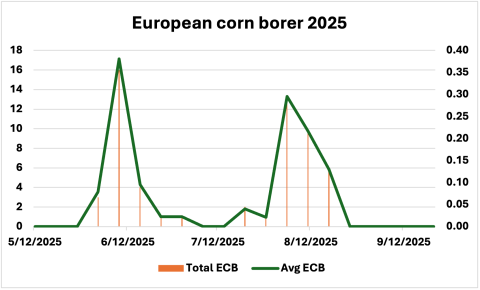
2025 European corn borer (combined NY and IA).
The left axis and columns (orange) represent the total numbers of ECB caught each week,
and the right axis and line (green) represent the average caught per week.
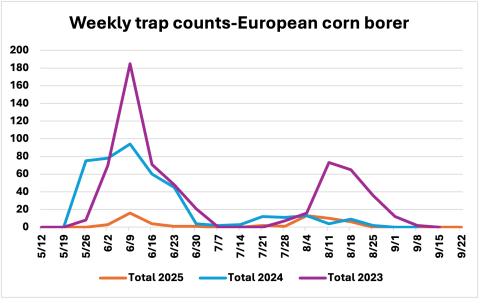
European corn borer weekly trap counts, 2023-2025.
Corn earworm numbers were much lower this year than last year due to the lack of storms bringing moths north over the summer. We observed small increases over the season with peak captures in mid-September (total <300). Most of our farms were on a recommended spray schedule greater than 4 days for most of the season.
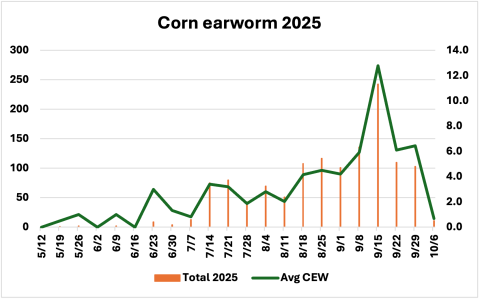
2025 Corn earworm.
The left axis and columns (orange) represent the total numbers of CEW caught each week,
and the right axis and line (green) represent the average caught per week.
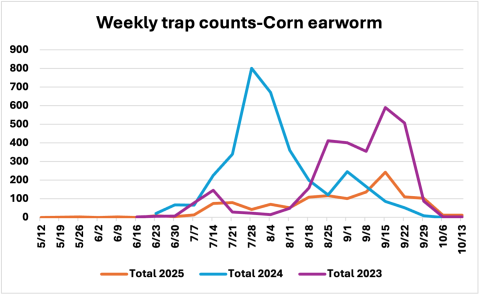
Corn earworm weekly trap counts, 2023-2025.
Fall armyworm numbers were overall lower than 2024, but once the moths showed up in July, pressure remained relatively steady for the rest of the season. Patterns were similar to 2024. Most of the feeding damage observed in sweet corn this year was from FAW larvae, especially in young corn. FAW can generally be controlled with CEW sprays, but with the longer spray intervals for CEW in 2025, some growers saw higher FAW damage.
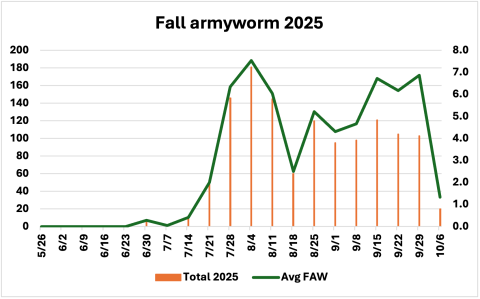
2025 Fall armyworm.
The left axis and columns (orange) represent the total numbers of FAW caught each week,
and the right axis and line (green) represent the average caught per week.
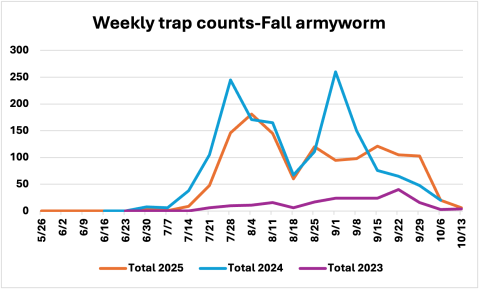
Fall armyworm weekly trap counts, 2023-2025.
Western bean cutworm is a newer pest to New England, moving east from the US corn belt. Generally, we observe one spike in captures at the end of July and then the numbers drop quickly. In 2025, western bean cutworm moths increased in late July and peaked in early August, but it took a few weeks for numbers to decrease unlike previous years. Numbers were lower overall than in 2024, with averages per trap not exceeding 6 moths/week whereas in 2024, averages peaked at 12 moths/week.
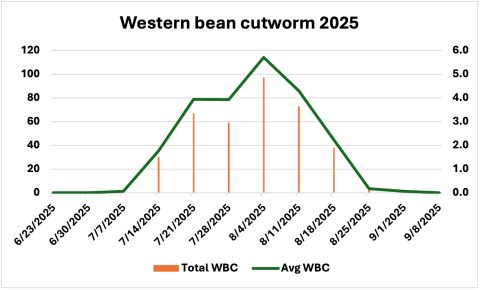
2025 Western bean cutworm.
The left axis and columns (orange) represent the total numbers of WBC caught each week,
and the right axis and line (green) represent the average caught per week.
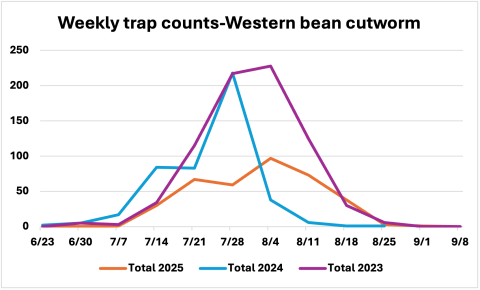
Western bean cutworm weekly trap counts, 2023-2025.
Squash vine borer pressure was not as high in 2025 as last year, and we did not confirm a 2nd generation in 2025 like we saw in 2024. Our peak captures occurred early/mid-July similar to 2023, but later than 2024.
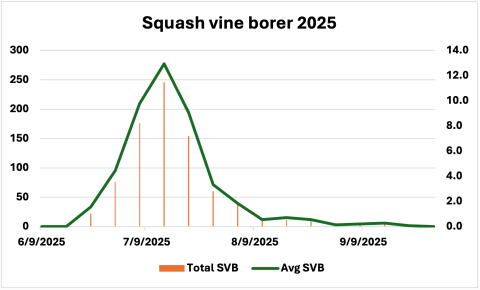
2025 Squash vine borer.
The left axis and columns (orange) represent the total numbers SVB caught each week,
and the right axis and line (green) represent the average caught per week.
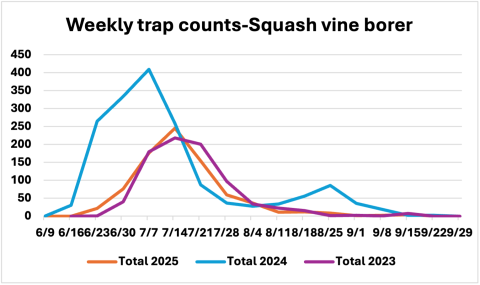
Squash vine borer weekly trap counts 2023-2025.
Brown marmorated stink bug numbers were higher than last year, with adult captures increasing in September as expected. BMSB pressure is worse in dry years.
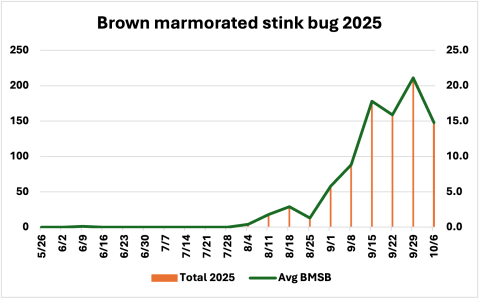
2025 Brown marmorated stink bug.
The left axis and columns (orange) represent the total numbers BMSB caught each week (adults and nymphs combined),
and the right axis and line (blue) represent the average caught per week.
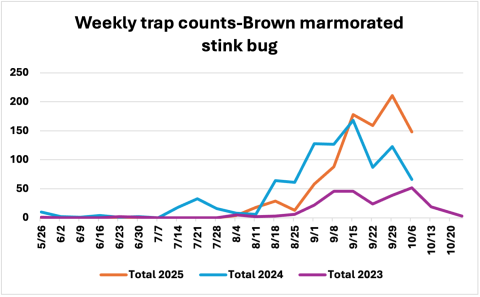
Brown marmorated stink bug weekly trap counts 2023-2025.
Spotted wing drosophila were higher overall this year compared to last year, especially in controls, blueberry, raspberry and grapes. We did not see high numbers in June like we did in 2024, and SWD captures increased slowly in July likely due to the high heat.
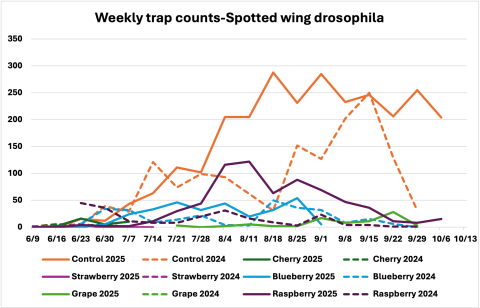
Spotted wing drosophila weekly male captures by crop for 2024 (dotted) and 2025 (solid).
Thank you to all the growers who participated in the program this year! Our annual surveys will be distributed in the coming weeks.
Contacts: Amber Vinchesi-Vahl, UNH Extension State Specialist, Entomology and IPM, Amber.Vinchesi@unh.edu; Liza DeGenring, UNH Extension Field Specialist, Hillsborough County, Liza.DeGenring@unh.edu
This program is made possible thought funding provided by the New Hampshire Department of Agriculture, Markets & Food Integrated Pest Management Program. This work is also supported in part by the University of New Hampshire Integrated Pest Management Extension Implementation Plan, project award no. 2024-70006-43535, from the U.S. Department of Agriculture's National Institute of Food and Agriculture.
Hello vegetable IPM folks!
Our trapping season is wrapping up! This will be the last regular season Vegetable IPM Report. Next week, I will send out a summary report with pest data over the 2025 season. Note: If you notice/noticed plant health issues, need to seek alternative sources of irrigation water, or are experiencing reduced yields due to the dry weather, please contact your County Extension Educator to report these impacts.
Corn earworm and fall armyworm catches have significantly decreased since last week. Our trap threshold/spray schedule table can be found in this fact sheet. Reminder that corn earworm is also known as tomato fruitworm, a pest of tomatoes, so be on the lookout for damage to tomatoes as well as to sweet corn. The results of our trapping efforts for sweet corn pests are recorded by town in Table 1 below.
Table 1. Sweet corn pest weekly summary, 10/6-10/10/2025.
Town | # CEW Moths | # Traps | Avg. CEW/Trap | # FAW Moths | # Traps | Avg. FAW/Trap |
|---|---|---|---|---|---|---|
Antrim | 0 | 1 | 0 | 1 | 1 | 1 |
Concord | 0 | 1 | 0 | 0 | 1 | 0 |
Hollis | 6 | 5 | 1.2 | 7 | 4 | 1.75 |
Hudson | 3 | 1 | 3 | 0 | 1 | 0 |
Litchfield | 0 | 2 | 0 | 1 | 2 | 0.5 |
Mason | 2 | 1 | 2 | 4 | 1 | 4 |
Milford | 0 | 2 | 0 | 0 | 2 | 0 |
New Boston | 0 | 2 | 0 | 7 | 2 | 3.5 |
Weare | 0 | 1 | 0 | 0 | 1 | 0 |
Totals | 11 | 16 | 0.69 | 20 | 15 | 1.33 |
Spotted wing drosophila numbers decreased with less traps out, though controls remain high. SWD male captures by crop are shown in Table 2 below. The control traps are located in unmanaged areas surrounding fields and may have more SWD than reported.
Table 2. Total male SWD captures by crop, 10/6-10/10/2025.
Crop | # SWD Males | # Traps | Average/Trap |
|---|---|---|---|
| Control | 204 | 2 | 102.0 |
| Raspberry | 15 | 4 | 3.8 |
| Total | 219 | 6 | 36.50 |
Brown marmorated stink bug captures have decreased since last week, but adults are still prevalent in certain locations. We generally see higher numbers in dry weather and later in the season. Both nymphs and adults can damage crops. In NH, BMSB is more of a nuisance pest but can cause damage to agricultural crops, including tomatoes and tree fruit. Be on the lookout if you have tomatoes and peppers near edge habitats. Captures by location are shown in Table 3 below.
Table 3. BMSB weekly summary, 10/6-10/10/25.
Town | # Adults | # Nymphs | # Traps | Total BMSB | Average BMSB/Trap |
|---|---|---|---|---|---|
Antrim | 6 | 0 | 1 | 6 | 6 |
Concord | 4 | 0 | 2 | 4 | 2 |
Hollis | 76 | 0 | 3 | 76 | 25.3 |
Litchfield | 31 | 6 | 2 | 37 | 18.5 |
Milford | 23 | 2 | 2 | 25 | 12.5 |
Total | 140 | 8 | 10 | 148 | 14.8 |
Miscellaneous information:
End-of-season considerations:
- Despite the low pressure from European corn borer this year, incorporate and/or destroy corn debris and stubble to reduce any overwintering ECB. Incorporating, destroying, and removing all plant debris will help reduce overwintering insects and pathogens.
- Consider which pesticides to purchase for next season depending on your pest pressure in 2025. Look at what you have available and what other FRAC or IRAC groups you may need for next year to rotate modes of action and prevent fungicide and insecticide resistance from developing.
- Consider planting cover crops to add organic matter to the soil and prevent soil erosion. Cover crops can also help retain moisture, outcompete weeds, and improve soil health.
- This is a good time to have soil tested to determine nutrient needs ahead of next season.
- Crop rotation helps mitigate pest pressure from season to season.
- Develop a weed management plan depending on how the 2025 season went. Which weeds were problematic? Was herbicide or cultivation timing off? Consider herbicide and cultivator options for 2026.
Previous pest, disease, and other relevant information can be found in past reports: https://extension.unh.edu/resource/vegetable-ipm-reports
Grant opportunities:
Northeast SARE Farmer Grant Program Call for 2026 Proposals!
The Northeast SARE Farmer Grant program provides funds to farmers to explore innovative concepts in sustainable agriculture conducted through experiments, surveys, prototypes, on-farm demonstrations or other research and education techniques. Farmer Grant projects must:
Be led by a farmer who meets Northeast SARE’s definition of a farm.Collaborate with a technical advisor. Request technical assistance here.
Impact both the farmer Project Leader and other farms in the region.
Explore an innovative practice and/or introduce an existing practice to a new audience of farmers.
Include outreach activities, or sharing of project impacts and results, to farmers beyond the project team and project participants.
Align with proposal criteria.
This grant program is open to farmers in the Northeast region. Projects typically range from $5,000 to a maximum of $30,000. Projects begin March 2026 and must take place in the Northeast. Q&A Sessions are taking place from 12-1 p.m. EST on November 4, 11, 18, 25. Register here for a Q&A Session. Proposal Due Date: Tuesday, December 9, 2025, 5:00 pm ET.
Upcoming events:
High Tunnel Production Conference: Enhance Your Tunnel Vision
December 10, 2025 | 9:00am - December 11, 2025 | 4:00pm
Fireside Inn and Suites, 25 Airport Road, West Lebanon, NH
Calling all high tunnel growers! Whether you are a new or experienced high tunnel grower, plan to join UMaine, UNH, and UVM for this two-day event. Come learn from experts and other farmers, talk with vendors, and see their products at the trade show. This conference will offer useful information for high tunnel growers and agricultural service providers of all experience levels and all crops. Cost is $120 for both days.* Registration fee includes the farm tour, all educational sessions, admission to the trade show, and lunch on Day 2. *Additional people from the same farm are just $90 each. Registration deadline is December 3. Find more information about the program and register here!
Reminder--The University of New Hampshire Plant Diagnostic Lab has temporarily suspended its services for the remainder of 2025. In the meantime, please refer to Extension's Plant Diagnostics webpage for a list of labs who have agreed to provide diagnostic services in the interim. Please note that soil analysis, insect identification, and tick testing services remain fully operational. We apologize for any disruptions caused by the temporary closure of the Plant Diagnostic Lab. We will provide updates regarding a reopening plan as it is finalized.
Please sign up for our text service! To sign up: text UNHIPM to 866-645-7010.
Thank you to all the growers who participate in the program!
Contacts: Amber Vinchesi-Vahl, UNH Extension State Specialist, Entomology and IPM, Amber.Vinchesi@unh.edu; Liza DeGenring, UNH Extension Field Specialist, Hillsborough County, Liza.DeGenring@unh.edu
This program is made possible thought funding provided by the New Hampshire Department of Agriculture, Markets & Food Integrated Pest Management Program. This work is also supported in part by the University of New Hampshire Integrated Pest Management Extension Implementation Plan, project award no. 2024-70006-43535, from the U.S. Department of Agriculture's National Institute of Food and Agriculture.
Hello vegetable IPM folks!
Our trapping season is wrapping up! Note: If you notice/noticed plant health issues, need to seek alternative sources of irrigation water, or are experiencing reduced yields due to the dry weather, please contact your County Extension Educator to report these impacts.
Corn earworm and fall armyworm catches are similar to last week. Our trap threshold/spray schedule table can be found in this fact sheet. Reminder that corn earworm is also known as tomato fruitworm, a pest of tomatoes, so be on the lookout for damage to tomatoes as well as to sweet corn. The results of our trapping efforts for sweet corn pests are recorded by town in Table 1 below. Note that only corn earworm and fall armyworm numbers are included, and we are reporting from fewer locations.
Table 1. Sweet corn pest weekly summary, 9/29-10/3/2025.
Town | # CEW Moths | # Traps | Avg. CEW/Trap | # FAW Moths | # Traps | Avg. FAW/Trap |
|---|---|---|---|---|---|---|
Antrim | 6 | 1 | 6 | 10 | 1 | 10 |
Concord | 2 | 1 | 2 | 3 | 1 | 3 |
Hollis | 71 | 5 | 14.2 | 63 | 4 | 15.75 |
Hudson | 9 | 1 | 9 | 3 | 1 | 3 |
Litchfield | 1 | 2 | 0.5 | 8 | 2 | 4 |
Mason | 10 | 1 | 10 | 5 | 1 | 5 |
Milford | 2 | 2 | 1 | 1 | 2 | 0.5 |
New Boston | 1 | 2 | 0.5 | 4 | 1 | 4 |
Weare | 1 | 1 | 1 | 6 | 2 | 3 |
Totals | 103 | 16 | 6.44 | 103 | 15 | 6.87 |
Zero squash vine borer moths were caught this week.
Spotted wing drosophila numbers increased from last week and controls remain high. SWD male captures by crop are shown in Table 2 below. The control traps are located in unmanaged areas surrounding fields and may have more SWD than reported.
Table 2. Total male SWD captures by crop, 9/29-10/3/2025.
Crop | # SWD Males | # Traps | Average/Trap |
|---|---|---|---|
| Control | 255 | 3 | 85.0 |
| Raspberry | 8 | 4 | 2.0 |
| Grapes | 3 | 2 | 1.5 |
| Total | 266 | 9 | 29.56 |
Brown marmorated stink bug captures have increased since last week. We generally see higher numbers in dry weather and later in the season. Both nymphs and adults can damage crops. In NH, BMSB is more of a nuisance pest but can cause damage to agricultural crops, including tomatoes and tree fruit. Be on the lookout if you have tomatoes and peppers near edge habitats. Captures by location are shown in Table 3 below.
Table 3. BMSB weekly summary, 9/29-10/3/25.
Town | # Adults | # Nymphs | # Traps | Total BMSB | Average BMSB/Trap |
|---|---|---|---|---|---|
Antrim | 9 | 3 | 1 | 12 | 12 |
Concord | 10 | 0 | 2 | 10 | 5 |
Hollis | 111 | 6 | 3 | 117 | 39.0 |
Litchfield | 34 | 4 | 2 | 39 | 19.5 |
Milford | 32 | 1 | 2 | 33 | 16.5 |
Total | 197 | 14 | 10 | 211 | 21.1 |
Miscellaneous information:
- End-of-season considerations:
- Despite the low pressure from European corn borer this year, incorporate and/or destroy corn debris and stubble to reduce any overwintering ECB. Incorporating, destroying, and removing all plant debris will help reduce overwintering insects and pathogens.
- Consider which pesticides to purchase for next season depending on your pest pressure in 2025. Look at what you have available and what other FRAC or IRAC groups you may need for next year to rotate modes of action and prevent fungicide and insecticide resistance from developing.
- Consider planting cover crops to add organic matter to the soil and prevent soil erosion. Cover crops can also help retain moisture, outcompete weeds, and improve soil health.
- This is a good time to have soil tested to determine nutrient needs ahead of next season.
- Crop rotation helps mitigate pest pressure from season to season.
- Develop a weed management plan depending on how the 2025 season went. Which weeds were problematic? Was herbicide or cultivation timing off? Consider herbicide and cultivator options for 2026.
- Previous pest, disease, and other relevant information can be found in past reports: https://extension.unh.edu/resource/vegetable-ipm-reports
Upcoming events:
Registration deadline Tuesday October 7!
- 2025 North Country Farm & Homestead Conference
October 15, 2025 | 9:00am - 3:00pm
516 Main Street, Lancaster Fair Grounds, Lancaster, NH
Join us for a day of learning, hands-on demonstrations, and community at the North Country Farm & Homestead Conference! Whether you're a homesteader, small-scale farmer, or aspiring grower, this event offers a mix of concurrent sessions and live demonstrations designed to help you build skills, improve your land, and strengthen your operation. From soil health and cover cropping to backyard livestock, beekeeping, and variety trials, you'll gain practical, real-world knowledge tailored to small-scale and diversified farming. Enjoy hands-on activities like chainsaw maintenance, tractor safety, shiitake log inoculation, alongside insightful discussions on food preservation. With opportunities to network with experts, explore the trade show, and share experiences with fellow growers! Cost: $30/person. Registration closes: October 7, 2025. Register and find more information here!
- High Tunnel Production Conference: Enhance Your Tunnel Vision
December 10, 2025 | 9:00am - December 11, 2025 | 4:00pm
Fireside Inn and Suites, 25 Airport Road, West Lebanon, NH
Calling all high tunnel growers! Whether you are a new or experienced high tunnel grower, plan to join UMaine, UNH, and UVM for this two-day event. Come learn from experts and other farmers, talk with vendors, and see their products at the trade show. This conference will offer useful information for high tunnel growers and agricultural service providers of all experience levels and all crops. Cost is $120 for both days.* Registration fee includes the farm tour, all educational sessions, admission to the trade show, and lunch on Day 2. *Additional people from the same farm are just $90 each. Registration deadline is December 3. Find more information about the program and register here!
Reminder--The University of New Hampshire Plant Diagnostic Lab has temporarily suspended its services for the remainder of 2025. In the meantime, please refer to Extension's Plant Diagnostics webpage for a list of labs who have agreed to provide diagnostic services in the interim. Please note that soil analysis, insect identification, and tick testing services remain fully operational. We apologize for any disruptions caused by the temporary closure of the Plant Diagnostic Lab. We will provide updates regarding a reopening plan as it is finalized.
Please sign up for our text service! To sign up: text UNHIPM to 866-645-7010.
Thank you to all the growers who participate in the program!
Contacts: Amber Vinchesi-Vahl, UNH Extension State Specialist, Entomology and IPM, Amber.Vinchesi@unh.edu; Liza DeGenring, UNH Extension Field Specialist, Hillsborough County, Liza.DeGenring@unh.edu
This program is made possible thought funding provided by the New Hampshire Department of Agriculture, Markets & Food Integrated Pest Management Program. This work is also supported in part by the University of New Hampshire Integrated Pest Management Extension Implementation Plan, project award no. 2024-70006-43535, from the U.S. Department of Agriculture's National Institute of Food and Agriculture.
Hello vegetable IPM folks!
I hope everyone received the much-needed rain this week. As fields are harvested, we will be reporting from less locations. New information this week is highlighted following the trapping data.
Note: If you notice/noticed plant health issues, need to seek alternative sources of irrigation water, or are experiencing reduced yields due to the dry weather, please contact your County Extension Educator to report these impacts.
End-of-season considerations:
- Despite the low pressure from European corn borer this year, incorporate and/or destroy corn debris and stubble to reduce any overwintering ECB. Incorporating, destroying, and removing all plant debris will help reduce overwintering insects and pathogens.
- Consider which pesticides to purchase for next season depending on your pest pressure in 2025. Look at what you have available and what other FRAC or IRAC groups you may need for next year to rotate modes of action and prevent fungicide and insecticide resistance from developing.
- Consider planting cover crops to add organic matter to the soil and prevent soil erosion. Cover crops can also help retain moisture, outcompete weeds, and improve soil health.
- This is a good time to have soil tested to determine nutrient needs ahead of next season.
- Crop rotation helps mitigate pest pressure from season to season.
- Develop a weed management plan depending on how the 2025 season went. Which weeds were problematic? Was herbicide or cultivation timing off? Consider herbicide and cultivator options for 2026.
Corn earworm catches have decreased by a little over half since last week. We have three locations on a 4-day spray schedule. Our trap threshold/spray schedule table can be found in this fact sheet, along with those for FAW. Reminder that corn earworm is also known as tomato fruitworm, a pest of tomatoes, so be on the lookout for damage to tomatoes as well as to sweet corn. Fall armyworm numbers are slightly down from last week. Only 2 locations are at or over threshold for silking corn (3+ moths/week). The results of our trapping efforts for sweet corn pests are recorded by town in Table 1 below. Note that only corn earworm and fall armyworm numbers are included, and we are reporting from fewer locations. We caught 0 European corn borer this week.
Table 1. Sweet corn pest weekly summary, 9/20-9/26/2025.
| Town | # ECB Moths | # Traps | Avg. ECB/Trap | # CEW Moths | # Traps | Avg. CEW/Trap |
|---|---|---|---|---|---|---|
| Antrim | 1 | 1 | 1 | 0 | 1 | 0 |
| Concord | 0 | 1 | 0 | 2 | 1 | 2 |
| Hollis | 72 | 6 | 12.0 | 90 | 5 | 18 |
| Hudson | 10 | 1 | 10 | 0 | 1 | 0 |
Litchfield | 2 | 2 | 1 | 6 | 2 | 3 |
| Mason | 21 | 1 | 21 | 2 | 1 | 2 |
Meredith | 1 | 1 | 1 | 0 | 1 | 0 |
| Milford | 1 | 2 | 0.5 | 0 | 2 | 0 |
New Boston | 1 | 2 | 0.5 | 2 | 1 | 2 |
| Weare | 0 | 1 | 0 | 0 | 2 | 0 |
| Totals | 109 | 18 | 6.06 | 102 | 17 | 6.00 |
One squash vine borer moth was caught this week in Milford. Our UNH Extension fact sheet is a great resource for this pest.
Spotted wing drosophila numbers are lower than last week but controls remain high, and we are reporting from less traps and locations. SWD male captures by crop are shown in Table 2 below. The control traps are located in unmanaged areas surrounding fields and may have more SWD than reported.
Table 2. Total male SWD captures by crop, 9/22-9/26/2025.
Crop | # SWD Males | # Traps | Average/Trap |
|---|---|---|---|
| Control | 206 | 3 | 68.7 |
| Raspberry | 11 | 4 | 2.8 |
| Grapes | 28 | 2 | 14.0 |
| Total | 245 | 9 | 27.22 |
Brown marmorated stink bug captures have decreased slightly since last week. We generally see higher numbers in dry weather and later in the season. Both nymphs and adults can damage crops. In NH, BMSB is more of a nuisance pest but can cause damage to agricultural crops, including tomatoes and tree fruit. Be on the lookout if you have tomatoes and peppers near edge habitats. Captures by location are shown in Table 3 below.
Table 3. BMSB weekly summary, 9/22-9/26/25.
Town | # Adults | # Nymphs | # Traps | Total BMSB | Average BMSB/Trap |
|---|---|---|---|---|---|
Antrim | 12 | 0 | 1 | 12 | 12 |
Concord | 6 | 0 | 2 | 6 | 3 |
Hollis | 83 | 4 | 3 | 87 | 29.0 |
Litchfield | 34 | 4 | 2 | 38 | 19 |
Milford | 12 | 4 | 2 | 16 | 8 |
Total | 147 | 12 | 10 | 159 | 15.9 |
Miscellaneous information:
- Wireworms can be an issue in many different crops, especially root crops like potatoes and sweet potatoes. Wireworms are the larvae of click beetles and reside underground in the soil. They can live for multiple years in the soil before pupating and emerging as adults. Wireworms prefer wet soils and moderate temperatures (≥70º F) and migrate up to reach warmer soils, but down to avoid excessive cold, heat, or drought. In agricultural fields, the crop itself is the primary food source since other food sources are not available. In potatoes, wireworms can feed on the seed piece, impacting stands, and they will also tunnel directly into tubers, reducing quality and yield. Feeding wounds are also entry points for plant pathogens. Damage can be worse in drought years since the crop provides the only moisture source for wireworms. They are most common in fields that were previously in sod, hay, pasture, grassy weeds, grass cover crops, or cereal grains. Chemical control can only be achieved before (seed piece treatment) and during planting. Details on chemical management for potatoes and sweet potatoes can be found in the New England Vegetable Management Guide. Delaying planting of susceptible crops, such as corn, potatoes or sweet potatoes, on previous pastureland for at least 2 years can help mitigate damage. If you have historical pressure from wireworms, think about management strategies for next spring before planting susceptible crops in fields with known wireworm pressure.
- Previous vegetable pest and disease information can be found in past reports: https://extension.unh.edu/resource/vegetable-ipm-reports
- Water pH and pesticides! Water pH & Pesticide Mixing: A Quick Reference for New Hampshire Applicators
- Rachel also wrote a new article on pesticide efficacy and drought conditions which can be found here.
- Drought resources: Guide to Drought Management for NH Growers and US Drought Monitor.
- Well Companies and bulk water haulers:
- Gilford Well- https://gilfordwell.com/
- Wragg Brothers Well Drilling and Water Treatment- https://www.wraggbrothers.com/
- List of Bulk water haulers from NH DES- https://www.des.nh.gov/sites/g/files/ehbemt341/files/documents/2020-01/bulk-haulers-providers.pdf
- Another bulk water hauler found online- https://hlr-trucking.com/
- New from SARE: Farmer-to-Farmer Manuals on Specialty Crop Production, Harvest and Storage in the Northeast. Now available from SARE, the Northeast Crop Production Manual and Northeast Harvest Manual are user-friendly guides offering step-by-step information on growing, harvesting and handling dozens of specialty crops, from arugula to watermelons. Developed by farmers themselves, these guides are ideal reference materials for beginning farmers, apprentices and crews based on years of on-the-ground experience. The Northeast Crop Production Manual covers soil preparation, planting and transplanting, pest management, and more. The Northeast Harvest Manual addresses harvest timing, best practices for picking, and post-harvest handling and storage guidelines.
Upcoming events:
- 2025 North Country Farm & Homestead Conference
October 15, 2025 | 9:00am - 3:00pm
516 Main Street, Lancaster Fair Grounds, Lancaster, NH
Join us for a day of learning, hands-on demonstrations, and community at the North Country Farm & Homestead Conference! Whether you're a homesteader, small-scale farmer, or aspiring grower, this event offers a mix of concurrent sessions and live demonstrations designed to help you build skills, improve your land, and strengthen your operation. From soil health and cover cropping to backyard livestock, beekeeping, and variety trials, you'll gain practical, real-world knowledge tailored to small-scale and diversified farming. Enjoy hands-on activities like chainsaw maintenance, tractor safety, shiitake log inoculation, alongside insightful discussions on food preservation. With opportunities to network with experts, explore the trade show, and share experiences with fellow growers! Cost: $30/person. Registration closes: October 7, 2025. Register and find more information here! - High Tunnel Production Conference: Enhance Your Tunnel Vision
December 10, 2025 | 9:00am - December 11, 2025 | 4:00pm
Fireside Inn and Suites, 25 Airport Road, West Lebanon, NH
Calling all high tunnel growers! Whether you are a new or experienced high tunnel grower, plan to join UMaine, UNH, and UVM for this two-day event. Come learn from experts and other farmers, talk with vendors, and see their products at the trade show. This conference will offer useful information for high tunnel growers and agricultural service providers of all experience levels and all crops. Cost is $120 for both days.* Registration fee includes the farm tour, all educational sessions, admission to the trade show, and lunch on Day 2. *Additional people from the same farm are just $90 each. Registration deadline is December 3. Find more information about the program and register here!
Reminder--The University of New Hampshire Plant Diagnostic Lab has temporarily suspended its services for the remainder of 2025. In the meantime, please refer to Extension's Plant Diagnostics webpage for a list of labs who have agreed to provide diagnostic services in the interim. Please note that soil analysis, insect identification, and tick testing services remain fully operational. We apologize for any disruptions caused by the temporary closure of the Plant Diagnostic Lab. We will provide updates regarding a reopening plan as it is finalized.
Please sign up for our text service! To sign up: text UNHIPM to 866-645-7010.
Check back in each week as the season progresses to see the latest trapping data. Data for additional insect pests will be updated on a weekly basis. Thank you to all the growers who participate in the program!
Contacts: Amber Vinchesi-Vahl, UNH Extension State Specialist, Entomology and IPM, Amber.Vinchesi@unh.edu; Liza DeGenring, UNH Extension Field Specialist, Hillsborough County, Liza.DeGenring@unh.edu
This program is made possible thought funding provided by the New Hampshire Department of Agriculture, Markets & Food Integrated Pest Management Program. This work is also supported in part by the University of New Hampshire Integrated Pest Management Extension Implementation Plan, project award no. 2024-70006-43535, from the U.S. Department of Agriculture's National Institute of Food and Agriculture.
Hello vegetable IPM folks!
As fields are harvested, we will be reporting from less locations. I hope the sunny, 70°F days are helping with ripening. I have also highlighted some of the new information this week. You can find it following the trapping data in this report.
Note: If you notice plant health issues, need to seek alternative sources of irrigation water, or are experiencing reduced yields due to the dry weather, please contact your County Extension Educator to report these impacts.
Corn earworm catches have increased again from last week. We have one location on a 3-day spray schedule and a few locations on a 4-day spray schedule. Our trap threshold/spray schedule table can be found in this fact sheet, along with those for FAW. Fall armyworm numbers are slightly up from last week. Five locations are still at or over threshold for silking corn (3+ moths/week). FAW prefers the youngest stage corn that is available. The results of our trapping efforts for sweet corn pests are recorded by town in Table 1 below. Note that only corn earworm and fall armyworm numbers are included. We caught 0 European corn borer this week.
Table 1. Sweet corn pest weekly summary, 9/13-9/19/2025.
| Town | # ECB Moths | # Traps | Avg. ECB/Trap | # CEW Moths | # Traps | Avg. CEW/Trap |
|---|---|---|---|---|---|---|
| Amherst | 0 | 1 | 0 | 0 | 1 | 0 |
| Antrim | 2 | 1 | 2 | 7 | 1 | 7 |
| Concord | 9 | 1 | 9 | 11 | 1 | 11 |
| Hollis | 190 | 6 | 31.7 | 90 | 5 | 18 |
| Hudson | 19 | 1 | 19 | 1 | 1 | 1 |
Litchfield | 0 | 2 | 0 | 2 | 2 | 1 |
| Mason | 16 | 1 | 16 | 5 | 1 | 5 |
Meredith | 1 | 1 | 1 | 1 | 1 | 1 |
| Milford | 2 | 2 | 1 | 0 | 2 | 0 |
New Boston | 3 | 2 | 1.5 | 0 | 1 | 0 |
Stratham | 2 | 1 | 2 | - | - | - |
| Weare | 1 | 1 | 1 | 5 | 2 | 2.5 |
| Totals | 245 | 20 | 12.25 | 122 | 18 | 6.78 |
Four squash vine borer moths were caught this week (2 in Milford, 1 in Hollis, 1 in Concord). We are still monitoring for a 2nd generation. Our UNH Extension fact sheet is a great resource for this pest. 2nd generation SVB larvae will bore directly into fruit.
Spotted wing drosophila numbers remain similar to last week. Yellowjackets have been more prevalent in fruit crops this year, likely due to the drought and the moisture/sugar source provided by berries. SWD male captures by crop are shown in Table 2 below. The control traps are located in unmanaged areas surrounding fields and may have more SWD than reported.
Table 2. Total male SWD captures by crop, 9/15-9/19/2025.
Crop | # SWD Males | # Traps | Average/Trap |
|---|---|---|---|
| Control | 246 | 4 | 61.5 |
| Raspberry | 36 | 6 | 6.0 |
| Grapes | 11 | 2 | 5.5 |
| Total | 293 | 12 | 24.42 |
Brown marmorated stink bug captures have doubled since last week. We generally see higher numbers in dry weather and later in the season. Both nymphs and adults can damage crops. In NH, BMSB is more of a nuisance pest but can cause damage to agricultural crops, including tomatoes and tree fruit. Be on the lookout if you have tomatoes and peppers near edge habitats. Captures by location are shown in Table 3 below.
Table 3. BMSB weekly summary, 9/15-9/19/25.
Town | # Adults | # Nymphs | # Traps | Total BMSB | Average BMSB/Trap |
|---|---|---|---|---|---|
Antrim | 8 | 0 | 1 | 8 | 8 |
Concord | 8 | 4 | 2 | 12 | 6 |
Hollis | 90 | 2 | 3 | 92 | 30.7 |
Litchfield | 35 | 5 | 2 | 40 | 20 |
Milford | 23 | 3 | 2 | 26 | 13 |
Total | 164 | 14 | 10 | 178 | 17.8 |
Disease of the Week:
Let’s discuss postharvest rots of root crops (carrots, parsnips, beets, radish, turnip, and rutabaga)! As previously discussed, correct harvesting and storing greatly reduces the likelihood of a post-harvest disease and loss in storage.
Relevant post-harvest diseases of root vegetables include: Rhizoctonia dry rot (Rhizoctonia carotae), Sclerotinia white mold (Sclerotinia sclerotiorium); Bacterial soft rot (Pectobacterium, Dickeya spp.), Alternaria black rot (Alternaria radicina), and Cavity spot and Root Dieback (Pythium spp.)
Top management options are: 1) Avoid excess moisture close to harvest (not an issue this year); 2) Harvest carefully – avoid damaging crops during harvest as this makes them highly susceptible to disease AND remove any crop that has damage or has symptoms of disease; 4) Store crops properly and make sure to rapidly cool after harvest; 4) Sanitation – clean out and disinfect storage bins and rooms between seasons.
While there are some fungicide options available for managing these diseases, they would have needed to be applied during the growing season. So, if you have issues with any of these diseases, keep note, and we can make a plan for management for next year! The New England Vegetable Management Guide for carrots and parsnips have great information about these diseases, fungicide options, and proper storage practices as well as the links provided for each disease.
Miscellaneous information:
- For those dealing with poor fruit set or misshapen squash and pumpkins, it was likely due to the hot temperatures we had during pollination. Some pollen gets killed during hot temperatures so there are some southern pumpkin options that are better for hot temperatures: https://hybridseedcompany.com/southern-pumpkins
- Previous vegetable pest and disease information can be found in past reports: https://extension.unh.edu/resource/vegetable-ipm-reports
- Drought resources: Guide to Drought Management for NH Growers and US Drought Monitor.
- Well Companies and bulk water haulers:
- Gilford Well- https://gilfordwell.com/
- Wragg Brothers Well Drilling and Water Treatment- https://www.wraggbrothers.com/
- List of Bulk water haulers from NH DES- https://www.des.nh.gov/sites/g/files/ehbemt341/files/documents/2020-01/bulk-haulers-providers.pdf
- Another bulk water hauler found online- https://hlr-trucking.com/
- New from SARE: Farmer-to-Farmer Manuals on Specialty Crop Production, Harvest and Storage in the Northeast. Now available from SARE, the Northeast Crop Production Manual and Northeast Harvest Manual are user-friendly guides offering step-by-step information on growing, harvesting and handling dozens of specialty crops, from arugula to watermelons. Developed by farmers themselves, these guides are ideal reference materials for beginning farmers, apprentices and crews based on years of on-the-ground experience. The Northeast Crop Production Manual covers soil preparation, planting and transplanting, pest management, and more. The Northeast Harvest Manual addresses harvest timing, best practices for picking, and post-harvest handling and storage guidelines.
- Water use and food safety! UNH Extension Food Safety State Specialist, Wendy Johnecheck, recently published a blog about Water Use on Produce Farms: A Focus on Food Safety. This is a great refresher and/or resource for requirements and recordkeeping related to FSMA.
- New pesticide resources! UNH Extension Pesticide Safety Education Field Specialist, Rachel Maccini, has recently shared a few blog posts that may be helpful. The links and more information can be found below.
- Safe and Responsible Pesticide Disposal: What to Do with Unused Products
- Why Checking Pesticide Registration in New Hampshire Matters
- Pesticide Labels: I Need a New One
- Introducing Denyce Gagne, new Enforcement Program Manager for Pesticide Control
- Rachel also wrote a new article on pesticide efficacy and drought conditions which can be found here.
- The EPA released a new app to help with pesticide label mitigations. More information can be found here.
- Soil pH and nutrient management! UNH Extension Soil Heath State Specialist, Renuka Mathur, put together some information on soil pH and how that impacts nutrient availability. See the Veg IPM Report from 8.15.25 for more information.
Upcoming events:
- 2025 North Country Farm & Homestead Conference
October 15, 2025 | 9:00am - 3:00pm
516 Main Street, Lancaster Fair Grounds, Lancaster, NH
Join us for a day of learning, hands-on demonstrations, and community at the North Country Farm & Homestead Conference! Whether you're a homesteader, small-scale farmer, or aspiring grower, this event offers a mix of concurrent sessions and live demonstrations designed to help you build skills, improve your land, and strengthen your operation. From soil health and cover cropping to backyard livestock, beekeeping, and variety trials, you'll gain practical, real-world knowledge tailored to small-scale and diversified farming. Enjoy hands-on activities like chainsaw maintenance, tractor safety, shiitake log inoculation, alongside insightful discussions on food preservation. With opportunities to network with experts, explore the trade show, and share experiences with fellow growers! Cost: $30/person. Registration closes: October 7, 2025. Register and find more information here! - High Tunnel Production Conference: Enhance Your Tunnel Vision
December 10, 2025 | 9:00am - December 11, 2025 | 4:00pm
Fireside Inn and Suites, 25 Airport Road, West Lebanon, NH
Calling all high tunnel growers! Whether you are a new or experienced high tunnel grower, plan to join UMaine, UNH, and UVM for this two-day event. Come learn from experts and other farmers, talk with vendors, and see their products at the trade show. This conference will offer useful information for high tunnel growers and agricultural service providers of all experience levels and all crops. Cost is $120 for both days.* Registration fee includes the farm tour, all educational sessions, admission to the trade show, and lunch on Day 2. *Additional people from the same farm are just $90 each. Registration deadline is December 3. Find more information about the program and register here!
Reminder--The University of New Hampshire Plant Diagnostic Lab has temporarily suspended its services for the remainder of 2025. In the meantime, please refer to Extension's Plant Diagnostics webpage for a list of labs who have agreed to provide diagnostic services in the interim. Please note that soil analysis, insect identification, and tick testing services remain fully operational. We apologize for any disruptions caused by the temporary closure of the Plant Diagnostic Lab. We will provide updates regarding a reopening plan as it is finalized.
Please sign up for our text service! To sign up: text UNHIPM to 866-645-7010.
Check back in each week as the season progresses to see the latest trapping data. Data for additional insect pests will be updated on a weekly basis. Thank you to all the growers who participate in the program!
Contacts: Amber Vinchesi-Vahl, UNH Extension State Specialist, Entomology and IPM, Amber.Vinchesi@unh.edu; Liza DeGenring, UNH Extension Field Specialist, Hillsborough County, Liza.DeGenring@unh.edu
This program is made possible thought funding provided by the New Hampshire Department of Agriculture, Markets & Food Integrated Pest Management Program. This work is also supported in part by the University of New Hampshire Integrated Pest Management Extension Implementation Plan, project award no. 2024-70006-43535, from the U.S. Department of Agriculture's National Institute of Food and Agriculture.
Hello vegetable IPM folks!
As fields are harvested and pest pressure decreases with the cooling temperatures, we will be reporting from less locations.
Corn earworm catches have more than doubled from last week with the weekend storms bringing moths north. We have a few locations on a 4-day spray schedule. Our trap threshold/spray schedule table can be found in this fact sheet, along with those for FAW. Fall armyworm numbers are like last week. Six locations are still at or over threshold for silking corn (3+ moths/week). FAW prefers the youngest stage corn that is available. The results of our trapping efforts for sweet corn pests are recorded by town in Table 1 below. Note that only corn earworm and fall armyworm numbers are included. We caught 0 European corn borer this week.
Table 1. Sweet corn pest weekly summary, 9/6-9/12/2025.
| Town | # ECB Moths | # Traps | Avg. ECB/Trap | # CEW Moths | # Traps | Avg. CEW/Trap |
|---|---|---|---|---|---|---|
| Amherst | 0 | 1 | 0 | 0 | 1 | 0 |
| Antrim | 0 | 1 | 0 | 2 | 1 | 2 |
| Concord | 2 | 1 | 2 | 3 | 1 | 3 |
| Conway | 1 | 1 | 1 | 2 | 1 | 2 |
| Hollis | 73 | 6 | 12.2 | 67 | 5 | 13.4 |
| Hudson | 12 | 1 | 12 | 1 | 1 | 1 |
| Jaffrey | 2 | 1 | 2 | 8 | 1 | 8 |
Litchfield | 9 | 2 | 4.5 | 2 | 2 | 1 |
| Mason | 7 | 1 | 7 | 3 | 1 | 3 |
Meredith | 4 | 1 | 4 | 4 | 1 | 4 |
| Milford | 10 | 2 | 5 | 1 | 2 | 0.5 |
New Boston | 14 | 2 | 7 | 8 | 2 | 4 |
New London | 1 | 1 | 1 | 2 | 1 | 2 |
Stratham | 30 | 1 | 30 | - | - | - |
| Weare | 0 | 2 | 0 | 0 | 2 | 0 |
| Totals | 165 | 24 | 6.88 | 103 | 22 | 4.68 |
Three squash vine borer moths were caught this week in Milford. We are still monitoring for a 2nd generation. Our UNH Extension fact sheet is a great resource for this pest.
Spotted wing drosophila numbers remain high in controls and raspberries but have decreased overall from last week due to the cooler temperatures. Blueberry traps have been pulled for the season. Yellowjackets have been more prevalent in fruit crops this year, likely due to the drought and the moisture/sugar source provided by berries. SWD male captures by crop are shown in Table 2 below. The control traps are located in unmanaged areas surrounding fields and may have more SWD than reported.
Table 2. Total male SWD captures by crop, 9/8-9/12/2025.
Crop | # SWD Males | # Traps | Average/Trap |
|---|---|---|---|
| Control | 233 | 4 | 58.3 |
| Raspberry | 47 | 7 | 6.7 |
| Grapes | 8 | 2 | 4.0 |
| Total | 288 | 13 | 22.15 |
Brown marmorated stink bug captures have increased again. We generally see higher numbers in dry weather and later in the season. Both nymphs and adults can damage crops. In NH, BMSB is more of a nuisance pest but can cause damage to agricultural crops, including tomatoes and tree fruit. Be on the lookout if you have tomatoes and peppers near edge habitats. Captures by location are shown in Table 3 below.
Table 3. BMSB weekly summary, 9/8-9/12/25.
Town | # Adults | # Nymphs | # Traps | Total BMSB | Average BMSB/Trap |
|---|---|---|---|---|---|
Antrim | 9 | 2 | 1 | 11 | 11 |
Concord | 8 | 3 | 2 | 11 | 5.5 |
Hollis | 31 | 1 | 3 | 32 | 10.7 |
Litchfield | 8 | 15 | 2 | 23 | 11.5 |
Milford | 6 | 5 | 2 | 11 | 5.5 |
Total | 62 | 26 | 10 | 88 | 8.8 |
Miscellaneous pest information:
- Previous vegetable pest and disease information can be found in past reports: https://extension.unh.edu/resource/vegetable-ipm-reports
Disease of the Week:
Let’s discuss harvesting pumpkins, squashes, and gourds! As previously discussed, correct harvesting and storing greatly reduces the likelihood of a post-harvest disease and loss in storage. This Cornell fact sheet and the New England Vegetable Management guide have great information about maturity, harvest, and storage of winter squash and pumpkins.
Something that is key to remember as we are getting cooler nights is that fruits should not be exposed to 32º F, as this can promote storage problems. If possible, pumpkins that have reached full color should be stored under cover to protect them from chilling injury from temperatures below 50º F and from disease.
There are many post-harvest diseases that can infect squashes and pumpkins (you may see some similarities to last week’s list): Black rot (Didymella bryoniae), Fusarium Rot (Fusraium solani f.sp. cucurbitae), Phyopthora Fruit Rot (Phytophthora capsici), Anthracnose (Colletotrichum orbiculare), Alternaria Rot (Alternaria alternata), Bacterial Soft Rot (Pectobacterium and Dickeya spp.), and Gray Mold (Botrytis cinerea). An important note is that growers may see sun scald on their fruit due to the high temperatures that we had this summer and potentially low canopy cover. This may look similar to post-harvest disease symptoms.
The best management options are to prevent injuries during harvest – these wounds and bruises can be entry points for diseases such as Fusarium, Alternaria, and bacterial rots. Curing and proper storage temperature and humidity will greatly decrease disease and the potential spread of disease.
While there are some fungicide options available for managing these diseases, they would have needed to be applied during the growing season. So, if you have issues with any of these diseases, keep note, and we can make a plan for management for next year!
Other information of note:
- Drought resources: Guide to Drought Management for NH Growers and US Drought Monitor.
- Water use and food safety! UNH Extension Food Safety State Specialist, Wendy Johnecheck, recently published a blog about Water Use on Produce Farms: A Focus on Food Safety. This is a great refresher and/or resource for requirements and recordkeeping related to FSMA.
- New pesticide safety resources! UNH Extension Pesticide Safety Education Field Specialist, Rachel Maccini, has recently shared a few blog posts that may be helpful. The links and more information can be found below.
Rachel also wrote a new article on pesticide efficacy and drought conditions which can be found here.
The EPA released a new app to help with pesticide label mitigations. More information can be found here.
- Soil pH and nutrient management! UNH Extension Soil Heath State Specialist, Renuka Mathur, put together some information on soil pH and how that impacts nutrient availability. See the Veg IPM Report from 8.15.25 for more information.
Upcoming events:
- 2025 North Country Farm & Homestead Conference
October 15, 2025 | 9:00am - 3:00pm
516 Main Street, Lancaster Fair Grounds, Lancaster, NH
Join us for a day of learning, hands-on demonstrations, and community at the North Country Farm & Homestead Conference! Whether you're a homesteader, small-scale farmer, or aspiring grower, this event offers a mix of concurrent sessions and live demonstrations designed to help you build skills, improve your land, and strengthen your operation. From soil health and cover cropping to backyard livestock, beekeeping, and variety trials, you'll gain practical, real-world knowledge tailored to small-scale and diversified farming. Enjoy hands-on activities like chainsaw maintenance, tractor safety, shiitake log inoculation, alongside insightful discussions on food preservation. With opportunities to network with experts, explore the trade show, and share experiences with fellow growers! Cost: $30/person. Registration closes: October 7, 2025. Register and find more information here! - High Tunnel Production Conference: Enhance Your Tunnel Vision
December 10, 2025 | 9:00am - December 11, 2025 | 4:00pm
Fireside Inn and Suites, 25 Airport Road, West Lebanon, NH
Calling all high tunnel growers! Whether you are a new or experienced high tunnel grower, plan to join UMaine, UNH, and UVM for this two-day event. Come learn from experts and other farmers, talk with vendors, and see their products at the trade show. This conference will offer useful information for high tunnel growers and agricultural service providers of all experience levels and all crops. Cost is $120 for both days.* Registration fee includes the farm tour, all educational sessions, admission to the trade show, and lunch on Day 2. *Additional people from the same farm are just $90 each. Registration deadline is December 3. Find more information about the program and register here!
Reminder--The University of New Hampshire Plant Diagnostic Lab has temporarily suspended its services for the remainder of 2025. In the meantime, please refer to Extension's Plant Diagnostics webpage for a list of labs who have agreed to provide diagnostic services in the interim. Please note that soil analysis, insect identification, and tick testing services remain fully operational. We apologize for any disruptions caused by the temporary closure of the Plant Diagnostic Lab. We will provide updates regarding a reopening plan as it is finalized.
Please sign up for our text service! To sign up: text UNHIPM to (866) 645-7010.
Check back in each week as the season progresses to see the latest trapping data. Data for additional insect pests will be updated on a weekly basis. Thank you to all the growers who participate in the program!
Contacts: Amber Vinchesi-Vahl, UNH Extension State Specialist, Entomology and IPM, Amber.Vinchesi@unh.edu; Liza DeGenring, UNH Extension Field Specialist, Hillsborough County, Liza.DeGenring@unh.edu
This program is made possible thought funding provided by the New Hampshire Department of Agriculture, Markets & Food Integrated Pest Management Program. This work is also supported in part by the University of New Hampshire Integrated Pest Management Extension Implementation Plan, project award no. 2024-70006-43535, from the U.S. Department of Agriculture's National Institute of Food and Agriculture.
Hello vegetable IPM folks!
I hope harvest season is going well for everyone despite the lack of water.
We caught 0 European corn borer this week. We captured 1 western bean cutworm in Hollis, indicating the end of WBC for 2025.
Corn earworm catches have decreased, with a few locations on a 5- or 6-day spray schedule. Our trap threshold/spray schedule table can be found in this fact sheet, along with those for ECB and FAW.
Fall armyworm numbers have also decreased since last week. Six locations are still over threshold for silking corn (3+ moths/week). Be on the lookout for larval feeding damage which is characterized by large, ragged holes in leaves, and sawdust-like excrement. FAW prefers the youngest stage corn that is available.
The results of our trapping efforts for sweet corn pests are recorded by town in Table 1 below. In some cases, there are multiple traps within a town. Note that only corn earworm and fall armyworm numbers are included.
Table 1. Sweet corn pest weekly summary, 8/30-9/5/2025.
| Town | # ECB Moths | # Traps | Avg. ECB/Trap | # CEW Moths | # Traps | Avg. CEW/Trap |
|---|---|---|---|---|---|---|
| Amherst | 1 | 1 | 1 | 0 | 1 | 0 |
| Antrim | 0 | 1 | 0 | 5 | 1 | 5 |
| Concord | 0 | 1 | 0 | 4 | 1 | 4 |
| Conway | 1 | 1 | 1 | 4 | 1 | 4 |
| Hollis | 37 | 6 | 6.2 | 62 | 5 | 12.4 |
| Hudson | 7 | 1 | 7 | 0 | 1 | 0 |
| Jaffrey | 2 | 1 | 2 | 0 | 1 | 0 |
Litchfield | 7 | 2 | 3.5 | 0 | 2 | 0 |
| Mason | 7 | 1 | 7 | 1 | 1 | 1 |
Meredith | 1 | 1 | 1 | 6 | 1 | 6 |
| Milford | 3 | 2 | 1.5 | 2 | 2 | 1 |
New Boston | 1 | 2 | 0.5 | 10 | 2 | 5 |
New London | 3 | 1 | 3 | 2 | 1 | 2 |
Stratham | 4 | 1 | 4 | - | - | - |
| Weare | 0 | 2 | 0 | 3 | 2 | 1.5 |
| Totals | 74 | 24 | 3.08 | 99 | 22 | 4.50 |
Only 2 squash vine borer moths were caught this week—one in Litchfield and one in Hollis. We are still trapping to monitor for a 2nd generation. Our UNH Extension fact sheet is a great resource for this pest.
Spotted wing drosophila numbers remain high and similar to last week, with increases in grape and control traps. If you have susceptible ripening fruit, monitor for SWD and apply management as needed. More information on monitoring for SWD can be found here. Frequent harvesting and placing harvested berries in the fridge can help slow SWD development within the fruit. This resource from Cornell on SWD management includes insecticides for each crop group that SWD may infest but be sure to check the label for use in NH. Captures by crop are shown in Table 2 below.The control traps are located in unmanaged areas surrounding fields and may have more SWD than reported.
Table 2. Total male SWD captures by crop, 9/1-9/5/2025.
Crop | # SWD Males | # Traps | Average/Trap |
|---|---|---|---|
| Control | 285 | 4 | 71.3 |
| Blueberry | 5 | 1 | 5.0 |
| Raspberry | 69 | 7 | 9.9 |
| Grapes | 17 | 2 | 8.5 |
| Total | 376 | 14 | 26.86 |
Brown marmorated stink bug captures have increased again. We generally see higher numbers in dry weather and later in the season. Both nymphs and adults can damage crops. Anna Wallingford recorded a podcast on BMSB that can be found here. You can also read through the transcript rather than listen if that is preferred. In NH, BMSB is more of a nuisance pest but can cause damage to agricultural crops, including tomatoes and tree fruit. Be on the lookout if you have tomatoes and peppers near edge habitats. Captures by location are shown in Table 3 below. There are currently no treatment thresholds for BMSB and vegetables but research in the Northeast is ongoing. For those who also grow tree fruit, insecticide applications are recommended for apples using a threshold of 10+ adult BMSB/trap. The threshold is reset after each insecticide application until the 10 adults/trap threshold is reached again to trigger another insecticide spray. This threshold can also be used for peaches. More information can be found in the New England Tree Fruit Management Guide.
Table 3. BMSB weekly summary, 9/1-9/5/25.
Town | # Adults | # Nymphs | # Traps | Total BMSB | Average BMSB/Trap |
|---|---|---|---|---|---|
Antrim | 6 | 2 | 1 | 8 | 8 |
Concord | 0 | 5 | 2 | 5 | 2.5 |
Hollis | 17 | 0 | 3 | 17 | 5.7 |
Litchfield | 9 | 9 | 2 | 18 | 9 |
Milford | 3 | 7 | 2 | 10 | 5 |
Total | 35 | 23 | 10 | 58 | 5.8 |
Miscellaneous pest information:
- For those of you that experienced hail last week, here is a resource from Purdue University on hail damage to vegetables. Disease management is important after hail, be sure to check fungicide labels for use in New Hampshire and cull damaged fruit for certain crops. Defoliation from hail can also expose fruit to sunburn. Some crops recover better than others.
- Cabbage root maggot information can be found in the Vegetable IPM Report from 8.8.25. This is a pest to look out for if you have fall brassicas and the weather is especially cool and wet.
- Previous vegetable pest and disease information can be found in past reports: https://extension.unh.edu/resource/vegetable-ipm-reports
Disease of the Week:
Over the next couple of weeks, we will focus on post-harvest rots and tools for preventing them as you get through harvest. Post-harvest diseases are those that present symptoms once the crop is already harvested and in storage, however, there are times when the infection can occur in the field prior to harvest.
Let’s focus on ONIONS this week. Some common post-harvest diseases of onions are Botrytis Neck Rot (caused by Botrytis allii), Bacterial Soft Rot (caused by Erwinia carotovora), Fusarium Basal Rot (caused by Fusarium oxysporum f. sp. cepae), Purple Blotch (caused by Alternaria porri), White Rot (caused by Sclerotium cepivorum), and the more ubiquitous fungal diseases of stored fruits and vegetables: Blue mold (Penicillium sp.) and Black mold (Aspergillus niger).
While these various diseases represent both fungal and bacterial pathogens, there are things that can be done to prevent onion post-harvest diseases of all kinds. Good cultural control options are key to preventing disease: disease-free seed, resistant cultivars, not applying nitrogen fertilizer later than ~8-9 weeks after seeding, proper spacing of onions, removing plant debris at end of season, allowing tops to mature, and minimizing injury (either insect or mechanical).
Finally proper undercutting, curing, and storage are key to preventing post-harvest diseases of onions. Making sure that you are using the proper techniques and environmental parameters will keep your onions viable and disease free. This quick video out of UMaine Extension is a great review of harvesting and storing onions: https://extension.umaine.edu/food-health/food-preservation/how-to-videos/how-to-harvest-and-store-onions/#
While there are some fungicide options available for managing these diseases, they would have needed to be applied during the growing season. So, if you have issues with any of these diseases, keep note, and we can make a plan for management for next year!
Other information of note:
-Drought resources: Guide to Drought Management for NH Growers and US Drought Monitor.
-Water use and food safety! UNH Extension Food Safety State Specialist, Wendy Johnecheck, recently published a blog about Water Use on Produce Farms: A Focus on Food Safety. This is a great refresher and/or resource for requirements and recordkeeping related to FSMA.
-New pesticide safety resources! UNH Extension Pesticide Safety Education Field Specialist, Rachel Maccini, has recently shared a few blog posts that may be helpful. The links and more information can be found below.
- Safe and Responsible Pesticide Disposal: What to Do with Unused Products
- Why Checking Pesticide Registration in New Hampshire Matters
- Pesticide Labels: I Need a New One
- Introducing Denyce Gagne, new Enforcement Program Manager for Pesticide Control
Rachel also wrote a new article on pesticide efficacy and drought conditions which can be found here.
The EPA released a new app to help with pesticide label mitigations. More information can be found here.
-Soil pH and nutrient management! UNH Extension Soil Heath State Specialist, Renuka Mathur, put together some information on soil pH and how that impacts nutrient availability. See the Veg IPM Report from 8.15.25 for more information.
Upcoming events:
-2025 North Country Farm & Homestead Conference
October 15, 2025 | 9:00 a.m. - 3:00 p.m.
516 Main Street, Lancaster Fair Grounds, Lancaster, NH
Join us for a day of learning, hands-on demonstrations, and community at the North Country Farm & Homestead Conference! Whether you're a homesteader, small-scale farmer, or aspiring grower, this event offers a mix of concurrent sessions and live demonstrations designed to help you build skills, improve your land, and strengthen your operation. From soil health and cover cropping to backyard livestock, beekeeping, and variety trials, you'll gain practical, real-world knowledge tailored to small-scale and diversified farming. Enjoy hands-on activities like chainsaw maintenance, tractor safety, shiitake log inoculation, alongside insightful discussions on food preservation. With opportunities to network with experts, explore the trade show, and share experiences with fellow growers! Cost: $30/person. Registration closes: October 7, 2025. Register and find more information here!
-High Tunnel Production Conference: Enhance Your Tunnel Vision
December 10, 2025 | 9:00 a.m. - December 11, 2025 | 4:00 p.m.
Fireside Inn and Suites, 25 Airport Road, West Lebanon, NH
Calling all high tunnel growers! Whether you are a new or experienced high tunnel grower, plan to join UMaine, UNH, and UVM for this two-day event. Come learn from experts and other farmers, talk with vendors, and see their products at the trade show. This conference will offer useful information for high tunnel growers and agricultural service providers of all experience levels and all crops. Cost is $120 for both days.* Registration fee includes the farm tour, all educational sessions, admission to the trade show, and lunch on Day 2. *Additional people from the same farm are just $90 each. Registration deadline is December 3. Find more information about the program and register here!
Reminder--The University of New Hampshire Plant Diagnostic Lab has temporarily suspended its services for the remainder of 2025. In the meantime, please refer to Extension's Plant Diagnostics webpage for a list of labs who have agreed to provide diagnostic services in the interim. Please note that soil analysis, insect identification, and tick testing services remain fully operational. We apologize for any disruptions caused by the temporary closure of the Plant Diagnostic Lab. We will provide updates regarding a reopening plan as it is finalized.
Please sign up for our text service! To sign up: text UNHIPM to (866) 645-7010.
Check back in each week as the season progresses to see the latest trapping data. Data for additional insect pests will be updated on a weekly basis. Thank you to all the growers who participate in the program!
Contacts: Amber Vinchesi-Vahl, UNH Extension State Specialist, Entomology and IPM, Amber.Vinchesi@unh.edu; Liza DeGenring, UNH Extension Field Specialist, Hillsborough County, Liza.DeGenring@unh.edu
This program is made possible thought funding provided by the New Hampshire Department of Agriculture, Markets & Food Integrated Pest Management Program. This work is also supported in part by the University of New Hampshire Integrated Pest Management Extension Implementation Plan, project award no. 2024-70006-43535, from the U.S. Department of Agriculture's National Institute of Food and Agriculture.
Hello vegetable IPM folks!
For those of you that experienced hail on Wednesday, here is a resource from Purdue University on hail damage to vegetables. Disease management is important after hail, be sure to check fungicide labels for use in New Hampshire and cull damaged fruit for certain crops. Defoliation from hail can also expose fruit to sunburn. Some crops recover better than others.
We caught 6 European corn borer moths this week in western NH. Click HERE for more information on ECB management.
Corn earworm catches have increased, with a few locations on a 4-day spray schedule and many others on a 5–6-day schedule. If you have silking corn, be sure to scout for CEW and prepare for management. Our trap threshold/spray schedule table can be found in the fact sheet linked below, along with those for ECB and FAW. CEW eggs hatch in 2-5 days depending on temperature and newly hatched larvae move down the silk into the ears quickly. Insecticide control of CEW requires good protective coverage of the ear zone so that when the eggs hatch, the young larvae will immediately contact a lethal dose of insecticide.
A note on corn earworm insecticide resistance: Rotate chemical classes to delay resistance development and help mitigate pyrethroid (Group 3) resistance that may be occurring in the southern US. It’s best to avoid spraying pyrethroids more than twice in a row. New England faces unique challenges in managing insecticide resistance for CEW. The moths are migrating from the southern US, where they were likely already exposed to pesticides and we get new populations every year with varying degrees of resistance. We are also experiencing warmer temperatures and the potential for more pests overwintering in NH that have not historically overwintered here. We also have limited options for insecticide modes of action, some of which may be cost-prohibitive. Continue monitoring moths and insecticide efficacy in controlling CEW. Please let us know if you are no longer seeing control with products that have controlled CEW in the past.
Fall armyworm numbers have increased since last week. Most locations are still over threshold for silking corn (3+ moths/week). Be on the lookout for larval feeding damage which is characterized by large, ragged holes in leaves, and sawdust-like excrement. FAW is likely to be controlled with a tighter spray schedule for CEW, but if you are using a longer spray interval for CEW, or don’t need to spray for CEW, continue to scout fields for FAW and implement controls if >15% are infested (silk) and >30% (whorl-silk). FAW prefers the youngest stage corn that is available.
Our scout observed 0-5% damage to sweet corn this week from insects depending on location, averaging 2.5% damage across scouted fields. Field scouting should begin once moths are captured at your farm or in your area. Threshold information for the sweet corn caterpillars can be found here.
Western bean cutworm captures are close to zero, indicating the end of WBC for 2025. We generally see this pest increase quickly, hitting its peak in late July, and then decreasing rapidly in early August. This summer, WBC did not decrease rapidly, and we observed an extended population peak.
The results of our trapping efforts for sweet corn pests are recorded by town in Table 1 below. In some cases, there are multiple traps within a town.
Table 1. Sweet corn pest weekly summary, 8/23-8/29/2025. ECB #s are combined IA and NY.
| Town | # ECB Moths | # Traps | Avg. ECB/Trap | # CEW Moths | # Traps | Avg. CEW/Trap |
|---|---|---|---|---|---|---|
| Amherst | 0 | 2 | 0 | 0 | 1 | 0 |
| Antrim | 0 | 2 | 0 | 2 | 1 | 2 |
Claremont | 6 | 2 | 3 | 4 | 1 | 4 |
| Concord | 0 | 2 | 0 | 0 | 1 | 0 |
| Conway | 0 | 2 | 0 | 9 | 1 | 9 |
| Hollis | 0 | 8 | 0 | 32 | 6 | 10.3 |
| Hudson | 0 | 2 | 0 | 4 | 1 | 4 |
| Jaffrey | 0 | 2 | 0 | 2 | 1 | 2 |
Litchfield | 0 | 4 | 0 | 5 | 2 | 2.5 |
| Mason | 0 | 2 | 0 | 8 | 1 | 8 |
Meredith | 0 | 2 | 0 | 4 | 1 | 4 |
| Milford | 0 | 4 | 0 | 14 | 2 | 7 |
| New Boston | 0 | 4 | 0 | 7 | 2 | 3.5 |
Stratham | - | - | - | 4 | 1 | 4 |
| Weare | 0 | 4 | 0 | 0 | 2 | 0 |
| Totals | 6 | 44 | 0.14 | 125 | 25 | 5.00 |
Town | # FAW Moths | # Traps | Avg. FAW/Trap | # WCB Moths | # Traps | Avg. WBC/Trap |
|---|---|---|---|---|---|---|
| Amherst | 0 | 1 | 0 | 1 | 1 | 1 |
| Antrim | 7 | 1 | 7 | 0 | 1 | 0 |
| Claremont | 4 | 1 | 4 | - | - | - |
Concord | 4 | 1 | 4 | 0 | 1 | 0 |
| Conway | 7 | 1 | 7 | - | - | - |
| Hollis | 60 | 5 | 12 | 0 | 4 | 0 |
| Hudson | 1 | 1 | 1 | 0 | 1 | 0 |
| Jaffrey | 5 | 1 | 5 | 0 | 1 | 0 |
| Litchfield | 3 | 1 | 3 | 0 | 2 | 0 |
| Mason | 0 | 1 | 0 | 0 | 1 | 0 |
| Meredith | 5 | 1 | 5 | - | - | - |
Milford | 7 | 2 | 3.5 | 0 | 2 | 0 |
| New Boston | 9 | 2 | 4.5 | 0 | 1 | 0 |
| Weare | 10 | 2 | 5 | 2 | 2 | 1 |
| Totals | 122 | 22 | 5.55 | 3 | 17 | 0.18 |
Squash vine borer numbers remain low and similar to last week, with no locations over threshold. I have had reports of active adults and boring holes from larvae in the northern part of NH and of larvae burrowing into pumpkin fruit in the southeastern region. Our UNH Extension fact sheet is a great resource for this pest.
Table 2. Squash vine borer weekly summary, 8/23-8/29/2025.
Location | # SVB Moths | # Traps | Average/Trap |
|---|---|---|---|
| Antrim | 0 | 1 | 0 |
| Concord | 0 | 1 | 0 |
| Conway | 0 | 1 | 0 |
| Goffstown | 0 | 1 | 0 |
| Hollis | 2 | 3 | 0.7 |
| Hudson | 1 | 1 | 1 |
| Litchfield | 1 | 2 | 0.5 |
| Loudon | 0 | 1 | 0 |
| Mason | 0 | 1 | 0 |
| Milford | 5 | 2 | 2.5 |
| New Boston | 0 | 1 | 0 |
| New London | 1 | 1 | 1 |
| Total | 10 | 16 | 0.63 |
Spotted wing drosophila numbers are high and similar to last week, with increases in blueberry and raspberry fruit traps. If you have susceptible ripening fruit, monitor for SWD and apply management as needed. More information on monitoring for SWD can be found here. Frequent harvesting and placing harvested berries in the fridge can help slow SWD development within the fruit. This resource from Cornell on SWD management includes insecticides for each crop group that SWD may infest but be sure to check the label for use in NH. Captures by crop are shown in Table 3 below.The control traps are located in unmanaged areas surrounding fields and may have more SWD than reported.
Table 3. Total male SWD captures by crop, 8/25-8/29/2025.
Crop | # SWD Males | # Traps | Average/Trap |
|---|---|---|---|
| Control | 231 | 4 | 57.8 |
| Blueberry | 54 | 4 | 13.5 |
| Raspberry | 88 | 7 | 12.6 |
| Grapes | 2 | 1 | 2.0 |
| Total | 375 | 16 | 23.44 |
Brown marmorated stink bug captures have decreased. We generally see higher numbers in dry weather and later in the season. Both nymphs and adults can damage crops. Anna Wallingford recorded a podcast on BMSB that can be found here. You can also read through the transcript rather than listen if that is preferred. In NH, BMSB is more of a nuisance pest but can cause damage to agricultural crops, including tomatoes and tree fruit. Captures by location are shown in Table 4 below. There are currently no treatment thresholds for BMSB and vegetables but research in the northeast is ongoing. For those who also grow tree fruit, insecticide applications are recommended for apples using a threshold of 10+ adult BMSB/trap. The threshold is reset after each insecticide application until the 10 adults/trap threshold is reached again to trigger another insecticide spray. This threshold can also be used for peaches. More information can be found in the New England Tree Fruit Management Guide.
Table 4. BMSB weekly summary, 8/25-8/29/25.
Town | # Adults | # Nymphs | # Traps | Total BMSB | Average BMSB/Trap |
|---|---|---|---|---|---|
Antrim | 0 | 1 | 1 | 1 | 1 |
Concord | 0 | 1 | 2 | 1 | 0.5 |
Hollis | 5 | 1 | 3 | 6 | 2.0 |
Litchfield | 0 | 3 | 2 | 3 | 1.5 |
Milford | 2 | 0 | 2 | 2 | 1 |
Total | 7 | 6 | 10 | 13 | 1.3 |
Miscellaneous pest information:
Leafhoppers were observed feeding on basil in northern NH this week. Leafhopper nymphs can be found on the underside of leaves and controlled similarly to aphids and whiteflies. Check labels for crops and pests. Row covers may also help exclude leafhoppers.
Mexican bean beetles are pests of beans. Adults are copper-colored ladybeetles and larvae are yellow with rows of spines. The adults overwinter in hedgerows and move into fields in June. Feeding from adults and larvae skeletonizes leaves and can cause damage to pods if pressure is high. MBB has 1-3 generations per year in New England, and pressure is usually worse in areas with successive bean plantings. Damage is usually not significant until August. Destroy crop residue after harvest to help reduce the overwintering population. Scout plants for all stages of MBB and assess damage. If Mexican bean beetles are a problem on your farm, information on chemical management can be found in the New England Vegetable Management Guide.
Diamondback moth and imported cabbageworm are both caterpillar pests of brassica crops. Young DBM larvae will not chew all the way through the leaf, leaving “windowpane” holes with translucent layers of leaf tissue. They are green and segmented and look pointed at both ends. Most DBM moths arrive with storms, though we believe they do overwinter in New England in warm areas and high tunnels, or if we have a mild winter. ICW are larger than DBM, green and velvety looking. Their feeding causes large irregular holes in leaves, and they leave behind messy frass. They will also feed in the heads of brassica crops. The adults are cabbage white butterflies. See photo below for an ICW larvae and chrysalis (pupa). More information on DBM can be found here. See our Vegetable IPM Report from 6.23.25 for more information on ICW.

Imported cabbageworm larva (left) and chrysalis/pupa (right).
Previous vegetable pest and disease information can be found in past reports: https://extension.unh.edu/resource/vegetable-ipm-reports
Other information of note:
-Drought resources: Guide to Drought Management for NH Growers and US Drought Monitor.
-Water use and food safety! UNH Extension Food Safety State Specialist, Wendy Johnecheck, recently published a blog about Water Use on Produce Farms: A Focus on Food Safety. This is a great refresher and/or resource for requirements and recordkeeping related to FSMA.
-New pesticide safety resources! UNH Extension Pesticide Safety Education Field Specialist, Rachel Maccini, has recently shared a few blog posts that may be helpful. The links and more information can be found below.
Safe and Responsible Pesticide Disposal: What to Do with Unused Products
Why Checking Pesticide Registration in New Hampshire Matters
Introducing Denyce Gagne, new Enforcement Program Manager for Pesticide Control
Rachel also wrote a new article on pesticide efficacy and drought conditions which can be found here.
The EPA released a new app to help with pesticide label mitigations. More information can be found here.
-Soil pH and nutrient management! UNH Extension Soil Heath State Specialist, Renuka Mathur, put together some information on soil pH and how that impacts nutrient availability. See the Veg IPM Report from 8.15.25 for more information.
Upcoming events:
2025 North Country Farm & Homestead Conference
October 15, 2025 | 9:00 a.m. - 3:00 p.m.
516 Main Street, Lancaster Fair Grounds, Lancaster, NH
Join us for a day of learning, hands-on demonstrations, and community at the North Country Farm & Homestead Conference! Whether you're a homesteader, small-scale farmer, or aspiring grower, this event offers a mix of concurrent sessions and live demonstrations designed to help you build skills, improve your land, and strengthen your operation. From soil health and cover cropping to backyard livestock, beekeeping, and variety trials, you'll gain practical, real-world knowledge tailored to small-scale and diversified farming. Enjoy hands-on activities like chainsaw maintenance, tractor safety, shiitake log inoculation, alongside insightful discussions on food preservation. With opportunities to network with experts, explore the trade show, and share experiences with fellow growers! Cost: $30/person. Registration closes: October 7, 2025. Register and find more information here!High Tunnel Production Conference: Enhance Your Tunnel Vision
December 10, 2025 | 9:00 a.m. - December 11, 2025 | 4:00 p.m.
Fireside Inn and Suites, 25 Airport Road, West Lebanon, NH
Calling all high tunnel growers! Whether you are a new or experienced high tunnel grower, plan to join UMaine, UNH, and UVM for this two-day event. Come learn from experts and other farmers, talk with vendors, and see their products at the trade show. This conference will offer useful information for high tunnel growers and agricultural service providers of all experience levels and all crops. Cost is $120 for both days. * Registration fee includes the farm tour, all educational sessions, admission to the trade show, and lunch on Day 2. Additional people from the same farm are just $90 each. Registration deadline is December 3. Find more information about the program and register here!
Reminder--The University of New Hampshire Plant Diagnostic Lab has temporarily suspended its services for the remainder of 2025. In the meantime, please refer to Extension's Plant Diagnostics webpage for a list of labs who have agreed to provide diagnostic services in the interim. Please note that soil analysis, insect identification, and tick testing services remain fully operational. We apologize for any disruptions caused by the temporary closure of the Plant Diagnostic Lab. We will provide updates regarding a reopening plan as it is finalized.
Please sign up for our text service! To sign up: text UNHIPM to (866) 645-7010.
Check back in each week as the season progresses to see the latest trapping data. Data for additional insect pests will be updated on a weekly basis. Thank you to all the growers who participate in the program!
Contacts: Amber Vinchesi-Vahl, UNH Extension State Specialist, Entomology and IPM, Amber.Vinchesi@unh.edu; Liza DeGenring, UNH Extension Field Specialist, Hillsborough County, Liza.DeGenring@unh.edu
This program is made possible thought funding provided by the New Hampshire Department of Agriculture, Markets & Food Integrated Pest Management Program. This work is also supported in part by the University of New Hampshire Integrated Pest Management Extension Implementation Plan, project award no. 2024-70006-43535, from the U.S. Department of Agriculture's National Institute of Food and Agriculture.
Hello vegetable IPM folks!
I hope everyone received some much-needed rain this week! Here a couple of drought resources:
We caught 1 European corn borer moth this week in a corn earworm trap. Our scout has observed little to no ECB damage in the field. Click HERE for more information on ECB management.
Corn earworm catches have increased, with one location on a 4-day spray schedule and many others on a 5–6-day schedule. If you have silking corn, be sure to scout for CEW and prepare for management. Our trap threshold/spray schedule table can be found in the fact sheet linked below, along with those for ECB and FAW. CEW eggs hatch in 2-5 days depending on temperature and newly hatched larvae move down the silk into the ears quickly. Insecticide control of CEW requires good protective coverage of the ear zone so that when the eggs hatch, the young larvae will immediately contact a lethal dose of insecticide.
A note on corn earworm insecticide resistance: Rotate chemical classes to delay resistance development and help mitigate pyrethroid (Group 3) resistance that may be occurring in the southern US. It’s best to avoid spraying pyrethroids more than twice in a row. New England faces unique challenges in managing insecticide resistance for CEW. The moths are migrating from the southern US, where they were likely already exposed to pesticides and we get new populations every year with varying degrees of resistance. We are also experiencing warmer temperatures and the potential for more pests overwintering in NH that have not historically overwintered here. We also have limited options for insecticide modes of action, some of which may be cost-prohibitive. Continue monitoring moths and insecticide efficacy in controlling CEW. Please let us know if you are no longer seeing control with products that have controlled CEW in the past.
Fall armyworm numbers have dropped by more than half compared to last week. A handful of locations are still over threshold for silking corn and pressure varies by location and number of traps. Be on the lookout for larval feeding damage which is characterized by large, ragged holes in leaves, and sawdust-like excrement. If you have corn between the whorl and silk stage, the threshold is 30% of sample with injury from FAW, and for silking corn, the threshold is 15% injury or 3+ moths/week. You may need to control FAW separately if you have longer spray intervals for CEW.
Our scout observed 0-25% damage to sweet corn this week from insects depending on location, averaging 7.5% damage across scouted fields. Field scouting should begin once moths are captured at your farm or in your area. Select at least 5 sites across the planting, all of the same variety and planting date, but in different parts of the field. Avoid sampling at the edge of the field (this may bias your sample since the pests may move in from adjacent crops). For a representative sample, follow a rough X or W pattern across the planting. At each site, examine 20 plants, and look at the whorl area for the tiny “shot holes” that show European corn borers are in that stalk. Often there is a tiny bit of light, powdery frass adjacent to the small holes. If present, mark as infested. FAW moths migrate from the south each year, usually arriving in late July or August. The larvae are voracious feeders and chew large, ragged holes in leaves, leaving behind coarse, messy droppings. FAW prefers the youngest stage corn that is available. If no young corn is available, they attack silks, husks and ears, leaving the same large, ragged holes and messy droppings. As you move across the planting, keep track of two things: 1) how many plants are infested (either FAW or ECB); and 2) the total number of stalks you’ve counted. Stop at 100. Threshold information for the sweet corn caterpillars can be found here.
Western bean cutworm captures have dropped again from last week, but moths are still present. We generally see this pest increase quickly, hitting its peak in late July, and then decreasing rapidly in early August. This summer’s heat and dry weather may be affecting normal patterns and the slower decline in moths. We do not have a threshold established for this pest in NH. Control measures for other sweet corn caterpillars should control WBC.
The results of our trapping efforts for sweet corn pests are recorded by town in Table 1 below. In some cases, there are multiple traps within a town.
Table 1. Sweet corn pest weekly summary, 8/16-8/22/2025.
| Town | # ECB Moths | # Traps | Avg. ECB/Trap | # CEW Moths | # Traps | Avg. CEW/Trap |
|---|---|---|---|---|---|---|
| Amherst | 1 | 2 | 0.5 | 6 | 1 | 6 |
| Antrim | 0 | 2 | 0 | 3 | 1 | 3 |
| Concord | 0 | 2 | 0 | 1 | 1 | 1 |
| Conway | 0 | 2 | 0 | 2 | 1 | 2 |
| Hollis | 0 | 8 | 0 | 49 | 6 | 8.2 |
| Hudson | 0 | 2 | 0 | 5 | 1 | 5 |
| Jaffrey | 0 | 2 | 0 | 0 | 1 | 0 |
Litchfield | 0 | 4 | 0 | 3 | 2 | 1.5 |
| Mason | 0 | 2 | 0 | 6 | 1 | 6 |
Meredith | 0 | 2 | 0 | 0 | 1 | 0 |
| Milford | 0 | 4 | 0 | 4 | 2 | 2 |
| New Boston | 0 | 4 | 0 | 5 | 2 | 2.5 |
| New London | 0 | 2 | 0 | 2 | 1 | 2 |
Stratham | - | - | - | 12 | 1 | 12 |
| Weare | 0 | 4 | 0 | 2 | 2 | 1 |
| Totals | 1 | 42 | 0.02 | 100 | 24 | 4.17 |
Town | # FAW Moths | # Traps | Avg. FAW/Trap | # WCB Moths | # Traps | Avg. WBC/Trap |
|---|---|---|---|---|---|---|
| Amherst | 1 | 1 | 1 | 5 | 1 | 5 |
| Antrim | 8 | 1 | 8 | 4 | 1 | 4 |
| Concord | 0 | 1 | 0 | 4 | 1 | 4 |
| Conway | 3 | 1 | 3 | - | - | - |
| Hollis | 25 | 5 | 5 | 11 | 4 | 2.75 |
| Hudson | 0 | 1 | 0 | 7 | 1 | 7 |
| Jaffrey | 0 | 1 | 0 | 0 | 1 | 0 |
| Litchfield | 1 | 2 | 0.5 | 6 | 2 | 3 |
| Mason | 0 | 1 | 0 | 0 | 1 | 0 |
| Meredith | 4 | 1 | 4 | - | - | - |
Milford | 2 | 2 | 1 | 2 | 2 | 1 |
| New Boston | 1 | 2 | 0.5 | 3 | 1 | 3 |
| New London | 7 | 1 | 7 | - | - | - |
| Weare | 5 | 2 | 2.5 | 3 | 2 | 1.5 |
| Totals | 57 | 22 | 2.59 | 45 | 17 | 2.65 |
Squash vine borer numbers remain low and like last week, though no locations are over threshold. The first generation is ending and we will keep trapping to determine if there will be a 2nd generation like we saw in 2024. Larvae of 2nd generation SVB bore directly into fruit. Our UNH Extension fact sheet is a great resource for this pest.
Table 2. Squash vine borer weekly summary, 8/16-8/22/2025.
Location | # SVB Moths | # Traps | Average/Trap |
|---|---|---|---|
| Antrim | 1 | 1 | 1 |
| Concord | 0 | 1 | 0 |
| Conway | 0 | 1 | 0 |
| Durham | 0 | 1 | 0 |
| Goffstown | 0 | 1 | 0 |
| Hollis | 1 | 3 | 0.3 |
| Hudson | 3 | 1 | 3 |
| Litchfield | 1 | 2 | 0.5 |
| Loudon | 0 | 1 | 0 |
| Mason | 0 | 1 | 0 |
| Milford | 5 | 2 | 2.5 |
| New Boston | 0 | 1 | 0 |
| New London | 2 | 1 | 2 |
| Total | 13 | 17 | 0.76 |
Spotted wing drosophila numbers continue to increase. If you have susceptible ripening fruit, monitor for SWD and apply management as needed. More information on monitoring for SWD can be found here. Frequent harvesting and placing harvested berries in the fridge can help slow SWD development within the fruit. I also want to share this resource from Cornell on SWD management. It includes insecticides for each crop group that SWD may infest but be sure to check the label for use in NH. Captures by crop are shown in Table 3 below.The control traps are located in unmanaged areas surrounding fields and may have more SWD than reported.
Table 3. Male SWD captures by crop, 8/18-8/22/2025.
Crop | # SWD Males | # Traps | Average/Trap |
|---|---|---|---|
| Control | 288 | 4 | 72.0 |
| Blueberry | 32 | 4 | 8.0 |
| Raspberry | 63 | 7 | 9.0 |
| Grapes | 2 | 1 | 2.0 |
| Total | 385 | 16 | 24.06 |
Brown marmorated stink bug captures have increased since last week. We generally see higher numbers in dry weather and later in the season. Both nymphs and adults can damage crops. Anna Wallingford recorded a podcast on BMSB that can be found here. You can also read through the transcript rather than listen if that is preferred. In NH, BMSB is more of a nuisance pest but can cause damage to agricultural crops, including tomatoes and tree fruit. Captures by location are shown in Table 4 below.
Table 4. BMSB weekly summary, 8/18-8/22/25.
Town | # Adults | # Nymphs | # Traps | Total BMSB | Average BMSB/Trap |
|---|---|---|---|---|---|
Antrim | 3 | 0 | 1 | 3 | 3 |
Concord | 1 | 1 | 2 | 2 | 1 |
Hollis | 9 | 1 | 3 | 10 | 3.3 |
Litchfield | 1 | 0 | 2 | 1 | 0.5 |
Milford | 3 | 10 | 2 | 13 | 6.5 |
Total | 17 | 12 | 10 | 29 | 2.9 |
Miscellaneous pest information:
- Melon aphids have been an issue on a couple of farms this year. It’s not surprising that we are seeing melon aphids this year since outbreaks are more common in hot, dry weather. When I worked with melons on the west coast, melon aphids were worse later in the season and usually found on melons, though I have also observed severe infestations on pumpkin fruit too. Melon aphids can attack cucurbits, asparagus, pepper, eggplant, okra. They also have many weed hosts. For cucurbits, they are usually a more serious pest issue on cucumber, muskmelon, and watermelon than squash or pumpkins. Melon aphids overwinter on woody plants or high tunnels. They colonize plants in early summer and have multiple generations per year. They are variable in color, ranging from light green to yellow to a very dark green, almost black. The cornicles at the tip of the abdomen are always black, which is a key diagnostic characteristic to differentiate from other aphids. You can find melon aphid colonies on the undersides of leaves where the aphids are feeding. Damage includes yellowing, puckering, leaf curling/distortion, leaf death and honeydew/sooty mold. They can also transmit various cucurbit viruses. Reflective mulch repels aphids by disrupting their ability to find host plants and row covers can help prevent early infestation and virus transmission if transplants are clean and row cover is placed immediately after planting. There are also varietal differences in how susceptible cucurbits are to melon aphids. If feasible, it may be helpful to remove severely infested plants and destroy them or bury them to prevent population build-ups in the field. Begin scouting for melon aphids in mid-June and if treated with an insecticide, good coverage of leaf undersides is needed so the aphids come into direct contact with insecticides. It’s best to use selective products to protect aphid natural enemies, which can be effective in managing smaller populations. More information can be found in the New England Vegetable Management Guide and this article from University of Maryland which also has photos of melon aphid damage.

Photo credit: Jim Baker, North Carolina State University, Bugwood.org
- Squash bugs are the primary vectors of cucurbit yellow vine disease (see Disease of the Week below). Summer squash, zucchini, pumpkins, and Cucurbita maxima crops are more susceptible to squash bug feeding damage. Resistant crops include watermelon, cucumber, cantaloupe, and butternut (also relatively resistant to squash vine borer). Row covers can help exclude squash bugs but need to be removed for pollination. Eggs and early nymphs are the easiest stages to control. To reduce risks to bees, treat plants late in the day when flowers are closed.
- Cucumber beetles continue to be found in high numbers on many farms. Cuke beetles transmit bacterial wilt, so try to control them as best as you can, though it gets much more difficult once the plants are flowering and have large canopies.
- Previous vegetable pest and disease information can be found in past reports: https://extension.unh.edu/resource/vegetable-ipm-reports
Disease of the Week:
While we have already covered bacterial wilt of cucumbers back in week 7/14, this week, let’s discuss another bacterial disease whose symptoms look similar to bacterial wilt – Cucurbit Yellow Vine Disease (also known as Yellow Vine Decline). This disease is caused by the bacteria Serratia ureilytica and is relatively new to the Northeastern U.S. Symptoms start off as wilting of the plants (similar to both bacterial wilt and drought symptoms) with interveinal yellowing on the leaves. As the disease progresses, the entire leaf and then vine yellow and if the stem is cut, the vascular tissue appears to be honey-brown color – these are diagnostic symptoms of this disease. Cucurbit yellow vine disease can lead to a total collapse of plants.
The disease is transmitted by squash bugs. The bacteria can overwinter in the adult squash bug and early infections occur when these adults feed on healthy plants. Squash bugs will also transmit bacteria from infected plants to healthy plants as they feed. It can also be transmitted through striped and spotted cucumber beetles (similar to bacterial wilt).
Current management strategies focus on controlling the squash bug vector. Once a plant is infected with cucurbit yellow vine disease, it cannot be cured and must be removed and destroyed.

Cucurbit Yellow Vine Disease with yellowing of the entire plant and plant collapse. (B) Bacterial Wilt with scorching of margins and plant collapse.
Photo credit: Cornell Vegetables Resources for Commercial Growers
https://www.vegetables.cornell.edu/pest-management/disease-factsheets/cucurbit-yellow-vine-disease/.
Other information of note:
-New blog on water use and food safety! UNH Extension Food Safety State Specialist, Wendy Johnecheck, recently published a blog about Water Use on Produce Farms: A Focus on Food Safety. This is a great refresher and/or resource for requirements and recordkeeping related to FSMA.
-New pesticide safety resources! UNH Extension Pesticide Safety Education Field Specialist, Rachel Maccini, has recently shared a few blog posts that may be helpful. The links and more information can be found below.
- Safe and Responsible Pesticide Disposal: What to Do with Unused Products
- Why Checking Pesticide Registration in New Hampshire Matters
- Pesticide Labels: I Need a New One
- Introducing Denyce Gagne, new Enforcement Program Manager for Pesticide Control
Rachel also wrote a new article on pesticide efficacy and drought conditions which can be found here.
-Soil pH and nutrient management! UNH Extension Soil Heath State Specialist, Renuka Mathur, put together some information on soil pH and how that impacts nutrient availability. See the Veg IPM Report from 8.15.25 for more information.
Upcoming events:
NEXT WEEK! Two twilight meetings for Beginner Farmers!
- Scouting for Success: Practical Pest Monitoring for Beginning Farmers
5:30 p.m. -7:30 p.m. | August 25, 2025
Location: Pete's Stand, 51 Main St., Walpole, NH
Register here: https://extension.unh.edu/event/2025/08/scouting-success-practical-pest-monitoring-growers-walpole-nh - Scouting for Success: Practical Pest Monitoring for Beginning Farmers
5:30 p.m. -7:30 p.m. | August 28, 2025
Location: Slopeside Farm, 148 Stebbins Hill, Lancaster, NH
Register here: https://extension.unh.edu/event/2025/08/scouting-success-practical-pest-monitoring-beginning-farmers
Effective pest management starts with knowing what’s happening in your field. These hands-on workshops focus on the critical role of scouting in Integrated Pest Management (IPM), specifically on vegetable crops. The Slopeside event will focus on brassicas and alliums. Participants will learn how to detect pest problems early, differentiate pest damage from disease or environmental stress, and practice pest ID. The evening will include interactive discussions, live scouting demonstrations, and group exercises to build your skills in the field. These events are offered at no cost and open to the public. Contact Caroline Beaton, caroline.beaton@unh.edu, with any questions. For persons with disabilities requiring special accommodations, please contact Caroline Beaton prior to the event. Given ample time, we will make any reasonable effort to make accommodations. This work is supported by the Beginner Farmer Rancher Development Program, project award no.2024-49400-43622, from the U.S. Department of Agriculture’s National Institute of Food and Agriculture.
Reminder--The University of New Hampshire Plant Diagnostic Lab has temporarily suspended its services for the remainder of 2025. In the meantime, please refer to Extension's Plant Diagnostics webpage for a list of labs who have agreed to provide diagnostic services in the interim. Please note that soil analysis, insect identification, and tick testing services remain fully operational. We apologize for any disruptions caused by the temporary closure of the Plant Diagnostic Lab. We will provide updates regarding a reopening plan as it is finalized.
Please sign up for our text service! To sign up: text UNHIPM to (866) 645-7010.
Check back in each week as the season progresses to see the latest trapping data. Data for additional insect pests will be updated on a weekly basis. Thank you to all the growers who participate in the program!
Contacts: Amber Vinchesi-Vahl, UNH Extension State Specialist, Entomology and IPM, Amber.Vinchesi@unh.edu; Liza DeGenring, UNH Extension Field Specialist, Hillsborough County, Liza.DeGenring@unh.edu
This program is made possible thought funding provided by the New Hampshire Department of Agriculture, Markets & Food Integrated Pest Management Program. This work is also supported in part by the University of New Hampshire Integrated Pest Management Extension Implementation Plan, project award no. 2024-70006-43535, from the U.S. Department of Agriculture's National Institute of Food and Agriculture.
Hello vegetable IPM folks!
We have one update before we get into pest information.
The University of New Hampshire Plant Diagnostic Lab has temporarily suspended its services for the remainder of 2025. In the meantime, please refer to Extension's Plant Diagnostics webpage for a list of labs who have agreed to provide diagnostic services in the interim. Please note that soil analysis, insect identification, and tick testing services remain fully operational. We apologize for any disruptions caused by the temporary closure of the Plant Diagnostic Lab. We will provide updates regarding a reopening plan as it is finalized.
We caught 2 European corn borers this week in one location. Click HERE for more information on ECB management.
Corn earworm catches are a little lower than last week, with a couple of locations on a 4-day spray schedule. We have not had many storms to bring these moths north. If you have silking corn, be sure to scout for CEW and prepare for management. Our trap threshold/spray schedule table can be found in the fact sheet linked below, along with those for ECB and FAW. CEW eggs hatch in 2-5 days depending on temperature and newly hatched larvae move down the silk into the ears quickly. Insecticide control of CEW requires good protective coverage of the ear zone so that when the eggs hatch, the young larvae will immediately contact a lethal dose of insecticide.
Fall armyworm numbers are slightly lower than last week but still total over 100 moths. Many locations are over threshold for silking corn and pressure varies by location and number of traps. Be on the lookout for larval feeding damage which is characterized by large, ragged holes in leaves, and sawdust-like excrement. If you have corn between the whorl and silk stage, the threshold is 30% of sample with injury from FAW, and for silking corn, the threshold is 15% injury or 3+ moths/week.
Our scout observed 4-35% damage to sweet corn this week from fall armyworm depending on location, averaging 6.7% damage across scouted fields. Field scouting should begin once moths are captured at your farm or in your area. Select at least 5 sites across the planting, all of the same variety and planting date, but in different parts of the field. Avoid sampling at the edge of the field (this may bias your sample since the pests may move in from adjacent crops). For a representative sample, follow a rough X or W pattern across the planting. At each site, examine 20 plants, and look at the whorl area for the tiny “shot holes” that show European corn borers are in that stalk. Often there is a tiny bit of light, powdery frass adjacent to the small holes. If present, mark as infested. FAW moths migrate from the south each year, usually arriving in late July or August. The larvae are voracious feeders. Larvae chew large, ragged holes in leaves, and leave lots of coarse, messy droppings. FAW prefers the youngest stage corn that is available. If no young corn is available, they attack silks, husks and ears, leaving the same large, ragged holes and messy droppings. As you move across the planting, keep track of two things: 1) how many plants are infested (either FAW or ECB); and 2) the total number of stalks you’ve counted. Stop at 100. Threshold information for the sweet corn caterpillars can be found here.
Western bean cutworm captures have also dropped a little, but moths are still present. We generally see this pest increase quickly, hitting its peak in late July, and then decreasing rapidly in early August. This summer’s heat and dry weather may be affecting normal patterns. It will be interesting to see if moth numbers decrease or continue to increase in the coming weeks. We do not have a threshold established for this pest in NH. Control measures for other sweet corn caterpillars should control WBC.
The results of our trapping efforts for sweet corn pests are recorded by town in Table 1 below. In some cases, there are multiple traps within a town.
Table 1. Sweet corn pest weekly summary, 8/9-8/15/2025.
| Town | # ECB Moths | # Traps | Avg. ECB/Trap | # CEW Moths | # Traps | Avg. CEW/Trap |
|---|---|---|---|---|---|---|
| Amherst | 0 | 2 | 0 | 0 | 1 | 0 |
| Antrim | 0 | 2 | 0 | 0 | 1 | 0 |
| Concord | 0 | 2 | 0 | 1 | 1 | 1 |
| Conway | 0 | 2 | 0 | 3 | 1 | 3 |
| Hollis | 0 | 8 | 0 | 12 | 6 | 2.0 |
| Hudson | 0 | 2 | 0 | 3 | 1 | 3 |
| Jaffrey | 0 | 2 | 0 | 0 | 1 | 0 |
| Litchfield | 0 | 4 | 0 | 5 | 2 | 2.5 |
| Mason | 0 | 2 | 0 | 3 | 1 | 3 |
Meredith | 0 | 2 | 0 | 1 | 1 | 1 |
| Milford | 2 | 4 | 0.5 | 0 | 2 | 0 |
| New Boston | 0 | 4 | 0 | 1 | 1 | 1 |
New Ipswich | 0 | 2 | 0 | - | - | - |
| New London | 0 | 2 | 0 | 2 | 1 | 2 |
Stratham | - | - | - | 10 | 1 | 10 |
| Weare | 0 | 4 | 0 | 2 | 2 | 1 |
| Totals | 2 | 44 | 0.05 | 43 | 23 | 1.87 |
Town | # FAW Moths | # Traps | Avg. FAW/Trap | # WCB Moths | # Traps | Avg. WBC/Trap |
|---|---|---|---|---|---|---|
| Amherst | 1 | 1 | 1 | 0 | 1 | 0 |
| Antrim | 2 | 1 | 2 | 7 | 1 | 7 |
| Concord | 0 | 1 | 0 | 4 | 1 | 4 |
| Conway | 2 | 1 | 2 | - | - | - |
| Hollis | 85 | 5 | 17 | 17 | 4 | 4.25 |
| Hudson | 2 | 1 | 2 | 8 | 1 | 8 |
| Jaffrey | 3 | 1 | 3 | 1 | 1 | 1 |
| Litchfield | 17 | 2 | 8.5 | 16 | 2 | 8 |
| Mason | 5 | 1 | 5 | 5 | 1 | 5 |
| Meredith | 6 | 1 | 6 | - | - | - |
Milford | 2 | 2 | 1 | 5 | 2 | 2.5 |
| New Boston | 4 | 2 | 2 | 6 | 1 | 6 |
| New London | 10 | 1 | 10 | - | - | - |
| Weare | 2 | 2 | 1 | 4 | 2 | 2 |
| Totals | 141 | 22 | 6.41 | 73 | 17 | 4.29 |
Squash vine borer numbers are much lower than last week with only one location over threshold for bush-type cucurbits (5/week). The first generation is ending and we will keep trapping to determine if there will be a 2nd generation like we saw in 2024. Larvae of 2nd generation SVB bore directly into fruit. Our UNH Extension fact sheet is a great resource for this pest.
Table 2. Squash vine borer weekly summary, 8/9-8/15/2025.
Location | # SVB Moths | # Traps | Average/Trap |
|---|---|---|---|
| Antrim | 2 | 1 | 2 |
| Concord | 0 | 1 | 0 |
| Conway | 0 | 1 | 0 |
| Durham | 0 | 1 | 0 |
| Goffstown | 0 | 1 | 0 |
| Hollis | 1 | 3 | 0.3 |
| Hudson | 0 | 1 | 0 |
| Litchfield | 0 | 2 | 0 |
| Loudon | 0 | 1 | 0 |
| Mason | 0 | 1 | 0 |
| Milford | 6 | 2 | 3 |
| New Boston | 0 | 1 | 0 |
| New London | 2 | 1 | 2 |
| Whitefield | 0 | 1 | 0 |
| Total | 11 | 18 | 0.61 |
Spotted wing drosophila numbers are similar to last week with high numbers in raspberries. If you have susceptible ripening fruit, monitor for SWD and apply management as needed. More information on monitoring for SWD can be found here. Frequent harvesting and placing berries in the fridge can help slow SWD development within the fruit. I also want to share this resource from Cornell on SWD management. It includes insecticides for each crop group that SWD may infest but be sure to check the label for use in NH. Captures by crop are shown in Table 3 below.The control traps are located in unmanaged areas surrounding fields.
Table 3. Male SWD captures by crop, 8/11-8/15/2025.
Crop | # SWD Males | # Traps | Average/Trap |
|---|---|---|---|
| Control | 205 | 5 | 41.0 |
| Blueberry | 20 | 7 | 2.9 |
| Raspberry | 122 | 7 | 17.4 |
| Grapes | 5 | 1 | 5.0 |
| Total | 352 | 20 | 17.60 |
Brown marmorated stink bug captures have started increasing since last week when we only caught 3 adults and 1 nymph. We have 10 sentinel traps for BMSB in southern New Hampshire. We generally see higher numbers in dry weather and later in the season. Both nymphs and adults can damage crops. Anna Wallingford recorded a podcast on BMSB that can be found here. You can also read through the transcript rather than listen if that is preferred. In NH, BMSB is more of a nuisance pest but can cause damage to agricultural crops, including tomatoes and tree fruit. Captures by location are shown in Table 4 below.
Table 4. BMSB weekly summary, 8/11-8/15/25.
Town | # Adults | # Nymphs |
|---|---|---|
Antrim | 4 | 0 |
Concord | 0 | 1 |
Hollis | 0 | 1 |
Litchfield | 1 | 0 |
Milford | 3 | 8 |
Total | 8 | 10 |
Miscellaneous pest information:
- Two-spotted spider mites (TSSM) have been reported in strawberry but are also the most common mite species on many vegetable crops including beans, tomato, eggplant, and cucurbits. The hot, dry weather and dusty conditions over the past few weeks are perfect for spider mite populations to build quickly. TSSM have piercing-sucking mouthparts and can be found on the underside of leaves. A 10-15X hand lens is best to spot them moving around the underside of leaves, along with the presence of fine webbing, which can differentiate TSSM from other piercing-sucking pests, like leafhoppers. White speckling or stippling on upper surfaces of leaves, bronzing/dull/dried-out appearance of leaves, leaf distortion, loss of plant vigor, and even stunting can all be symptoms of TSSM feeding. Overhead irrigation or rain can help reduce populations. Avoid planting in weedy fields if possible and avoid over-fertilizing. Avoid early-season, broad-spectrum insecticide applications for other pests, this may flare mite populations since beneficial insects can keep mite populations in check when populations are lower. When spraying, coverage of the underside of leaves is important. Rotate IRAC groups to prevent or delay resistance. More information on TSSM management can be found in multiple crop sections of the New England Vegetable Management Guide, but Eggplant is the most detailed since TSSM is a key pest of eggplant. Management and threshold information for strawberries can be found in the Small Fruit Management Guide.
- Corn leaf aphids have been observed on a couple of farms in Merrimack County. These aphids are bluish/green or black with black legs. Rainfall or irrigation during the silk stage can reduce or eliminate aphid populations, but we have had limited rainfall this summer. It's best to use materials that conserve natural predators, when possible, though they are unlikely to keep heavy populations under control. Monitoring for aphids is best done during the whorl or pre-tassel stage in July and August, and early corn is less likely to get severe CLA infestations. Sprays may be warranted when 25% of pre-tassel plants have severe aphid pressure or 50% have aphids. Generally, sprays applied before 50% of tassels emerge are more effective than later sprays. More information can be found in the NE Vegetable Mgmt. Guide.
- Previous vegetable pest and disease information can be found in past reports: https://extension.unh.edu/resource/vegetable-ipm-reports
Disease of the Week:
Black rot of Brassica, caused by the bacteria Xanthomonas campestris pv. campestris, is considered the most devastating disease of brassica globally, affecting crops such as cabbage, broccoli, cauliflower, canola, and rapeseed. The infection results in vascular decay that has the potential to devastate crop yield and quality. Black rot can appear at any point during the growth of the plant, but seedling infection is of significant importance as early detection may aid growers in terminating the crop promptly and reduce spread. Initial symptoms begin as yellowing at leaf edges in a characteristic V-shaped lesion. As symptoms progress, plants can develop blackened vascular tissue and head rot. Disease development is favored by warm temperatures with high humidity weather.
Cultural practices that can control black rot include planting varieties that have resistance, although these options are limited. Most importantly, black rot is a bacterial disease that spreads through water so managing water is key to managing this disease, thus using drip irrigation is key to preventing black rot on your farm. Always buy clean seed and screen transplants for symptoms. Avoid planting brassica crops in the same location or in fields with poor drainage. Other cultural controls include providing good air movement around plants and reducing leaf wetness through proper spacing.
Since black rot is a bacterial disease, fungicides are ineffective. Copper products are most commonly used for control but can lead to resistance. The only other products available are biopesticides which can be used in combination or in rotation with copper. Actigard, Leap ES, and Howler are all biopesticide options. Ultimately it may be more cost effective to terminate the crop completely, thus prevention is key.

Cabbage black rot symptoms. Photo credit: Gerald Holmes, Strawberry Center, Cal Poly San Luis Obispo, Bugwood.org

Cabbage black rot symptoms. Photo credit: Gerald Holmes, Strawberry Center, Cal Poly San Luis Obispo, Bugwood.org
Other information of note:
-New blog on water use and food safety! UNH Extension Food Safety State Specialist, Wendy Johnecheck, recently published a blog about Water Use on Produce Farms: A Focus on Food Safety. This is a great refresher and/or resource for requirements and recordkeeping related to FSMA.
-New pesticide safety resources! UNH Extension Pesticide Safety Education Field Specialist, Rachel Maccini, has recently shared a few blog posts that may be helpful. The links and more information can be found below.
- Safe and Responsible Pesticide Disposal: What to Do with Unused Products
- Why Checking Pesticide Registration in New Hampshire Matters
- Pesticide Labels: I Need a New One
- Introducing Denyce Gagne, new Enforcement Program Manager for Pesticide Control
Rachel also wrote a new article on pesticide efficacy and drought conditions which can be found here.
-Soil pH and nutrient management! UNH Extension Soil Heath State Specialist, Renuka Mathur, put together some information on soil pH and how that impacts nutrient availability.
Soil pH is a key factor in determining plant health because it directly affects nutrient availability. If the pH falls outside a plant's optimal range, growth can be stunted and yields reduced. While most cultivated agronomic and horticultural plants thrive at a pH between 6.0 and 6.8, some species, like blueberries and rhododendrons, prefer more acidic conditions (pH 4.5-5.5).
Soil pH influences the solubility of nutrients in soil water. The more soluble a nutrient is, the more easily it can be absorbed by plant roots. When the pH drops below 6.0, nutrients such as phosphorus, nitrogen, potassium, calcium and magnesium become less available. Additionally, acidic soils can release elements like aluminum, manganese, and iron in amounts that are toxic to plant roots. Similarly, a high pH (above 7.3) can make essential micronutrients like iron, copper, and zinc inaccessible.
The pH of the soil also impacts biological activity and microbial activity. Microbes are essential for making nutrients like nitrogen, phosphorus, and sulfur available to plants. In acidic soils with a pH below 5.5, microbial activity slows, reducing the breakdown of organic matter. A pH between 6 and 7 is ideal for maximizing both bacterial and fungal activity. To adjust soil pH, limestone is commonly used to raise it, while sulfur is used to lower it. The amount needed depends on the soil's buffering capacity, with soils containing more clay and organic matter requiring more material to change the pH.
Lime (to raise pH):
- Best: Fall before spring vegetables or new plantings. If missed in fall, early spring if needed. Incorporate to 4–8″ depth for faster reaction.
- Brassicas in clubroot rotations: Finish any hydrated/reactive lime push ≥6 weeks pre-transplant.
- Orchards/vineyards: Apply pre-plant (months ahead) to correct the whole profile. In established orchard, surface applications well in advance as surface applications react very slowly.
Elemental sulfur (to lower pH):
- Best: Pre-plant going into the warm season (spring to early summer) for quickest microbial oxidation; split large rates and retest after ~6 months.
- Blueberries: Apply 3–4 months pre-plant; for maintenance, make smaller spring adjustments and monitor annually.
- Orchards with high pH: Use sulfur to move back toward ~6.0–6.5, timed to warm, moist conditions.
Upcoming events:
- Next week! Registration deadline TODAY (8/15)! Tree Fruit Twilight Meeting @ Brookdale Farm
5:30 p.m. - 7:30 p.m., August 20, 2025
Location: Brookdale Farm, 41 Broad St., Hollis, NH
More information here. Join us for this in-person tree fruit twilight meeting where topics will include a field tour including equipment and technology demos. These demos will highlight equipment for mowing, sucker removing, pruning, and picking and technology such as sap flow sensors, a NEWA weather station update and model utilization. There will also be a cookout so please note that you do need to register if you plan to stay for the cookout. We need your registration by Friday, August 15th, so we can be sure there is plenty of food for all. Contact Samantha Pitarys, samanthabf08@gmail.com, or call (603) 552-8062 for the registration form.
Two twilight meetings for Beginner Farmers!
- Scouting for Success: Practical Pest Monitoring for Beginning Farmers
5:30 p.m. - 7:30 p.m., August 25, 2025
Location: Pete's Stand, 51 Main St., Walpole, NH
Register here: https://extension.unh.edu/event/2025/08/scouting-success-practical-pest-monitoring-growers-walpole-nh - Scouting for Success: Practical Pest Monitoring for Beginning Farmers
5:30 p.m. - 7:30 p.m., August 28, 2025
Location: Slopeside Farm, 148 Stebbins Hill, Lancaster, NH
Register here: https://extension.unh.edu/event/2025/08/scouting-success-practical-pest-monitoring-beginning-farmers
Effective pest management starts with knowing what’s happening in your field. These hands-on workshops focus on the critical role of scouting in Integrated Pest Management (IPM), specifically on vegetable crops. The Slopeside event will focus on brassicas and alliums. Participants will learn how to detect pest problems early, differentiate pest damage from disease or environmental stress, and practice pest ID. The evening will include interactive discussions, live scouting demonstrations, and group exercises to build your skills in the field. These events are offered at no cost and open to the public. Contact Caroline Beaton, caroline.beaton@unh.edu, with any questions. For persons with disabilities requiring special accommodations, please contact Caroline Beaton prior to the event. Given ample time, we will make any reasonable effort to make accommodations. This work is supported by the Beginner Farmer Rancher Development Program, project award no.2024-49400-43622, from the U.S. Department of Agriculture’s National Institute of Food and Agriculture.
Please sign up for our text service! To sign up: text UNHIPM to (866) 645-7010.
Check back in each week as the season progresses to see the latest trapping data. Data for additional insect pests will be updated on a weekly basis. Thank you to all the growers who participate in the program!
Contacts: Amber Vinchesi-Vahl, UNH Extension State Specialist, Entomology and IPM, Amber.Vinchesi@unh.edu; Liza DeGenring, UNH Extension Field Specialist, Hillsborough County, Liza.DeGenring@unh.edu
This program is made possible thought funding provided by the New Hampshire Department of Agriculture, Markets & Food Integrated Pest Management Program. This work is also supported in part by the University of New Hampshire Integrated Pest Management Extension Implementation Plan, project award no. 2024-70006-43535, from the U.S. Department of Agriculture's National Institute of Food and Agriculture.
Hello vegetable IPM folks!
We caught 13 European corn borer this week but only in 2 locations. These captures may indicate 2nd generation activity. Click HERE for more information on ECB management.
Corn earworm catches remain similar to last week, with specific locations experiencing high pressure. If you have silking corn, be sure to scout for CEW and prepare for management. Our trap threshold/spray schedule table can be found in the fact sheet linked below, along with those for ECB and FAW. CEW eggs hatch in 2-5 days depending on temperature and newly hatched larvae move down the silk into the ears quickly. Insecticide control of CEW requires good protective coverage of the ear zone so that when the eggs hatch, the young larvae will immediately contact a lethal dose of insecticide.
Fall armyworm numbers continue to increase. This week, FAW damage has been observed in almost every corn growth stage. Be on the lookout for larval feeding damage which is characterized by large, ragged holes in leaves, and sawdust-like excrement. If you have corn between the whorl and silk stage, the threshold is 30% of sample with injury from FAW, and for silking corn, the threshold is 15% injury or 3+ moths/week.
Our scout observed 1-77% damage to sweet corn this week from fall armyworm depending on location. Heavy bird damage was also observed. Field scouting should begin once moths are captured at your farm or in your area. Select at least 5 sites across the planting, all of the same variety and planting date. Avoid sampling at the edge of the field (this may bias your sample since the pests may move in from adjacent crops). For a representative sample, follow a rough X or W pattern across the planting. At each site, examine 20 plants, and look at the whorl area for the tiny “shot holes” that show European corn borers are in that stalk. Often there is a tiny bit of light, powdery frass adjacent to the small holes. If present, mark as infested. FAW moths migrate from the south each year, usually arriving in late July or August. The larvae are voracious feeders. Larvae chew large, ragged holes in leaves, and leave lots of coarse, messy droppings. FAW prefer the youngest stage corn that is available. If no young corn is available, they attack silks, husks and ears, leaving the same large, ragged holes and messy droppings. As you move across the planting, keep track of two things: 1) how many plants are infested (either FAW or ECB); and 2) the total number of stalks you’ve counted. Stop at 100. Threshold information for the sweet corn caterpillars can be found here.
Western bean cutworm captures have increased. We generally see this pest increase quickly, hitting its peak in late July, and then decreasing rapidly in early August. This summer’s heat may be affecting normal patterns. It will be interesting to see if moth numbers decrease or continue to increase in coming weeks.
The results of our trapping efforts for sweet corn pests are recorded by town in Table 1 below. In some cases, there are multiple traps within a town.
Table 1. Sweet corn pest weekly summary, 8/2-8/8/2025.
| Town | # ECB Moths | # Traps | Avg. ECB/Trap | # CEW Moths | # Traps | Avg. CEW/Trap |
|---|---|---|---|---|---|---|
| Amherst | 0 | 2 | 0 | 0 | 1 | 0 |
| Antrim | 0 | 2 | 0 | 0 | 1 | 0 |
| Claremont | 10 | 2 | 5 | 0 | 1 | 0 |
| Concord | 0 | 2 | 0 | 2 | 1 | 2 |
| Conway | 0 | 2 | 0 | 0 | 1 | 0 |
| Hollis | 0 | 8 | 0 | 42 | 6 | 7.0 |
| Hudson | 0 | 2 | 0 | 0 | 1 | 0 |
| Jaffrey | 0 | 2 | 0 | 0 | 1 | 0 |
| Litchfield | 0 | 4 | 0 | 4 | 2 |
2 |
| Mason | 0 | 2 | 0 | 3 | 1 | 3 |
| Milford | 3 | 4 | 0.75 | 0 | 2 | 0 |
| New Boston | 0 | 4 | 0 | 1 | 1 | 1 |
| New London | 0 | 2 | 0 | 1 | 1 | 1 |
| Weare | 0 | 4 | 0 | 2 | 2 | 1 |
| Totals | 13 | 42 | 0.31 | 55 | 22 | 2.50 |
| Town | # FAW Moths | # Traps | Avg. FAW/Trap | # WCB Moths | # Traps | Avg. WBC/Trap |
|---|---|---|---|---|---|---|
| Amherst | 2 | 1 | 2 | 0 | 1 | 0 |
| Antrim | 2 | 1 | 2 | 7 | 1 | 7 |
| Claremont | 3 | 1 | 3 | - | - | - |
| Concord | 0 | 1 | 0 | 8 | 1 | 8 |
| Conway | 5 | 1 | 5 | - | - | - |
| Hollis | 112 | 5 | 22.4 | 27 | 4 | 6.75 |
| Hudson | 1 | 1 | 1 | 8 | 1 | 8 |
| Jaffrey | 1 | 1 | 1 | 6 | 1 | 6 |
| Litchfield | 14 | 2 | 7 | 8 | 2 | 4 |
| Mason | 2 | 1 | 2 | 20 | 1 | 20 |
| Milford | 12 | 2 | 6 | 5 | 2 | 2.5 |
|
New Boston |
8 | 2 | 4 | 5 | 1 | 5 |
| New London | 2 | 1 | 2 | - | - | - |
| Weare | 5 | 2 | 2.5 | 3 | 2 | 1.5 |
| Totals | 169 | 22 | 7.68 | 97 | 17 | 5.71 |
Squash vine borer numbers are similar to last week indicating a slow end of the 1st generation. Some locations are above threshold for bush-type and vining-type cucurbits (Table 2). For bush-type summer squash and pumpkins (including giant pumpkins), the recommended threshold is 5 SVB moths per trap per week. For vining type squash or pumpkins, we suggest a threshold of 12 moths per trap per week. Vine-type cucurbits can root or tiller in at each node along the vine which allows the plant to take up water and nutrients from more than just the main stem. SVB tends to bore into the main stem of cucurbit plants, creating a higher risk for bush type plants. Butternut and cucumber have some resistance to SVB. Target the base of the stem to treat newly hatched larvae before they bore into the stem. This pest is also becoming more prevalent in northern New Hampshire, where, historically, it was not a major issue. Our UNH Extension fact sheet is a great resource for this pest.
Table 2. Squash vine borer weekly summary, 8/2-8/8/2025.
| Location | # SVB Moths | # Traps | Average/Trap |
|---|---|---|---|
| Antrim | 0 | 1 | 0 |
| Concord | 2 | 1 | 2 |
| Conway | 13 | 1 | 13 |
| Durham | 0 | 1 | 0 |
| Goffstown | 0 | 1 | 0 |
| Hollis | 10 | 3 | 3.3 |
| Hudson | 3 | 1 | 3 |
| Litchfield | 3 | 2 | 1.5 |
| Loudon | 0 | 1 | 0 |
| Mason | 0 | 1 | 0 |
| Milford | 12 | 2 | 6 |
| New Boston | 1 | 1 | 1 |
| New London | 9 | 1 | 9 |
| Whitefield | 1 | 1 | 1 |
| Total | 54 | 18 | 3.00 |
Spotted wing drosophila numbers have more than doubled from last week. If you have susceptible ripening fruit, monitor for SWD and apply management as needed. More information on monitoring for SWD can be found here. Frequent harvesting and placing berries in the fridge can help slow SWD development within the fruit. I also want to share this resource from Cornell on SWD management. It includes insecticides for each crop group that SWD may infest but be sure to check the label for use in NH. Captures by crop are shown in Table 3 below. The control traps are located in unmanaged areas surrounding fields.
Table 3. Male SWD captures by crop, 8/4-8/8/2025.
| Crop | # SWD Males | # Traps | Average/Trap |
|---|---|---|---|
| Control | 205 | 5 | 41.0 |
| Raspberry | 116 | 8 | 14.5 |
| Blueberry | 44 | 7 | 6.3 |
| Grapes | 2 | 1 | 2.0 |
| Total | 367 | 21 | 17.48 |
Miscellaneous pest information:
- Cabbage root maggot affects all brassicas but is especially damaging to cabbage, broccoli, Chinese cabbage, radish, turnips, and rutabaga. The first adult flight in April–May targets spring brassicas, while the third flight (mid-August–September) damages fall root crops. Flies overwinter as pupae near the roots of brassicas and weeds. We are getting close to peak third flight early next week due to the warmer temperatures we have seen this summer. There is a degree day model for cabbage maggot on NEWA (https://newa.cornell.edu/cabbage-maggot). There are 2–3 generations per year in New England. 1st and 2nd generation are usually more damaging than the 3rd generation.
- Adults emerge around 288 GDD (base 40°F), with peak flight at ~450 GDD.
- Eggs are small, white, and bullet-shaped, laid near plant stems in the top 1–3" of soil, especially in moist, rich soils.
- Eggs are killed by soil temperatures over 95°F for several consecutive days, especially in dry soils—common in late May/early June.
- Maggots are white with black mouth hooks and feed on roots.
- Root damage can cause wilting, yellowing or purpling, stunting, delays, or plant death.
- Pupae are brown and oval, also found near roots.
Cultural controls include incorporating and disking crop residues after harvest to expose and kill pupae, rotating spring crops to fields without a history of brassicas, avoiding spring manure/compost applications and wet field areas, row cover on rotated fields to prevent adult flies from laying eggs (install covers at seeding/transplanting), delaying spring planting to avoid peak flights and allowing soils to warm. Row covers will not be effective on non-rotated plantings because the adult flies will emerge from the soil under the row cover. Cabbage maggots can be monitored with yellow sticky cards and using growing degree models to detect and predict adult flights. Once adults are active, scout trays and field plants for eggs. One egg per plant can indicate a damaging population. Check transplant trays before field planting; treat if eggs are found using labeled drenches or insecticide in transplant water. Post-plant chemical options are limited, so focus on early detection and prevention. Resistance to organophosphates (Group 1B) has been reported—rotate chemical classes when using insecticides. More information can be found in the New England Vegetable Management Guide.
- Onion thrips may now be moving from onion fields to cabbage. They feed on inner leaves of the head which are difficult to target with sprays. Damage may be seen on leafy brassicas too, like broccoli, kale and collards, especially if planted near a maturing onion crop. Thrips feeding causes rough, brownish scars to form on the underside of leaves and can produce scars and discolored layers within cabbage heads. Damage is most severe in hot, dry weather which has been frequent this year. Plant cabbage or fall brassicas away from alliums or field crops (alfalfa, clover, wheat, oats) if possible, since these crops can harbor thrips. Scout young plants for thrips feeding injury. Information on chemical management can be found in the NE Vegetable Management Guide.
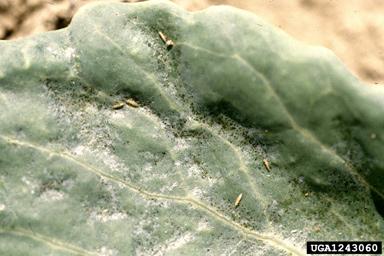
Onion thrips on cabbage. Photo credit: Whitney Cranshaw, Colorado State University, Bugwood.org
- Previous vegetable pest and disease information can be found in past reports: https://extension.unh.edu/resource/vegetable-ipm-reports
Disease of the Week:
Basil Downy Mildew – it was reported in eastern NY last week, and UMass sent out an alert yesterday that it was found on their susceptible controls in their basil variety trial in Deerfield, MA. Basil downy mildew is caused by the water mold, Peronospora belbahrii, which is a different species than the water mold that causes cucurbit downy mildew. However, a lot of the symptoms are similar: infections start on lower leaves and appear as pale-yellow areas on the upper leave with velvety, grey fuzz on the underside of the leaf. Basil downy mildew can spread rapidly so scouting is key to prevent complete yield losses. While basil downy mildew can be transferred by seed or transplants, the spores will also move on air currents, thus why reports from our neighboring states are so important. Disease development is favored by warm temperatures with humid conditions but can tolerate cool weather.
The most effective tool for preventing basil downy mildew is using resistant cultivars. UMass reported on several varieties that performed well in recent years including: Prospera Premium and Prospera Active series, Evi, Amazel, Pesto Besto, Giulietta, Devotion, Passion, Obsession, and Thunderstruck. Genovese basil and other sweet varieties are the most susceptible type of basil. Other cultural controls are monitoring all seedling and transplants prior to planting, destroying any infected plant. As always, reduce leaf wetness through increased spacing, drip irrigation, and manage humidity if growing in a greenhouse or hoop house.
A group of researchers from several states are trying to better understand existing populations of this pathogen to help drive solutions to the problem. You can help these researchers by reporting occurrences of the disease at https://basil.agpestmonitor.org/ and sending infected leaf samples to the researchers to better understand the existing pathogen populations and help drive solutions towards the downy mildew problem. This problem cannot be solved alone! Contact Liza DeGenring if you observe Basil Downy Mildew symptoms and she will work with you to get the samples to Rutgers.
Fungicide recommendations can be found in the New England Vegetable Management Guide. Additionally, Meg McGrath has a lot of research on the most effective products. To control basil downy mildew effectively with fungicides, it is considered necessary to start before first symptoms and to make applications frequently.

Basil Downy Mildew. Photo credit: Gerald Holmes, Strawberry Center, Cal Poly San Luis Obispo, Bugwood.org
New pesticide safety resources! UNH Extension Pesticide Safety Education Field Specialist, Rachel Maccini, has recently shared a few blog posts that may be helpful. These links and more information can be found below.
- Safe and Responsible Pesticide Disposal: What to Do with Unused Products
- Why Checking Pesticide Registration in New Hampshire Matters
- Pesticide Labels: I Need a New One
- Introducing Denyce Gagne, new Enforcement Program Manager for Pesticide Control
Rachel also wrote a new article on pesticide efficacy and drought conditions which can be found here.
Upcoming events:
Tree Fruit Twilight Meeting @ Brookdale Farm
5:30-7:30pm, August 20, 2025
Location: Brookdale Farm, 41 Broad St., Hollis, NH
More information here.
Join us for this in-person tree fruit twilight meeting where topics will include a field tour including equipment and technology demos. These demos will highlight equipment for mowing, sucker removing, pruning, and picking and technology such as sap flow sensors, a NEWA weather station update and model utilization. There will also be a cookout so please note that you do need to register if you plan to stay for the cookout. We need your registration by Friday, August 15th, so we can be sure there is plenty of food for all. Contact Samantha Pitarys, samanthabf08@gmail.com, or call (603) 552-8062 for the registration form.
Two twilight meetings for Beginner Farmers!
- Scouting for Success: Practical Pest Monitoring for Beginning Farmers
5:30-7:30pm, August 25, 2025
Location: Pete's Stand, 51 Main St., Walpole, NH
Register here: https://extension.unh.edu/event/2025/08/scouting-success-practical-pest-monitoring-growers-walpole-nh
- Scouting for Success: Practical Pest Monitoring for Beginning Farmers
5:30-7:30pm, August 28, 2025
Location: Slopeside Farm, 148 Stebbins Hill, Lancaster, NH
Register here: https://extension.unh.edu/event/2025/08/scouting-success-practical-pest-monitoring-beginning-farmers
Effective pest management starts with knowing what’s happening in your field. These hands-on workshops focus on the critical role of scouting in Integrated Pest Management (IPM), specifically on vegetable crops. The Slopeside event will focus on brassicas and alliums. Participants will learn how to detect pest problems early, differentiate pest damage from disease or environmental stress, and practice pest ID. The evening will include interactive discussions, live scouting demonstrations, and group exercises to build your skills in the field. These events are offered at no cost and open to the public.
Contact Caroline Beaton, caroline.beaton@unh.edu, with any questions. For persons with disabilities requiring special accommodations, please contact Caroline Beaton prior to the event. Given ample time, we will make any reasonable effort to make accommodations.
This work is supported by the Beginner Farmer Rancher Development Program, project award no.2024-49400-43622, from the U.S. Department of Agriculture’s National Institute of Food and Agriculture.
Please sign up for our text service! To sign up: text UNHIPM to (866) 645-7010.
Check back in each week as the season progresses to see the latest trapping data. Data for additional insect pests will be updated on a weekly basis. Thank you to all the growers who participate in the program!
Contacts: Amber Vinchesi-Vahl, UNH Extension State Specialist, Entomology and IPM, Amber.Vinchesi@unh.edu; Liza DeGenring, UNH Extension Field Specialist, Hillsborough County, Liza.DeGenring@unh.edu
This program is made possible thought funding provided by the New Hampshire Department of Agriculture, Markets & Food Integrated Pest Management Program. This work is also supported in part by the University of New Hampshire Integrated Pest Management Extension Implementation Plan, project award no. 2024-70006-43535, from the U.S. Department of Agriculture's National Institute of Food and Agriculture.
Hello vegetable IPM folks!
We caught 1 European corn borer this week. We can expect the 2nd generation of ECB moths to begin flying anytime based on degree day accumulation. Click HERE for more information on ECB management.
Corn earworm catches area little lower than last week, with weekly averages ranging from 0-16 moths depending on location. If you have silking corn, be sure to scout for CEW and prepare for management. Our trap threshold/spray schedule table can be found in the fact sheet linked below, along with those for ECB and FAW.
Fall armyworm numbers have tripled this week compared to last week. This week, FAW damage has been observed in young whorl-stage corn (see photos below). Be on the lookout for larval feeding damage which is characterized by large, ragged holes in leaves, and sawdust-like excrement. If you have corn between the whorl and silk stage, the threshold is 30% of sample with injury from FAW, and for silking corn, the threshold is 15% injury or 3+ moths/week.

Fall armyworm feeding damage on young corn. Photo credit: Amber Vinchesi-Vahl

Young FAW larva and damage. Photo credit: Amber Vinchesi-Vahl
Our scout observed 0-13% damage to sweet corn this week. Field scouting should begin once moths are captured at your farm or in your area. Select at least 5 sites across the planting, all of the same variety and planting date. Avoid sampling at the edge of the field (this may bias your sample since the pests may move in from adjacent crops). For a representative sample, follow a rough X or W pattern across the planting. At each site, examine 20 plants, and look at the whorl area for the tiny “shot holes” that show European corn borers are in that stalk. Often there is a tiny bit of light, powdery frass adjacent to the small holes. If present, mark as infested. FAW moths migrate from the south each year, usually arriving in late July or August. The larvae are voracious feeders. Larvae chew large, ragged holes in leaves, and leave lots of coarse, messy droppings. FAW prefer the youngest stage corn that is available. If no young corn is available, they attack silks, husks and ears, leaving the same large, ragged holes and messy droppings. As you move across the planting, keep track of two things: 1) how many plants are infested (either FAW or ECB); and 2) the total number of stalks you’ve counted. Stop at 100. Threshold information for the sweet corn caterpillars can be found here.
Western bean cutworm captures have dropped slightly. We generally see this pest increase quickly, hitting its peak in late July, and then decreasing rapidly in early August. No egg masses have been observed.
The results of our trapping efforts for sweet corn pests are recorded by town in Table 1 below. In some cases, there are multiple traps within a town.
Table 1. Sweet corn pest weekly summary, 7/26-8/1/2025.
| Town | # ECB Moths | # Traps | Avg. ECB/Trap | # CEW Moths | # Traps | Avg. CEW/Trap |
|---|---|---|---|---|---|---|
| Amherst | 0 | 2 | 0 | 1 | 1 | 1 |
| Antrim | 0 | 2 | 0 | 1 | 1 | 1 |
| Claremont | 0 | 2 | 0 | 0 | 1 | 0 |
| Concord | 0 | 2 | 0 | 0 | 1 | 0 |
| Conway | 0 | 2 | 0 | 0 | 1 | 0 |
| Hollis | 0 | 10 | 0 | 24 | 6 | 4 |
| Hudson | 1 | 2 | 0.5 | 2 | 1 | 2 |
| Jaffrey | 0 | 2 | 0 | 0 | 1 | 0 |
| Litchfield | 0 | 4 | 0 | 6 | 2 |
3 |
| Mason | 0 | 2 | 0 | 4 | 1 | 4 |
| Meredith | 0 | 2 | 0 | 0 | 1 | 0 |
| Milford | 0 | 4 | 0 | 2 | 2 | 1 |
| New Boston | 0 | 4 | 0 | 1 | 1 | 1 |
| New London | 0 | 2 | 0 | 2 | 1 | 2 |
| Rollinsford | 0 | 2 | 0 | 15 | 1 | 15 |
| Weare | 0 | 4 | 0 | 1 | 2 | 0.5 |
| Totals | 1 | 48 | 0.02 | 59 | 24 | 2.46 |
| Town | # FAW Moths | # Traps | Avg. FAW/Trap | # WCB Moths | # Traps | Avg. WBC/Trap |
|---|---|---|---|---|---|---|
| Amherst | 0 | 1 | 0 | 1 | 1 | 1 |
| Antrim | 3 | 1 | 3 | 7 | 1 | 7 |
| Claremont | 3 | 1 | 3 | - | - | - |
| Concord | 3 | 1 | 3 | 10 | 1 | 10 |
| Conway | 4 | 1 | 4 | - | - | - |
| Hollis | 74 | 5 | 14.8 | 9 | 4 | 2.25 |
| Hudson | 1 | 1 | 1 | 4 | 1 | 4 |
| Jaffrey | 7 | 1 | 7 | 7 | 1 | 7 |
| Litchfield | 26 | 2 | 13 | 6 | 2 | 3 |
| Mason | 7 | 1 | 7 | 11 | 1 | 11 |
| Meredith | 0 | 1 | 0 | - | - | - |
| Milford | 6 | 2 | 3 | 0 | 1 | 0 |
|
New Boston |
4 | 1 | 4 | - | - | - |
| New London | 0 | 1 | 0 | - | - | - |
| Weare | 5 | 2 | 2.5 | 4 | 2 | 2 |
| Totals | 143 | 22 | 6.50 | 59 | 15 | 3.93 |
Squash vine borer captures have dropped indicating the end of the 1st generation. Some locations are above threshold for bush-type cucurbits (Table 2). For bush-type summer squash and pumpkins (including giant pumpkins), the recommended threshold is 5 SVB moths per trap per week. For vining type squash or pumpkins, we suggest a threshold of 12 moths per trap per week. Vine-type cucurbits can root or tiller in at each node along the vine which allows the plant to take up water and nutrients from more than just the main stem. SVB tends to bore into the main stem of cucurbit plants, creating a higher risk for bush type plants. Butternut and cucumber have some resistance to SVB. Target the base of the stem to treat newly hatched larvae before they bore into the stem. This pest is also becoming more prevalent in northern New Hampshire, where, historically, it was not a major issue. Our UNH Extension fact sheet is a great resource for this pest.
Table 2. Squash vine borer weekly summary, 7/26-8/1/2025.
| Location | # SVB Moths | # Traps | Average/Trap |
|---|---|---|---|
| Antrim | 3 | 1 | 3 |
| Concord | 0 | 1 | 0 |
| Conway | 11 | 1 | 11 |
| Goffstown | 0 | 1 | 0 |
| Hollis | 7 | 3 | 2.3 |
| Hudson | 2 | 1 | 2 |
| Litchfield | 11 | 2 | 5.5 |
| Loudon | 0 | 1 | 0 |
| Mason | 3 | 1 | 3 |
| Milford | 7 | 2 | 3.5 |
| New Boston | 4 | 1 | 4 |
| New London | 2 | 1 | 2 |
| Total | 50 | 16 | 3.13 |
Spotted wing drosophila numbers remain high during peak berry season. If you have susceptible ripening fruit, I recommend monitoring for SWD. More information on monitoring for SWD can be found here. Frequent harvesting and placing berries in the fridge can help slow SWD development within the fruit. I also want to share this resource from Cornell on SWD management. It includes insecticides for each crop group that SWD may infest but be sure to check the label for use in NH. Captures by crop are shown in Table 3 below. The control traps are located in unmanaged areas surrounding fields.
Table 3. Male SWD captures by crop, 7/28-8/1/2025.
| Crop | # SWD Males | # Traps | Average/Trap |
|---|---|---|---|
| Control | 102 | 5 | 20.4 |
| Raspberry | 42 | 7 | 6.0 |
| Blueberry | 32 | 7 | 4.6 |
| Grapes | 0 | 1 | 0.0 |
| Total | 176 | 20 | 8.80 |
We have not caught any brown marmorated stink bugs yet this year.
Miscellaneous pest information:
- Be on the lookout for basil downy mildew! More information can be found in the NE Veg Mgmt Guide.
- Pepper maggot damage was seen in southern NH. Oviposition scars show up as sunken pinpricks in pepper fruit (see photo below). The scars are especially noticeable on cherry peppers (a preferred host), which can be used as indicator plants in outer rows to time insecticide sprays targeting adult flies. Pepper maggot pressure is variable by location, where some farms never have issues and others deal with it each year. More information can be found in the Pepper section of the New England Vegetable Management Guide. An earlier July issue of the UMass Veg Notes also has more information on pepper maggot if you scroll down.

Pepper maggot oviposition scars on cherry pepper. Photo credit: Amber Vinchesi-Vahl
- Previous vegetable pest and disease information can be found in past reports: https://extension.unh.edu/resource/vegetable-ipm-reports
UPDATE! Cucurbit Downy Mildew (CDM) has been confirmed in three New Hampshire counties (Cheshire, Hillsborough and Merrimack) and in Massachusetts (Franklin County). The biology and symptoms can be reviewed in the July 7, 2025 Vegetable IPM report. As a reminder, CDM is caused by the fungal pathogen Pseudoperonospora cubensis and can affect all cucurbit plants BUT most of the outbreaks reported are on cucumbers and melons. Symptoms appear as pale-yellow, angular leaf spots on the upper surface of the leaf and dark purplish-grey fuzzy spores on the underside of the leaf.
Farmers should begin applying fungicides prior to symptoms now that CDM is present in the state. Downy mildew has a high likelihood of fungicide resistance, so many products historically used are no longer effective (Quadris, Revus, Forum, Ridomil). Please rotate FRAC numbers to slow the buildup of resistance in our fields and to maintain good control options.
To prevent disease before symptoms appear, growers can apply chlorothalonil, mancozeb, or Zampro. Once symptoms appear and you are managing the disease there are two options: tank mix with a protectant (chlorothalonil or mancozeb) and one of these products: Ranman, Presdio, Pervicur. Option 2 is to apply without a protectant and use one of these products: Orondis Opti/Ultra, Omega, Gravel, and Zing!
Orondis Opti/Ultra, Ranman, and Elumin are rated as good efficacy against downy mildew, while Zampro, Tanos, Previcur Flex, Omega, and Ridomil Gold + Bravo were rated as fair efficacy based on the 2025 Southeastern US Vegetable Crop Handbook (page 223). More detailed fungicide information and options for conventional and organic commercial growers can be found in the New England Vegetable Management Guide.
Please reach out to Liza or your local county field specialist if you believe you have CDM in your field or have any questions.
Upcoming events:
Tree Fruit Twilight Meeting @ Brookdale Farm
5:30-7:30pm, August 20, 2025
Location: Brookdale Farm, 41 Broad St., Hollis, NH
More information here.
Join us for this in-person tree fruit twilight meeting where topics will include a field tour including equipment and technology demos. These demos will highlight equipment for mowing, sucker removing, pruning, and picking and technology such as sap flow sensors, a NEWA weather station update and model utilization. There will also be a cookout so please note that you do need to register if you plan to stay for the cookout. We need your registration by Friday, August 15th, so we can be sure there is plenty of food for all. Contact Samantha Pitarys, samanthabf08@gmail.com, or call (603) 552-8062 for the registration form.
Two twilight meetings for Beginner Farmers!
- Scouting for Success: Practical Pest Monitoring for Beginning Farmers
5:30-7:30pm, August 25, 2025
Location: Pete's Stand, 51 Main St., Walpole, NH
Register here: https://extension.unh.edu/event/2025/08/scouting-success-practical-pest-monitoring-growers-walpole-nh
- Scouting for Success: Practical Pest Monitoring for Beginning Farmers
5:30-7:30pm, August 28, 2025
Location: Slopeside Farm, 148 Stebbins Hill, Lancaster, NH
Register here: https://extension.unh.edu/event/2025/08/scouting-success-practical-pest-monitoring-beginning-farmers
Effective pest management starts with knowing what’s happening in your field. These hands-on workshops focus on the critical role of scouting in Integrated Pest Management (IPM), specifically on vegetable crops. The Slopeside event will focus on brassicas and alliums. Participants will learn how to detect pest problems early, differentiate pest damage from disease or environmental stress, and practice pest ID. The evening will include interactive discussions, live scouting demonstrations, and group exercises to build your skills in the field. These events are offered at no cost and open to the public.
Contact Caroline Beaton, caroline.beaton@unh.edu, with any questions. For persons with disabilities requiring special accommodations, please contact Caroline Beaton prior to the event. Given ample time, we will make any reasonable effort to make accommodations.
This work is supported by the Beginner Farmer Rancher Development Program, project award no.2024-49400-43622, from the U.S. Department of Agriculture’s National Institute of Food and Agriculture.
Please sign up for our text service! To sign up: text UNHIPM to (866) 645-7010.
Check back in each week as the season progresses to see the latest trapping data. Data for additional insect pests will be updated on a weekly basis. Thank you to all the growers who participate in the program!
For any plant disease diagnostics, contact the UNH Extension Plant Diagnostic Lab to submit a sample.
Contacts: Amber Vinchesi-Vahl, UNH Extension State Specialist, Entomology and IPM, Amber.Vinchesi@unh.edu; Liza DeGenring, UNH Extension Field Specialist, Hillsborough County, Liza.DeGenring@unh.edu
This program is made possible thought funding provided by the New Hampshire Department of Agriculture, Markets & Food Integrated Pest Management Program. This work is also supported in part by the University of New Hampshire Integrated Pest Management Extension Implementation Plan, project award no. 2024-70006-43535, from the U.S. Department of Agriculture's National Institute of Food and Agriculture.
Hello vegetable IPM folks!
We caught 1 European corn borer this week and observed larvae in a couple of locations. We have been seeing larval feeding damage in the field despite the lack of adult captures. We can expect the 2nd generation of ECB moths to begin flying this week or next based on degree day accumulation. Click HERE for more information on ECB management.
Corn earworm catches are similar to last week (over 70 total), with weekly averages ranging from 0-5 moths depending on location. If you have silking corn, be sure to scout for CEW and prepare for management. Farms are between 5-day and no spray schedules. Our trap threshold/spray schedule table can be found in the fact sheet linked below, along with those for ECB and FAW.
We caught 48 fall armyworm moths this week. Our scout reports old FAW damage that plants have recovered from. Be on the lookout for larval feeding damage which is characterized by large, ragged holes in leaves, and sawdust-like excrement. If you have corn between the whorl and silk stage, the threshold is 30% of sample with injury from FAW, and for silking corn, the threshold is 15% injury or 3+ moths/week.
I also want to share a recent alert sent out by UNH Extension Field Specialist, Carl Majewski, earlier this week regarding reports of armyworms in hay fields. These are true armyworms, but fall armyworms can cause similar damage, and both species could potentially impact corn fields as well as hay fields.
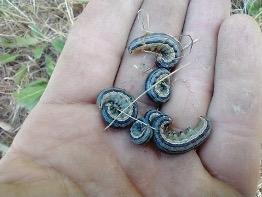
Armyworms collected from a farm in the Kearsarge Valley. Photo credit: Anonymous
“Armyworm in Pastures and Hayfields: We’ve received a report of heavy damage from true armyworm damage in hayfields. While this does not necessarily mean there are widespread infestations – armyworm infestations are often patchy – you might want to check on hayfields, especially recently harvested fields with tender second- or third-cut growth.
True armyworm caterpillars come in various shades of green and brown, but they all have orange and white stripes running the length of their body (see photo). While caterpillars have likely been in fields for a while now, they are now in later instars that feed the most heavily. Most feeding takes place at night, so you may not see caterpillars in daylight except in very heavy infestations.
Scout your hayfields and pastures, especially any that seem to be declining after strong regrowth. If armyworms are present at more than three per square foot, you’ll want to take action. There are no insecticides registered for use on grass hayfields, so your best option is to harvest the field as soon as you can – waiting even a couple days for ideal drying conditions will result in extensive damage.
If you have any questions email carl.majewski@unh.edu, or call (603) 352-4550.”
Western bean cutworm captures have more than doubled compared to last week (30 to 67). We generally see this pest increase quickly, hitting its peak in late July, and then decreasing rapidly in early August.
Our scout observed 0-10% damage to sweet corn this week. Field scouting should begin once moths are captured at your farm or in your area. Scouting and threshold information for the sweet corn caterpillars can be found here. The results of our trapping efforts for sweet corn pests are recorded by town in Table 1 below. In some cases, there are multiple traps within a town.
Table 1. Sweet corn pest weekly summary, 7/21-7/25/2025.
| Town | # ECB Moths | # Traps | Avg. ECB/Trap | # CEW Moths | # Traps | Avg. CEW/Trap |
|---|---|---|---|---|---|---|
| Amherst | 0 | 2 | 0 | 2 | 1 | 2 |
| Antrim | 0 | 2 | 0 | 0 | 1 | 0 |
| Concord | 0 | 2 | 0 | 5 | 1 | 5 |
| Conway | 0 | 2 | 0 | 3 | 1 | 3 |
| Hollis | 0 | 10 | 0 | 28 | 6 | 4.7 |
| Hudson | 0 | 2 | 0 | 2 | 1 | 2 |
| Jaffrey | 0 | 2 | 0 | - | - | - |
| Litchfield | 0 | 4 | 0 | 7 | 2 |
3.5 |
| Mason | 0 | 2 | 0 | 3 | 1 | 3 |
| Meredith | 0 | 2 | 0 | 4 | 1 | 4 |
| Milford | 0 | 4 | 0 | 5 | 2 | 2.5 |
| New Boston | 0 | 4 | 0 | 5 | 1 | 5 |
| New London | 0 | 2 | 0 | 1 | 1 | 1 |
| Rollinsford | 1 | 2 | 0.5 | 2 | 1 | 2 |
| Weare | 0 | 4 | 0 | 6 | 2 | 3 |
| Totals | 1 | 46 | 0.02 | 73 | 22 | 3.32 |
| Town | # FAW Moths | # Traps | Avg. FAW/Trap | # WCB Moths | # Traps | Avg. WBC/Trap |
|---|---|---|---|---|---|---|
| Amherst | 0 | 1 | 0 | 2 | 1 | 2 |
| Antrim | 0 | 1 | 0 | 3 | 1 | 3 |
| Concord | 3 | 1 | 3 | 13 | 1 | 13 |
| Conway | 3 | 1 | 3 | - | - | - |
| Hollis | 15 | 5 | 3 | 11 | 4 | 2.75 |
| Hudson | 0 | 1 | 0 | 1 | 1 | 1 |
| Jaffrey | 5 | 1 | 5 | 0 | 1 | 0 |
| Litchfield | 5 | 2 | 2.5 | 7 | 2 | 3.5 |
| Mason | 3 | 1 | 3 | 14 | 1 | 14 |
| Meredith | 2 | 1 | 2 | - | - | - |
| Milford | 1 | 2 | 0.5 | 9 | 2 | 4.5 |
|
New Boston |
0 | 1 | 0 | 1 | 1 | 1 |
| New London | 0 | 1 | 0 | - | - | - |
| Weare | 11 | 2 | 5.5 | 6 | 2 | 3 |
| Totals | 48 | 21 | 2.29 | 67 | 17 | 3.94 |
Squash vine borer captures are lower than last week but remain high in certain locations. Many locations are above threshold for bush-type cucurbits and a handful of locations are also above thresholds for vining-type cucurbits (Table 2). For bush-type summer squash and pumpkins (including giant pumpkins), the recommended threshold is 5 SVB moths per trap per week. For vining type squash or pumpkins, we suggest a threshold of 12 moths per trap per week. Vine-type cucurbits can root or tiller in at each node along the vine which allows the plant to take up water and nutrients from more than just the main stem. SVB tends to bore into the main stem of cucurbit plants, creating a higher risk for bush type plants. Butternut and cucumber have some resistance to SVB. Target the base of the stem to treat newly hatched larvae before they bore into the stem. This pest is also becoming more prevalent in northern New Hampshire, where, historically, it was not a major issue. Our UNH Extension fact sheet is a great resource for this pest.
Table 2. Squash vine borer weekly summary, 7/21-7/25/2025.
| Location | # SVB Moths | # Traps | Average/Trap |
|---|---|---|---|
| Antrim | 5 | 1 | 5 |
| Concord | 3 | 1 | 3 |
| Conway | 23 | 1 | 23 |
| Durham | 14 | 1 | 14 |
| Goffstown | 2 | 1 | 2 |
| Hollis | 57 | 3 | 19 |
| Hudson | 2 | 1 | 2 |
| Jaffrey | 2 | 1 | 2 |
| Litchfield | 17 | 2 | 8.5 |
| Loudon | 7 | 1 | 7 |
| Mason | 5 | 1 | 5 |
| Milford | 24 | 2 | 12 |
| New Boston | 7 | 1 | 7 |
| Total | 168 | 17 | 9.88 |
Spotted wing drosophila numbers continue to climb during peak berry season. If you have susceptible ripening fruit, I recommend monitoring for SWD. More information on monitoring for SWD can be found here. Frequent harvesting and placing berries in the fridge can help slow SWD development within the fruit. I also want to share this resource from Cornell on SWD management. It includes insecticides for each crop group that SWD may infest but be sure to check the label for use in NH. Captures by crop are shown in Table 3 below. The control traps are located in unmanaged areas surrounding fields.
Table 3. Male SWD captures by crop, 7/21-7/25/2025.
| Crop | # SWD Males | # Traps | Average/Trap |
|---|---|---|---|
| Control | 111 | 5 | 22.2 |
| Strawberry | 0 | 1 | 0 |
| Raspberry | 30 | 7 | 4.3 |
| Blueberry | 46 | 7 | 6.6 |
| Grapes | 3 | 1 | 3 |
| Total | 190 | 21 | 9.05 |
We have not caught any brown marmorated stink bugs yet this year.
Miscellaneous pest information:
- Tarnished plant bugs have been very prevalent this year. I have observed them on multiple crops, including tree fruit and vegetables. Tarnished plant bugs can be a big problem for strawberries, but they can also damage beans, beets, cabbage, cauliflower, celery, cucumbers, potatoes, turnips, ornamentals, small fruit and tree fruit. TPB feeding could cause several types of injury including: dieback of the growing tip, death and drop of buds or flowers, brown scars on leaf ribs of lettuce, and distorted or stunted growth of leaves, pods, seeds, or fruit, scarred or dwarfed fruits, catfacing, and aborted fruit buds. Adults overwinter under bark, garden debris, and within clover, alfalfa, and mullein leaves. The adults become active in the early spring and attack the buds of early developing fruits. There are two generations per year in New Hampshire. Nymphs and adults cause similar damage to plants. Cultural controls: weed management, sanitation of crop debris to reduce egg-laying and overwintering locations, floating row covers, plant away from strawberries and alfalfa or clover if possible. You can scout for TPB from mid-April to early May, examine plants for bleeding wounds, brown discolored tissues, and other malformations. Also, look for adult TPBs on fruits, flowers, and foliage of susceptible crops. You can also monitor adults with white sticky cards (non UV-reflecting). More information can be found in our UNH fact sheet and in the NE Vegetable Mgmt Guide.
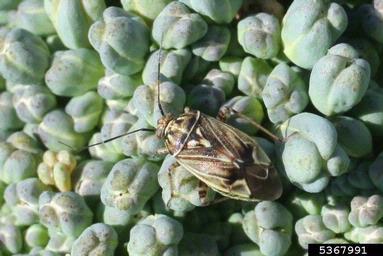
Adult tarnished plant bug on broccoli. Photo credit: Russ Ottens, University of Georgia, Bugwood.org

Tarnished plant bug nymph. Photo credit: Scott Bauer, USDA Agricultural Research Service, Bugwood.org
- Newly hatched hornworms have been observed feeding on tomatoes in high tunnels and greenhouses. See last week’s report for more information.
- Potato leafhoppers have been observed in multiple locations. More information on PLH can be found in our 7.14.25 report.
- Previous vegetable pest and disease information can be found in past reports: https://extension.unh.edu/resource/vegetable-ipm-reports
UPDATE on Cucurbit Downy Mildew – it is now in Connecticut, Pennsylvania, Long Island and Washington County NY, which borders VT. It has been documented on cucumbers and cantaloupe. This may be a good time to start scouting and make sure that you have any products ready for disease management. Storms could quickly bring it to New Hampshire. It would also be a good time to do any cultural practices to reduce humidity within the canopy such as pruning or staking plants.
Disease of the Week:
The disease of the week is late blight of tomatoes because it has been detected in Western New York and in Ontario. Late blight is a devastating disease of tomato and potato and is most famously known for causing the Irish potato famine of the 1840s. It is caused by the oomycete (or water mold) pathogen Phytophthora infestans. Symptoms usually first appear on younger leaves as irregularly shaped, water-soaked lesions, often with a lighter halo or ring around them. In high humidity, white cottony growth can be seen on the underside of the leaf. As the disease progresses, lesions enlarge causing the leaves to brown, shrivel, and die. Late blight can also attach the tomato fruit at all stages of development. On the fruit, symptoms appear as greasy spots that eventually become leathery and brown in color. It is important to note that these symptoms can be similar to symptoms caused by other Phytophtora species AND there are different strains of late blight that must be identified thus if you suspect you have late blight on your farm you must get it diagnosed as soon as possible as the spread of the diseases and management vary depending on the results.
Disease development is favored by cool temperatures (50s/60s at night and 80s in the day) and wet weather. Prolonged hot dry days can halt pathogen spread. Late blight does not always occur in New Hampshire every year. The most common form of introduction is on infected potato seed tubers or infected tomato transplants. Spores can also be windblown, moving from infected fields in the south northward.
Cultural practices that can control late blight include planting varieties that have resistance. Other cultural controls include providing good air movement around plants and reducing leaf wetness through proper spacing, staking or trellising of plants, pruning bottom leaves, and using drip irrigation. If late blight has been confirmed on your farm, it will be critical to destroy plant debris, volunteer plants, and weed hosts.
Fungicide applications can be made to prevent disease BUT it is important to note that late blight is a water mold and thus not a true fungus, so fungicides specific to water molds must be used. This can be another indicator that you have late blight on your farm if conventional fungicides do not work.
Orondis Opti (FRAC M05 + 49) and Orondis Ultra (49) are rated as excellent efficacy against late blight. Quadris Opti (11 + M05), Bravo products (M05), Presidio (43), Revus Top (3 + 40), and Zampro (40 + 45) are rated as good efficacy. FRAC Group 11 (Quadris F, Reason 500, Cabriolet, and Flint), Ranman (21), Curzate (27), Forum (40), Tanos (11 +27), Mancozeb products (M03), Previcur Flex (28), Zing! (22 + M05), and Gavel (22 + M03) have all been rated as fair efficacy against late blight based on the 2025 Southeastern US Vegetable Crop Handbook (page 293). Many fungicides should be tank-mixed with a protectant to get the best efficacy BUT read the label as some products, such as Gavel already contain a protectant (mancozeb).
Applying chlorothalonil (Bravo products) weekly starting before disease onset has provided good control in fungicide efficacy trials BUT this should only be done when the disease is detected in your region and the weather conditions are favorable to the disease. Late blight is extremely difficult to manage with fungicides once symptoms are detected, but Curzate and Tanos have some curative activity. Previcur Flex has good systemic activity, protecting the stems and new growth.
Importantly, the pathogen has become resistant to products with mefenoxam (Ridomil Gold Bravo SC and Ridomil Gold MZ) so other products must be used. More detailed fungicide information and options for conventional and organic commercial growers can be found in the New England Vegetable Management Guide. Other resources are the USABlight out of NC State and the report that came out of Ontario.

Late Blight on Tomatoes. Photo credit: Margaret McGrath, Cornell University, Bugwood.org
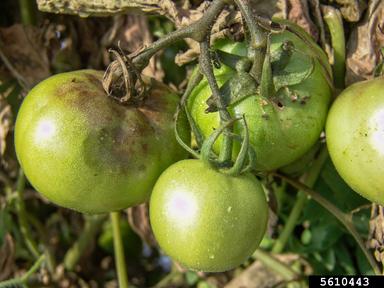
Late Blight on Tomatoes. Photo credit: Gerald Holmes, Strawberry Center, Cal Poly San Luis Obispo, Bugwood.org
Upcoming events:
Tree Fruit Twilight Meeting @ Brookdale Farm
5:30 pm - 7:30 pm, August 20, 2025
Location: Brookdale Farm, 41 Broad St., Hollis, NH
More information here.
Join us for this in-person tree fruit twilight meeting where topics will include a field tour including equipment and technology demos. These demos will highlight equipment for mowing, sucker removing, pruning, and picking and technology such as sap flow sensors, a NEWA weather station update and model utilization. There will also be a cookout so please note that you do need to register if you plan to stay for the cookout. We need your registration by Friday, August 15th, so we can be sure there is plenty of food for all. Contact Samantha Pitarys, samanthabf08@gmail.com, or call (603) 552-8062 for the registration form.
Two twilight meetings for Beginner Farmers!
- Scouting for Success: Practical Pest Monitoring for Beginning Farmers
5:30 pm - 7:30 pm, August 25, 2025
Location: Pete's Stand, 51 Main St., Walpole, NH
Register here: https://extension.unh.edu/event/2025/08/scouting-success-practical-pest-monitoring-growers-walpole-nh - Scouting for Success: Practical Pest Monitoring for Beginning Farmers
5:30 pm - 7:30 pm, August 28, 2025
Location: Slopeside Farm, 148 Stebbins Hill, Lancaster, NH
Register here: https://extension.unh.edu/event/2025/08/scouting-success-practical-pest-monitoring-beginning-farmers
Effective pest management starts with knowing what’s happening in your field. These hands-on workshops focus on the critical role of scouting in Integrated Pest Management (IPM), specifically on vegetable crops. The Slopeside event will focus on brassicas and alliums. Participants will learn how to detect pest problems early, differentiate pest damage from disease or environmental stress, and practice pest ID. The evening will include interactive discussions, live scouting demonstrations, and group exercises to build your skills in the field. These events are offered at no cost and open to the public.
Contact Caroline Beaton, caroline.beaton@unh.edu, with any questions. For persons with disabilities requiring special accommodations, please contact Caroline Beaton prior to the event. Given ample time, we will make any reasonable effort to make accommodations.
This work is supported by the Beginner Farmer Rancher Development Program, project award no.2024-49400-43622, from the U.S. Department of Agriculture’s National Institute of Food and Agriculture.
Please sign up for our text service! To sign up: text UNHIPM to (866) 645-7010.
Check back in each week as the season progresses to see the latest trapping data. Data for additional insect pests will be updated on a weekly basis. Thank you to all the growers who participate in the program!
For any plant disease diagnostics, contact the UNH Extension Plant Diagnostic Lab to submit a sample.
Contacts: Amber Vinchesi-Vahl, UNH Extension State Specialist, Entomology and IPM, Amber.Vinchesi@unh.edu; Liza DeGenring, UNH Extension Field Specialist, Hillsborough County, Liza.DeGenring@unh.edu
This program is made possible thought funding provided by the New Hampshire Department of Agriculture, Markets & Food Integrated Pest Management Program. This work is also supported in part by the University of New Hampshire Integrated Pest Management Extension Implementation Plan, project award no. 2024-70006-43535, from the U.S. Department of Agriculture's National Institute of Food and Agriculture.
Hello vegetable IPM folks!
We caught 0 European corn borer this week, but we did observe ECB pupae in multiple locations, and we have been seeing larval feeding damage in the field despite the lack of adult captures. Click HERE for more information on ECB management.
Corn earworm catches have increased this week from 7 to 75, likely from migrating moths moving in on storms. If you have silking corn, be sure to scout for CEW and prepare for management. Depending on location, farmers are between 4-day and 6-day spray schedules. Our trap threshold/spray schedule table can be found in the fact sheet linked below, along with those for ECB and FAW.
We caught 6 fall armyworm moths this week, but we have observed more FAW larval feeding in the field than is reflected in our moth captures. Be on the lookout for larval feeding damage which is characterized by large, ragged holes in leaves, and sawdust-like excrement (photo below).

Fall armyworm larva and its feeding damage in sweet corn. Photo: Amber Vinchesi-Vahl, UNH Extension
Western bean cutworm captures have been increasing since our first catch last week. We generally see this pest increase quickly, hitting its peak in late July, and then decreasing rapidly in early August.
Our scout observed 0-10% damage to sweet corn this week. Field scouting should begin once moths are captured at your farm or in your area. Scouting and threshold information for the sweet corn caterpillars can be found here. The results of our trapping efforts for sweet corn pests are recorded by town in Table 1 below. In some cases, there are multiple traps within a town.
Table 1. Sweet corn pest weekly summary, 7/14-7/18/2025.
| Town | # ECB Moths | # Traps | Avg. ECB/Trap | # CEW Moths | # Traps | Avg. CEW/Trap |
|---|---|---|---|---|---|---|
| Amherst | 0 | 2 | 0 | 4 | 1 | 4 |
| Antrim | 0 | 2 | 0 | 1 | 1 | 1 |
| Concord | 0 | 2 | 0 | 0 | 1 | 0 |
| Conway | 0 | 2 | 0 | 4 | 1 | 4 |
| Hollis | 0 | 10 | 0 | 27 | 6 | 4.5 |
| Hudson | 0 | 2 | 0 | 0 | 1 | 0 |
| Jaffrey | 0 | 2 | 0 | - | - | - |
| Litchfield | 0 | 4 | 0 | 8 | 2 |
4 |
| Mason | 0 | 2 | 0 | 4 | 1 | 4 |
| Meredith | 0 | 2 | 0 | 0 | 1 | 0 |
| Milford | 0 | 4 | 0 | 13 | 2 | 6.5 |
| New Boston | 0 | 4 | 0 | 6 | 1 | 6 |
| New London | 0 | 2 | 0 | 4 | 1 | 4 |
| Rollinsford | 0 | 2 | 0 | 2 | 1 | 2 |
| Weare | 0 | 4 | 0 | 2 | 2 | 1 |
| Totals | 0 | 46 | 0.00 | 73 | 22 | 3.32 |
| Town | # FAW Moths | # Traps | Avg. FAW/Trap | # WCB Moths | # Traps | Avg. WBC/Trap |
|---|---|---|---|---|---|---|
| Amherst | 0 | 1 | 0 | 1 | 1 | 1 |
| Antrim | 0 | 1 | 0 | 3 | 1 | 3 |
| Concord | 0 | 1 | 0 | 8 | 1 | 8 |
| Conway | 0 | 1 | 0 | - | - | - |
| Hollis | 0 | 5 | 0 | 3 | 4 | 0.75 |
| Hudson | 0 | 1 | 0 | 0 | 1 | 0 |
| Jaffrey | 0 | 1 | 0 | 2 | 1 | 2 |
| Litchfield | 5 | 2 | 2.5 | 4 | 2 | 2 |
| Mason | 0 | 1 | 0 | 3 | 1 | 3 |
| Meredith | 0 | 1 | 0 | - | - | - |
| Milford | 1 | 2 | 0.5 | 1 | 2 | 0.5 |
| New Boston | 0 | 1 | 0 | 1 | 1 | 1 |
| Rollinsford | 0 | 1 | 0 | - | - | - |
| Weare | 0 | 2 | 0 | 4 | 2 | 2 |
| Totals | 6 | 21 | 0.30 | 30 | 17 | 1.76 |
Squash vine borer captures continue to increase, and most locations are above threshold for bush-type cucurbits and multiple locations are also above thresholds for vining-type cucurbits (Table 2). For bush-type summer squash and pumpkins (including giant pumpkins), the recommended threshold is 5 SVB moths per trap per week. For vining type squash or pumpkins, we suggest a threshold of 12 moths per trap per week. Vine-type cucurbits can root or tiller in at each node along the vine which allows the plant to take up water and nutrients from more than just the main stem. SVB tends to bore into the main stem of cucurbit plants, creating a higher risk for bush type plants. Butternut and cucumber have some resistance to SVB. Target the base of the stem to treat newly hatched larvae before they bore into the stem. This pest is also becoming more prevalent in northern New Hampshire, where, historically, it was not a major issue. Our UNH Extension fact sheet is a great resource for this pest.
Table 2. Squash vine borer weekly summary, 7/14-7/18/2025.
| Location | # SVB Moths | # Traps | Average/Trap |
|---|---|---|---|
| Antrim | 10 | 1 | 10 |
| Concord | 4 | 1 | 4 |
| Conway | 11 | 1 | 11 |
| Durham | 10 | 1 | 10 |
| Goffstown | 7 | 1 | 7 |
| Hollis | 32 | 3 | 10.7 |
| Hudson | 6 | 1 | 6 |
| Litchfield | 26 | 2 | 13 |
| Loudon | 11 | 1 | 11 |
| Mason | 10 | 1 | 10 |
| Milford | 63 | 2 | 31.5 |
| New Boston | 21 | 1 | 21 |
| New London | 1 | 1 | 1 |
| Total | 212 | 17 | 12.47 |
Spotted wing drosophila numbers continue to increase. Berry season is really ramping up, with many farms open for summer raspberries and blueberries now. If you have susceptible ripening fruit, I recommend monitoring for SWD. More information on monitoring for SWD can be found here. I also want to share this resource from Cornell on SWD management. It includes insecticides for each crop group that SWD may infest but be sure to check the label for use in NH. Captures by crop are shown in Table 3 below. The control traps are located in unmanaged areas surrounding fields.
Table 3. Male SWD captures by crop, 7/14-7/18/2025.
| Crop | # SWD Males | # Traps | Average/Trap |
|---|---|---|---|
| Control | 63 | 5 | 12.6 |
| Strawberry | 0 | 1 | 0 |
| Raspberry | 11 | 6 | 1.8 |
| Blueberry | 32 | 7 | 4.6 |
| Total | 106 | 19 | 5.58 |
Miscellaneous pest information:
- Leek moth was detected in Merrimack County. It has now been confirmed in Coos, Grafton, Sullivan, and Merrimack counties. Leek moth is an invasive pest of alliums that was first observed in New Hampshire in 2016. Our most recent blog post provides resources with pictures of damage and management recommendations.
- Cucumber beetles have been very prolific this year in many locations. We are seeing many spotted and striped beetles in our SVB traps. Striped cucumber beetles feed on foliage, flowers and fruit and transmit bacterial wilt. Plants are most susceptible to infection before the 5-leaf stage. See the Vegetable IPM Report from 6.6.25 for more information on cuke beetles and the “disease of the week” below for more information on bacterial wilt.
- Squash bugs are present and increasing in cucurbit fields. See the Vegetable IPM Report from 6.27.25 for more information.
- Newly hatched hornworms have been observed feeding on tomatoes in high tunnels and greenhouses. As most of you probably know, hornworms grow into large green caterpillars with “horns” at the end of their body. They are very good at camouflaging with tomatoes. When they are small, it is easiest to scout for feeding damage (small holes in leaves) and once they are larger, it may be easier to spot their frass (fecal droppings) on leaves and then look above to find the feeding caterpillar. They can also be spotted easily at night with a black light (they glow!). Hornworms overwinter as pupae, usually 2-4 inches in the soil. Infestations are typical July-September. They can defoliate a plant quickly, especially when there are many of them. They are also known to feed on fruit when they are larger. Plowing in the fall or early spring can reduce pupal survival. If you see a hornworm covered with white wasp cocoons, it has been parasitized and leaving it will allow the wasps to continue development and parasitize more hornworms after they emerge as adults. If infestations are severe, you could spot–treat areas with severe defoliation. Using softer and/or selective insecticides can help preserve hornworm predators and parasitoids. More information can be found in the New England Veg Guide.

Young hornworm caterpillars feeding on tomato leaf. Photo: Olivia Saunders, UNH Extension
- Potato leafhoppers have been observed in multiple locations. More information on PLH can be found in last week’s report.
- Colorado potato beetles are present in all life stages, with hatches of the 2nd generation seen on multiple farms. More information can be found in the Vegetable IPM Report from 6.6.25.
- Scarab beetles, both Japanese beetles and Oriental beetles, have been seen in high numbers this year. Larvae feed in turf and pastures. Beetles emerge from these sites in late June and usually peak in July. Beetle feeding causes skeletonization of leaves of many crops. Row covers can prevent feeding in certain crops. Japanese beetles feed on corn leaves and may feed on corn silks, though they can be controlled with materials used for ECB and CEW.
- Leafminer tunneling was observed on pea leaves in multiple locations in the northern half of the state. Feeding was mostly restricted to leaves, and very little tunneling was found on pea pods. Controlling weeds, rotating crops, and row covers placed before flies lay eggs can help to manage leafminers.
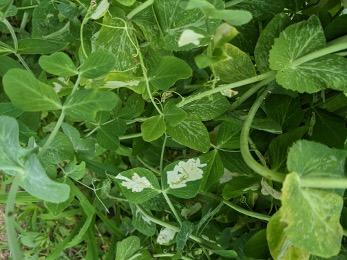
Leafminer tunneling damage on pea leaves. Photo: Amber Vinchesi-Vahl, UNH Extension
- Previous vegetable pest and disease information can be found in past reports: https://extension.unh.edu/resource/vegetable-ipm-reports
Disease of the Week:
UPDATE on Downy Mildew – it is now in Connecticut and in Washington County in NY which borders VT. This may be a good time to start scouting and make sure that you have any products ready for disease management. Now would also be a good time to do any cultural practices to reduce humidity within the canopy such as pruning or staking plants.
The disease of the week is early blight of tomatoes and potatoes. Early blight is one of the most common tomato and potato disease that occurs nearly every season in New Hampshire. It is caused by two closely related species of fungi: Alternaria tomatophila and Alternaria solani. Symptoms usually first appear as small dark spots on older foliage near the ground and as they enlarge, target-like concentric rings can be seen with the tissue around the spots turning yellow. In severe cases, stem and fruit infections can occur. Disease development is favored by warm temperatures (82 to 86 °F) and high relative humidity (60-90%).
Cultural practices that can control early blight include planting varieties that have resistance. Other cultural controls include providing good air movement around plants and reducing leaf wetness through proper spacing, staking or trellising of plants, pruning bottom leaves, and using drip irrigation. As early blight spores overwinter in plant debris and in the soil, reducing contact between the soil and the leaves will greatly help in reducing infection. Thus, using a mulch can help reduce the incidence of early blight on plants.
Fungicide applications can slow the spread of early blight but cannot eliminate it. Quadris F, Quadris Opti, Cabrio EG, and Flint are rated as excellent efficacy again early blight BUT we have seen resistance so make sure to rotate FRAC numbers as usual. Quadris Top, TopGuard EQ, Aprovia Top, Inspire Super, Luna Tranquility, Rhyme, Priaxor Xemium, Fontelis, and Mettle 125 ME are all rated as good efficacy based on the 2025 Southeastern US Vegetable Crop Handbook(page 292). More detailed fungicide information and options for conventional and organic commercial growers can be found in the New England Vegetable Management Guide.
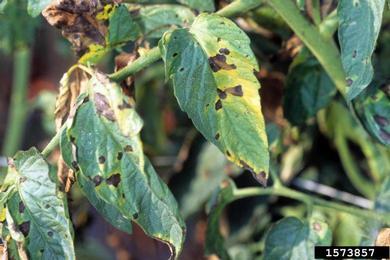
Early Blight on Tomatoes. Photo: Gerald Holmes, Strawberry Center, Cal Poly San Luis Obispo, Bugwood.org
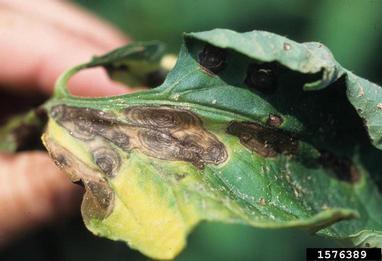
Early Blight on Tomatoes. Photo: Gerald Holmes, Strawberry Center, Cal Poly San Luis Obispo, Bugwood.org
Upcoming events:
TOMORROW! For Beginner Farmers!
Scouting for Success: Practical Pest Monitoring for Beginning Farmers
July 22, 5:30-7:30pm
LocaBerry Farm (at Emery Farm), 147 Piscataqua Rd., Durham, NH 03824
Effective pest management starts with knowing what is happening in your field. This hands-on workshop focuses on the critical role of scouting in Integrated Pest Management (IPM), with a focus on fruit crops like blueberries and peaches. Participants will learn how to detect pest problems early, differentiate pest damage from disease or environmental stress, and practice pest ID. The evening will include interactive discussions, live scouting demonstrations, and group exercises to build your skills in the field. This event is free and geared towards beginner farmers and berry crops.
You can register here: https://extension.unh.edu/event/2025/07/scouting-success-practical-pest-monitoring-growers-durham-nh
This work is supported by the Beginner Farmer Rancher Development Program, project award no.2024-49400-43622, from the U.S. Department of Agriculture’s National Institute of Food and Agriculture.
Please sign up for our text service! To sign up: text UNHIPM to (866) 645-7010.
Check back in each week as the season progresses to see the latest trapping data. Data for additional insect pests will be updated on a weekly basis. Thank you to all the growers who participate in the program!
For any plant disease diagnostics, contact the UNH Extension Plant Diagnostic Lab to submit a sample.
Contacts: Amber Vinchesi-Vahl, UNH Extension State Specialist, Entomology and IPM, Amber.Vinchesi@unh.edu; Liza DeGenring, UNH Extension Field Specialist, Hillsborough County, Liza.DeGenring@unh.edu
This program is made possible thought funding provided by the New Hampshire Department of Agriculture, Markets & Food Integrated Pest Management Program. This work is also supported in part by the University of New Hampshire Integrated Pest Management Extension Implementation Plan, project award no. 2024-70006-43535, from the U.S. Department of Agriculture's National Institute of Food and Agriculture.
Hello vegetable IPM folks!
We caught 0 European corn borer this week, but we did observe an ECB pupa in a tassel, and we have been seeing larval feeding damage in the field despite the lack of adult captures. Click HERE for more information on ECB management.
We caught 7 corn earworm this week. Female CEW moths are attracted to silking corn for egg-laying.
We caught 1 fall armyworm moth this week, and our scout observed up to 15% FAW larval feeding damage in pretassel corn in one location. Be on the lookout for larval feeding damage which is characterized by large, ragged holes in leaves, and sawdust-like excrement.
We caught our first western bean cutworm this week.
Our scout observed 0-25% damage from multiple larval stages feeding in sweet corn this week. Field scouting should begin once moths are captured at your farm or in your area. Scouting and threshold information for the sweet corn caterpillars can be found here. The results of our trapping efforts for sweet corn pests are recorded by town in Table 1 below. In some cases, there are multiple traps within a town.
Table 1. Sweet corn pest weekly summary, July 7 through July 11, 2025.
| Town | # ECB Moths | # Traps | Avg. ECB/Trap | # CEW Moths | # Traps | Avg. CEW/Trap |
|---|---|---|---|---|---|---|
| Amherst | 0 | 2 | 0 | - | - | - |
| Antrim | 0 | 2 | 0 | 0 | 1 | 0 |
| Concord | 0 | 2 | 0 | - | - | - |
| Hollis | 0 | 10 | 0 | 1 | 5 | 0.2 |
| Hudson | 0 | 2 | 0 | - | - | - |
| Jaffrey | 0 | 2 | 0 | - | - | - |
| Litchfield | 0 | 4 | 0 | 0 | 2 |
0 |
| Mason | 0 | 2 | 0 | - | - | - |
| Meredith | 0 | 2 | 0 | 0 | 1 | 0 |
| Milford | 0 | 4 | 0 | 0 | 2 | 0 |
| New Boston | 0 | 4 | 0 | 2 | 1 | 2 |
| Rollinsford | 0 | 2 | 0 | 4 | 1 | 4 |
| Weare | 0 | 4 | 0 | 0 | 1 | 0 |
| Totals | 0 | 42 | 0.00 | 7 | 14 | 0.5 |
| Town | # FAW Moths | # Traps | Avg. FAW/Trap | # WCB Moths | # Traps | Avg. WBC/Trap |
|---|---|---|---|---|---|---|
| Amherst | 0 | 1 | 0 | 0 | 1 | 0 |
| Antrim | 0 | 1 | 0 | 0 | 1 | 0 |
| Concord | 0 | 1 | 0 | - | - | - |
| Hollis | 0 | 5 | 0 | 1 | 4 | 0.25 |
| Hudson | 0 | 1 | 0 | 0 | 1 | 0 |
| Jaffrey | - | - | - | 0 | 1 | 0 |
| Litchfield | 1 | 2 | 0.5 | 0 | 2 | 0 |
| Mason | 0 | 1 | 0 | 0 | 1 | 0 |
| Meredith | 0 | 1 | 0 | - | - | - |
| Milford | 0 | 2 | 0 | 0 | 2 | 0 |
| New Boston | 0 | 1 | 0 | 0 | 1 | 0 |
| Rollinsford | 0 | 1 | 0 | - | - | - |
| Weare | 0 | 2 | 0 | 0 | 2 | 0 |
| Totals | 1 | 17 | 0.06 | 1 | 16 | 0.06 |
Squash vine borer captures have more than doubled from last week (Table 2). The number of moths captured with pheromone traps can be used to decide whether or not insecticide treatment is required. For bush-type summer squash and pumpkins (including giant pumpkins), the recommended threshold is 5 SVB moths per trap per week. For vining type squash or pumpkins, we suggest a threshold of 12 moths per trap per week. Vine-type cucurbits can root or tiller in at each node along the vine which allows the plant to take up water and nutrients from more than just the main stem. SVB tends to bore into the main stem of cucurbit plants, creating a higher risk for bush type plants. We are over threshold in many locations this week. Butternut has some resistance to SVB. Target the base of the stem to treat newly hatched larvae before they bore into the stem.
Table 2. Squash vine borer weekly summary, July 7 through July 11, 2025.
| Location | # SVB Moths | # Traps | Average/Trap |
|---|---|---|---|
| Antrim | 12 | 1 | 12 |
| Concord | 0 | 1 | 0 |
| Goffstown | 12 | 1 | 12 |
| Hollis | 23 | 3 | 7.7 |
| Hudson | 4 | 1 | 4 |
| Litchfield | 11 | 2 | 5.5 |
| Loudon | 13 | 1 | 13 |
| Mason | 5 | 1 | 5 |
| Milford | 46 | 2 | 23 |
| New Boston | 17 | 1 | 17 |
| Total | 143 | 14 | 10.21 |
Spotted wing drosophila numbers are increasing since last week. Berry season is really ramping up, with many farms open for summer raspberries and blueberries now. If you have susceptible ripening fruit, I recommend monitoring for SWD now that we are into the summer. More information on monitoring for SWD can be found here. I also want to share this resource from Cornell on SWD management. It includes insecticides for each crop group that SWD may infest but be sure to check the label for use in NH. Captures by crop are shown in Table 3 below. The control traps are located in unmanaged areas surrounding fields.
Table 3. Male SWD captures by crop, July 7 through July 11, 2025.
| Crop | # SWD Males | # Traps | Average/Trap |
|---|---|---|---|
| Control | 43 | 5 | 8.6 |
| Strawberry | 0 | 1 | 0 |
| Raspberry | 2 | 5 | 0.4 |
| Cherry | 10 | 1 | 10 |
| Blueberry | 24 | 5 | 4.8 |
| Total | 79 | 17 | 4.65 |
Miscellaneous pest information:
- Leek moth was detected in Merrimack County. It has now been confirmed in Coos, Grafton, Sullivan, and Merrimack counties. Leek moth is an invasive pest of alliums that was first observed in New Hampshire in 2016. Our most recent blog post provides resources with pictures of damage and management recommendations.
- Potato leafhoppers have arrived. Potato leafhoppers overwinter in the southern US and migrate north on storms and winds. Leafhoppers are wedge-shaped and nymphs are bright green with sideways walk and found on the underside of leaves. Adults will take flight when disturbed. PLH is a significant pest of solanaceous crops and legumes, with major damage occurring in potatoes, eggplants, and beans. PLH feeding causes yellowing at tops and margins of leaves, rapid browning, curling and even plant death. The dry, burnt appearance of foliage is called ‘hopperburn’. PLH use their piercing-sucking mouthparts to extract plant juices and inject a toxin that clogs plant tissue. Scouting is essential since PLH migrations are unpredictable. Use a sweep net or shake foliage to observe adults flying when disturbed and scout the underside of leaves for nymphs. Row cover can help protect against PLH infestations and other crop pests. More information on thresholds and chemical treatments can be found in the NE Vegetable Management Guide under insect control for potato, eggplant and beans.
- Cucumber beetles have been very prolific this year in many locations. We are seeing many spotted and striped beetles in our SVB traps. Striped cucumber beetles feed on foliage, flowers and fruit and transmit bacterial wilt. Plants are most susceptible to infection before the 5-leaf stage. See the Vegetable IPM Report from 6.6.24 for more information on cuke beetles and the “disease of the week” below for more information on bacterial wilt.
- Previous vegetable pest and disease information can be found in past reports: https://extension.unh.edu/resource/vegetable-ipm-reports
Disease of the Week:
Due to all the cucumber beetles we are seeing this year, make sure you are scouting your cucurbits for Bacterial Wilt. Bacterial wilt is caused by a bacterial pathogen, Erwinia tracheiphila, and can cause significant loss if left unmanaged. Bacterial wilt is spread from plant to plant by cucumber beetles. Transmission occurs when bacteria-infested frass (aka insect poop) comes into contact with fresh feeding wounds, but transmission can also occur via floral nectaries.
Bacterial wilt symptoms are wilting of foliage; often wilting occurs during the day and then plants recover at night, until the entire plant collapses. One way to determine if you have bacterial wilt is to cut a section of the stem and see if there is “bacterial ooze” (picture below). There is no cure for bacterial wilt – all plants that are infected must be removed to prevent further spread.
Management options for bacterial wilt focus on managing cucumber beetle. Cucumber and muskmelons are highly susceptible to bacterial wilt while pumpkin and squash as less susceptible. Some research has found that watermelon plants are slightly resistant to bacterial wilt.
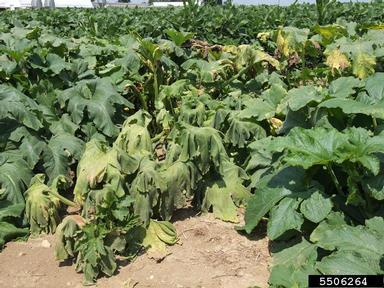
Bacterial Wilt. Photo: Jim Jasinski, Ohio State University Extension, Bugwood.org
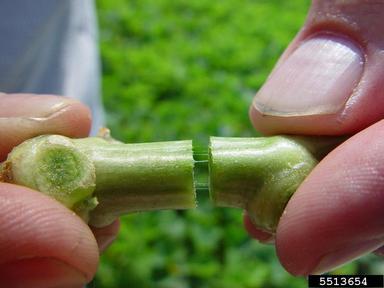
Bacterial oozing. Photo: Gerald Holmes, Strawberry Center, Cal Poly San Luis Obispo, Bugwood.org
Upcoming events:
For Beginner Farmers!
Scouting for Success: Practical Pest Monitoring for Growers
July 22, 5:30 p.m. - 7:30p.m.
LocaBerry Farm (at Emery Farm), 147 Piscataqua Rd., Durham, NH 03824
Effective pest management starts with knowing what is happening in your field. This hands-on workshop focuses on the critical role of scouting in Integrated Pest Management (IPM), with a focus on fruit crops like blueberries and peaches. Participants will learn how to detect pest problems early, differentiate pest damage from disease or environmental stress, and practice pest ID. The evening will include interactive discussions, live scouting demonstrations, and group exercises to build your skills in the field. This event is free and geared towards beginner farmers and berry crops. You can register here: https://extension.unh.edu/event/2025/07/scouting-success-practical-pest-monitoring-growers-durham-nh
This work is supported by the Beginner Farmer Rancher Development Program, project award no.2024-49400-43622, from the U.S. Department of Agriculture’s National Institute of Food and Agriculture.
Please sign up for our text service! To sign up: text UNHIPM to (866) 645-7010.
Check back in each week as the season progresses to see the latest trapping data. Data for additional insect pests will be updated on a weekly basis. Thank you to all the growers who participate in the program!
For any plant disease diagnostics, contact the UNH Extension Plant Diagnostic Lab to submit a sample.
Contacts: Amber Vinchesi-Vahl, UNH Extension State Specialist, Entomology and IPM, Amber.Vinchesi@unh.edu; Liza DeGenring, UNH Extension Field Specialist, Hillsborough County, Liza.DeGenring@unh.edu
This program is made possible thought funding provided by the New Hampshire Department of Agriculture, Markets & Food Integrated Pest Management Program. This work is also supported in part by the University of New Hampshire Integrated Pest Management Extension Implementation Plan, project award no. 2024-70006-43535, from the U.S. Department of Agriculture's National Institute of Food and Agriculture.
Hello vegetable IPM folks!
I hope everyone had a great 4th of July!
Before we get into sweet corn and other pests, leek moth was detected in Merrimack County. It is now known to be in Coos, Grafton, Sullivan, and Merrimack counties. Leek moth is an invasive pest of alliums that was first observed in New Hampshire in 2016. Please reach out to Amber (amber.vinchesi@unh.edu), or your local county Extension field specialist, if you think you are seeing leek moth damage on your farm. We are working on a leek moth fact sheet, but in the meantime, our most recent blog post provides resources with pictures of damage and management recommendations.
We caught 1 European corn borer in Milford this week BUT our scout observed significant whorl feeding damage in Hillsborough County, so our adult captures do not seem to be related to damage in the field this year. UMass has seen similar patterns with low trap numbers and high field damage. With whorl stage corn, larval feeding damage is characterized by tiny “shot holes” in the leaves. Eventually the larvae will bore into the developing tassel and stalks. Click HERE for more information on ECB management.
We caught 4 corn earworm in Strafford County this week and we now have traps out in multiple locations for next week’s report.
We caught our first fall armyworm moths this week in a few locations, so larval feeding is not too far behind. Fall armyworm moths migrate north with storms. With silking corn, the trap threshold is 3+ moths per week. Be on the lookout for larval feeding damage which is characterized by large, ragged holes in leaves, and sawdust-like excrement.
We caught zero western bean cutworm, and all fifteen traps are out as of last week.
Our scout observed 0-42% damage from multiple larval stages feeding in sweet corn this week. Field scouting should begin once moths are captured at your farm or in your area. Scouting and threshold information for the sweet corn caterpillars can be found here. The results of our trapping efforts for sweet corn pests are recorded by town in Table 1 below. In some cases, there are multiple traps within a town.
Table 1. Sweet corn pest weekly summary, 6/30-7/6/2025.
| Town | #ECB Moths | # Traps | Avg. ECB/Trap | # CEW moths | # Traps | Avg CEW/Trap | # FAW moths | # Traps | Avg FAW/Trap |
|---|---|---|---|---|---|---|---|---|---|
| Amherst | 0 | 2 | 0 | - | - | - | 2 | 1 | 2 |
| Antrim | 0 | 2 | 0 | - | - | - | 0 | 1 | 0 |
| Concord | 0 | 2 | 0 | - | - | - | 0 | 1 | 0 |
| Hollis | 0 | 10 | 0 | 0 | 1 | 0 | 0 | 5 | 0 |
| Hudson | 0 | 2 | 0 | - | - | - | 0 | 1 | 0 |
| Litchfield | 0 | 4 | 0 | 0 | 1 | 0 | 1 | 2 | 0.5 |
| Mason | 0 | 2 | 0 | - | - | - | 0 | 1 | 0 |
| Meredith | 0 | 2 | 0 | 0 | 1 | 0 | 0 | 1 | 0 |
| Milford | 1 | 4 | 0.25 | - | - | - | 1 | 2 | 0.5 |
| New Boston | 0 | 4 | 0 | - | - | - | 1 | 1 | 1 |
| Rollinsford | 0 | 2 | 0 | 4 | 1 | 4 | 0 | 1 | 0 |
| Weare | 0 | 4 | 0 | - | - | - | 0 | 2 | 0 |
| Jaffrey | 0 | 2 | 0 | - | - | - | - | - | - |
| Totals | 1 | 42 | 0.02 | 4 | 4 | 1 | 5 | 19 | 0.26 |
We are continuing to catch squash vine borer adults in multiple locations this week. Captures are shown in Table 2 below. The number of moths captured with pheromone traps can be used to decide whether or not insecticide treatment is required. For bush-type summer squash and pumpkins (including giant pumpkins), the recommended threshold is 5 SVB moths per trap per week. For vining type squash or pumpkins, we suggest a threshold of 12 moths per trap per week. Vine-type cucurbits can root or tiller in at each node along the vine which allows the plant to take up water and nutrients from more than just the main stem. SVB tends to bore into the main stem of cucurbit plants, creating a higher risk for bush type plants. Butternut has some resistance to SVB.
Table 2. Squash vine borer weekly summary, 6/30-7/6/2025.
| Location | # Traps | # SVB moths | Average/Trap |
|---|---|---|---|
| Antrim | 1 | 2 | 2 |
| Concord | 1 | 0 | 0 |
| Goffstown | 1 | 0 | 0 |
| Hollis | 3 | 10 | 3.3 |
| Hudson | 1 | 5 | 5 |
| Litchfield | 2 | 14 | 7 |
| Loudon | 1 | 5 | 5 |
| Mason | 1 | 6 | 6 |
| Milford | 2 | 18 | 9 |
| New Boston | 1 | 5 | 5 |
Spotted wing drosophila numbers are present but remain low. Captures by crop are shown in Table 3 below. The control traps are located in unmanaged areas surrounding fields. We trap in Goffstown, Concord, Litchfield, Milford, and Hollis. If you have susceptible ripening fruit, I recommend monitoring for SWD, especially in strawberries and earlier season fruits. More information on monitoring for SWD can be found here. I also want to share this resource from Cornell on SWD management. It includes insecticides for each crop group that SWD may infest but be sure to check the label for use in NH.
Table 3. Male SWD captures by crop, 6/30-7/4/25.
| Crop | # SWD males |
|---|---|
| Control | 12 |
| Strawberry | 0 |
| Raspberry | 2 |
| Cherry | 5 |
| Blueberry | 5 |
Miscellaneous pest information:
- Imported cabbageworm and diamondback moth larvae have been observed in brassica crops. Cabbage looper migrates north with storms and is usually not a problem until later in July.
- Cucumber beetles have been very prolific this year. Striped cucumber beetles feed on foliage, flowers and fruit and transmit bacterial wilt. Plants are most susceptible to infection before the 5-leaf stage. See the Vegetable IPM Report from 6.6.24 for more information.
- Colorado potato beetle larvae have hatched in many locations, with 3rd instars at some locations in the Northeast. It is best to target the newly hatched/younger larvae with insecticides to prevent 4th instar larval feeding, which are responsible for 85% defoliation. For more information, see the Vegetable IPM Report from 6.6.25.
- Previous vegetable pest information can be found in past reports: https://extension.unh.edu/resource/vegetable-ipm-reports
Disease of the Week:
Cucurbit Downy Mildew is moving north! It has been reported in Michigan, in a southern county in Pennsylvania, and in New York – you can follow its progression using this map. We will continue to monitor the map and alert you when to start scouting/spraying your fields.
Cucurbit downy mildew is caused by the fungal pathogen Pseudoperonospora cubensis and is one of the most important foliar diseases of cucurbits. The disease can affect all cucurbit plants with symptoms appearing as pale-yellow, angular leaf spots on the upper surface of the leaf. The distinctive symptom is the dark purplish-grey fuzzy spores on the underside of the leaf in high humidity. When infections are high, leaves will turn brown. Disease development is favored by cooler temperatures (59-68 °F) and high relative humidity (60-85%).
Cultural practices include planting varieties that have complete or partial resistance to the fungus. Many seed companies will detail whether there is downy mildew resistance or tolerance on each of their cucurbit varieties. Other cultural controls include providing good air movement around plants and reducing leaf wetness through proper spacing, staking of plants, and drip irrigation.
Fields should be scouted starting in mid to late July and farmers should begin applying fungicides prior to symptoms but when it is known that Downy Mildew is present in the area. Downy mildew has a high likelihood of fungicide resistance, so many products historically used are no longer effective (Quadris, Revus, Ridomil). Please rotate FRAC numbers to slow the buildup of resistance in our fields and to maintain good control options.
To prevent disease before symptoms appear, can apply chlorothalonil, mancozeb, or Zampro. Once symptoms appear and you are managing the disease there are two options: tank mix with a protectant (chlorothalonil or mancozeb) and one of these products: Ranman, Presdio, Pervicur. Option 2 is apply without a protectant and use one of these products: Orondis Opti/Ultra, Omega, Gravel, and Zing!
Orondis Opti/Ultra, Ranman, and Elumin are rated as good efficacy against downy mildew, while Zampro, Tanos, Previcur Flex, Omega, and Ridomil Gold + Bravo were rated as fair efficacy based on the 2025 Southeastern US Vegetable Crop Handbook(page 223). More detailed fungicide information and options for conventional and organic commercial growers can be found in the New England Vegetable Management Guide.
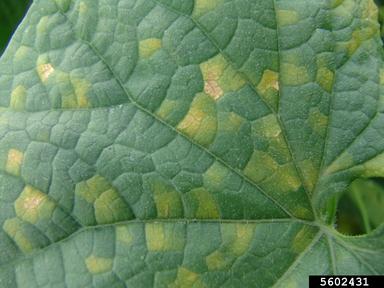
Photo: Gerald Holmes, Strawberry Center, Cal Poly San Luis Obispo, Bugwood.org
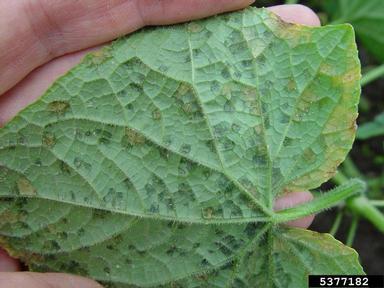
Photo: Gerald Holmes, Strawberry Center, Cal Poly San Luis Obispo, Bugwood.org
FREE TOMATO PLANTS: Chuck Andersen from Mason Hollow Nursery in Mason, NH has a new variety of tomato that he bred himself called ‘Kraken’ that is an indeterminate variety that has strong cold tolerance and small-medium sized slicers. They have a few dozen plants left if anyone would like to get some free plants from Chuck! Feel free to reach out to Chuck directly at 603-878-5357.
Please sign up for our text service! To sign up: text UNHIPM to 866-645-7010.
Check back in each week as the season progresses to see the latest trapping data. Data for additional insect pests will be updated on a weekly basis. Thank you to all the growers who participate in the program!
For any plant disease diagnostics, contact the UNH Extension Plant Diagnostic Lab to submit a sample.
Contacts: Amber Vinchesi-Vahl, UNH Extension State Specialist, Entomology and IPM, Amber.Vinchesi@unh.edu; Liza DeGenring, UNH Extension Field Specialist, Hillsborough County, Liza.DeGenring@unh.edu
This program is made possible thought funding provided by the New Hampshire Department of Agriculture, Markets & Food Integrated Pest Management Program. This work is also supported in part by the University of New Hampshire Integrated Pest Management Extension Implementation Plan, project award no. 2024-70006-43535, from the U.S. Department of Agriculture's National Institute of Food and Agriculture.
Hello vegetable IPM folks!
Thank you to everyone who came to the Vegetable IPM Meeting we held this week focusing on brassica pest management! It was a hot day, and we appreciate everyone making the trip!
We have a lot to share this week, ‘tis the season for pests!
We caught 1 European corn borer in Belknap County this week BUT our scout observed significant whorl feeding damage from ECB in Hillsborough County, so our adult captures do not seem to be related to damage in the field this year. UMass has seen similar patterns with low trap numbers and high field damage. Click HERE for more information on ECB management.
Early season scouting procedure for ECB: Wait until mid to late whorl stage to scout. Select at least 5 sites across the planting, all of the same variety and planting date. Do not check field edges to avoid the “edge effect.” To make your sampling most representative of the field, follow a rough X pattern across the planting. At each site, examine 20 stalks, and look at the whorl area for the tiny “shot holes” that show corn borers are in that stalk. Often there is a tiny bit of light, powdery frass adjacent to the small holes. If you see such signs, mark that stalk as infested. As you move across the planting, keep track of two things: 1) how many stalks are infested; and 2) the total number of stalks you’ve counted. Stop at 100. If you reach a threshold of 30 or more infested stalks, it is worthwhile to treat them with an insecticide. For very early corn (high value), you may wish to adjust that threshold down to 15. If the infestation rate is below threshold, it will cost more to treat the corn than the damage is worth. For sweet corn in the pre-tassel stage (tassel is visible in the whorl), use the 15% threshold (table below). See information source here.
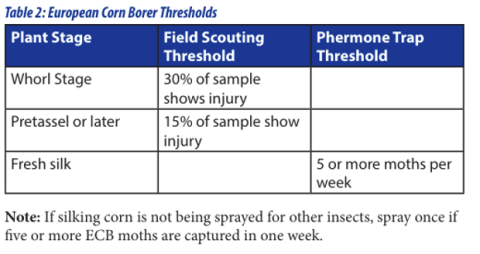
We caught 5 corn earworm in Hollis this week. Corn earworm migrates north with storms and weather events and does not become an issue until silking corn is present since that is where the female moths lay their eggs.
We caught our first squash vine borer adults in multiple locations this week. Captures are shown in Table 1 below. The number of moths captured with pheromone traps can be used to decide whether or not insecticide treatment is required. For bush-type summer squash and pumpkins (including giant pumpkins), the recommended threshold is 5 SVB moths per trap per week. For vining type squash or pumpkins, we suggest a threshold of 12 moths per trap per week. The difference is because vine-type cucurbits can root or tiller in at each node along the vine. This allows the plant to uptake water and nutrients from more than just the main stem. SVB tends to bore into the main stem of cucurbit plants, creating a higher risk for bush type plants.
| Location | #Traps | # SVB moths | Average/Trap |
|---|---|---|---|
| Milford | 2 | 3 | 1.5 |
| Litchfield | 2 | 6 | 3 |
| Hudson | 1 | 1 | 1 |
| Hollis | 3 | 2 | 0.7 |
| Antrim | 1 | 0 | 0 |
| Mason | 1 | 0 | 0 |
| Goffstown | 1 | 0 | 0 |
| New Boston | 1 | 4 | 4 |
| Loudon | 1 | 5 | 5 |
Spotted wing drosophila numbers are increasing. Captures by crop are shown in Table 2 below. We trap in Goffstown, Concord, Litchfield, Milford, and Hollis, NH. If you have susceptible ripening fruit, I recommend monitoring for SWD, especially in strawberries and earlier season fruits. More information on monitoring for SWD can be found here. I also want to share this resource from Cornell on SWD management. It includes insecticides for each crop group that SWD may infest. Be sure to check the label for use in NH!
| Crop | #SWD males |
|---|---|
| Control | 15 |
| Strawberry | 3 |
| Raspberry | 1 |
| Cherry | 16 |
Miscellaneous pest information:
- Cabbage aphids were observed at an organic farm this week. They have a waxy, protective covering that gives them a white-matte gray appearance, and they feed on the underside of leaves. Populations will continue to build throughout the season, and these aphids are usually worse in fall plantings. Feeding injury includes wrinkled and downward-curling leaves, yellow leaves, reduced growth, contamination with aphid honeydew, and contamination of the marketable parts of the plant. Rotating fall and spring brassicas and removing/destroying/incorporating previous crop residues and wild mustards can help reduce populations, especially before aphids hatch in the spring. If these aphids become a consistent problem, systemic insecticides used at planting or sidedress can help to eliminate early infestations and better protect later plantings. The New England Veg Guide provides cultural management, scouting thresholds and insecticide information.
- A diamondback moth pupa was observed this week on brassicas. Young larvae will not chew all the way through the leaf, leaving “windowpane” holes with translucent layers of leaf tissue. Most DBM moths arrive with storms, and we can expect numbers to increase as the season progresses. More information can be found here.
- Cucumber beetles have been very prolific this year. Striped cucumber beetles feed on foliage, flowers and fruit and transmit bacterial wilt. Plants are most susceptible to infection before the 5-leaf stage. See the Vegetable IPM Report from 6.6.24 for more information.
- Squash bug adults and eggs were observed in a high tunnel this week. Summer squash, zucchini, pumpkins, and Cucurbita maxima crops are more susceptible to squash bug feeding damage. Resistant crops include watermelon, cucumber, cantaloupe, and butternut (also relatively resistant to squash vine borer). Row covers can help exclude squash bugs but need to be removed for pollination. Eggs and early nymphs are the easiest stages to control. To reduce risks to bees, treat plants late in the day when flowers are closed.
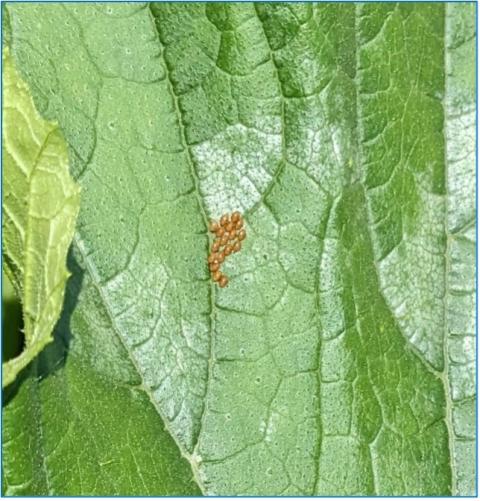
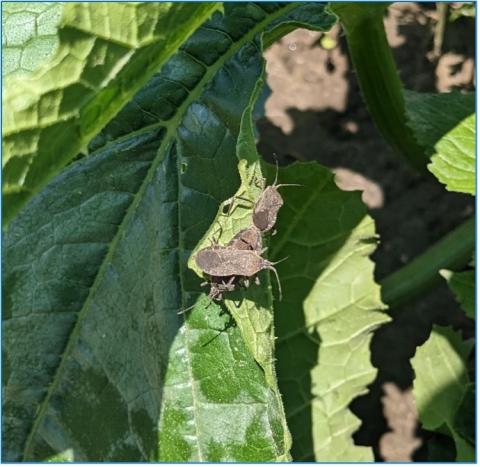
- I have received a few questions about tortoise beetles this year. Generally, these are not major problems. This fact sheet from MOFGA provides information on tortoise beetles if you have been seeing them on your plants, especially nightshades.
- Colorado potato beetle larvae have hatched in many locations. It is best to target the newly hatched/younger larvae with insecticides to prevent 4th instar larval feeding, which are responsible for 85% defoliation. For more information, see the Vegetable IPM Report from 6.6.25.
- Onion thrips are likely increasing due to the warm days this week. See the Vegetable IPM Report from 6.16.25 for more information.
Diseases of the Week:
In honor of our Brassica IPM Meeting this week, let’s discuss Alternaria leaf spot of brassicas. Alternaria leaf spot is a common foliar disease of brassica crops. It is potentially caused by three fungal pathogens: Alternaria brassicicola, A. brassicae, and A. raphani. This disease can affect crops such as cabbage, cauliflower, kale, brussels sprouts, and broccoli. Infections can cause reduction in crop quality and yield through damage to seedlings, leaves, and heads. Disease development is favored by warm temperatures (60-78 °F) and long periods of leaf wetness or high relative humidity (90%).
The most common symptom of Alternaria are leaf lesions that begin as small black dots with chlorotic halos and enlarge to form dark brown spots with target-like concentric rings. The center of these lesions can often crack or fall out, causing a shot-hole appearance. Black sooty spores can be produced on the surface of the leaf during periods of high humidity. Symptoms typically appear in older, lower leaves first and then move up the plant as the disease progresses.
Cultural controls are highly effective at reducing disease pressure such as using clean seeds, decreasing leaf wetness and relative humidity in the planting (not overhead irrigating is one of the most effective cultural management strategies), managing weeds (especially wild mustard) and pests (flea beetle), and removing infected plant tissue. For fungicide management, Quadris and Quadris Top are rated as excellent efficacy against Alternaria leaf spot, with Endura, Inspire Super, and Fontelis rated as good efficacy based on the 2025 Southeastern US Vegetable Crop Handbook(page 212). More detailed fungicide information and options for conventional and organic commercial growers can be found in the New England Vegetable Management Guide.
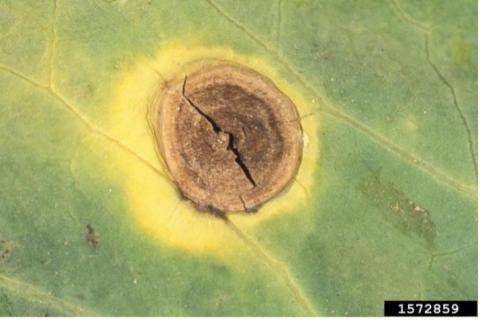
Photo: Gerald Holmes, Strawberry Center, Cal Poly San Luis Obispo, Bugwood.org
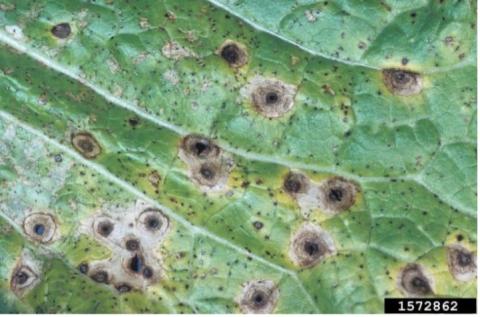
Photo: Gerald Holmes, Strawberry Center, Cal Poly San Luis Obispo, Bugwood.org
Powdery Mildew of Cucurbits: It is that time of year again when we are starting to see powdery mildew on our cucurbits, especially the squashes and pumpkins. Powdery mildew of cucurbits is caused by the fungal pathogen Podosphaera xanthii. The disease can affect all cucurbit plants with symptoms appearing as pale-yellow leaf spots that then appear as white powdery spots on the upper or lower leaf surface. Symptoms usually start on older leaves. When infections are high, plants become weak, reducing yield, and can even cause fruit to ripen prematurely. Disease development is favored by warm temperatures (68-80 °F) and high relative humidity (60-90%).
Cultural practices include planting varieties that have complete or partial resistance to the fungus. Many seed companies will detail whether there is powdery mildew resistance or tolerance on each of their cucurbit varieties. Other cultural controls include providing good air movement around plants through proper spacing, staking of plants, and weed control.
Fields should be scouted at fruit initiation, and farmers should begin applying fungicides when powdery mildew symptoms are at low levels (the threshold is 1 of 50 old leaves with symptoms). Powdery mildew has a high likelihood of fungicide resistance, so many products historically used are no longer effective (Topsin-M, Flint Extra and other Group 11). Please rotate FRAC numbers to slow the buildup of resistance in our fields and to maintain good control options.
Luna Experience, Vivando, and Quintec are rated as good efficacy against powdery mildew, while Bravo Weather Stick, Switch, Inspire Super, Rally, Fontelis, Pristine, Sulfur, and Procure were rated as fair efficacy based on the 2025 Southeastern US Vegetable Crop Handbook(page 223). More detailed fungicide information and options for conventional and organic commercial growers can be found in the New England Vegetable Management Guide.
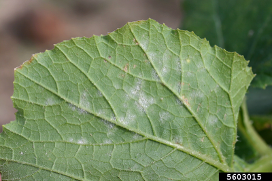
Photo: Gerald Holmes, Strawberry Center, Cal Poly San Luis Obispo, Bugwood.org
High Heat Message
Due to the very high heat and humidity we experienced earlier this week, we want to share a useful app called the Heat Index that our colleague, Olivia Saunders, shared with our team. This app is from OSHA and is free to use. It syncs with local weather data to give you real-time risk levels for outdoor work. It gives practical tips for working outside, depending on the heat index level. Farming doesn’t stop due to heat, so in high heat situations, the app can provide recommendations to protect yourself and your employees like "cycle your work schedule for 45 min work, 15 min of break in the shade”, or for moderate work, “drink 1 cup of water every 15 to 20 minutes”. Planning around the heat ratings can be very helpful on those dangerous heat days. https://www.osha.gov/heat/heat-app
FREE TOMATO PLANTS: Chuck Andersen from Mason Hollow Nursery in Mason, NH has a new variety of tomato that he bred himself called ‘Kraken’ that is an indeterminate variety that has strong cold tolerance and small-medium sized slicers. They have a few dozen plants left if anyone would like to get some free plants from Chuck! Feel free to reach out to Chuck directly at 603-878-5357.
Please sign up for our text service! To sign up: text UNHIPM to 866-645-7010.
Check back in each week as the season progresses to see the latest trapping data. Data for additional insect pests will be updated on a weekly basis. Thank you to all the growers who participate in the program!
For any plant disease diagnostics, contact the UNH Extension Plant Diagnostic Lab to submit a sample.
Contacts: Amber Vinchesi-Vahl, UNH Extension State Specialist, Entomology and IPM, Amber.Vinchesi@unh.edu; Liza DeGenring, UNH Extension Field Specialist, Hillsborough County, Liza.DeGenring@unh.edu
This program is made possible thought funding provided by the New Hampshire Department of Agriculture, Markets & Food Integrated Pest Management Program. This work is also supported in part by the University of New Hampshire Integrated Pest Management Extension Implementation Plan, project award no. 2024-70006-43535, from the U.S. Department of Agriculture's National Institute of Food and Agriculture.
Hello vegetable IPM folks!
We caught 4 European corn borers this week, down from 15 last week. If you have corn that is in or approaching mid-whorl stage, consider scouting for damage (procedure below). The results of our trapping efforts are recorded by town in Table 1. In some cases, there are multiple traps within a town. Click HERE for more information on ECB management.
Table 1. European corn borer weekly summary, 6/16-6/20/2025.
| Town | #ECB Moths | Avg. Moths/Trap |
|---|---|---|
| Milford | 1 | 0.25 |
| Litchfield | 1 | 0.24 |
| Hollis | 1 | 0.10 |
| New Boston | 1 | 0.25 |
Early season scouting procedure for ECB: Wait until mid to late whorl stage to scout. Select at least 5 sites across the planting, all of the same variety and planting date. Do not check field edges to avoid the “edge effect.” To make your sampling most representative of the field, follow a rough X pattern across the planting. At each site, examine 20 stalks, and look at the whorl area for the tiny “shot holes” that show corn borers are in that stalk. Often there is a tiny bit of light, powdery frass adjacent to the small holes. If you see such signs, mark that stalk as infested. As you move across the planting, keep track of two things: 1) how many stalks are infested; and 2) the total number of stalks you’ve counted. Stop at 100. If you reach a threshold of 30 or more infested stalks, it is worthwhile to treat them with an insecticide. For very early corn (high value), you may wish to adjust that threshold down to 15. If the infestation rate is below threshold, it will cost more to treat the corn than the damage is worth. For sweet corn in the pre-tassel stage (tassel is visible in the whorl), use the 15% threshold (Table 2 below). See information source here.
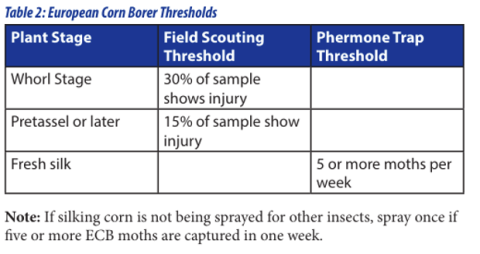
We caught zero corn earworm this week. Corn earworm migrates north with storms and weather events and does not become an issue until silking corn is present since that is where the female moths lay their eggs.
Spotted wing drosophila. We caught 2 SWD in cherries this week. Low numbers have also been reported in CT, NY, and PA. If you have susceptible ripening fruit, I recommend monitoring for SWD, especially in strawberries and earlier season fruits. More information on monitoring for SWD can be found here. I also want to share this resource from Cornell on SWD management. It includes insecticides for each crop group that SWD may infest. Be sure to check the label for use in NH!
Miscellaneous pest information:
- Imported cabbageworm (ICW) overwinters in New Hampshire making it one of the first brassica caterpillar pests observed on crops in the spring. The cabbage butterfly is the adult of ICW and the larvae is a green, velvety/fuzzy-looking caterpillar. The larvae feed on the underside of leaves and also within the center or heads of cabbage and broccoli. Feeding damage looks like irregular/ragged holes and you can usually also find frass in the plant as well. We have 3-4 generations in New England. To manage ICW, incorporate/destroy crop residues shortly after harvest to decrease movement to other brassica plantings and to reduce overwintering populations. Predators can suppress populations and there are many materials that control caterpillars with minimal non-target effects (see New England Vegetable Management Guide for more information). Usually, young plants don't need to be treated unless development is delayed and 35% or more of plants are infested with ICW. The most critical time to scout and apply treatments is just before heads form. We will be releasing a fact sheet on the brassica caterpillar pest complex this summer (imported cabbageworm, diamondback moth, cabbage looper, cross-striped cabbageworm).
- Slugs generally feed at night but may feed during the day during prolonged periods of cloudy wet weather, which we have seen a lot of this spring. Feeding damage looks like shredded foliage or shallow, irregular-shaped holes (common on bottom leaves). You can scout for slugs by looking for slime trails on leaves, turning over hiding spots during the day, or scouting after dusk. For slug management, implement cultural controls (growing away from moist/shaded areas, clean cultivation, weed control, removing hiding places), handpicking, repellents and baits. On a small scale, it may be easiest to handpick slugs after dusk using gloves and then dropping them in soapy water. Baits should be applied to the ground near infested plants. It may be necessary to reapply after a rain, or make multiple applications when populations are high.
- Onion thrips have been reported from multiple locations in the state. Warm days and dry weather will allow populations to build quickly. See the Vegetable IPM Report from 6.16.25 for more information.
- Cyclamen mites have been reported in strawberries. They are generally more of an issue in years 2 and 3 of strawberry production. More detailed information can be found on page 101 of the Strawberry Production Guide for the Northeast, Midwest and Canada, 2nd edition.
- Cucumber beetles. Striped cucumber beetles feed on foliage, flowers and fruit and transmit bacterial wilt. Plants are most susceptible to infection before the 5-leaf stage. See the Vegetable IPM Report from 6.6.24 for more information.
- Colorado potato beetle. CPB overwinter as adults and favor edges of non-rotated solanaceous crop fields. We observed many egg clusters and adults on solanaceous crops last week. It is best to target the newly hatched/younger larvae with insecticides to prevent 4th instar larvae, which are responsible for 85% defoliation. For more information, see the Vegetable IPM Report from 6.6.25.
- Crucifer flea beetles are very prevalent in brassica crops this spring. See the Vegetable IPM Report from 5.23.25 for more information.
- Diseases: With the cool, wet weather we have had this spring, root rots can be a concern for vegetable production. Damping-off of seedlings can be caused by Pythium, Rhizoctonia, or Fusarium species. Additionally, Phytophthora can cause significant crop loss in wet fields. Make sure to allow fields to dry out prior to planting and if you are concerned about these soil diseases, reach out to your Extension specialist to come up with a management plan.
There are many diseases that favor the cool, wet spring we have had, so many growers may be seeing disease symptoms in their crops that were planted earlier this season. The New England Vegetable Management Guide is a great resource for disease management tools. Feel free to reach out to Liza DeGenring if you need help with management or would like to report diseases that you are seeing on your crops!
Please sign up for our text service! To sign up: text UNHIPM to 866-645-7010.
Upcoming Events:
- WEDNESDAY! June 25, 2025: Vegetable Twilight Meeting at Trombly Gardens, 5:30-7:30pm
Trombly Gardens, 150 North River Road, Milford, NH 03055
https://extension.unh.edu/event/2025/06/vegetable-twilight-meeting-trombly-gardens
Join us for this grower gathering, co-sponsored by UNH Extension & NH Vegetable and Berry Growers Association. We will offer a deep dive into pests of brassica plants and how to manage them through IPM. Additionally, we will discuss some of the value-added products that complement vegetable production. This is a free event, and registration is not required. 1.5 PAT credits.
Check back in each week as the season progresses to see the latest trapping data. Data for additional insect pests will be updated on a weekly basis. Thank you to all the growers who participate in the program!
For any plant disease diagnostics, contact the UNH Extension Plant Diagnostic Lab to submit a sample.
Contacts: Amber Vinchesi-Vahl, UNH Extension State Specialist, Entomology and IPM, Amber.Vinchesi@unh.edu; Liza DeGenring, UNH Extension Field Specialist, Hillsborough County, Liza.DeGenring@unh.edu
This program is made possible thought funding provided by the New Hampshire Department of Agriculture, Markets & Food Integrated Pest Management Program. This work is also supported in part by the University of New Hampshire Integrated Pest Management Extension Implementation Plan, project award no. 2024-70006-43535, from the U.S. Department of Agriculture's National Institute of Food and Agriculture.
Hello vegetable IPM folks!
I hope many of you were able to make some progress with the few days of sun this past week, but I know many fields are still very wet.
Our first European corn borers were caught last week. The colder weather this spring likely delayed pupation and emergence. We saw a low population in 2024, and we will see how that translates to 2025, but captures are increasing across locations this week. If you have early corn that is in or approaching mid-whorl stage, consider scouting for damage (procedure below). The results of our trapping efforts are recorded by town in the Table 1. In some cases, there are multiple traps within a town. Click HERE for more information on ECB management.
Table 1. European corn borer weekly summary, 6/9-6/12/2025.
| Town | #ECB Moths | Avg. Moths/Trap |
|---|---|---|
| Litchfield | 1 | 0.25 |
| Hudson | 1 | 0.50 |
| Hollis | 1 | 0.10 |
| Antrim | 12 | 6.00 |
Early season scouting procedure for ECB: Wait until mid to late whorl stage to scout. Select at least 5 sites across the planting, all of the same variety and planting date. Do not check field edges to avoid the “edge effect.” To make your sampling most representative of the field, follow a rough X pattern across the planting. At each site, examine 20 stalks, and look at the whorl area for the tiny “shot holes” that show corn borers are in that stalk. Often there is a tiny bit of light, powdery frass adjacent to the small holes. If you see such signs, mark that stalk as infested. As you move across the planting, keep track of two things: 1) how many stalks are infested; and 2) the total number of stalks you’ve counted. Stop at 100. If you reach a threshold of 30 or more infested stalks, it is worthwhile to treat them with an insecticide. For very early corn (high value), you may wish to adjust that threshold down to 15. If the infestation rate is below threshold, it will cost more to treat the corn than the damage is worth. For sweet corn in the pre-tassel stage (tassel is visible in the whorl), use the 15% threshold (Table 2 below). See information source here.
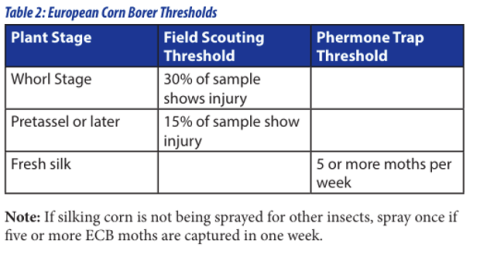
A few corn earworm traps were set out earlier than usual this year. We are participating in a study with the University of Maryland, along with a few other northeastern states, to determine if our early corn earworm moths are from an overwintering population or migrating population. We captured 1 CEW May 19th, 2 on May 27th, and 2 this week on June 10th, so numbers remain low. Corn earworm does not become an issue until silking corn is present since that is where the female moths lay their eggs.
We are also trapping for swede midge and leek moth in Coos County this year, where both invasive species are known to be present. We are collaborating with the NH Department of Agriculture, Markets and Food again this year to trap both pests in Hillsborough County, though neither pest has been confirmed there. We confirmed leek moth in late May in Coos County.
Miscellaneous pest information:
- Spotted wing drosophila. New York and Connecticut have reported SWD captures. We have 10 traps out in southern NH and have zero captures. If you have susceptible ripening fruit, I recommend monitoring for SWD, especially in strawberries and earlier season fruits. More information on monitoring for SWD can be found here.
- Onion thrips overwinter as adults in crop remnants, alfalfa, wheat, greenhouses and weeds on field borders. Adults and larvae cause feeding damage in protected areas between leaves, inner leaves, and leaf folds. Plants are most susceptible when plants are small, and bulbs are forming. Infestations build up on field edges first. Onion thrips can also be a problem for cabbage. If you are already seeing some thrips on your onions, you can expect numbers to increase with the warm, sunny weather we have had the last couple of days. Heavy rain or overhead irrigation can help with thrips control since they favor hot, dry conditions. Other management strategies include conserving beneficials, removing or destroying crop residue after harvest, crop rotation away from or out of alliums, clover, alfalfa, cucurbits or brassicas, and reflective mulch as a repellent. More information can be found in the New England Vegetable Management Guide.

- Cyclamen mites have been reported in strawberries. Cyclamen mites are very small mites that feed in the crown of the plant, causing distorted leaves and buds that fail to open. They are not as common as two-spotted spider mites and require different miticides for control. They can be transported through nursery stock. More detailed information can be found on page 101 of the Strawberry Production Guide for the Northeast, Midwest and Canada, 2nd edition.
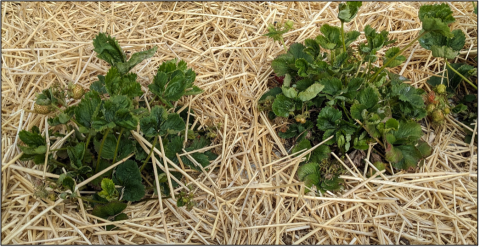
- Beet leafminer damage was observed at an organic farm this week. For growers selling beet leaves in addition to beets, leafminer can be a bigger problem due to tunneling damage on the leaves. Beet leafminer (and spinach leafminer) overwinter as pupae in the soil and adults emerge mid-Spring. Larvae feed between the upper and lower surfaces of the leaf, creating tunnels. These expand into large blotches of whitish, dead tissue on the leaves. Damaged leaves are unmarketable. Once fully grown, maggots usually drop into the soil to pupate. There are 3-4 generations per season, with peak activity periods in late May, late June, and mid-August. After August, pupae enter the overwintering phase and won’t emerge again until spring. For management, rotating crops (chard, beets, spinach) away from previous plantings, controlling weeds, and applying row covers (check plants for eggs on undersides of leaves before covering) can be helpful. Treatment is recommended when eggs are first observed. Scout again 7-10 days later to determine if a second treatment is needed. Use an adjuvant to ensure coverage of the lower leaf surface. Spinosad has been reported as an effective organic option for leafminer when applied before eggs hatch. For more information, see the New England Vegetable Management Guide.
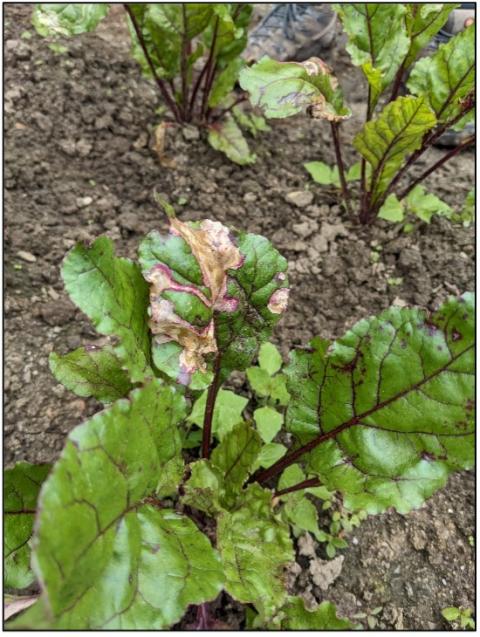
- Cucumber beetles. Striped cucumber beetles feed on foliage, flowers and fruit and transmit bacterial wilt. Plants are most susceptible to infection before the 5-leaf stage. See the Vegetable IPM Report from 6.6.24 for more information.
- Colorado potato beetle. CPB overwinter as adults and favor edges of non-rotated solanaceous crop fields. For more information, see the Vegetable IPM Report from 6.6.25.
- Diseases: With the cool, wet weather we have had this spring, root rots can be a concern for vegetable production. Damping-off of seedlings can be caused by Pythium, Rhizoctonia, or Fusarium species. Additionally, Phytophthora can cause significant crop loss in wet fields. Make sure to allow fields to dry out prior to planting and if you are concerned about these soil diseases, reach out to your Extension specialist to come up with a management plan.
There are many diseases that favor the cool, wet spring we have had, so many growers may be seeing disease symptoms in their crops that were planted earlier this season. The New England Vegetable Management Guide is a great resource for disease management tools. Feel free to reach out to Liza DeGenring if you need help with management or would like to report diseases that you are seeing on your crops!
Please sign up for our text service! To sign up: text UNHIPM to 866-645-7010.
Upcoming Events:
- June 25, 2025: Vegetable Twilight Meeting at Trombly Gardens, 5:30-7:30pm
Trombly Gardens, 150 North River Road, Milford, NH 03055
https://extension.unh.edu/event/2025/06/vegetable-twilight-meeting-trombly-gardens
Join us for this grower gathering, co-sponsored by UNH Extension & NH Vegetable and Berry Growers Association. We will offer a deep dive into pests of brassica plants and how to manage them through IPM. Additionally, we will discuss some of the value-added products that complement vegetable production. This is a free event, and registration is not required. 1.5 PAT credits.
Check back in each week as the season progresses to see the latest trapping data. Data for additional insect pests will be updated on a weekly basis. Thank you to all the growers who participate in the program!
For any plant disease diagnostics, contact the UNH Extension Plant Diagnostic Lab to submit a sample.
Contacts: Amber Vinchesi-Vahl, UNH Extension State Specialist, Entomology and IPM, Amber.Vinchesi@unh.edu; Liza DeGenring, UNH Extension Field Specialist, Hillsborough County, Liza.DeGenring@unh.edu
This program is made possible thought funding provided by the New Hampshire Department of Agriculture, Markets & Food Integrated Pest Management Program. This work is also supported in part by the University of New Hampshire Integrated Pest Management Extension Implementation Plan, project award no. 2024-70006-43535, from the U.S. Department of Agriculture's National Institute of Food and Agriculture.
Hello vegetable IPM folks!
I hope the late spring is going well for everyone and the soils are dry enough to get some planting and cultivation done!
European corn borer traps have been out for four weeks, and we caught our first 3 adult moths this week. The colder weather this spring likely delayed pupation and emergence. We saw a low population in 2024, and we will see how that translates to 2025.
- Early season scouting procedure: Wait until mid to late whorl stage to scout. Select at least 5 sites across the planting, all of the same variety and planting date. Do not check field edges to avoid the “edge effect.” To make your sampling most representative of the field, follow a rough X pattern across the planting. At each site, examine 20 stalks, and look at the whorl area for the tiny “shot holes” that show corn borers are in that stalk. Often there is a tiny bit of light, powdery frass adjacent to the small holes. If you see such signs, mark that stalk as infested. As you move across the planting, keep track of two things: 1) how many stalks are infested; and 2) the total number of stalks you’ve counted. Stop at 100. If you reach a threshold of 30 or more infested stalks, it is worthwhile to treat with an insecticide. For very early corn (high value), you may wish to adjust that threshold down to 15. If the infestation rate is below threshold, it will cost more to treat the corn than the damage is worth. For sweet corn in the pre-tassel stage (tassel is visible in the whorl), use the 15% threshold (Table 2 below). See information source here.
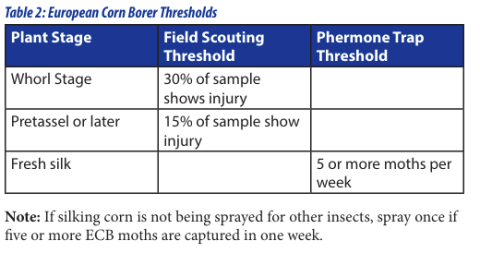
A few corn earworm traps were set out earlier than usual this year. We are participating in a study with University of Maryland, along with a few other northeastern states, to determine if our early corn earworm moths are from an overwintering population or migrating. We captured 1 CEW the week of May 19th and 2 last week, but zero new captures this week. Corn earworm does not become an issue until silking corn is present since that is where the female moths lay their eggs.
We will also be trapping for swede midge and leek moth in Coos County this year, where both invasive species are known to be present. We are collaborating with the NH Department of Agriculture, Markets and Food again this year to trap both pests in Hillsborough County, though neither pest has been confirmed there. We confirmed leek moth captures in late May in Coos County.
New York reported in our weekly regional Extension call that the first flight of leek moth has come to an end and the larvae are out in alliums, especially on chives. Additionally, they caught their first swede midge in Essex County.
Miscellaneous pest information:
- Colorado potato beetle. Colorado potato beetles are out and feeding on solanaceous crops. CPB overwinter as adults, in soil near host crops and become active in mid-May. Adults favor edges of non-rotated solanaceous crop fields and can cause substantial damage to these field edges. CPB feeding may occur in June on young eggplant or later in the season when plants are fully grown and fruit is developing. 2nd generation adults emerge in late July and August, as they can damage leaves, flowers, and petioles, including clipping flower buds. This reduces fruit formation and marketable yield. Scouting procedures for potato and eggplant can be found in the New England Vegetable Management Guide. Remember that CPB can quickly build resistance to insecticides. Careful insecticide class rotation and non-chemical controls are needed to delay resistance. If you have applied insecticides to no effect, change chemical classes and do not use the IRAC group that did not work for the rest of the season. If possible, rotating off certain insecticide groups for two seasons would be best. For more information on CPB management, see our CPB fact sheet.
- Cucumber beetles. Striped cucumber beetles are out and about and can transmit bacterial wilt in addition to feeding on foliage, flowers and fruit of cucurbits. If possible, rotate cucurbit crops to a new place on the farm each year. Cover planting beds with floating row covers immediately after planting seeds or setting out plants. Remove row covers as plants begin to bloom, to ensure adequate bee pollination. Applying a heavy mulch of straw, leaves, or grass clippings around established plants may help reduce striped cucumber beetle attacks. Scout plants frequently for adult beetles or chewing damage on cucurbit stems and foliage. Adult beetles are difficult to handpick, as they fly away or drop to the soil to hide when plants are disturbed. The presence of adult beetles or visible damage to plants may indicate a need for chemical control. The most susceptible time is from crop emergence or transplanting until the plant has reached the 5-leaved stage. If the crop is in bloom when treatment is required, select an insecticide that is low risk to pollinators and spray at dusk or at night. Avoid spraying insecticide in the morning on squash-family crops in bloom. See this UNH fact sheet for more information.
- Diseases: With the cool, wet weather we have had this spring, root rots can be a concern for vegetable production. Damping-off of seedlings can be caused by Pythium, Rhizoctonia, or Fusarium species. Additionally, Phytophthora can cause significant crop loss in wet fields. Make sure to allow fields to dry out prior to planting and if you are concerned about these soil diseases, reach out to your Extension specialist to come up with a management plan.
There are many diseases that favor the cool, wet spring we have had, so many growers may be seeing disease symptoms in their crops that were planted earlier this season. The New England Vegetable Management Guide is a great resource for disease management tools. Feel free to reach out to Liza DeGenring if you need help with management or would like to report diseases that you are seeing on your crops!
Please sign up for our text service! To sign up: text UNHIPM to 866-645-7010.
Upcoming Events:
- June 25, 2025: Vegetable Twilight Meeting at Trombly Gardens, 5:30-7:30pm
Trombly Gardens, 150 North River Road, Milford, NH 03055
https://extension.unh.edu/event/2025/06/vegetable-twilight-meeting-trombly-gardens
Join us for this grower gathering, co-sponsored by UNH Extension & NH Vegetable and Berry Growers Association. We will offer a deep dive into pests of brassica plants and how to manage them through IPM. Additionally, we will discuss some of the value-added products that complement vegetable production. This is a free event, and registration is not required. 1.5 PAT credits.
Check back in each week as the season progresses to see the latest trapping data. Data for additional insect pests will be updated on a weekly basis. Thank you to all the growers who participate in the program!
For any plant disease diagnostics, contact the UNH Extension Plant Diagnostic Lab to submit a sample.
Contacts: Amber Vinchesi-Vahl, UNH Extension State Specialist, Entomology and IPM, Amber.Vinchesi@unh.edu; Liza DeGenring, UNH Extension Field Specialist, Hillsborough County, Liza.DeGenring@unh.edu
This program is made possible thought funding provided by the New Hampshire Department of Agriculture, Markets & Food Integrated Pest Management Program. This work is also supported in part by the University of New Hampshire Integrated Pest Management Extension Implementation Plan, project award no. 2024-70006-43535, from the U.S. Department of Agriculture's National Institute of Food and Agriculture.
Hello vegetable IPM folks!
It has been a slow start to the season while we wait for the fields to dry out.
We have had reports that there have been a lot of equipment failure this year so please feel free to reach out or check out the conservation district for equipment that you can rent while yours is down. A list of equipment rentals can be found here.
Our IPM Scout, Linda, is busy installing and checking traps. European corn borer traps have been out for three weeks with zero captures. The colder, wet spring is likely delaying the emergence of ECB. We also had a low population last year, and we will see how well the overwintering larva survived the winter and this wet spring. A couple of Fall Armyworm traps were set last week with zero captures this week.
A few corn earworm traps were set out earlier than usual this year. We are participating in a study with University of Maryland, along with a few other northeastern states, to determine if our early corn earworm moths are from an overwintering population or migrating. We captured 1 CEW last week and 2 CEW this week at a different farm. Corn earworm does not become an issue until silking corn is present since that is where the female moths lay their eggs.
We will also be trapping for swede midge and leek moth in Coos County this year, where both invasive species are known to be present. We are collaborating with the NH Department of Agriculture, Markets and Food again this year to trap both pests in Hillsborough County, though neither pest has been confirmed there.
Review the last vegetable IPM report from May 23, 2025 for pest information on flea beetles and cutworms!
Please sign up for our new text service!
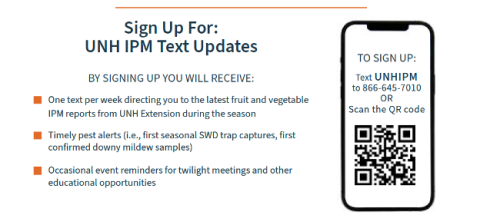
Upcoming Events:
- June 25, 2025: Vegetable Twilight Meeting at Trombly Gardens, 5:30-7:30pm
Trombly Gardens, 150 North River Road, Milford, NH 03055
https://extension.unh.edu/event/2025/06/vegetable-twilight-meeting-trombly-gardens
Join us for this grower gathering, co-sponsored by UNH Extension & NH Vegetable and Berry Growers Association. We will offer a deep dive into pests of brassica plants and how to manage them through IPM. Additionally, we will discuss some of the value-added products that complement vegetable production. This is a free event, and registration is not required. Pesticide applicator credits are pending.
Contact: Amber Vinchesi-Vahl, UNH Extension State Specialist, Entomology and IPM, Amber.Vinchesi@unh.edu; Liza DeGenring, UNH Extension Field Specialist, Hillsborough County, Liza.DeGenring@unh.edu
This work is supported by the University of New Hampshire Integrated Pest Management Extension Implementation Plan, project award no. 2024-70006-43535, from the U.S. Department of Agriculture's National Institute of Food and Agriculture.
Hello Vegetable IPM folks!
I hope everyone stays warm and dry. The good news about the wet weather is that insect pressure is low, though that may not be reassuring with the delays in planting and increased disease pressure in many crops. Despite the weather, Linda is busy installing traps.
European corn borer traps have been out for two weeks with zero captures. The colder, wet spring is likely delaying the emergence of ECB. We also had a low population last year, and we will see how well the overwintering larva survived winter and this wet spring.
A few corn earworm traps were set out earlier than usual this year. We are participating in a study with University of Maryland, along with a few other northeastern states, to determine if our early corn earworm moths are from an overwintering population or migrating. We captured 1 CEW this week. Corn earworm does not become an issue until silking corn is present since that is where the female moths lay their eggs.
We will also be trapping for swede midge and leek moth in Coos County this year, where both invasive species are known to be present. We are collaborating with the NH Department of Agriculture, Markets and Food again this year to trap both pests in Hillsborough County, though neither pest has been confirmed there.
Miscellaneous pest information:
- We have had reports of flea beetles on grapes and brassicas over the past few weeks. Flea beetles are small beetles with enlarged hind legs for jumping. Adult flea beetles are moving into crops from their overwintering sites to feed and mate as the temperatures continue to increase.
- Grape flea beetle (metallic blue-purple): Adults emerge from their overwintering sites in and around the grapevines to feed on buds of grapes. Larvae feed on leaves, though major damage is done by the adults as they chew holes in the sides and ends of primary and secondary buds preventing fruit development. Controlling weeds and cultivating can help control pupae in the soil. Also, removing wild host crops, when possible, can help to reduce overwintering sites. Sprays may be required with heavy pest pressure.
- Crucifer flea beetle (black and shiny) and striped flea beetle (black with 2 yellow stripes): Overwintering flea beetle adults feed on stems and leaves of brassica crops and brassica weeds in May and June and the second generation emerges July-August to feed. Feeding damage resembles shot holes in leaves. Brassica crops with waxy leaves are less attractive than glossy-leaved brassicas. Unfortunately, brassica crops are susceptible to flea beetle feeding through all season, though damage may decrease in September when adults seek out overwintering sites. Scout plants for beetles and damage. Clean cultivation, incorporating crop residue after harvest, row cover, and removing spring weed hosts can help manage flea beetles. If you can, rotate spring brassicas as far as possible from last year’s fall brassica crop to escape peak flea beetle activity. More information can be found in the New England Vegetable Management Guide.
- In northern NH, I received a call about carrot seedlings being eaten and/or cut off at the soil line. This damage is likely due to cutworms, which are nocturnal feeders, and commonly girdle/cut tender stems of vegetable seedlings at the soil line. They hide in the soil or debris during the day and can be better scouted at night with a flashlight. Pressure varies year-to-year and is usually patchy. Cutworms are active in spring and summer but more of an issue in the spring, when plants are small and tender. Removing plant residue, weed control, and tillage can help manage cutworms. Though not always practical, collars or barriers around the stems of plants can help deter cutworms as well. Spot treatments of insecticides can be effective but remember that cutworms are nocturnal and contact insecticides applied during the day are unlikely to effectively control them. More information can be found in the New England Vegetable Management Guide.
- Diseases: With the cool, wet weather we have had this spring, root rots can be a concern for vegetable production. Damping-off of seedlings can be caused by Pythium, Rhizoctonia, or Fusarium species. Additionally, Phytophthora can cause significant crop loss in wet fields. Make sure to allow fields to dry out prior to planting and if you are concerned about these soil diseases, reach out to your Extension specialist to come up with a management plan.
There are many diseases that like cool, wet weather but it greatly depends on the crop and its growth stage. Feel free to reach out to Liza DeGenring if you would like to report diseases that you are seeing on your crops!
Please sign up for our text service! To sign up: text UNHIPM to 866-645-7010.
Upcoming Events:
- NEXT WEEK! May 28, 2025: Berry Twilight Meeting at Saltbox Farm, 5:30-7:30pm
Saltbox Farm, 321 Portsmouth Ave, Stratham, NH 03885
https://extension.unh.edu/event/2025/05/berry-twilight-meeting-saltbox-farm
This grower gathering, co-sponsored by UNH Extension & NH Vegetable and Berry Growers Association, will offer a holistic look at mid-season berry management for effective crop care. We’ll talk about pests, focusing on spotted wing drosophila (SWD) and this season’s monitoring for cranberry and cherry fruit worm. Weed control options will be covered alongside a discussion on soil fertility best practices. Got plants loaded with berries but lacking in foliage? We’ll discuss what that could signal and how to respond. The tour will include raspberries, blackberries, and blueberries. Come ready to learn and sharpen your berry-growing skills with fellow growers and Extension specialists. This meeting is free with no registration required. Pesticide applicator credits are pending.
- June 25, 2025: Vegetable Twilight Meeting at Trombly Gardens, 5:30-7:30pm
Trombly Gardens, 150 North River Road, Milford, NH 03055
https://extension.unh.edu/event/2025/06/vegetable-twilight-meeting-trombly-gardens
Join us for this grower gathering, co-sponsored by UNH Extension & NH Vegetable and Berry Growers Association. We will offer a deep dive into pests of brassica plants and how to manage them through IPM. Additionally, we will discuss some of the value-added products that complement vegetable production. This is a free event, and registration is not required. Pesticide applicator credits are pending.
Contact: Amber Vinchesi-Vahl, UNH Extension State Specialist, Entomology and IPM, Amber.Vinchesi@unh.edu; Liza DeGenring, UNH Extension Field Specialist, Hillsborough County, Liza.DeGenring@unh.edu
This program is made possible thought funding provided by the New Hampshire Department of Agriculture, Markets & Food Integrated Pest Management Program. This work is also supported in part by the University of New Hampshire Integrated Pest Management Extension Implementation Plan, project award no. 2024-70006-43535, from the U.S. Department of Agriculture's National Institute of Food and Agriculture.
Past Reports
10/14/24
Hello vegetable IPM folks!
This is the last report for 2024! The trap counts are for the last two weeks (9/30-10/11). Please take note of the upcoming Climate Resilience Workshops this month. A 2024 season summary is included after this week’s trapping report.
Introducing the new Hillsborough County Field Specialist!
Liza DeGenring (Liza.DeGenring@unh.edu) has joined UNH Extension’s Food & Agriculture Team and Hillsborough County as the new Field Specialist. Liza is a UNH alum, receiving her master’s and PhD degrees in Agricultural Science with a focus on plant pathology. Liza’s work has focused on evaluating alternative tools for plant disease management across a broad range of crop systems including tree fruit, vegetables, row crops, and greenhouse ornamentals. Liza will be working with Amber and Linda on the IPM Monitoring Program moving forward. We are lucky to have her on our Extension team!
Upcoming events:
-Climate Resilience Workshops (register here)! October 18 and 23, 2024. In partnership with the NH County Conservation District and NH NRCS, UNH Extension is hosting two upcoming events showcasing NH farms that are implementing projects to address climate resilience issues of water availability and soil health. The events will focus on tours of the farms and their projects, including Q&As with topic experts and information about financial and technical resources available to farms through the presenting partners. These events are free and open to the public.
- October 18, 2024 from 9 a.m. – 11 a.m. at Clyde Farm, Farmington, NH – Farm Ponds and Water Sources: drought resistance, farm ponds, wells, and irrigation.
- October 23, 2024 from 4 p.m. – 6 p.m. at Wild Fern Farm, Kingston, NH – Soil Heath Practices: the science of soil health, mulching, reduced tillage, and working in small areas.
-New England Fruit and Vegetable Conference (register here!) December 17-19, 2024. The NEVF Conference includes more than 25 educational sessions over three days, covering major vegetable, berry and tree fruit crops as well as various special topics. A Farmer to Farmer meeting after each morning and afternoon session will bring speakers and farmers together for informal, in-depth discussion on certain issues. This conference is put together with close collaboration between growers and Extension from across the region. There is also an extensive Trade Show with over 120 exhibitors.
Funding opportunities for farmers through SARE
Farm Grant calls are out and due November 12th, 2024. For more information, see the Northeast SARE Farmer Grant Program page. Many Q&A sessions are available on October 8, 16, 22, 30. from 12 to 1 EST. You can register to attend here.
Please sign up for our text service! Text UNHIPM to 866-645-7010 to subscribe.
For any plant disease diagnostics, contact the UNH Extension Plant Diagnostic Lab to submit a sample.
Vegetable IPM Report, 9/30-10/11/24
Corn earworm decreased again compared to the last week of September (52) with numbers falling to 9 and then 0. Fall armyworm also decreased down to 48 (from 65 the week prior) and then to 20.
Table 1. Sweet corn pest weekly summary. CEW is in top two panels and FAW is below.
|
|
9/30-10/4/24 |
10/7-10/11/24 |
||||
|
Town |
# CEW moths |
# Traps |
Avg CEW/Trap |
# CEW moths |
# Traps |
Avg CEW/Trap |
|
Antrim |
0 |
1 |
0 |
|
|
|
|
Hollis |
4 |
1 |
4.0 |
0 |
1 |
0 |
|
Litchfield |
0 |
1 |
0 |
0 |
1 |
0 |
|
Mason |
1 |
1 |
1 |
0 |
1 |
0 |
|
Milford |
4 |
3 |
1.3 |
0 |
3 |
0 |
|
New Boston |
0 |
2 |
0 |
0 |
1 |
0 |
|
New Ipswich |
0 |
1 |
0 |
0 |
1 |
0 |
|
Totals |
9 |
10 |
0.9 |
0 |
8 |
0 |
|
|
9/30-10/4/24 |
10/7-10/11/24 |
||||
|
Town |
# FAW moths |
# Traps |
Avg. FAW/Trap |
# FAW moths |
# Traps |
Avg. FAW/Trap |
|
Antrim |
1 |
1 |
1 |
|
|
|
|
Hollis |
2 |
1 |
2 |
3 |
1 |
3 |
|
Litchfield |
9 |
1 |
9 |
8 |
1 |
8 |
|
Mason |
15 |
1 |
15 |
9 |
1 |
9 |
|
Milford |
20 |
3 |
6.7 |
0 |
3 |
0 |
|
New Boston |
1 |
2 |
0.5 |
0 |
1 |
0 |
|
New Ipswich |
0 |
1 |
0 |
0 |
1 |
0 |
|
Totals |
48 |
10 |
4.8 |
20 |
8 |
2.5 |
Squash vine borer numbers were zero, 9/30/24-10/4/24 and traps were removed.
Spotted wing drosophila (SWD) numbers decreased and then increased again but with much lower numbers found in the control traps compared to previous weeks and months.
Table 3. Male SWD trap captures.
|
Crop |
9/30-10/4/24 |
# Traps |
10/7-10/11/24 |
||
|
|
# SWD |
Avg. SWD/Trap |
|
#SWD |
Avg. SWD/Trap |
|
Control |
31 |
24.3 |
3 |
73 |
10.3 |
|
Raspberry |
1 |
2.8 |
6 |
17 |
0.2 |
|
Totals |
32 |
3.6 |
9 |
90 |
10.0 |
Brown marmorated stink bug adult counts almost doubled the first week of October and then dropped again the following week, with very few nymph catches (Table 4). Anna Wallingford recorded a podcast on BMSB that can be found here. You can also read through the transcript rather than listen if that is preferred. In NH, BMSB is more of a nuisance pest but can cause damage to agricultural crops, along with many of our native stink bugs, which we have seen in high numbers this season.
Table 4. BMSB trap captures.
|
|
9/30-10/4/24 |
10/7-10/11/24 |
||
|
Town |
# Adults |
# Nymphs |
# Adults |
# Nymphs |
|
Antrim |
7 |
1 |
|
|
|
Concord |
12 |
0 |
0 |
0 |
|
Hollis |
42 |
1 |
29 |
1 |
|
Litchfield |
18 |
1 |
19 |
0 |
|
Milford |
38 |
3 |
15 |
2 |
|
Total |
117 |
6 |
63 |
3 |
*2024 Season Pest Trends*
European corn borer numbers in 2024 were lower than in 2023, by almost half. The wet fall and mild winter may have contributed to lower overwintering survival. In addition to lower pressure this year, we did not see a 2nd generation in 2024 which is uncommon. The only location where we caught ECB consistently was in Sullivan County. I also observed ECB in sunflower and hemp crops.
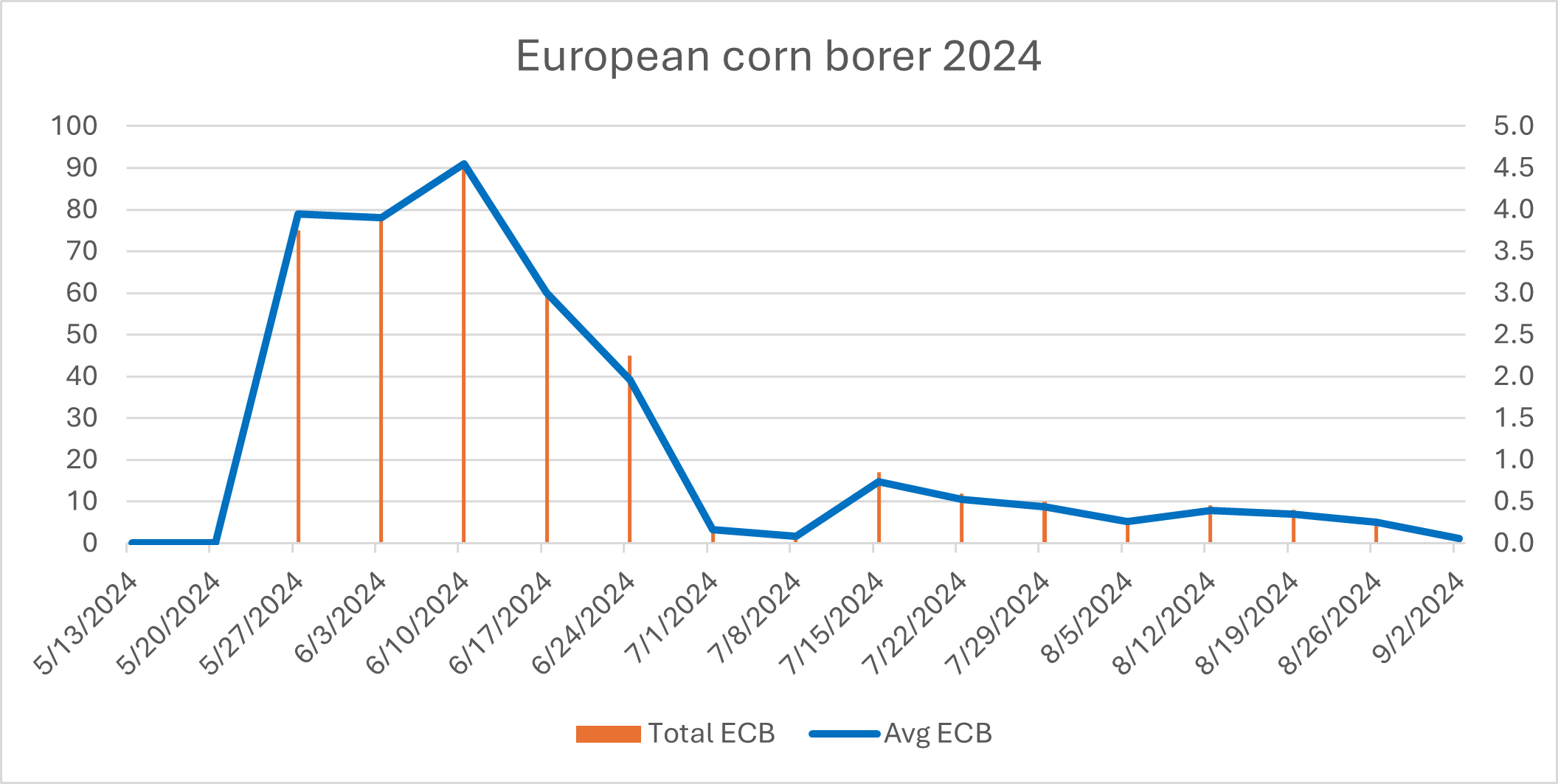
2024 European corn borer. The left axis and columns (orange) represent the total numbers of ECB caught each week, and the right axis and line (blue) represent the average caught per week.
We saw a high spike in corn earworm numbers in late July 2024 (800 moths) due to many storms bringing moths up from the southern US. We were still capturing over 100 moths weekly in early September and saw another small spike in populations in September, like the small spike in late June when we began trapping. In 2023, CEW moth captures started increasing in August and we did not see a CEW peak until mid-September (600 moths), whereas we observed CEW increasing a month earlier in 2024.
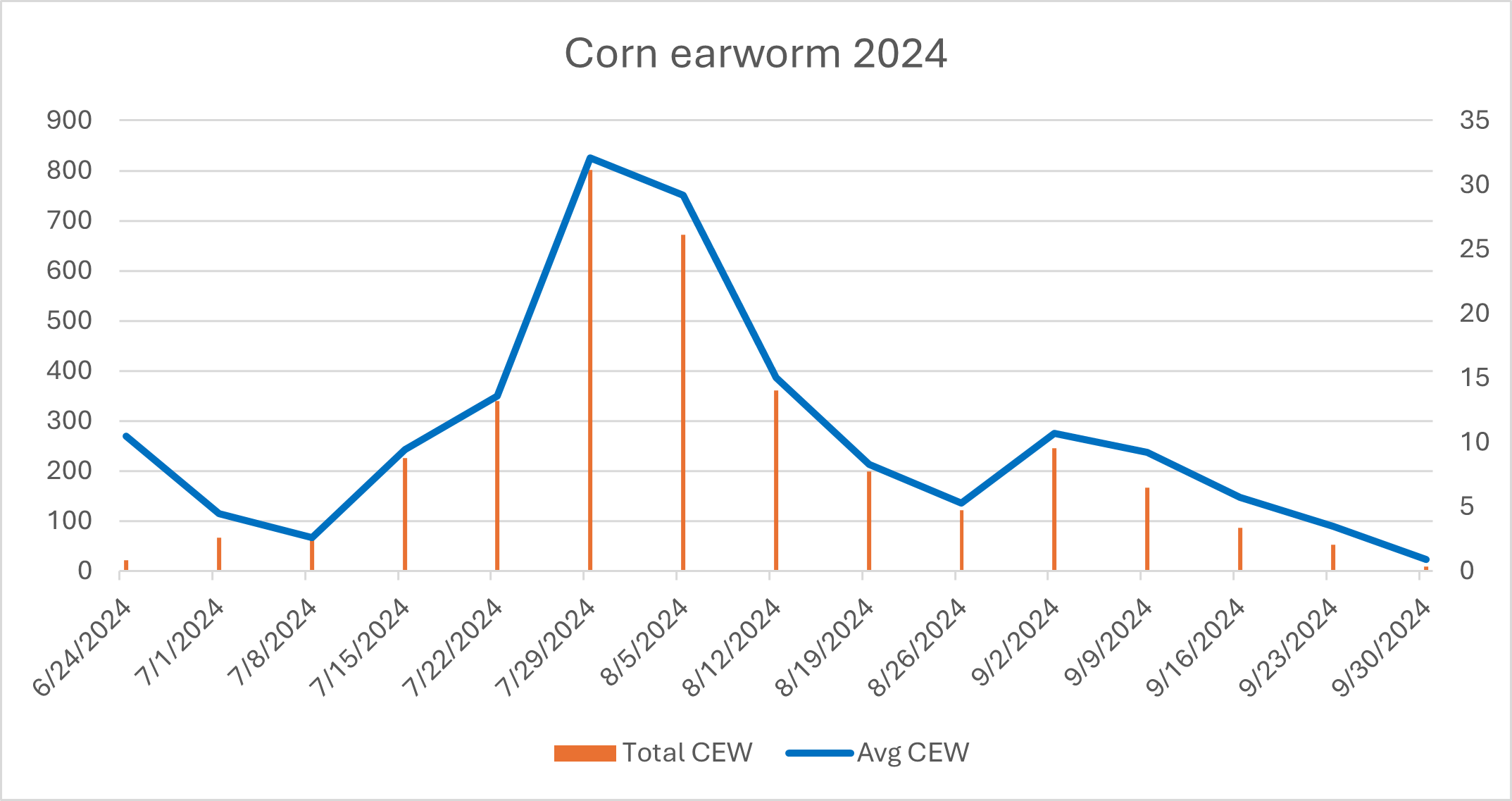
2024 Corn earworm. The left axis and columns (orange) represent the total numbers of CEW caught each week, and the right axis and line (blue) represent the average caught per week. Of note: The average is higher at the beginning of the season because we had less traps deployed in the field.
Fall armyworm moths are not known to overwinter in New Hampshire, but we observed mature larvae feeding in June 2024. Field corn growers also reported seeing FAW caterpillars earlier than expected this year. We did not have traps out when Linda observed the caterpillars in mid-June, so it could have been from a flight that came in spring 2024 on storms, carrying both FAW and CEW. We will be deploying FAW and CEW traps sooner in 2024. Most of the feeding damage observed in sweet corn this year was from FAW larvae. FAW remained relatively high all season, with two peaks, one in late July, like with CEW, because of storms bringing moths north, and again in early September. FAW pressure was significantly higher in 2024 than in 2023, where total captures never surpassed 40 moths/week. FAW numbers also started increasing a month earlier in 2024 compared to 2023.
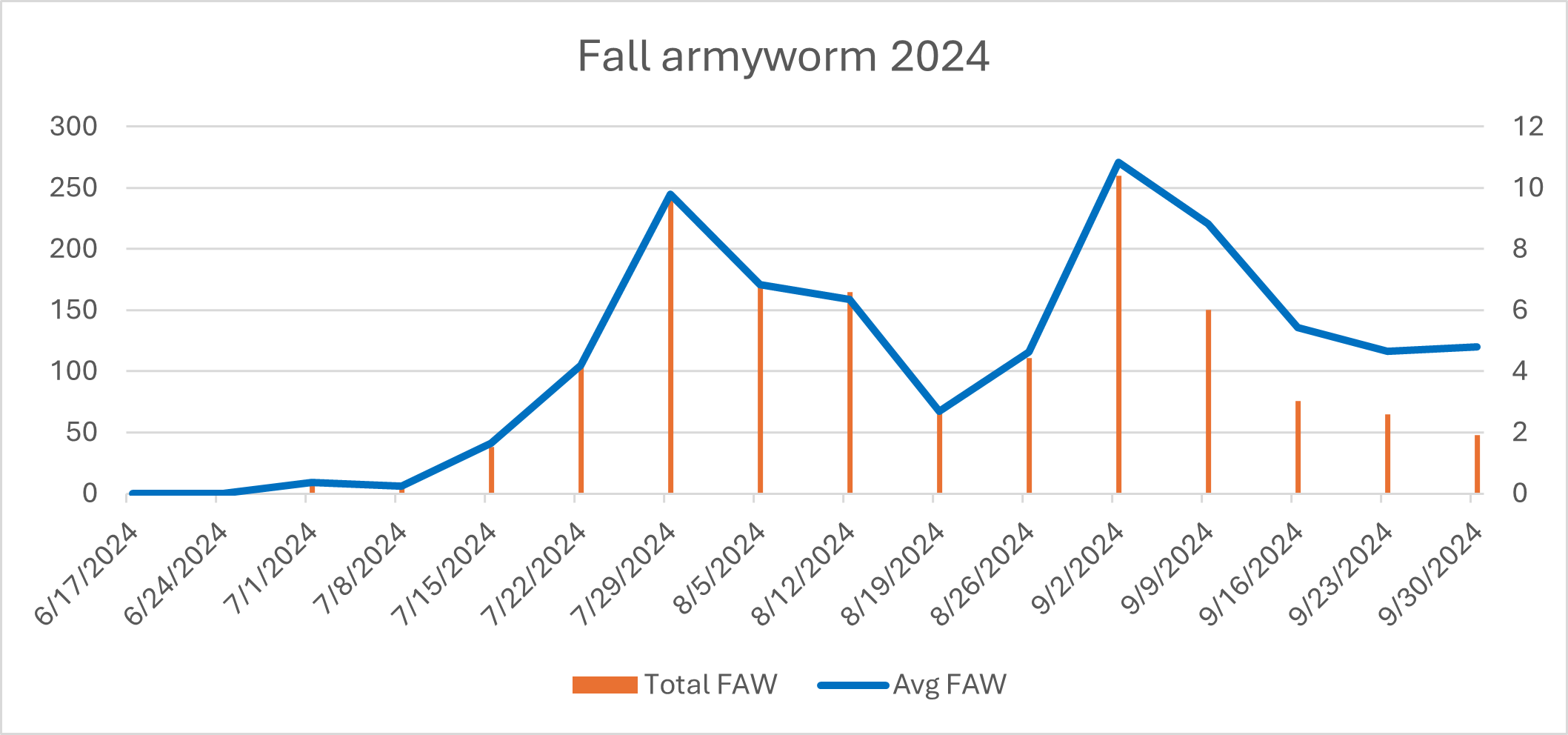
2024 Fall armyworm. The left axis and columns (orange) represent the total numbers of FAW caught each week, and the right axis and line (blue) represent the average caught per week.
Western bean cutworm is a newer pest to New England, moving east from the US corn belt. We observed one spike at the end of July and then the numbers dropped substantially. In 2023, we caught WBC around the same time of year, but we saw a slow decrease in adult moth captures compared to the drastic drop observed in 2024.

2024 Western bean cutworm. The left axis and columns (orange) represent the total numbers of WBC caught each week, and the right axis and line (blue) represent the average caught per week.
Squash vine borer numbers were high for a long period in 2024, and we observed a 2nd generation for the first time since 2013. First generation larvae bore into cucurbit stems and the 2nd generation bore into the fruit.
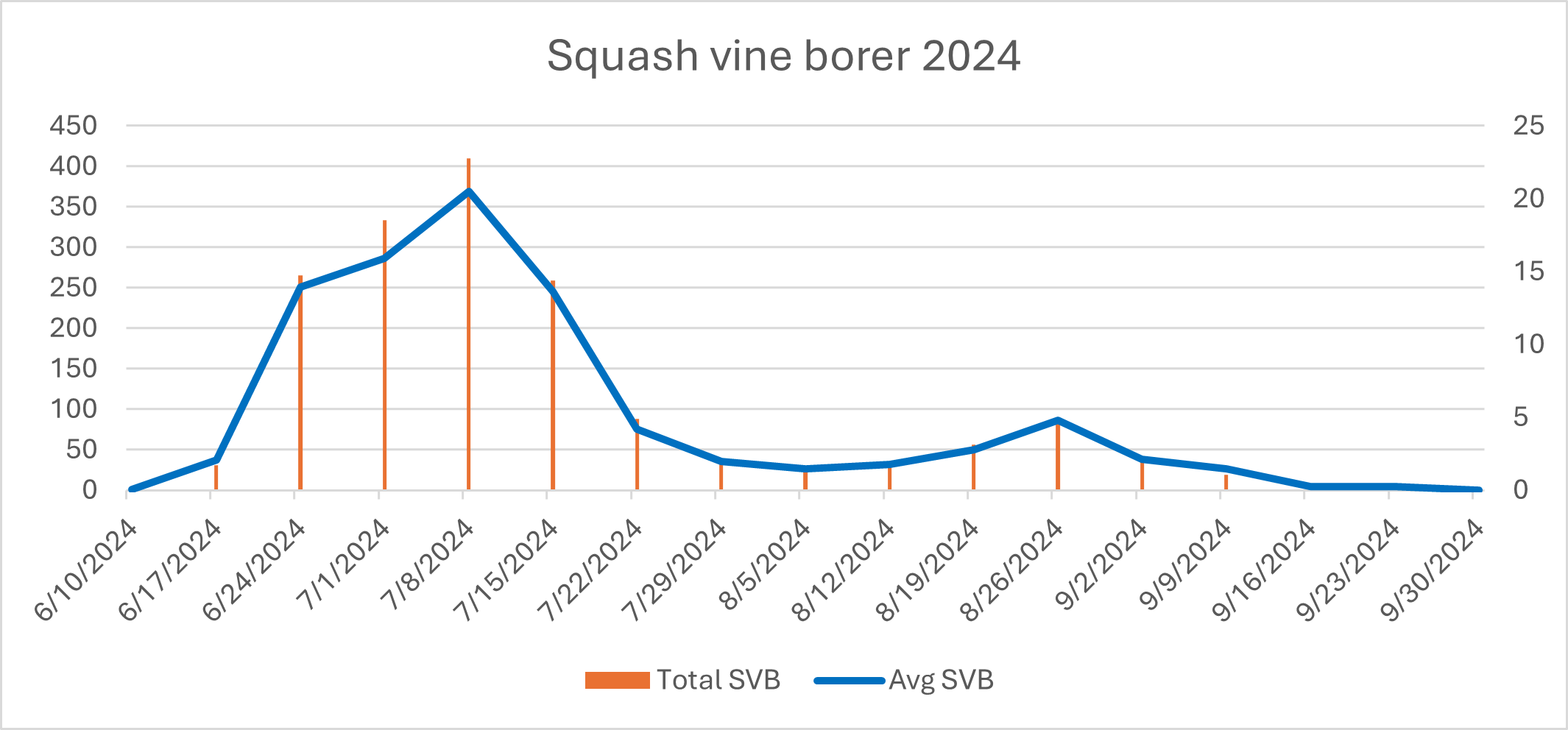
2024 Squash vine borer. The left axis and columns (orange) represent the total numbers SVB caught each week, and the right axis and line (blue) represent the average caught per week.
Brown marmorated stink bug numbers have increased over the past few weeks, which is expected at this time of year, though the total numbers are much higher than in 2023.
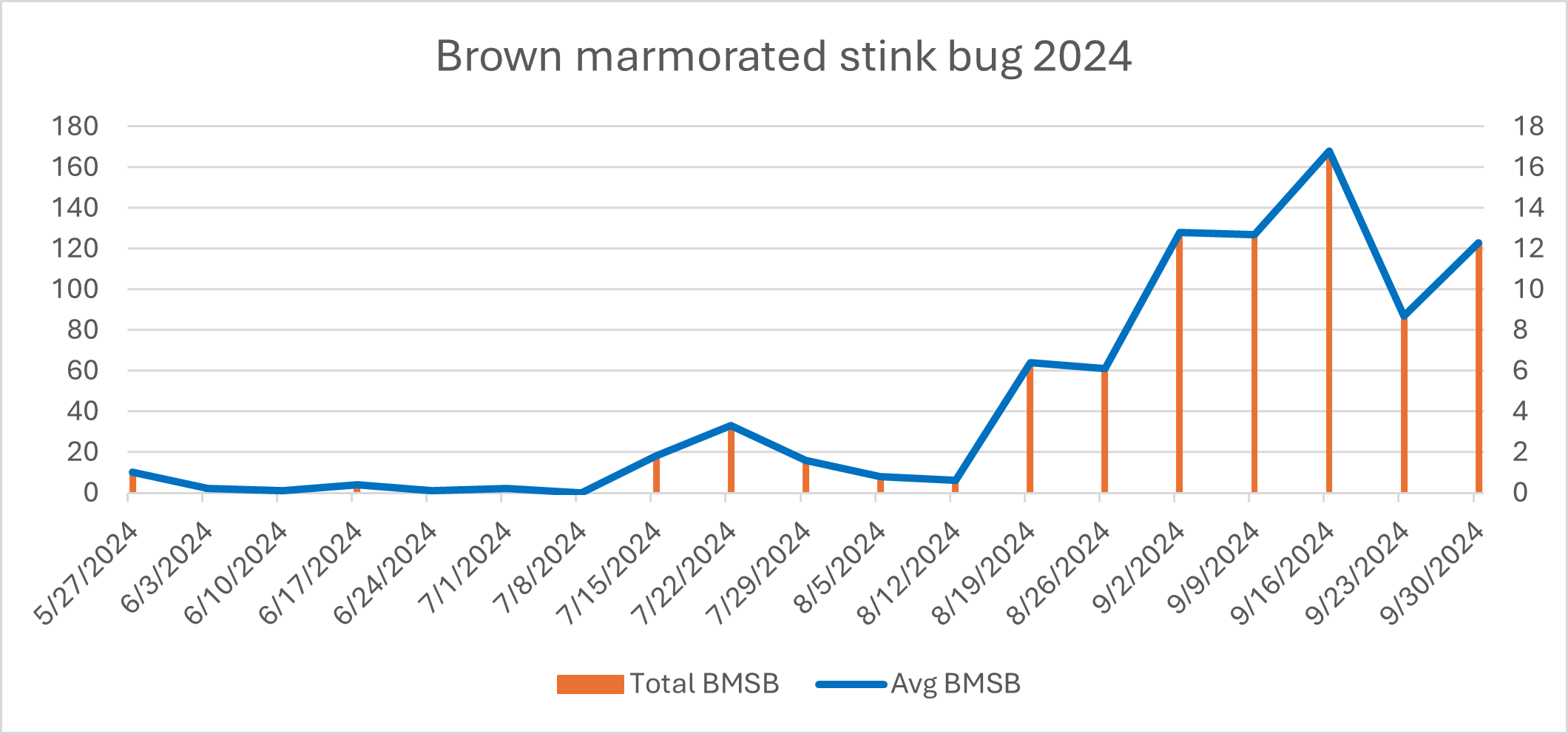
2024 Brown marmorated stink bug. The left axis and columns (orange) represent the total numbers BMSB caught each week (adults and nymphs combined), and the right axis and line (blue) represent the average caught per week.
Spotted wing drosophila were captured earlier than expected in 2024, which affected cherries and some strawberries. We usually expect SWD to arrive by early July (like in 2023), but we began catching SWD in mid-June this year. SWD numbers were higher in August 2023 compared to 2024.
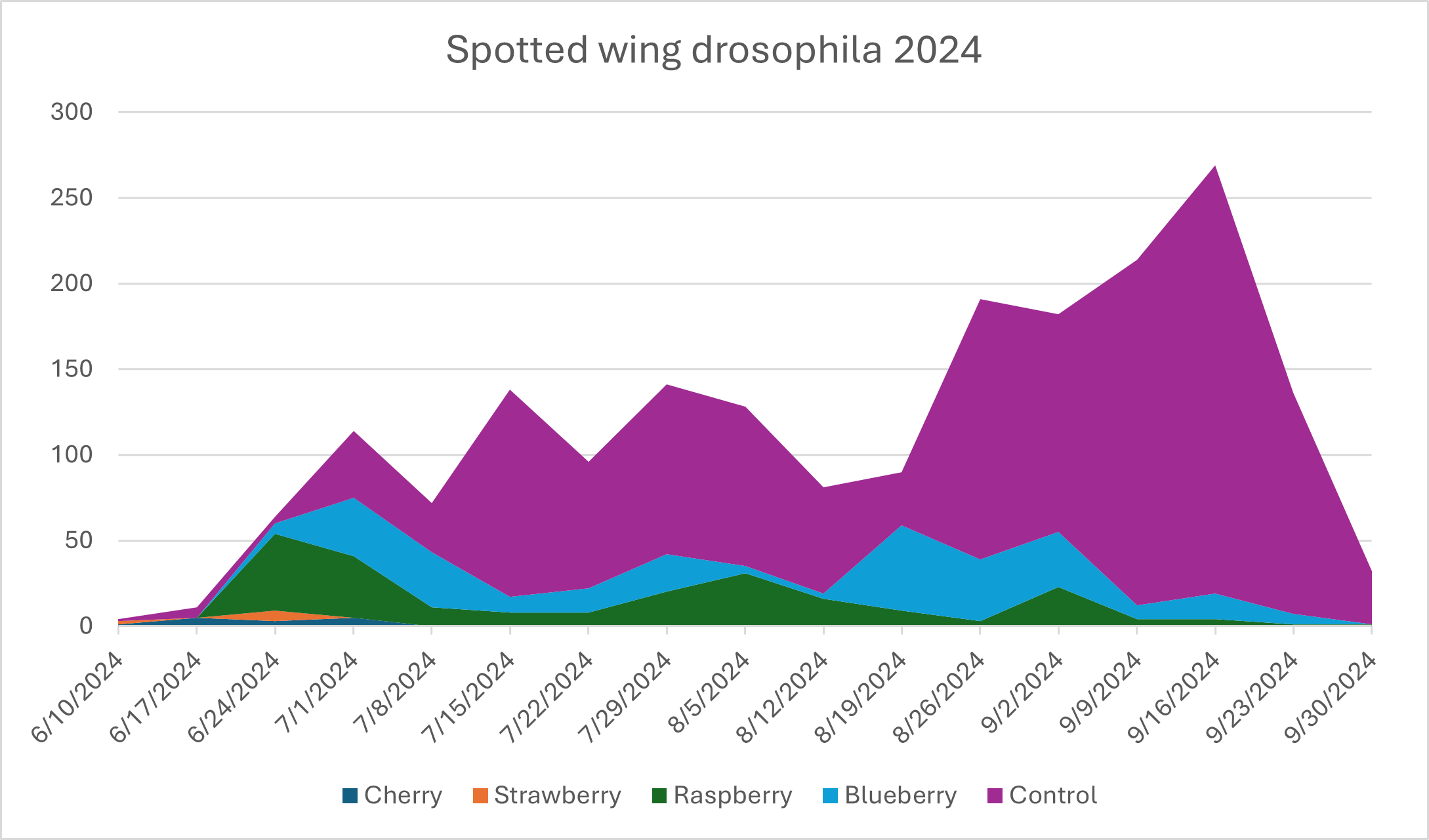
2024 Spotted wing drosophila. This graph represents total SWD over time by crop. Dark blue = cherry, orange = strawberry, green = raspberry, blue = blueberry, purple = control (unmanaged/unsprayed habitats near small fruit).
Thank you to all the growers who participate in the program! Our annual surveys will be distributed in the coming weeks.
Contact: Amber Vinchesi-Vahl, UNH Extension State Specialist, Entomology and IPM, Amber.Vinchesi@unh.edu
This program is made possible thought funding provided by the New Hampshire Department of Agriculture, Markets & Food Integrated Pest Management Program. This work is also supported in part by the Integrated Pest Management Crop Protection and Pest Management Extension Implementation Plan from the USDA National Institute of Food and Agriculture.
9/30/24
Hello vegetable IPM folks!
I hope the harvest is going well for everyone! Our trapping season is wrapping up this week. This will be the last standard Vegetable IPM Report. The next and final report will include seasonal trends and patterns as a summary of the 2024 season. Take note of the upcoming Climate Resilience Workshops in October (listed under Upcoming Events below).
Fall armyworm and corn earworm numbers have decreased again compared to last week, and some locations have been removed since traps have been pulled and the corn season is ending. The results of our trapping efforts for sweet corn pests are recorded by town in Table 1 below. In some cases, there are multiple traps within a town.
Table 1. Sweet corn pest weekly summary, 9/23/2024-9/27/2024.
|
Town |
# CEW moths |
# Traps |
Avg CEW/Trap |
# FAW moths |
# Traps |
Avg. FAW/Trap |
|
Antrim |
4 |
1 |
4 |
2 |
1 |
2 |
|
Hollis |
21 |
4 |
5.3 |
24 |
3 |
8 |
|
Hudson |
2 |
1 |
2 |
0 |
1 |
0 |
|
Litchfield |
3 |
2 |
1.5 |
18 |
2 |
9 |
|
Mason |
3 |
1 |
3 |
3 |
1 |
3 |
|
Milford |
17 |
3 |
5.7 |
17 |
3 |
5.7 |
|
New Boston |
2 |
2 |
1 |
0 |
2 |
0 |
|
New Ipswich |
0 |
1 |
0 |
1 |
1 |
1 |
|
Totals |
52 |
15 |
3.5 |
65 |
14 |
4.6 |
Cucurbit downy mildew has been reported in New Hampshire on cucumber and recently on pumpkin in New Jersey (see this alert from UMass). Please see our most recent blog post here. More information on CDM can be found in the NE Vegetable Management Guide. UMass also has more information on managing cucurbit downy mildew in a recent issue of their Veg Notes, which you can find here.
Squash vine borer numbers are the same as last week, almost zero, but the locations of captures have changed, and some traps have been removed. We are at the end of the 2nd generation (Table 2). We have not seen a second generation in New Hampshire since 2013. SVB’s 2nd generation affects winter squash and other late varieties. The larvae from the 2nd generation can bore into squash fruit, leaving them unmarketable and this can also lead to secondary rot. They can also survive in plant residue and become a bigger issue in the future, so sanitation is a key management tool to reduce next year’s population.
Table 2. Squash vine borer weekly summary, 9/23/2024-9/27/2024.
|
Town |
SVB moths |
# Traps |
Avg. Moths/Trap |
|
Amherst |
0 |
1 |
0 |
|
Concord |
0 |
1 |
0 |
|
Hollis |
0 |
2 |
0 |
|
Hudson |
1 |
1 |
1 |
|
Litchfield |
1 |
1 |
1 |
|
Loudon |
0 |
1 |
0 |
|
Mason |
0 |
1 |
0 |
|
Milford |
0 |
2 |
0 |
|
New Boston |
1 |
1 |
1 |
|
Totals |
3 |
11 |
0.27 |
Spotted wing drosophila (SWD) numbers have decreased this week. We trap for SWD in Goffstown, Concord, Litchfield and Hollis, NH. Trap captures by crops can be found in Table 3 below. More information on monitoring for SWD can be found here.
Table 3. Male SWD trap captures, 9/23/24-9/27/24.
|
Crop |
# SWD |
# Traps |
Avg. SWD/Trap |
|
Control |
129 |
4 |
32.3 |
|
Blueberry |
6 |
1 |
6 |
|
Raspberry |
1 |
5 |
0.2 |
|
Totals |
136 |
10 |
13.6 |
Brown marmorated stink bug adult counts have decreased quite a bit from last week, with a small uptick in nymph catches (Table 4). Anna Wallingford recorded a podcast on BMSB that can be found here. You can also read through the transcript rather than listen if that is preferred. In NH, BMSB is more of a nuisance pest but can cause damage to agricultural crops, along with many of our native stink bugs, which we have seen in high numbers this season.
Table 4. BMSB trap captures, 9/23/24-9/27/24.
|
Town |
# Adults |
# Nymphs |
|
Antrim |
4 |
0 |
|
Concord |
8 |
1 |
|
Hollis |
20 |
8 |
|
Litchfield |
4 |
3 |
|
Milford |
29 |
10 |
|
Total |
65 |
22 |
Thank you to all the growers who participate in the program! Our annual surveys will be distributed in the coming weeks.
For any plant disease diagnostics, contact the UNH Extension Plant Diagnostic Lab to submit a sample.
Upcoming events:
-Climate Resilience Workshops (register here)! October 18 and 23, 2024. In partnership with the NH County Conservation District and NH NRCS, UNH Extension is hosting two upcoming events showcasing NH farms that are implementing projects to address the climate resilience issues of water availability and soil health. The events will focus on tours of the farms and their projects, including Q&As with topic experts and information about financial and technical resources available to farms through the presenting partners. These events are free and open to the public.
· October 18, 2024 from 9 a.m. – 11 a.m. at Clyde Farm, Farmington, NH – Farm Ponds and Water Sources: drought resistance, farm ponds, wells, and irrigation.
· October 23, 2024 from 4 p.m. – 6 p.m. at Wild Fern Farm, Kingston, NH – Soil Heath Practices: the science of soil health, mulching, reduced tillage, and working in small areas.
Funding opportunities for farmers through SARE
Farm Grant calls are out and due November 12th, 2024. For more information, see the Northeast SARE Farmer Grant Program page. Many Q&A sessions are available on October 8, 16, 22, 30. from 12 to 1 EST. You can register to attend here.
Please sign up for our text service! Text UNHIPM to 866-645-7010 to subscribe.
Contact: Amber Vinchesi-Vahl, UNH Extension State Specialist, Entomology and IPM, Amber.Vinchesi@unh.edu
This program is made possible thought funding provided by the New Hampshire Department of Agriculture, Markets & Food Integrated Pest Management Program. This work is also supported in part by the Integrated Pest Management Crop Protection and Pest Management Extension Implementation Plan from the USDA National Institute of Food and Agriculture.
9/23/24
Hello vegetable IPM folks!
I hope the harvest is going well for everyone! Our trapping season is wrapping up this month, and there will likely only be 1 or 2 more reports for 2024.
Fall armyworm and corn earworm numbers have decreased by almost half compared to last week, and some locations have been removed since traps have been pulled and the corn season is ending.
The results of our trapping efforts for sweet corn pests are recorded by town in Table 1 below. In some cases, there are multiple traps within a town.
Table 1. Sweet corn pest weekly summary, 9/16/2024-9/20/2024.
|
Town |
# CEW moths |
# Traps |
Avg CEW/Trap |
# FAW moths |
# Traps |
Avg. FAW/Trap |
|
Antrim |
1 |
1 |
1 |
5 |
1 |
5 |
|
Hollis |
57 |
4 |
14.3 |
23 |
3 |
7.7 |
|
Hudson |
5 |
1 |
5 |
0 |
1 |
0 |
|
Litchfield |
3 |
2 |
1.5 |
22 |
2 |
11 |
|
Mason |
2 |
1 |
2 |
9 |
1 |
9 |
|
Milford |
13 |
3 |
4.3 |
12 |
3 |
4 |
|
New Boston |
3 |
2 |
1.5 |
5 |
2 |
2.5 |
|
New Ipswich |
2 |
1 |
2 |
0 |
1 |
0 |
|
Totals |
86 |
15 |
5.7 |
76 |
14 |
5.4 |
Cucurbit downy mildew has been reported in New Hampshire on cucumber and recently on pumpkin in New Jersey (see this alert from UMass). Please see our most recent blog post here. More information on CDM can be found in the NE Vegetable Management Guide. UMass also has more information on managing cucurbit downy mildew in a recent issue of their Veg Notes, which you can find here.
Squash vine borer numbers continue to trend down and are almost zero, likely from the end of the 2nd generation (Table 2). We have not seen a second generation in New Hampshire since 2013. SVB’s 2nd generation affects winter squash and other late varieties. The larvae from the 2nd generation can bore into squash fruit, leaving them unmarketable and this can also lead to secondary rot. They can also survive in plant residue and become a bigger issue in the future.
Table 2. Squash vine borer weekly summary, 9/16/2024-9/20/2024.
|
Town |
SVB moths |
# Traps |
Avg. Moths/Trap |
|
Amherst |
1 |
1 |
1 |
|
Antrim |
0 |
1 |
0 |
|
Concord |
0 |
1 |
0 |
|
Hollis |
1 |
3 |
0.3 |
|
Hudson |
0 |
1 |
0 |
|
Litchfield |
0 |
2 |
0 |
|
Loudon |
0 |
1 |
0 |
|
Mason |
0 |
1 |
0 |
|
Milford |
0 |
2 |
0 |
|
New Boston |
1 |
1 |
1 |
|
Totals |
3 |
14 |
0.21 |
Spotted wing drosophila (SWD) numbers have increased in control and blueberry traps. We trap for SWD in Goffstown, Concord, Litchfield and Hollis, NH. Trap captures by crops can be found in Table 3 below. More information on monitoring for SWD can be found here.
Table 3. Male SWD trap captures, 9/16/24-9/20/24.
|
Crop |
# SWD |
# Traps |
Avg. SWD/Trap |
|
Control |
250 |
4 |
62.5 |
|
Blueberry |
15 |
1 |
15 |
|
Raspberry |
4 |
6 |
0.7 |
|
Totals |
269 |
11 |
24.5 |
Brown marmorated stink bug adult counts are similar to last week (Table 4), though adults have increased and nymphs have decreased. Traps in Antrim and Concord have been removed. Anna Wallingford recorded a podcast on BMSB that can be found here. You can also read through the transcript rather than listen if that is preferred. In NH, BMSB is more of a nuisance pest but can cause damage to agricultural crops, along with many of our native stink bugs, which we have seen in high numbers this season.
Table 4. BMSB trap captures, 9/16/24-9/20/24.
|
Town |
# Adults |
# Nymphs |
|
Hollis |
56 |
0 |
|
Litchfield |
16 |
6 |
|
Milford |
59 |
11 |
|
Total |
131 |
17 |
Check back each week as the season progresses to see the latest trapping data. Data for additional insect pests will be updated on a weekly basis. The final vegetable report for the season will include pest trends and seasonal patterns for 2024. Thank you to all the growers who participate in the program!
For any plant disease diagnostics, contact the UNH Extension Plant Diagnostic Lab to submit a sample.
Funding opportunities for farmers through SARE
Farm Grant calls are out and due November 12th, 2024. For more information, see the Northeast SARE Farmer Grant Program page. Many Q&A sessions are available on October 8, 16, 22, 30. from 12 to 1 EST. You can register to attend here.
Please sign up for our text service! Text UNHIPM to 866-645-7010 to subscribe.
Contact: Amber Vinchesi-Vahl, UNH Extension State Specialist, Entomology and IPM, Amber.Vinchesi@unh.edu
This program is made possible thought funding provided by the New Hampshire Department of Agriculture, Markets & Food Integrated Pest Management Program. This work is also supported in part by the Integrated Pest Management Crop Protection and Pest Management Extension Implementation Plan from the USDA National Institute of Food and Agriculture.
9/16/24
Hello vegetable IPM folks!
I hope the harvest is going well for everyone! Our trapping season is wrapping up this month and there will likely only be 1 or 2 more Veg IPM Reports this year.
European corn borer (ECB) numbers are zero and traps have been removed for the season.
Fall armyworm numbers have decreased, and some locations have been removed since traps have been pulled and the corn season is ending. Most of the feeding damage we have observed this season is from FAW caterpillars. Larval feeding damage is characterized by large, ragged holes in leaves, and sawdust-like excrement. With silking corn, the trap threshold is 3+ moths per week. Adults lay eggs on corn foliage.
Corn earworm captures have also decreased, with locations being removed due to corn season ending and traps removed. If you have silking corn, be sure to scout for CEW and prepare for management. Our trap threshold/spray schedule table is below and can be found in the fact sheet linked below as well, along with those for ECB and FAW. Thresholds apply only to corn in the fresh silk stage. If the maximum daily temperature is less than 80°F, you can lengthen the spray interval by one day.
Corn earworm spray thresholds for pheromone traps.
|
Moths/Week |
Moths/Night |
Spray Interval |
|
0.0 - 1.4 |
0.0 - 0.2 |
No Spray |
|
1.5 - 3.5 |
0.3 - 0.5 |
Spray every 6 days |
|
3.6 - 7.0 |
0.6 - 1.0 |
Spray every 5 days |
|
7.1 - 91 |
1.1 - 13.0 |
Spray every 4 days |
|
More than 91 |
More than 13 |
Spray every 3 days |
Linda observed 6% fall armyworm feeding in Hudson this past week and aphids in Mason, NH. Field scouting should begin once moths are captured at your farm or in your area. Information on scouting for sweet corn pests and spray thresholds can be found here. The results of our trapping efforts for sweet corn pests are recorded by town in Table 1 below. In some cases, there are multiple traps within a town.
Table 1. Sweet corn pest weekly summary, 9/9/2024-9/13/2024.
|
Town |
# CEW moths |
# Traps |
Avg CEW/Trap |
# FAW moths |
# Traps |
Avg. FAW/Trap |
|
Antrim |
9 |
1 |
9 |
9 |
1 |
9 |
|
Concord |
4 |
1 |
4 |
4 |
1 |
4 |
|
Hollis |
107 |
5 |
21.4 |
58 |
4 |
0.8 |
|
Hudson |
5 |
1 |
5 |
3 |
1 |
3 |
|
Litchfield |
2 |
2 |
1 |
44 |
2 |
22 |
|
Mason |
4 |
1 |
4 |
3 |
1 |
3 |
|
Meredith |
1 |
1 |
1 |
4 |
1 |
4 |
|
Milford |
26 |
2 |
13 |
17 |
3 |
5.7 |
|
New Boston |
4 |
2 |
2 |
5 |
2 |
2.5 |
|
New Ipswich |
4 |
1 |
4 |
3 |
1 |
3 |
|
Totals |
166 |
17 |
9.8 |
150 |
17 |
8.8 |
Cucurbit downy mildew has been reported in New Hampshire on cucumber and recently on pumpkin in New Jersey (see this alert from UMass). Please see our most recent blog post here. More information on CDM can be found in the NE Vegetable Management Guide. UMass also has more information on managing cucurbit downy mildew in a recent issue of their Veg Notes, which you can find here.
Squash vine borer numbers continue to trend down, likely from the end of the 2nd generation (Table 2). We have not seen a second generation in New Hampshire since 2013. SVB’s 2nd generation affects winter squash and other late varieties. The larvae from the 2nd generation can bore into squash fruit, leaving them unmarketable and this can also lead to secondary rot. It may be useful to move pheromone traps to winter squash plantings. Treatment with insecticides (targeted at fruit for 2nd gen.) is warranted if trap counts rise above 5 moths/week. They can also survive in plant residue and become a bigger issue in the future.
Table 2. Squash vine borer weekly summary, 9/9/2024-9/13/2024.
|
Town |
SVB moths |
# Traps |
Avg. Moths/Trap |
|
Amherst |
9 |
1 |
9 |
|
Antrim |
0 |
1 |
0 |
|
Concord |
1 |
1 |
1 |
|
Hollis |
2 |
3 |
0.7 |
|
Hudson |
0 |
1 |
0 |
|
Litchfield |
1 |
1 |
1 |
|
Loudon |
0 |
1 |
0 |
|
Mason |
1 |
1 |
1 |
|
Milford |
4 |
2 |
2 |
|
New Boston |
1 |
1 |
1 |
|
Totals |
19 |
13 |
1.46 |
Spotted wing drosophila (SWD) numbers have decreased in crops but increased in control traps. We trap for SWD in Goffstown, Concord, Litchfield and Hollis, NH. Trap captures by crops can be found in Table 3 below. If you have susceptible ripening fruit, I recommend monitoring and managing for SWD, especially with raspberries this time of year. More information on monitoring for SWD can be found here.
Table 3. Male SWD trap captures, 9/9/24-9/13/24.
|
Crop |
# SWD |
# Traps |
Avg. SWD/Trap |
|
Control |
202 |
4 |
50.5 |
|
Blueberry |
8 |
1 |
8.0 |
|
Raspberry |
4 |
6 |
0.7 |
|
Totals |
214 |
11 |
19.5 |
Brown marmorated stink bug adult counts are similar to last week (Table 4). Anna Wallingford recorded a podcast on BMSB that can be found here. You can also read through the transcript rather than listen if that is preferred. In NH, BMSB is more of a nuisance pest but can cause damage to agricultural crops, along with many of our native stink bugs, which we have seen in high numbers this season.
Table 4. BMSB trap captures, 9/9/24-9/13/24.
|
Town |
# Adults |
# Nymphs |
|
Antrim |
2 |
0 |
|
Concord |
15 |
3 |
|
Hollis |
33 |
1 |
|
Litchfield |
11 |
12 |
|
Milford |
39 |
11 |
|
Total |
100 |
27 |
Check back each week as the season progresses to see the latest trapping data. Data for additional insect pests will be updated on a weekly basis. Thank you to all the growers who participate in the program!
For any plant disease diagnostics, contact the UNH Extension Plant Diagnostic Lab to submit a sample.
Misc. issues:
-Black cutworms have been found in a couple of locations. The larvae feed at night and hide in the soil during the day. Larger larvae can cut or girdle the stems of vegetable crops. Weedy and no-till fields are more susceptible to cutworm damage. Spot treatments on field edges or heavily infested areas may be helpful and will be most effective if applied at night while caterpillars are exposed. Fall plowing and conserving beneficial insects (like ground beetles) can be helpful for management as well.
-Stink bug damage on tomatoes. Stink bugs can feed on tomatoes with their piercing-sucking mouthparts. The damage looks like pinpricks surrounded by a light discolored area. These feeding wounds can make fruit pithy or corky under the surface. Stink bugs can introduce yeasts when feeding, which can lead to fruit decay and encourage other pathogens to develop. Border treatments are usually effective for management. More information can be found in the NE Veg Mgmt Guide.
-Corn leaf aphids have been observed on and off this season, with the most recent observations last week. They first colonize whorl leaves and immature tassels. Corn leaf aphids can build to severe levels that interfere with pollen shed, stunt plants, and infest layers of the husk. The presence of aphids and honeydew on corn husks reduces their marketability. Varieties with purple or green tassels seem less susceptible to aphid build-up than those with yellow tassels. Ample rainfall or irrigation during the silk stage can reduce or eliminate aphid damage. Sweet corn plantings that are seeded before June 10th are generally not bothered by corn leaf aphids. Monitor for aphids while scouting whorl or pre-tassel stage corn for ECB or FAW in July and August (NE Veg Mgmt Guide).
Funding opportunities for farmers through SARE
Farm Grant calls are out and due November 12th, 2024. For more information, see the Northeast SARE Farmer Grant Program page. Many Q&A sessions are available on October 8, 16, 22, 30. from 12 to 1 EST. You can register to attend here.
Please sign up for our text service! Text UNHIPM to 866-645-7010 to subscribe.
Contact: Amber Vinchesi-Vahl, UNH Extension State Specialist, Entomology and IPM, Amber.Vinchesi@unh.edu
This program is made possible thought funding provided by the New Hampshire Department of Agriculture, Markets & Food Integrated Pest Management Program. This work is also supported in part by the Integrated Pest Management Crop Protection and Pest Management Extension Implementation Plan from the USDA National Institute of Food and Agriculture.
9/9/24
Hello vegetable IPM folks!
I hope the harvest is going well for everyone!
European corn borer (ECB) numbers are almost zero and most of the traps are being pulled, though we caught 1 ECB in Sullivan County this week. We have also seen ECB infesting young sunflower stalks and hemp this year, so be aware that they can also be problematic for other crops too.
Fall armyworm numbers have more than doubled with certain locations seeing high numbers of moths. Most of the feeding damage we have observed this season is from FAW caterpillars. Larval feeding damage is characterized by large, ragged holes in leaves, and sawdust-like excrement. With silking corn, the trap threshold is 3+ moths per week. Adults lay eggs on corn foliage.
Corn earworm captures have doubled compared to last week. If you have silking corn, be sure to scout for CEW and prepare for management. Our trap threshold/spray schedule table is below and can be found in the fact sheet linked below as well, along with those for ECB and FAW. Thresholds apply only to corn in the fresh silk stage. If the maximum daily temperature is less than 80°F, you can lengthen the spray interval by one day.
Corn earworm spray thresholds for pheromone traps.
| Moths/Week | Moths/Night | Spray Interval |
|---|---|---|
| 0.0 - 1.4 | 0.0 - 0.2 | No Spray |
| 1.5 - 3.5 | 0.3 - 0.5 | Spray every 6 days |
| 3.6 - 7.0 | 0.6 - 1.0 | Spray every 5 days |
| 7.1 - 91 | 1.1 - 13.0 |
Spray every 4 days |
| More than 91 | More than 13 | Spray every 3 days |
Western bean cutworm numbers were zero and traps have been pulled.
Field scouting should begin once moths are captured at your farm or in your area. Information on scouting for sweet corn pests and spray thresholds can be found here. The results of our trapping efforts for sweet corn pests are recorded by town in Table 1 below. In some cases, there are multiple traps within a town.
Table 1. Sweet corn pest weekly summary, 9/3/2024-9/9/2024.
| Town | # CEW moths | # Traps | Avg. CEW/ Trap | # FAW moths | # Traps | Avg. FAW/ Trap |
|---|---|---|---|---|---|---|
| Antrim | 4 | 1 | 4 | 1 | 1 | 1 |
| Claremont | 2 | 1 | 2 | 45 | 2 | 22.5 |
| Concord | 5 | 1 | 5 | 8 | 1 | 8 |
| Conway | 4 | 1 | 4 | 0 | 1 | 0 |
| Hollis | 142 | 6 | 23.7 | 149 | 6 | 0.8 |
| Hudson | 11 | 1 | 11 | 2 | 1 | 2 |
| Litchfield | 22 | 2 | 11 | 27 | 2 | 13.5 |
| Mason | 12 | 1 | 12 | 3 | 1 | 3 |
| Meredith | 2 | 1 | 2 | 9 | 1 | 9 |
| Milford | 22 | 2 | 11 | 11 | 3 | 3.7 |
| New Boston | 13 | 2 | 6.5 | 4 | 2 | 2 |
| New Ipswich | 4 | 1 | 4 | 1 | 1 | 1 |
| New London | 3 | 1 | 3 | 0 | 1 | 0 |
| Weare | 0 | 2 | 0 | 0 | 2 | 0 |
| Totals | 246 | 23 | 10.7 | 260 | 25 | 10.4 |
Cucurbit downy mildew has been reported in New Hampshire on cucumber and recently on pumpkin in New Jersey (see this alert from UMass). Please see our most recent blog post here. More information on CDM can be found in the NE Vegetable Management Guide. UMass also has more information on managing cucurbit downy mildew in a recent issue of their Veg Notes, which you can find here.
Squash vine borer numbers are trending down, either from control measures or the end of the 2nd generation (Table 2). We have not seen a second generation in New Hampshire since 2013. SVB’s 2nd generation affects winter squash and other late varieties. The larvae from the 2nd generation can bore into squash fruit, leaving them unmarketable and this can also lead to secondary rot. It may be useful to move pheromone traps to winter squash plantings. Treatment with insecticides (targeted at fruit for 2nd gen.) is warranted if trap counts rise above 5 moths/week. They can also survive in plant residue and become a bigger issue in the future.
Table 2. Squash vine borer weekly summary, 9/3/2024-9/9/2024.
| Town | SVB moths | # Traps | Avg. Moths/ Trap |
|---|---|---|---|
| Amherst | 19 | 1 | 19 |
| Antrim | 0 | 1 | 0 |
| Claremont | 0 | 1 | 1 |
| Concord | 0 | 1 | 0 |
| Conway | 0 | 1 | 0 |
| Goffstown | 0 | 1 | 0 |
| Hollis | 0 | 3 | 0 |
| Hudson | 1 | 1 | 1 |
| Litchfield | 3 | 2 | 2 |
| Loudon | 3 | 1 | 3 |
| Mason | 1 | 1 | 1 |
| Milford | 7 | 2 | 4 |
| New Boston | 2 | 1 | 2 |
| Totals | 36 | 17 | 2 |
Spotted wing drosophila (SWD) numbers have decreased a little but remain similar to last week. We trap for SWD in Goffstown, Concord, Litchfield and Hollis, NH. Trap captures by crops can be found in Table 3 below. If you have susceptible ripening fruit, I recommend monitoring and managing for SWD, especially with raspberries this time of year. More information on monitoring for SWD can be found here.
Table 3. Male SWD trap captures, 9/3/24-9/6/24.
| Crop | # SWD | # Traps | Avg. SWD/ Trap |
|---|---|---|---|
| Control | 127 | 3 | 42.3 |
| Blueberry | 32 | 3 | 10.7 |
| Raspberry | 23 | 6 | 3.8 |
| Totals | 182 | 12 | 15.2 |
Brown marmorated stink bug adult counts have almost tripled from last week (Table 4). Anna Wallingford recorded a podcast on BMSB that can be found here. You can also read through the transcript rather than listen if that is preferred. In NH, BMSB is more of a nuisance pest but can cause damage to agricultural crops, along with many of our native stink bugs, which we have seen in high numbers this season.
Table 4. BMSB trap captures, 9/3/24-9/6/24.
| Town | # Adults | # Nymphs |
|---|---|---|
| Antrim | 4 | 0 |
| Concord | 11 | 2 |
| Hollis | 48 | 0 |
| Litchfield | 6 | 11 |
| Milford | 26 | 20 |
| Total | 95 | 33 |
Check back each week as the season progresses to see the latest trapping data. Data for additional insect pests will be updated on a weekly basis. Thank you to all the growers who participate in the program!
For any plant disease diagnostics, contact the UNH Extension Plant Diagnostic Lab to submit a sample.
Misc. issues:
-Late blight has been confirmed in Maine and Vermont. Protectant fungicides are a key tool for management. However, many strains of late blight are resistant to mefenoxam (Ridomil). Avoid overhead irrigation and immediately plow under old tomato fields after harvest. It is also helpful to eliminate cull piles and volunteer plants of both tomato and potato. See NE Veg Mgmt Guide for more information.
-Black cutworms have been found in a couple of locations. The larvae feed at night and hide in the soil during the day. Larger larvae can cut or girdle the stems of vegetable crops. Weedy and no-till fields are more susceptible to cutworm damage. Spot treatments on field edges or heavily infested areas may be helpful and will be most effective if applied at night while caterpillars are exposed. Fall plowing and conserving beneficial insects (like ground beetles) can be helpful for management as well.
-Bacterial wilt is transmitted by cucumber beetles. This disease causes foliage to turn a dull green and wilt during the day, recovering at night. As the disease progresses, leaves eventually turn yellow and brown at the margins and die back. Cucumber and muskmelons are more susceptible, along with younger plants. If you suspect bacterial wilt, you can cut the stem and if it oozes, it is probably bacterial wilt. You can also touch the cut ends of the stem together and if spider-web like threads appear between, that is another bacterial wilt indication. Crop rotation and row covers are effective strategies to control cucumber beetles. Timely and effective early chemical control is recommended in highly susceptible young plants when there is 1 beetle for every 2 plants. More information on products and cucumber beetle management can be found in the NE Veg Mgmt Guide.
Funding opportunities for farmers through SARE
Farm Grant calls are out and due November 12th, 2024. For more information, see the Northeast SARE Farmer Grant Program page. Many Q&A sessions are available on October 8, 16, 22, 30. from 12 to 1 EST. You can register to attend here.
Please sign up for our text service! Text UNHIPM to 866-645-7010 to subscribe.
Contact: Amber Vinchesi-Vahl, UNH Extension State Specialist, Entomology and IPM, Amber.Vinchesi@unh.edu
This program is made possible thought funding provided by the New Hampshire Department of Agriculture, Markets & Food Integrated Pest Management Program. This work is also supported in part by the Integrated Pest Management Crop Protection and Pest Management Extension Implementation Plan from the USDA National Institute of Food and Agriculture.
9/3/24
Hello vegetable IPM folks!
I hope the harvest is going well for everyone and you had a nice Labor Day weekend. Our IPM scout, Linda, has been busy scouting for multiple pests all over the state, so be sure to scroll through to see trap captures in southern NH.
European corn borer (ECB) numbers are again very low, though we are catching some moths in Sullivan (5) and Carroll (1) counties. Most ECB should be controlled with sprays for other sweet corn caterpillar pests. Click HERE for more information on ECB management. We have also seen ECB infesting young sunflower stalks and hemp this year, so be aware that they can also be problematic for other crops too.
Fall armyworm numbers have almost doubled again, and most of the feeding damage we are seeing is from FAW caterpillars. Larval feeding damage is characterized by large, ragged holes in leaves, and sawdust-like excrement. With silking corn, the trap threshold is 3+ moths per week. Adults lay eggs in whorl corn.
Corn earworm captures remain similar to last week, though more spread out across locations. Many of you are likely on a spray schedule. If you have silking corn, be sure to scout for CEW and prepare for management. Our trap threshold/spray schedule table is below and can be found in the fact sheet linked below as well, along with those for ECB and FAW. Thresholds apply only to corn in the fresh silk stage. If the maximum daily temperature is less than 80°F, lengthen the spray interval by one day.
Corn earworm spray thresholds for pheromone traps.
|
Moths/Week |
Moths/Night |
Spray Interval |
|
0.0 - 1.4 |
0.0 - 0.2 |
No Spray |
|
1.5 - 3.5 |
0.3 - 0.5 |
Spray every 6 days |
|
3.6 - 7.0 |
0.6 - 1.0 |
Spray every 5 days |
|
7.1 - 91 |
1.1 - 13.0 |
Spray every 4 days |
|
More than 91 |
More than 13 |
Spray every 3 days |
Western bean cutworm numbers are almost zero, with only one month found in New Boston, NH. See our pest alert from 2022 about western bean cutworm. WBC is native to the US corn belt and has been slowly moving east over the last decade.
Linda observed 0-12% damage from fall armyworms in her field scouting last week. Field scouting should begin once moths are captured at your farm or in your area. Information on scouting for sweet corn pests and spray thresholds can be found here. The results of our trapping efforts for sweet corn pests are recorded by town in Table 1 below. In some cases, there are multiple traps within a town.
Table 1. Sweet corn pest weekly summary, 8/26/2024-8/30/2024.
|
Town |
# CEW moths |
# Traps |
Avg CEW/Trap |
# FAW moths |
# Traps |
Avg. FAW/Trap |
|
Amherst |
5 |
1 |
5 |
0 |
1 |
0 |
|
Antrim |
5 |
1 |
5 |
1 |
1 |
1 |
|
Claremont |
4 |
1 |
4 |
30 |
2 |
15 |
|
Concord |
11 |
1 |
11 |
8 |
1 |
8 |
|
Conway |
10 |
1 |
10 |
1 |
1 |
1 |
|
Hollis |
32 |
6 |
5.3 |
30 |
6 |
0.8 |
|
Hudson |
16 |
1 |
16 |
0 |
1 |
0 |
|
Jaffrey |
0 |
1 |
0 |
0 |
1 |
0 |
|
Litchfield |
22 |
2 |
11 |
20 |
2 |
10 |
|
Mason |
0 |
|
|
3 |
1 |
3 |
|
Milford |
5 |
2 |
2.5 |
12 |
3 |
4.0 |
|
New Boston |
5 |
2 |
2.5 |
4 |
2 |
2 |
|
New Ipswich |
5 |
1 |
5 |
1 |
1 |
1 |
|
Weare |
1 |
2 |
0.5 |
1 |
2 |
0.5 |
|
Totals |
121 |
22 |
5.5 |
111 |
25 |
4.4 |
Cucurbit downy mildew has been reported in New Hampshire on cucumber and recently on pumpkin in New Jersey (see this alert from UMass). Please see our most recent blog post here. More information on CDM can be found in the NE Vegetable Management Guide. UMass also has more information on managing cucurbit downy mildew in a recent issue of their Veg Notes, which you can find here.
Squash vine borer numbers are still climbing indicating the 2nd generation (Table 2). SVB’s 2nd generation affects winter squash and other late varieties. Larvae from the 2nd generation can bore into squash fruit, leaving them unmarketable and this can also lead to secondary rots. It may be useful to move pheromone traps to winter squash plantings. Treatment with insecticides (targeted at fruit for 2nd gen.) is warranted if trap counts rise above 5 moths/week. They can also survive in plant residue and become a bigger issue in the future. If chemical controls are needed, try to spray at dusk and direct applications to the base of the plants. This may help reduce harm to European honeybees, but our native bees will still be at risk because they often reside in squash flowers at night.
Table 2. Squash vine borer weekly summary, 8/26/2024-8/30/2024.
|
Town |
SVB moths |
# Traps |
Avg. Moths/Trap |
|
Amherst |
32 |
1 |
32 |
|
Antrim |
5 |
1 |
5 |
|
Claremont |
2 |
1 |
1 |
|
Concord |
1 |
1 |
1 |
|
Conway |
0 |
1 |
0 |
|
Goffstown |
0 |
1 |
0 |
|
Hollis |
8 |
3 |
3 |
|
Hudson |
5 |
1 |
5 |
|
Litchfield |
5 |
2 |
3 |
|
Loudon |
3 |
1 |
3 |
|
Mason |
1 |
1 |
1 |
|
Milford |
11 |
2 |
6 |
|
New Boston |
2 |
1 |
2 |
|
Totals |
75 |
17 |
4 |
Spotted wing drosophila (SWD) numbers have increased again in control traps but decreased in blueberry traps. We trap for SWD in Goffstown, Concord, Litchfield and Hollis, NH. Trap captures by crops can be found in Table 3 below. If you have susceptible ripening fruit, I recommend monitoring and managing for SWD, especially with blueberries. The hot and humid weather is ideal for SWD development. More information on monitoring for SWD can be found here.
Table 3. Male SWD trap captures, 8/26/24-8/30/24.
|
Crop |
# SWD |
# Traps |
Avg. SWD/Trap |
|
Control |
152 |
4 |
38.0 |
|
Blueberry |
36 |
4 |
9.0 |
|
Grape |
0 |
1 |
0 |
|
Raspberry |
3 |
6 |
0.5 |
|
Totals |
191 |
15 |
12.7 |
We have a new blog post about blueberry gall midges that you may find interesting. Monique Raymond, a Research Technician at the UNH Insect Collections detected 2 previously unreported species of blueberry gall midges in New Hampshire. For more information and pictures of damage, see her blog post here: Novel Detection of Blueberry Gall Midge in New Hampshire.
Brown marmorated stink bug counts remain similar to last week (Table 4). Anna Wallingford recorded a podcast on BMSB that can be found here. You can also read through the transcript rather than listen if that is preferred. In NH, BMSB is more of a nuisance pest but can cause damage to agricultural crops, along with many of our native stink bugs, which we have seen in high numbers this season.
Table 4. BMSB trap captures, 8/26/24-8/30/24.
|
Town |
# Adults |
# Nymphs |
|
Antrim |
0 |
0 |
|
Concord |
8 |
9 |
|
Hollis |
17 |
9 |
|
Litchfield |
2 |
0 |
|
Milford |
7 |
9 |
|
Total |
34 |
27 |
Check back each week as the season progresses to see the latest trapping data. Data for additional insect pests will be updated on a weekly basis. Thank you to all the growers who participate in the program!
For any plant disease diagnostics, contact the UNH Extension Plant Diagnostic Lab to submit a sample.
Misc. issues:
-Late blight has been confirmed in Maine and Vermont. Protectant fungicides are a key tool for management. However, many strains of late blight are resistant to mefenoxam (Ridomil). Avoid overhead irrigation and immediately plow under old tomato fields after harvest. It is also helpful to eliminate cull piles and volunteer plants of both tomato and potato. See NE Veg Mgmt Guide for more information.
-You may be seeing building populations of cabbage aphid. Cabbage aphid tends to be a bigger problem in late season brassicas since populations build throughout the summer. They are easier to identify from other aphids and have a gray, dusty appearance due to a waxy coating on their bodies. Usually, you can find cabbage aphids on the underside of leaves in clusters. You should rogue heavily infested plants and apply insecticide treatment early to prevent severe infestations. More information can be found in the NE Veg Mgmt Guide.
Funding opportunities for farmers through SARE
Farm Grant calls are out and due November 12th, 2024. For more information, see the Northeast SARE Farmer Grant Program page. Many Q&A sessions are available on October 8, 16, 22, 30. from 12 to 1 EST. You can register to attend here.
Please sign up for our text service! Text UNHIPM to 866-645-7010 to subscribe.
Contact: Amber Vinchesi-Vahl, UNH Extension State Specialist, Entomology and IPM, Amber.Vinchesi@unh.edu
This program is made possible thought funding provided by the New Hampshire Department of Agriculture, Markets & Food Integrated Pest Management Program. This work is also supported in part by the Integrated Pest Management Crop Protection and Pest Management Extension Implementation Plan from the USDA National Institute of Food and Agriculture.
8/26/24
Hello vegetable IPM folks!
Our IPM scout, Linda, has been busy scouting for multiple pests all over the state, so be sure to scroll through to see trap captures in southern NH.
European corn borer (ECB) numbers are again very low, though we are catching some moths in Sullivan (3) and Hillsborough (4) counties. UMass has reported an uptick in ECB numbers over the past couple of weeks, indicating the start of a second flight in Massachusetts, though we have not seen this yet in NH. With whorl stage corn, larval feeding damage is characterized by tiny “shot holes” in the leaves. Eventually the larvae will bore into the developing tassel and stalks. Click HERE for more information on ECB management. We have also seen ECB infesting young sunflower stalks and hemp this year, so be aware that they can also be problematic for other crops too.
Fall armyworm numbers have decreased by almost half, but most of the feeding damage we are seeing is from FAW caterpillars. With silking corn, the trap threshold is 3+ moths per week. Be on the lookout for larval feeding damage. Larval feeding damage is characterized by large, ragged holes in leaves, and sawdust-like excrement.
Corn earworm captures have also decreased compared to last week. Many of you are likely on a spray schedule. If you have silking corn, be sure to scout for CEW and prepare for management. Our trap threshold/spray schedule table is below and can be found in the fact sheet linked below as well, along with those for ECB and FAW. Thresholds apply only to corn in the fresh silk stage. If the maximum daily temperature is less than 80°F, lengthen the spray interval by one day. Corn earworm is also known as tomato fruitworm and UMass has reported seeing damage to tomatoes.
Corn earworm spray thresholds for pheromone traps.
|
Moths/Week |
Moths/Night |
Spray Interval |
|
0.0 - 1.4 |
0.0 - 0.2 |
No Spray |
|
1.5 - 3.5 |
0.3 - 0.5 |
Spray every 6 days |
|
3.6 - 7.0 |
0.6 - 1.0 |
Spray every 5 days |
|
7.1 - 91 |
1.1 - 13.0 |
Spray every 4 days |
|
More than 91 |
More than 13 |
Spray every 3 days |
Western bean cutworm numbers are almost zero, with only one month found in Hudson, NH. See our pest alert from 2022 about western bean cutworm. WBC is native to the US corn belt and has been slowly moving east over the last decade.
Linda observed 1-15% damage from fall armyworms in her field scouting last week. Field scouting should begin once moths are captured at your farm or in your area. Information on scouting for sweet corn pests and spray thresholds can be found here. UMass suggests, “If CEW trap counts are too low to warrant a spray (below 1.4 moths/week, averaged between 2 traps), scout whorl corn for ECB and FAW and spray if 12-15% of plants are infested. A good time to apply a pesticide is when tassels have just fully emerged, to catch the caterpillars before they migrate down from the whorl and tassels into the ears”. The results of our trapping efforts for sweet corn pests are recorded by town in Table 1 below. In some cases, there are multiple traps within a town.
Table 1. Sweet corn pest weekly summary, 8/19/2024-8/25/2024.
|
Town |
# CEW moths |
# Traps |
Avg CEW/Trap |
# FAW moths |
# Traps |
Avg. FAW/Trap |
|
Amherst |
4 |
1 |
4 |
0 |
1 |
0 |
|
Antrim |
7 |
1 |
7 |
5 |
1 |
5 |
|
Claremont |
4 |
1 |
4 |
7 |
2 |
3.5 |
|
Concord |
12 |
1 |
12 |
6 |
1 |
6 |
|
Conway |
14 |
1 |
14 |
2 |
1 |
2 |
|
Hollis |
102 |
6 |
17 |
13 |
6 |
0.8 |
|
Hudson |
8 |
1 |
8 |
0 |
1 |
0 |
|
Jaffrey |
0 |
1 |
0 |
1 |
1 |
1 |
|
Litchfield |
9 |
2 |
4.5 |
11 |
2 |
5.5 |
|
Mason |
|
|
|
3 |
1 |
3 |
|
Meredith |
2 |
1 |
2 |
4 |
1 |
4 |
|
Milford |
11 |
2 |
5.5 |
16 |
3 |
5.3 |
|
New Boston |
11 |
2 |
5.5 |
0 |
2 |
0 |
|
New Ipswich |
7 |
1 |
7 |
0 |
1 |
0 |
|
New London |
5 |
1 |
5 |
0 |
1 |
0 |
|
Weare |
7 |
2 |
3.5 |
0 |
2 |
0 |
|
Totals |
203 |
24 |
8.5 |
68 |
27 |
2.5 |
Cucurbit downy mildew has been reported in New Hampshire on cucumber and recently on pumpkin in New Jersey (see this alert from UMass). Please see our most recent blog post here. More information on CDM can be found in the NE Vegetable Management Guide. UMass also has more information on managing cucurbit downy mildew in a recent issue of their Veg Notes, which you can find here.
Squash vine borer numbers are climbing indicating the 2nd generation (Table 2). SVB’s 2nd generation affects winter squash and other late varieties. Larvae from the 2nd generation can bore into squash fruit, leaving them unmarketable and this can also lead to secondary rots. It may be useful to move pheromone traps to winter squash plantings. Treatment with insecticides (targeted at fruit for 2nd gen.) is warranted if trap counts rise above 5 moths/week. They can also survive in plant residue and become a bigger issue in the future. If chemical controls are needed, try to spray at dusk and direct applications to the base of the plants. This may help reduce harm to European honeybees, but our native bees will still be at risk because they often reside in squash flowers at night.
Table 2. Squash vine borer weekly summary, 8/19/2024-8/25/2024.
|
Town |
SVB moths |
# Traps |
Avg. Moths/Trap |
|
Amherst |
33 |
1 |
33 |
|
Antrim |
2 |
1 |
2 |
|
Claremont |
0 |
1 |
1 |
|
Concord |
0 |
1 |
0 |
|
Conway |
2 |
1 |
2 |
|
Goffstown |
0 |
1 |
0 |
|
Hollis |
7 |
3 |
2 |
|
Hudson |
2 |
1 |
2 |
|
Jaffrey |
0 |
1 |
0 |
|
Litchfield |
6 |
2 |
3 |
|
Loudon |
1 |
1 |
1 |
|
Mason |
0 |
1 |
0 |
|
Milford |
5 |
2 |
3 |
|
New Boston |
0 |
1 |
0 |
|
Peterborough |
0 |
1 |
0 |
|
Totals |
58 |
19 |
3 |
Spotted wing drosophila (SWD) numbers are down a little from last week but have increased in blueberries. We trap for SWD in Goffstown, Concord, Litchfield and Hollis, NH. Trap captures by crops can be found in Table 3 below. If you have susceptible ripening fruit, I recommend monitoring and managing for SWD, especially with blueberries. The hot and humid weather is ideal for SWD development. More information on monitoring for SWD can be found here.
Table 3. Male SWD trap captures, 8/19/24-8/23/24.
|
Crop |
# SWD |
# Traps |
Avg. SWD/Trap |
|
Control |
81 |
4 |
20.3 |
|
Blueberry |
50 |
4 |
12.5 |
|
Grape |
1 |
1 |
1 |
|
Raspberry |
9 |
6 |
1.5 |
|
Totals |
141 |
15 |
9.4 |
We have a new blog post about blueberry gall midges that you may find interesting. Monique Raymond, a Research Technician at the UNH Insect Collections detected 2 previously unreported species of blueberry gall midges in New Hampshire. For more information and pictures of damage, see her blog post here: Novel Detection of Blueberry Gall Midge in New Hampshire.
Brown marmorated stink bug captures have increased this past week for both adults and nymphs (Table 4). Anna Wallingford did a great podcast on BMSB that can be found here. You can also read through the transcript rather than listen if that is preferred. In NH, BMSB is more of a nuisance pest but can cause damage to agricultural crops, along with many of our native stink bugs, which we have seen in high numbers this season.
Table 4. BMSB trap captures, 8/19/24-8/23/24.
|
Town |
# Adults |
# Nymphs |
|
Antrim |
0 |
0 |
|
Concord |
9 |
10 |
|
Hollis |
22 |
6 |
|
Litchfield |
0 |
2 |
|
Milford |
8 |
7 |
|
Total |
39 |
25 |
Check back each week as the season progresses to see the latest trapping data. Data for additional insect pests will be updated on a weekly basis. Thank you to all the growers who participate in the program!
For any plant disease diagnostics, contact the UNH Extension Plant Diagnostic Lab to submit a sample.
Misc. issues:
-Late blight has been confirmed in Maine and Vermont. Protectant fungicides are a key tool for management; however, many strains of late blight are resistant to mefenoxam (Ridomil). Avoid overhead irrigation and immediately plow under old tomato fields after harvest. It is also helpful to eliminate cull piles and volunteer plants of both tomato and potato. See NE Veg Mgmt Guide for more information.
-Green stink bugs on pole beans. Stink bugs use their piercing-sucking mouthparts to feed on tender stems and developing beans. This can cause distortion and spots on the beans. Management includes: sanitation (cleaning up plant debris at the end of the season), tillage to disrupt overwintering sites, row cover, conserving beneficials, avoiding thick organic mulch, and insecticides.
-Earwigs/slugs on celery. Earwigs and slug damage can look very similar—jagged holes in leaves, chunks out of stems and fruit. Earwigs can be both pests and beneficial predators. For slugs, look for silvery slime trails on leaves or turn over soil clods or debris to find slugs during daylight hours. Grow plants away from moist, shaded habitats, use clean cultivation, control weeds, hand-pick/crush slugs, or scatter baits on the ground near infested plants (see NE Veg Mgmt Guide for more information on slug control).
Funding opportunities for farmers through SARE
Farm Grant calls are out and due November 12th, 2024. For more information, see the Northeast SARE Farmer Grant Program page. Many Q&A sessions are available on October 8, 16, 22, 30. from 12 to 1 EST. You can register to attend here.
Please sign up for our text service! Text UNHIPM to 866-645-7010 to subscribe.
Contact: Amber Vinchesi-Vahl, UNH Extension State Specialist, Entomology and IPM, Amber.Vinchesi@unh.edu
This program is made possible thought funding provided by the New Hampshire Department of Agriculture, Markets & Food Integrated Pest Management Program. This work is also supported in part by the Integrated Pest Management Crop Protection and Pest Management Extension Implementation Plan from the USDA National Institute of Food and Agriculture.
8/19/24
Hello vegetable IPM folks!
Our IPM scout, Linda, has been busy scouting for multiple pests all over the state, so be sure to scroll through to see trap captures in southern NH.
Some of you may have experienced hail damage this week. A few recommendations for dealing with hail on vegetables can be found in this resource from Cornell University. I also sent an email on Friday, August 16th with more information.
European corn borer (ECB) numbers are again very low, though we are catching some moths in Sullivan (8) and Hillsborough (1) counties. UMass has reported an uptick in ECB numbers over the past couple of weeks, indicating the start of a second flight in Massachusetts, though we have not seen this yet in NH. With whorl stage corn, larval feeding damage is characterized by tiny “shot holes” in the leaves. Eventually the larvae will bore into the developing tassel and stalks. Click HERE for more information on ECB management. We have also seen ECB infesting young sunflower stalks and hemp this year, so be aware that they can also be problematic for other crops too.
Fall armyworm numbers have only decreased a little compared to last week, and we observed significant numbers of caterpillars feeding in southern NH a couple of weeks ago. With silking corn, the trap threshold is 3+ moths per week. Be on the lookout for larval feeding damage. Larval feeding damage is characterized by large, ragged holes in leaves, and sawdust-like excrement. For northern NH, with moth numbers increasing, scout for larval feeding this week or next. We have also observed some common armyworm catches too.
Corn earworm captures have decreased by about half compared to last week. Many of you are likely on a spray schedule. If you have silking corn, be sure to scout for CEW and prepare for management. Our trap threshold/spray schedule table is below and can be found in the fact sheet linked below as well, along with those for ECB and FAW. Thresholds apply only to corn in the fresh silk stage. If the maximum daily temperature is less than 80°F, lengthen the spray interval by one day. Corn earworm is also known as tomato fruitworm and UMass has reported seeing damage to tomatoes.
Corn earworm spray thresholds for pheromone traps.
|
Moths/Week |
Moths/Night |
Spray Interval |
|
0.0 - 1.4 |
0.0 - 0.2 |
No Spray |
|
1.5 - 3.5 |
0.3 - 0.5 |
Spray every 6 days |
|
3.6 - 7.0 |
0.6 - 1.0 |
Spray every 5 days |
|
7.1 - 91 |
1.1 - 13.0 |
Spray every 4 days |
|
More than 91 |
More than 13 |
Spray every 3 days |
Western bean cutworm numbers are very low (8). See our pest alert from 2022 about western bean cutworm. WBC is native to the US corn belt and has been slowly moving east over the last decade.
Field scouting should begin once moths are captured at your farm or in your area. Information on scouting for sweet corn pests and spray thresholds can be found here. UMass suggests, “If CEW trap counts are too low to warrant a spray (below 1.4 moths/week, averaged between 2 traps), scout whorl corn for ECB and FAW and spray if 12-15% of plants are infested. A good time to apply a pesticide is when tassels have just fully emerged, to catch the caterpillars before they migrate down from the whorl and tassels into the ears”. The results of our trapping efforts for sweet corn pests are recorded by town in Table 1 below. In some cases, there are multiple traps within a town.
Table 1. Sweet corn pest weekly summary, 8/12/2024-8/18/2024.
|
Town |
# CEW moths |
# Traps |
Avg CEW/Trap |
# FAW moths |
# Traps |
Avg. FAW/Trap |
|
Amherst |
6 |
1 |
6 |
0 |
1 |
0 |
|
Antrim |
16 |
1 |
16 |
0 |
1 |
0 |
|
Claremont |
7 |
1 |
7 |
15 |
2 |
7.5 |
|
Concord |
11 |
1 |
11 |
16 |
1 |
16 |
|
Hollis |
181 |
6 |
30.2 |
47 |
6 |
0.8 |
|
Hudson |
32 |
1 |
32 |
0 |
1 |
0 |
|
Jaffrey |
|
|
|
2 |
1 |
2 |
|
Litchfield |
30 |
2 |
15 |
14 |
2 |
7 |
|
Mason |
1 |
1 |
1 |
4 |
1 |
4 |
|
Milford |
6 |
2 |
3 |
16 |
2 |
8.0 |
|
New Boston |
27 |
2 |
13.5 |
6 |
2 |
3 |
|
Peterborough |
0 |
1 |
0 |
0 |
1 |
0 |
|
Weare |
19 |
2 |
9.5 |
4 |
2 |
2 |
|
Totals |
336 |
21 |
16.0 |
124 |
23 |
5.4 |
Cucurbit downy mildew has been reported in New Hampshire. Please see our most recent blog post here. More information on CDM can be found in the NE Vegetable Management Guide. UMass also has more information on managing cucurbit downy mildew in a recent issue of their Veg Notes, which you can find here.
Squash vine borer numbers remain on lower side like last week (Table 2). SVB can have a second generation around this time that would affect winter squash and other late varieties. Larvae from the 2nd generation can bore into squash fruit, leaving them unmarketable and this can also lead to secondary rots. It may be useful to move pheromone traps to winter squash plantings. Treatment with insecticides is warranted if trap counts rise above 5 moths/week. They can also survive in plant residue and become a bigger issue in the future. If chemical controls are needed, try to spray at dusk and direct applications to the base of the plants. This may help reduce harm to European honeybees, but our native bees will still be at risk because they often reside in squash flowers at night.
Table 2. Squash vine borer weekly summary, 8/12/2024-8/18/2024.
|
Town |
SVB moths |
# Traps |
Avg. Moths/Trap |
|
Amherst |
20 |
1 |
20 |
|
Antrim |
1 |
1 |
1 |
|
Claremont |
1 |
1 |
1 |
|
Concord |
2 |
1 |
2 |
|
Goffstown |
0 |
1 |
0 |
|
Hollis |
2 |
3 |
1 |
|
Hudson |
0 |
1 |
0 |
|
Jaffrey |
0 |
1 |
0 |
|
Litchfield |
3 |
2 |
2 |
|
Loudon |
0 |
1 |
0 |
|
Mason |
0 |
1 |
0 |
|
Milford |
3 |
2 |
2 |
|
New Boston |
0 |
1 |
0 |
|
New London |
0 |
1 |
0 |
|
Peterborough |
0 |
1 |
0 |
|
Totals |
32 |
19 |
2 |
Spotted wing drosophila (SWD) numbers are up a little from last week. We trap for SWD in Goffstown, Concord, Litchfield and Hollis, NH. Trap captures by crops can be found in Table 3 below. If you have susceptible ripening fruit, I recommend monitoring and managing for SWD, especially with blueberries. The hot and humid weather is ideal for SWD development. More information on monitoring for SWD can be found here.
Table 3. Male SWD trap captures, 8/12/24-8/16/24.
|
Crop |
# SWD |
# Traps |
Avg. SWD/Trap |
|
Control |
162 |
4 |
40.5 |
|
Blueberry |
3 |
4 |
0.75 |
|
Grape |
1 |
1 |
1 |
|
Raspberry |
16 |
6 |
2.7 |
|
Totals |
182 |
15 |
12.1 |
We have a new blog post about blueberry gall midges that you may find interesting. Monique Raymond, a Research Technician at the UNH Insect Collections detected 2 previously unreported species of blueberry gall midges in New Hampshire. For more information and pictures of damage, see her blog post here: Novel Detection of Blueberry Gall Midge in New Hampshire.
Check back each week as the season progresses to see the latest trapping data. Data for additional insect pests will be updated on a weekly basis. Thank you to all the growers who participate in the program!
For any plant disease diagnostics, contact the UNH Extension Plant Diagnostic Lab to submit a sample.
Misc. issues:
-Anthracnose on tomato. The Plant Diagnostic Lab confirmed anthracnose (Colletotrichum species) on tomato. For more information on management, see the New England Vegetable Management Guide.
Upcoming Events (THIS WEEK!):
· TOMORROW! The Climate Adapted Farm: Making the effects of extreme weather less severe
Join NH Vegetable and Berry Growers Association (NHVGBA) & UNH Extension for this climate-resilience focused series. Attend one or more events to learn how your farm can adapt to better withstand the challenges of climate change, and how together we are working towards farmer-driven actionable solutions. This is a four-part series, join us for one or the full slate!
o August 20, 2024 | 5:30 - 7:30pm, Resilience Against Extreme Weather at Wilson Farm, Litchfield, NH. What's your plan B when disaster strikes? Explore concrete actions to prepare your farm for floods, droughts, or extreme heat and get introduced to emergency management planning.
· Organic No-till Vegetable Production and Protected Agriculture
August 21, 2024 | 5:30 - 7:30pm at Uphill Farm, Whitefield, NH
This evening discussion will be on organic no-till vegetable production. We will discuss vegetable production in northern New Hampshire, establishing and managing no-till systems, and explore pest exclusion systems for leek moth and swede midge. Uphill Farm will also highlight its efforts to transition towards precision irrigation with assistance from the Coös County Conservation District Climate Resiliency Grant.
Please sign up for our text service! Text UNHIPM to 866-645-7010 to subscribe.
Contact: Amber Vinchesi-Vahl, UNH Extension State Specialist, Entomology and IPM, Amber.Vinchesi@unh.edu
This program is made possible thought funding provided by the New Hampshire Department of Agriculture, Markets & Food Integrated Pest Management Program. This work is also supported in part by the Integrated Pest Management Crop Protection and Pest Management Extension Implementation Plan from the USDA National Institute of Food and Agriculture.
8/12/24
Hello vegetable IPM folks!
Our IPM scout, Linda, has been busy scouting for multiple pests all over the state, so be sure to scroll through to see trap captures in southern NH. Sweet corn caterpillar pests (except for ECB) have really escalated. Southern New Hampshire remains quite dry, with some drought stress observed in corn, while other parts of the state have seen excessive moisture and some flooding.
European corn borer (ECB) numbers are again very low, though we are catching some moths (5) in Hillsborough County. UMass has reported an uptick in ECB numbers, perhaps indicating the start of a second flight in Massachusetts. This indicates New Hampshire will not be too far behind. With whorl stage corn, larval feeding damage is characterized by tiny “shot holes” in the leaves. Eventually the larvae will bore into the developing tassel and stalks. Click HERE for more information on ECB management. We have also seen ECB infesting young sunflower stalks this year, so be aware that they can also be problematic in sunflower if you grow it.
Fall armyworm numbers are similar to last week and remain high, though not as high as CEW (below), and we observed significant numbers of caterpillars feeding in southern NH. With silking corn, the trap threshold is 3+ moths per week. Be on the lookout for larval feeding damage. Larval feeding damage is characterized by large, ragged holes in leaves, and sawdust-like excrement. For northern NH, with moth numbers increasing, scout for larval feeding this week or next. We have also observed some common armyworm catches too.
Corn earworm captures have slightly decreased but remain high compared to last week. Many of you are likely on a spray schedule. If you have silking corn, be sure to scout for CEW and prepare for management. Our trap threshold/spray schedule table is below and can be found in the fact sheet linked below as well, along with those for ECB and FAW. Corn earworm is also known as tomato fruitworm and UMass has reported seeing damage to tomatoes. We are on a 3-day spray schedule for many locations in southern NH. For those of you further north, be aware of the increased moths potentially moving your way.
Corn earworm spray thresholds for pheromone traps
|
Moths/Week |
Moths/Night |
Spray Interval |
|
0.0 - 1.4 |
0.0 - 0.2 |
No Spray |
|
1.5 - 3.5 |
0.3 - 0.5 |
Spray every 6 days |
|
3.6 - 7.0 |
0.6 - 1.0 |
Spray every 5 days |
|
7.1 - 91 |
1.1 - 13.0 |
Spray every 4 days |
|
More than 91 |
More than 13 |
Spray every 3 days |
Western bean cutworm numbers have decreased compared to the big jump we saw at the end of July. See our pest alert from 2022 about western bean cutworm. WBC is native to the US corn belt and has been slowly moving east over the last decade.
Our scout observed 0-40% percent corn pest larvae last week week in Hillsborough County, which increased quite a bit from the previous week, and was mostly due to fall armyworm (33% in some locations). Field scouting should begin once moths are captured at your farm or in your area. Information on scouting for sweet corn pests and spray thresholds can be found here. UMass suggests, “If CEW trap counts are too low to warrant a spray (below 1.4 moths/week, averaged between 2 traps), scout whorl corn for ECB and FAW and spray if 12-15% of plants are infested. A good time to apply a pesticide is when tassels have just fully emerged, to catch the caterpillars before they migrate down from the whorl and tassels into the ears”. The results of our trapping efforts for sweet corn pests are recorded by town in Table 1 below. In some cases, there are multiple traps within a town.
Table 1. Sweet corn pest weekly summary, 8/5/2024-8/12/2024.
|
Town |
# CEW moths |
# Traps |
Avg CEW/Trap |
# FAW moths |
# Traps |
Avg. FAW/Trap |
|
Amherst |
8 |
1 |
8 |
0 |
1 |
0 |
|
Antrim |
23 |
1 |
23 |
8 |
1 |
8 |
|
Conway |
5 |
1 |
5 |
1 |
1 |
1 |
|
Concord |
20 |
1 |
20 |
12 |
1 |
12 |
|
Hollis |
418 |
6 |
69.7 |
69 |
6 |
0.8 |
|
Hudson |
61 |
1 |
61 |
3 |
1 |
3 |
|
Jaffrey |
|
|
|
1 |
1 |
1 |
|
Litchfield |
73 |
2 |
36.5 |
21 |
2 |
10.5 |
|
Mason |
11 |
1 |
11 |
2 |
1 |
2 |
|
Meredith |
4 |
1 |
4 |
25 |
1 |
25 |
|
Milford |
16 |
2 |
8 |
10 |
3 |
3.3 |
|
New Boston |
8 |
2 |
4 |
6 |
2 |
3 |
|
New London |
9 |
1 |
9 |
5 |
1 |
5 |
|
Peterborough |
2 |
1 |
2 |
0 |
1 |
0 |
|
Weare |
10 |
2 |
5 |
2 |
2 |
1 |
|
Totals |
668 |
23 |
29.0 |
165 |
25 |
6.6 |
|
Town |
# WBC moths |
# Traps |
Avg. WBC/Trap |
|||
|
Amherst |
3 |
1 |
3 |
|||
|
Antrim |
1 |
1 |
1 |
|||
|
Concord |
1 |
1 |
1 |
|||
|
Hollis |
8 |
5 |
1.6 |
|||
|
Hudson |
4 |
1 |
4 |
|||
|
Jaffrey |
0 |
1 |
0 |
|||
|
Litchfield |
6 |
2 |
3 |
|||
|
Mason |
2 |
1 |
2 |
|||
|
Milford |
11 |
2 |
5.5 |
|||
|
New Boston |
0 |
2 |
0 |
|||
|
Weare |
2 |
2 |
1 |
|||
|
Totals |
38 |
19 |
2.0 |
Cucurbit downy mildew has been reported in New Hampshire. Please see our most recent blog post here. Symptoms of downy mildew include small angular yellow lesions on leaves that stay within the veins. Growers may want to include targeted fungicides in their weekly cucurbit spray programs. Cucumbers and cantaloupes are most susceptible, but it may be worthwhile to apply a protectant and target sprays to all cucurbit crops. More information on CDM can be found in the NE Vegetable Management Guide. UMass also has more information on managing cucurbit downy mildew in a recent issue of their Veg Notes, which you can find here.
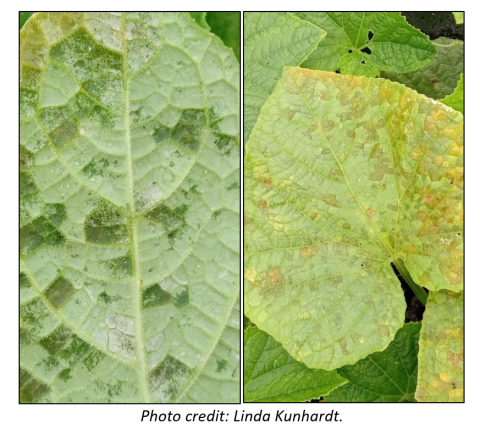
Squash vine borer numbers remain similar to the previous week, indicating the end of the 1st generation adults (Table 2). Damage from larvae may be apparent in fields now. SVB may have a second generation in mid-late August that would affect winter squash and other late varieties. They can also survive in plant residue and become a bigger issue in the future. If chemical controls are needed, try to spray at dusk and direct applications to the base of the plants. This may help reduce harm to European honeybees, but our native bees will still be at risk because they often reside in squash flowers at night.
Table 2. Squash vine borer weekly summary, 8/5/2024-8/11/2024.
|
Town |
SVB moths |
# Traps |
Avg. Moths/Trap |
|
Amherst |
5 |
1 |
5 |
|
Antrim |
0 |
1 |
0 |
|
Conway |
1 |
1 |
1 |
|
Concord |
2 |
1 |
2 |
|
Goffstown |
0 |
1 |
0 |
|
Hollis |
7 |
3 |
2 |
|
Hudson |
3 |
1 |
3 |
|
Litchfield |
0 |
2 |
0 |
|
Loudon |
0 |
1 |
0 |
|
Mason |
1 |
1 |
1 |
|
Milford |
6 |
2 |
3 |
|
New Boston |
0 |
1 |
0 |
|
New London |
1 |
1 |
1 |
|
Peterborough |
2 |
1 |
2 |
|
Totals |
25 |
16 |
1.6 |
Spotted wing drosophila (SWD) numbers are down a little from last week. We trap for SWD in Goffstown, Concord, Litchfield and Hollis, NH. Trap captures by crop can be found in Table 3 below. If you have susceptible ripening fruit, I recommend monitoring and managing for SWD, especially as blueberries continue to ripen. The hot and humid weather is ideal for SWD development. More information on monitoring for SWD can be found here.
Table 3. Male SWD trap captures, 8/5/24-8/9/24.
|
Crop |
# SWD |
# Traps |
Avg. SWD/Trap |
|
Control |
118 |
4 |
29.5 |
|
Blueberry |
4 |
4 |
1 |
|
Grape |
1 |
1 |
1 |
|
Raspberry |
31 |
7 |
4.4 |
|
Totals |
154 |
16 |
9.6 |
Check back in each week as the season progresses to see the latest trapping data. Data for additional insect pests will be updated on a weekly basis. Thank you to all the growers who participate in the program!
For any plant disease diagnostics, contact the UNH Extension Plant Diagnostic Lab to submit a sample.
Other information of note:
-Late blight has been confirmed in Aroostook County, Maine.
Upcoming Events:
- The Climate Adapted Farm: Making the effects of extreme weather less severe
Join NH Vegetable and Berry Growers Association (NHVGBA) & UNH Extension for this climate-resilience focused series. Attend one or more events to learn how your farm can adapt to better withstand the challenges of climate change, and how together we are working towards farmer-driven actionable solutions. This is a four-part series, join us for one or the full slate!
-
- August 20, 2024 | 5:30 - 7:30pm, Resilience Against Extreme Weather at Wilson Farm, Litchfield, NH. What's your plan B when disaster strikes? Explore concrete actions to prepare your farm for floods, droughts, or extreme heat and get introduced to emergency management planning.
August 21, 2024 | 5:30 - 7:30pm at Uphill Farm, Whitefield, NH
This evening discussion will be on organic no-till vegetable production. We will discuss vegetable production in northern New Hampshire, establishing and managing no-till systems, and explore pest exclusion systems for leek moth and swede midge. Uphill Farm will also highlight its efforts to transition towards precision irrigation with assistance from the Coös County Conservation District Climate Resiliency Grant.
Please sign up for our text service! Text UNHIPM to 866-645-7010 to subscribe.
Contact: Amber Vinchesi-Vahl, UNH Extension State Specialist, Entomology and IPM, Amber.Vinchesi@unh.edu
This program is made possible thought funding provided by the New Hampshire Department of Agriculture, Markets & Food Integrated Pest Management Program. This work is also supported in part by the Integrated Pest Management Crop Protection and Pest Management Extension Implementation Plan from the USDA National Institute of Food and Agriculture.
8/4/24
Hello vegetable IPM folks!
Our IPM scout, Linda, has been busy scouting for multiple pests all over the state, so be sure to scroll through to see trap captures in southern NH. Sweet corn caterpillar pests (except for ECB) have really escalated. Southern New Hampshire remains quite dry, with some drought stress observed in corn, while other parts of the state have seen excessive moisture and some flooding.
European corn borer (ECB) numbers are again very low, though we are catching some moths in Sullivan (7), Merrimack (1), and Hillsborough (3) counties. UMass has reported an uptick in ECB numbers, perhaps indicating the start of a second flight in Massachusetts. This indicates New Hampshire will not be too far behind. With whorl stage corn, larval feeding damage is characterized by tiny “shot holes” in the leaves. Eventually the larvae will bore into the developing tassel and stalks. Click HERE for more information on ECB management. We have also seen ECB infesting young sunflower stalks this year, so be aware that they can also be problematic in sunflower if you grow it.
Fall armyworm numbers have increased again, and we observed significant numbers of caterpillars feeding in southern NH. With silking corn, the trap threshold is 3+ moths per week. Be on the lookout for larval feeding damage. Larval feeding damage is characterized by large, ragged holes in leaves, and sawdust-like excrement. For northern NH, with moth numbers increasing, scout for larval feeding this week or next. We have also observed some common armyworm catches too.
Corn earworm captures have REALLY jumped up from last week and many of you are likely on a spray schedule. If you have silking corn, be sure to scout for CEW and prepare for management. Our trap threshold/spray schedule table is below and can be found in the fact sheet linked below as well, along with those for ECB and FAW. We are on a 3-day spray schedule for many locations in southern NH. For those of you further north, be aware of the increased moths potentially moving your way.
Corn earworm spray thresholds for pheromone traps
|
Moths/Week |
Moths/Night |
Spray Interval |
|
0.0 - 1.4 |
0.0 - 0.2 |
No Spray |
|
1.5 - 3.5 |
0.3 - 0.5 |
Spray every 6 days |
|
3.6 - 7.0 |
0.6 - 1.0 |
Spray every 5 days |
|
7.1 - 91 |
1.1 - 13.0 |
Spray every 4 days |
|
More than 91 |
More than 13 |
Spray every 3 days |
Western bean cutworm moth numbers have more than doubled compared to last week. See our pest alert from 2022 about western bean cutworm. WBC is native to the US corn belt and has been slowly moving east over the last decade.
Our scout observed 0-40% percent corn pest larvae this week in Hillsborough County, which increased quite a bit from last week, and was mostly due to fall armyworm (33% in some locations). Field scouting should begin once moths are captured at your farm or in your area. Information on scouting for sweet corn pests and spray thresholds can be found here. UMass suggests, “If CEW trap counts are too low to warrant a spray (below 1.4 moths/week, averaged between 2 traps), scout whorl corn for ECB and FAW and spray if 12-15% of plants are infested. A good time to apply a pesticide is when tassels have just fully emerged, to catch the caterpillars before they migrate down from the whorl and tassels into the ears”. The results of our trapping efforts for sweet corn pests are recorded by town in Table 1 below. In some cases, there are multiple traps within a town.
Table 1. Sweet corn pest weekly summary, 7/29/2024-8/4/2024.
|
Town |
# CEW moths |
# Traps |
Avg CEW/Trap |
# FAW moths |
# Traps |
Avg. FAW/Trap |
|
Amherst |
2 |
1 |
2 |
1 |
1 |
1 |
|
Antrim |
9 |
1 |
9 |
23 |
1 |
23 |
|
Conway |
9 |
1 |
9 |
0 |
1 |
0 |
|
Claremont |
9 |
1 |
9 |
15 |
1 |
15 |
|
Concord |
28 |
1 |
28 |
12 |
1 |
12 |
|
Hollis |
410 |
6 |
68.3 |
70 |
6 |
0.8 |
|
Hudson |
57 |
1 |
57 |
2 |
1 |
2 |
|
Jaffrey |
|
|
|
3 |
1 |
3 |
|
Litchfield |
45 |
2 |
22.5 |
30 |
2 |
15 |
|
Mason |
70 |
1 |
70 |
8 |
1 |
8 |
|
Meredith |
7 |
1 |
7 |
12 |
1 |
12 |
|
Milford |
23 |
2 |
11.5 |
3 |
2 |
1.5 |
|
New Boston |
34 |
2 |
17 |
10 |
2 |
5 |
|
New London |
13 |
1 |
13 |
11 |
1 |
11 |
|
Peterborough |
5 |
1 |
5 |
0 |
1 |
0 |
|
Stratham |
56 |
2 |
28 |
|
|
|
|
Weare |
26 |
2 |
13 |
8 |
2 |
4 |
|
Totals |
803 |
26 |
30.9 |
208 |
25 |
8.3 |
|
Town |
# WBC moths |
# Traps |
Avg. WBC/Trap |
|
Amherst |
9 |
1 |
9 |
|
Antrim |
12 |
1 |
12 |
|
Concord |
16 |
1 |
16 |
|
Hollis |
54 |
5 |
10.8 |
|
Hudson |
15 |
1 |
15 |
|
Jaffrey |
2 |
1 |
2 |
|
Litchfield |
32 |
2 |
16 |
|
Mason |
27 |
1 |
27 |
|
Milford |
16 |
2 |
8 |
|
New Boston |
20 |
2 |
10 |
|
Weare |
15 |
2 |
7.5 |
|
Totals |
218 |
19 |
11.5 |
Squash vine borer numbers continue to decrease, indicating the end of the 1st generation adults (Table 2). SVB may have a second generation in mid-late August that would affect winter squash and other late varieties. They can also survive in plant residue and become a bigger issue in the future. If chemical controls are needed, try to spray at dusk and direct applications to the base of the plants. This may help reduce harm to European honeybees, but our native bees will still be at risk because they often reside in squash flowers at night.
Table 2. Squash vine borer weekly summary, 7/29/2024-8/4/2024.
|
Town |
# Traps |
SVB moths |
Avg. Moths/Trap |
|
Amherst |
1 |
8 |
8 |
|
Antrim |
1 |
3 |
3 |
|
Conway |
1 |
3 |
3 |
|
Claremont |
1 |
7 |
7 |
|
Concord |
1 |
1 |
1 |
|
Goffstown |
1 |
0 |
0 |
|
Hollis |
3 |
0 |
21.3 |
|
Hudson |
1 |
3 |
3 |
|
Litchfield |
2 |
3 |
1.5 |
|
Loudon |
1 |
0 |
0 |
|
Mason |
1 |
2 |
2 |
|
Milford |
2 |
4 |
2 |
|
New Boston |
1 |
3 |
3 |
|
Totals |
17 |
37 |
2.2 |
Cucurbit downy mildew has been reported in Massachusetts. New Jersey, Pennsylvania, western and southeastern New York also reported cucurbit downy mildew. Symptoms of downy mildew include small angular yellow lesions on leaves that stay within the veins. Growers may want to include targeted fungicides in their weekly cucurbit spray programs. Cucumbers and cantaloupes are most susceptible but it may be worthwhile to apply a protectant and target sprays to all cucurbit crops. More information on CDM can be found in the NE Vegetable Management Guide and in our blog post from 2023. UMass also has more information on managing cucurbit downy mildew in a recent issue of their Veg Notes, which you can find here. CDM can also be tracked via the Cucurbit Downy Mildew Forecast Homepage: https://cdm.ipmpipe.org/, though Franklin County in Massachusetts has not yet been added to this map.
Spotted wing drosophila (SWD) numbers are up from last week. We trap for SWD in Goffstown, Concord, Litchfield and Hollis, NH. Trap captures by crop can be found in Table 3 below. If you have susceptible ripening fruit, I recommend monitoring and managing for SWD, especially as blueberries continue to ripen. The hot and humid weather is ideal for SWD development. More information on monitoring for SWD can be found here.
Table 3. Male SWD trap captures, 7/29/24-8/4/24.
|
Crop |
# SWD |
# Traps |
Avg. SWD/Trap |
|
Control |
141 |
5 |
28.2 |
|
Blueberry |
38 |
6 |
6.3 |
|
Raspberry |
20 |
6 |
3.3 |
|
Totals |
199 |
17 |
11.7 |
Check back in each week as the season progresses to see the latest trapping data. Data for additional insect pests will be updated on a weekly basis. Thank you to all the growers who participate in the program!
With the warm, wet and humid weather over the past couple of days and weeks, you may see an increase in plant diseases on your farm. For any plant disease diagnostics, contact the UNH Extension Plant Diagnostic Lab to submit a sample.
Other information of note:
-Japanese beetles and other scarab beetles have been observed in high numbers on corn this year.
-We have been observing and hearing reports of stink bugs (brown marmorated, red-shouldered, brown and green) on many crops, including sweet corn and peaches.
-Aphids on sweet corn: Pre-tassel stage sprays may be needed when 50% of the plants are infested or if 25% have heavy infestations. Sprays applied before 50% of the tassels emerge are more effective than later sprays. More information can be found in the NE Vegetable Management Guide under Insect Control for Sweet Corn.
-Birds have been causing noticeable damage to sweet corn. Linda observed damage in Litchfield, and I’ve also had reports from Stratham.
Upcoming Events:
- The Climate Adapted Farm: Making the effects of extreme weather less severe
Join NH Vegetable and Berry Growers Association (NHVGBA) & UNH Extension for this climate-resilience focused series. Attend one or more events to learn how your farm can adapt to better withstand the challenges of climate change, and how together we are working towards farmer-driven actionable solutions. This is a four-part series, join us for one or the full slate!
-
- August 20, 2024 | 5:30 - 7:30pm, Resilience Against Extreme Weather at Wilson Farm, Litchfield, NH. What's your plan B when disaster strikes? Explore concrete actions to prepare your farm for floods, droughts, or extreme heat and get introduced to emergency management planning.
August 21, 2024 | 5:30 - 7:30pm at Uphill Farm, Whitefield, NH
This evening discussion will be on organic no-till vegetable production. We will discuss vegetable production in northern New Hampshire, establishing and managing no-till systems, and explore pest exclusion systems for leek moth and swede midge. Uphill Farm will also highlight its efforts to transition towards precision irrigation with assistance from the Coös County Conservation District Climate Resiliency Grant.
Please sign up for our text service! Text UNHIPM to 866-645-7010 to subscribe.
Contact: Amber Vinchesi-Vahl, UNH Extension State Specialist, Entomology and IPM, Amber.Vinchesi@unh.edu
This program is made possible thought funding provided by the New Hampshire Department of Agriculture, Markets & Food Integrated Pest Management Program. This work is also supported in part by the Integrated Pest Management Crop Protection and Pest Management Extension Implementation Plan from the USDA National Institute of Food and Agriculture.
7/28/24
Hello vegetable IPM folks!
Our IPM scout, Linda, has been busy scouting for multiple pests all over the state, so be sure to scroll through to see trap captures in southern NH. Southern New Hampshire remains quite dry, while other parts of the state have seen excessive moisture and some flooding.
European corn borer (ECB) numbers are again very low, though we are catching some moths in Sullivan (10), Merrimack (1) and Hillsborough (1) counties. UMass has reported a slight uptick in ECB numbers, perhaps indicating the start of a second flight in Massachusetts. This indicates New Hampshire will not be too far behind. With whorl stage corn, larval feeding damage is characterized by tiny “shot holes” in the leaves. Eventually the larvae will bore into the developing tassel and stalks. Click HERE for more information on ECB management. We have also seen ECB infesting young sunflower stalks this year, so be aware that they can also be problematic in sunflower if you grow it.
Fall armyworm numbers quadrupled this week and we observed many caterpillars feeding in southern NH. With silking corn, the trap threshold is 3+ moths per week. Be on the lookout for larval feeding damage. Larval feeding damage is characterized by large, ragged holes in leaves, and sawdust-like excrement.
Corn earworm captures have increased again from last week and many of you are likely on a spray schedule. If you have silking corn, be sure to scout for CEW and prepare for management. Our trap threshold/spray schedule table is below and can be found in the fact sheet linked below as well, along with those for ECB and FAW.
Western bean cutworm moth numbers remain similar to last week, and only 1 egg mass was observed in Hollis, NH. See our pest alert from 2022 about western bean cutworm. WBC is native to the US corn belt and has been slowly moving east over the last decade. If you aren’t already controlling for CEW and FAW, it is recommended to scout for WBC egg masses and if 5-8% of corn has egg masses AND you have 95% tasseling corn, an insecticide application may be warranted.
Our scout observed 0-42% percent corn pest larvae this week in Hillsborough County, which increased quite a bit from last week, and was mostly due to fall armyworm. Field scouting should begin once moths are captured at your farm or in your area. Information on scouting for sweet corn pests and spray thresholds can be found here. UMass suggests, “If CEW trap counts are too low to warrant a spray (below 1.4 moths/week, averaged between 2 traps), scout whorl corn for ECB and FAW and spray if 12-15% of plants are infested. A good time to apply a pesticide is when tassels have just fully emerged, to catch the caterpillars before they migrate down from the whorl and tassels into the ears”. The results of our trapping efforts for sweet corn pests are recorded by town in Table 1 below. In some cases, there are multiple traps within a town.
Table 1. Sweet corn pest weekly summary, 7/22/2024-7/28/2024.
| Town | # CEW moths | # Traps | Avg. CEW/Trap | #FAW moths | # Traps | Avg. FAW/Trap |
|---|---|---|---|---|---|---|
| Amherst | 9 | 1 | 9 | 0 | 1 | 0 |
| Antrim | 8 | 1 | 8 | 2 | 1 | 2 |
| Conway | 36 | 1 | 36 | 1 | 1 | 1 |
| Claremont | 0 | 1 | 0 | 1 | 1 | 1 |
| Concord | 19 | 1 | 19 | 2 | 1 | 2 |
| Hollis | 116 | 6 | 19.3 | 61 | 6 | 0.8 |
| Hudson | 14 | 1 | 14 | 1 | 1 | 1 |
| Jaffrey | 0 | 1 | 0 | |||
| Litchfield | 18 | 2 | 9 | 10 | 2 | 0.8 |
| Mason | 30 | 1 | 30 | 1 | 1 | 1 |
| Milford | 15 | 2 | 7.5 | 6 | 2 | 3 |
| New Boston | 12 | 2 | 6 | 3 | 2 | 1.5 |
| New London | 6 | 1 | 6 | 20 | 1 | 20 |
| Peterborough | 0 | 1 | 0 | 0 | 1 | 0 |
| Stratham | 30 | 2 | 15 | |||
| Weare | 19 | 2 | 9.5 | 0 | 2 | 0 |
| Totals | 332 | 25 | 13.3 | 108 | 24 | 4.5 |
| Town | # WBC moths | # Traps | Avg. WBC/Trap |
|---|---|---|---|
| Amherst | 0 | 1 | 0 |
| Antrim | 2 | 1 | 2 |
| Concord | 6 | 1 | 6 |
| Hollis | 26 | 5 | 0.3 |
| Hudson | 0 | 1 | 0 |
| Jaffrey | 2 | 1 | 2 |
| Litchfield | 7 | 2 | 3.5 |
| Mason | 1 | 1 | 1 |
| Milford | 21 | 2 | 10.5 |
| New Boston | 11 | 2 | 5.5 |
| Weare | 7 | 2 | 3.5 |
| Totals | 83 | 19 | 0.3 |
Squash vine borer numbers are trending down, possibly indicating the end of the 1st generation adults (Table 2). SVB may have a second generation in mid-late August that would affect winter squash and other late varieties. The number of moths captured with pheromone traps can be used to decide whether an insecticide treatment is required. For bush-type summer squash and pumpkins (including giant pumpkins), the recommended threshold is 5 SVB moths per trap per week. For vining type squash or pumpkins, we suggest a threshold of 12 moths per trap per week. The difference is because vine-type cucurbits can root or tiller in at each node along the vine. This allows the plant to uptake water and nutrients from more than just the main stem. SVB tends to bore into the main stem of cucurbit plants, creating a higher risk for bush type plants. SVB tends to bore into the main stem of cucurbit plants, creating a higher risk for bush type plants. If chemical controls are needed, try to spray at dusk and direct applications to the base of the plants. This may help reduce harm to European honeybees, but our native bees will still be at risk because they often reside in squash flowers at night.
Table 2. Squash vine borer weekly summary, 7/22/2024-7/28/2024.
| Town | # Traps | SVB moths | Avg. Moths/Trap |
|---|---|---|---|
| Amherst | 1 | 10 | 10 |
| Antrim | 1 | 0 | 0 |
| Conway | 1 | 1 | 1 |
| Claremont | 1 | 2 | 2 |
| Concord | 1 | 2 | 2 |
| Exeter | 3 | 7 | 2.3 |
| Goffstown | 1 | 1 | 1 |
| Hollis | 3 | 11 | 21.3 |
| Hudson | 1 | 6 | 6 |
| Litchfield | 2 | 19 | 9.5 |
| Loudon | 1 | 2 | 2 |
| Mason | 1 | 4 | 4 |
| Milford | 2 | 10 | 5 |
| New Boston | 1 | 2 | 2 |
| Peterborough | 1 | 4 | 4 |
| Totals | 21 | 81 | 3.9 |
Cucurbit downy mildew has been reported in New Jersey, Pennsylvania, and western and southeastern New York. Symptoms of downy mildew include small angular yellow lesions on leaves that stay within the veins. More information on CDM can be found in the NE Vegetable Management Guide. CDM can also be tracked via the Cucurbit Downy Mildew Forecast Homepage: https://cdm.ipmpipe.org/.
Spotted wing drosophila (SWD) numbers are down from last week. We trap in Goffstown, Concord, Litchfield and Hollis, NH. Trap captures by crop can be found in Table 3 below. If you have susceptible ripening fruit, I recommend monitoring and managing for SWD, especially as blueberries continue to ripen. The hot and humid weather is ideal for SWD development. More information on monitoring for SWD can be found here.
Table 3. Male SWD trap captures, 7/22/24-7/28/24.
| Crop | # SWD | # Traps | Avg. SWD/Trap |
|---|---|---|---|
| Control | 105 | 4 | 26.3 |
| Blueberry | 20 | 6 | 3.3 |
| Raspberry | 8 | 6 | 1.3 |
| Totals | 133 | 16 | 12.14 |
Check back in each week as the season progresses to see the latest trapping data. Data for additional insect pests will be updated on a weekly basis. Thank you to all the growers who participate in the program!
With the warm and humid weather over the past couple of weeks, you may see an increase in plant diseases on your farm. For any plant disease diagnostics, contact the UNH Extension Plant Diagnostic Lab to submit a sample.
Other information of note:
-Deer feeding on squash, corn and legumes: 15% damage was observed by Linda while scouting sweet corn this past week. For more information on managing deer, see these resources from UMass and Cornell.
Upcoming Events:
- The Climate Adapted Farm: Making the effects of extreme weather less severe
Join NH Vegetable and Berry Growers Association (NHVGBA) & UNH Extension for this climate-resilience focused series. Attend one or more events to learn how your farm can adapt to better withstand the challenges of climate change, and how together we are working towards farmer-driven actionable solutions. This is a four-part series, join us for one or the full slate!
-
- August 20, 2024 | 5:30 - 7:30pm, Resilience Against Extreme Weather at Wilson Farm, Litchfield, NH. What's your plan B when disaster strikes? Explore concrete actions to prepare your farm for floods, droughts, or extreme heat and get introduced to emergency management planning.
August 21, 2024 | 5:30 - 7:30pm at Uphill Farm, Whitefield, NH
This evening discussion will be on organic no-till vegetable production. We will discuss vegetable production in northern New Hampshire, establishing and managing no-till systems, and explore pest exclusion systems for leek moth and swede midge. Uphill Farm will also highlight its efforts to transition towards precision irrigation with assistance from the Coös County Conservation District Climate Resiliency Grant.
Please sign up for our text service! Text UNHIPM to 866-645-7010 to subscribe.
Contact: Amber Vinchesi-Vahl, UNH Extension State Specialist, Entomology and IPM, Amber.Vinchesi@unh.edu
This program is made possible thought funding provided by the New Hampshire Department of Agriculture, Markets & Food Integrated Pest Management Program. This work is also supported in part by the Integrated Pest Management Crop Protection and Pest Management Extension Implementation Plan from the USDA National Institute of Food and Agriculture.
7/23/24
Hello vegetable IPM folks!
Our IPM scout, Linda, has been busy scouting for multiple pests all over the state, so be sure to scroll through to see trap captures in southern NH. As the season progresses, there is more and more to report!
European corn borer (ECB) numbers are almost zero again this week, except for 3 moths caught in Sullivan and 1 in Grafton counties. These numbers are likely because of the end of the first flight and control measures implemented. We can expect the 2nd flight to start anytime based on degree day calculations. Massachusetts is seeing numbers begin to climb again. Click HERE for more information on ECB management. We have also seen ECB infesting young sunflower stalks this year, so be aware that they can also be problematic in sunflower if you grow it.
Fall armyworm numbers remain similar to the previous week. We saw FAW show up earlier this year with observations of larval feeding before moths were captured in traps. With silking corn, the trap threshold is 3+ moths per week. Be on the lookout for larval feeding damage. Larval feeding damage is characterized by large, ragged holes in leaves, and sawdust-like excrement.
Corn earworm captures have significantly increased and many of you are likely on a spray schedule. If you have silking corn, be sure to scout for CEW and prepare for management. Our trap threshold/spray schedule table is below and can be found in the fact sheet linked below as well, along with those for ECB and FAW.
Western bean cutworm moth numbers are also increasing compared to last week, though less egg masses were observed. See our pest alert from 2022 about western bean cutworm. WBC is native to the US corn belt and has been slowly moving east over the last decade. If you aren’t already controlling for CEW and FAW, it is recommended to scout for WBC egg masses and if 5-8% of corn has egg masses AND you have 95% tasseling corn, an insecticide application may be warranted. Linda only found 1 egg mass in New Boston, down from last week.
Our scout observed 0-8% percent corn pest larvae this week in Hillsborough County, which decreased a little from last week, likely due to control measures. The highest damage was seen in silking and tasseling corn. Field scouting should begin once moths are captured at your farm or in your area. Information on scouting for sweet corn pests and spray thresholds can be found here. UMass suggests, “If CEW trap counts are too low to warrant a spray (below 1.4 moths/week, averaged between 2 traps), scout whorl corn for ECB and FAW and spray if 12-15% of plants are infested. A good time to apply a pesticide is when tassels have just fully emerged, to catch the caterpillars before they migrate down from the whorl and tassels into the ears”. The results of our trapping efforts for sweet corn pests are recorded by town on Table 1 below. In some cases, there are multiple traps within a town.
Table 1. Sweet corn pest weekly summary, 7/15/2024-7/21/2024.
| Town | # CEW moths | # FAW moths | # WBC moths |
|---|---|---|---|
| Amherst | 1 | 0 | 0 |
| Antrim | 9 | 4 | 2 |
| Claremont | 0 | 0 | |
| Concord | 17 | 0 | 18 |
| Hollis | 81 | 4 | 5 |
| Hudson | 20 | 0 | 1 |
| Litchfield | 4 | 4 | 4 |
| Mason | 30 | 2 | 6 |
| Milford | 3 | 0 | 18 |
| New Boston | 21 | 4 | 26 |
| New London | 7 | 5 | |
| Peterborough | 2 | 0 | |
| Plymouth | 7 | 11 | |
| Stratham | 9 | ||
| Weare | 11 | 3 | 4 |
| Totals | 222 | 37 | 84 |
Squash vine borer numbers continue to remain high (Table 2). The number of moths captured with pheromone traps can be used to decide whether or not an insecticide treatment is required. For bush-type summer squash and pumpkins (including giant pumpkins), the recommended threshold is 5 SVB moths per trap per week. For vining type squash or pumpkins, we suggest a threshold of 12 moths per trap per week. The difference is because vine-type cucurbits can root or tiller in at each node along the vine. This allows the plant to uptake water and nutrients from more than just the main stem. SVB tends to bore into the main stem of cucurbit plants, creating a higher risk for bush type plants.
Table 2. Squash vine borer weekly summary, 7/15/2024-7/21/2024.
| Town | # Traps | SVB moths | Avg. moths |
|---|---|---|---|
| Amherst | 1 | 20 | 20 |
| Antrim | 1 | 15 | 15 |
| Claremont | 1 | 2 | 2 |
| Concord | 1 | 9 | 9 |
| Goffstown | 1 | 1 | 1 |
| Hollis | 3 | 32 |
21.3 |
| Hudson | 1 | 20 | 20 |
| Litchfield | 2 | 48 | 24 |
| Loudon | 1 | 13 | 13 |
| Mason | 1 | 8 | 8 |
| Milford | 2 | 21 | 10.5 |
| New Boston | 1 | 16 | 16 |
| New London | 1 | 7 | 7 |
| Peterborough | 1 | 36 | 36 |
| Totals | 18 | 248 | 18.7 |
Cucurbit downy mildew has been reported in New Jersey, Pennsylvania, and Western New York. Symptoms of downy mildew include small angular yellow lesions on leaves that stay within the veins. More information on CDM can be found in the NE Vegetable Management Guide. CDM can also be tracked via the Cucurbit Downy Mildew Forecast Homepage: https://cdm.ipmpipe.org/.
Spotted wing drosophila (SWD) numbers remain high. We trap in Goffstown, Concord, Litchfield and Hollis, NH. We counted 100 in one of our control traps in Concord. NH. Trap captures by crop can be found in Table 3 below. If you have susceptible ripening fruit, I recommend monitoring and managing for SWD, especially as blueberries continue to ripen. The hot and humid weather is ideal for SWD development. More information on monitoring for SWD can be found here.
Table 3. Male SWD trap captures, 7/15/24-7/21/24.
| Crop | # SWD | # Traps | Avg. SWD/Trap |
|---|---|---|---|
| Control | 226 | 6 | 37.7 |
| Blueberry | 21 | 8 | 2.6 |
| Raspberry | 8 | 7 | 1.1 |
| Totals | 255 | 21 | 12.14 |
Check back in each week as the season progresses to see the latest trapping data. Data for additional insect pests will be updated on a weekly basis. Thank you to all the growers who participate in the program!
With the warm and humid weather over the past couple of weeks, you may see an increase in plant diseases on your farm. For any plant disease diagnostics, contact the UNH Extension Plant Diagnostic Lab to submit a sample.
Other information of note:
- Pepper maggot damage was seen in southern NH. Oviposition scars show up as sunken pinpricks in pepper fruit (see photo below). The scars are especially noticeable on cherry peppers (a preferred host), which can be used as indicator plants in outer rows to time insecticide sprays targeting adult flies. Pepper maggot pressure is variable by location, where some farms never have issues and others deal with it each year. More information can be found in the Pepper section of the New England Vegetable Management Guide. Last week’s issue of UMass Vegetable Notes also has more information on pepper maggot if you scroll down.
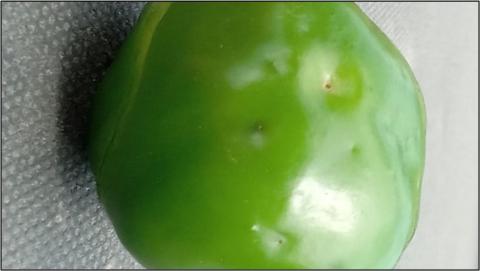
Pepper maggot oviposition scars on pepper fruit. Photo credit: Linda Kunhardt.
- Colorado potato beetle continues feeding damage on potato, tomato and eggplants in the field and in high tunnels.
- Brown marmorated stink bug egg masses and nymphs have been observed in higher numbers this past week.
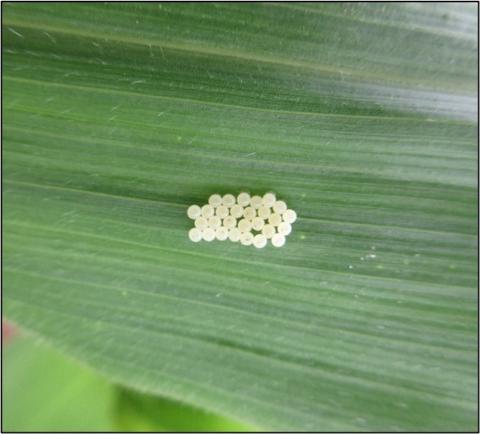
BMSB egg mass on corn. Photo credit: Linda Kunhardt.
- Tomato hornworms reported on both tomatoes and peppers in high tunnels.
- Stalk borer confirmed in sweet corn in southern NH and in tomato in northern NH last week.
- Japanese beetles on sweet corn. If you have very heavy pressure and they are feeding on silks, they should be controlled by sprays targeting CEW and ECB.
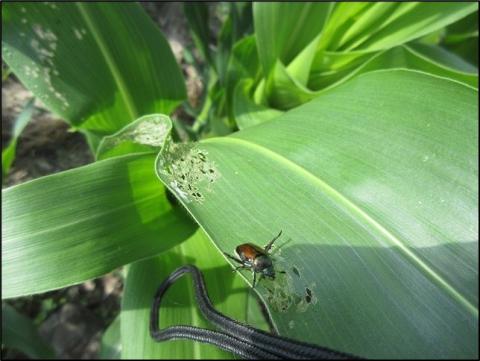
Upcoming Events:
- The Climate Adapted Farm: Making the effects of extreme weather less severe
Join NH Vegetable and Berry Growers Association (NHVGBA) & UNH Extension for this climate-resilience focused series. Attend one or more events to learn how your farm can adapt to better withstand the challenges of climate change, and how together we are working towards farmer-driven actionable solutions. This is a four-part series, join us for one or the full slate!
-
- August 20, 2024 | 5:30 - 7:30pm, Resilience Against Extreme Weather at Wilson Farm, Litchfield, NH. What's your plan B when disaster strikes? Explore concrete actions to prepare your farm for floods, droughts, or extreme heat and get introduced to emergency management planning.
August 21, 2024 | 5:30 - 7:30pm at Uphill Farm, Whitefield, NH
This evening discussion will be on organic no-till vegetable production. We will discuss vegetable production in northern New Hampshire, establishing and managing no-till systems, and explore pest exclusion systems for leek moth and swede midge. Uphill Farm will also highlight its efforts to transition towards precision irrigation with assistance from the Coös County Conservation District Climate Resiliency Grant.
Please sign up for our text service! Text UNHIPM to 866-645-7010 to subscribe.
Contact: Amber Vinchesi-Vahl, UNH Extension State Specialist, Entomology and IPM, Amber.Vinchesi@unh.edu
This program is made possible thought funding provided by the New Hampshire Department of Agriculture, Markets & Food Integrated Pest Management Program. This work is also supported in part by the Integrated Pest Management Crop Protection and Pest Management Extension Implementation Plan from the USDA National Institute of Food and Agriculture.
7/14/24
Hello vegetable IPM folks!
Our IPM scout, Linda, has been busy scouting for multiple pests all over the state, so be sure to scroll through to see trap captures in southern NH. As the season progresses, there is more and more to report!
European corn borer (ECB) numbers are almost zero, except for 2 moths caught in Sullivan County last week. These numbers are likely because of the end of the first flight and control measures implemented. We can expect the 2nd flight to start anytime based on degree day calculations. Click HERE for more information on ECB management. We have also seen ECB infesting young sunflower stalks this year, so be aware that they can also be problematic in sunflower if you grow it.
We are already above threshold in traps for fall armyworm in specific areas of Hillsborough County and numbers remain similar to the previous week. We saw FAW show up earlier this year with observations of larval feeding before moths were captured in traps. With silking corn, the trap threshold is 3+ moths per week. Be on the lookout for larval feeding damage. Larval feeding damage is characterized by large, ragged holes in leaves, and sawdust-like excrement.
Corn earworm captures are increasing and many of you are likely on a spray schedule. If you have silking corn, be sure to scout for CEW and prepare for management. Our trap threshold/spray schedule table is below and can be found in the fact sheet linked below as well, along with those for ECB and FAW.
Western bean cutworm numbers are climbing after our first captures in late June. See our pest alert from 2022 about western bean cutworm. WBC is native to the US corn belt and has been slowly moving east over the last decade. If you aren’t already controlling for CEW and FAW, it is recommended to scout for WBC egg masses and if 5-8% of corn has egg masses AND you have 95% tasseling corn, an insecticide application may be warranted. Linda found 5 egg masses in Concord and 1 in Weare this past week.
Our scout observed 0-12% percent corn pest larvae this week in Hillsborough County, which decreased from last week, likely due to control measures. The highest damage was seen in silking and tasseling corn. Field scouting should begin once moths are captured at your farm or in your area. Information on scouting for sweet corn pests and spray thresholds can be found here. The results of our trapping efforts for sweet corn pests are recorded by town on Table 1 below. In some cases, there are multiple traps within a town.
Table 1. Sweet corn pest weekly summary, 7/8/2024-7/14/2024.
| Town | # CEW moths | # FAW moths | # WBC moths |
|---|---|---|---|
| Amherst | 2 | 1 | 1 |
| Antrim | 3 | 1 | 0 |
| Conway | 0 | 0 | |
| Claremont | 3 | 0 | |
| Concord | 0 | 0 | 0 |
| Hollis | 19 | 1 | 3 |
| Hudson | 1 | 1 | 0 |
| Litchfield | 12 | 2 | 1 |
| Mason | 11 | 0 | 1 |
| Meredith | 0 | 2 | |
| Milford | 2 | 0 | 2 |
| New Boston | 2 | 0 | 2 |
| New London | 5 | 1 | |
| Peterborough | 0 | 0 | |
| Rollinsford | 3 | 0 | |
| Stratham | 3 | ||
| Weare | 2 | 0 | 1 |
| Totals | 68 | 9 | 11 |
Our scout also found stalk borer this week. This is an occasional pest of corn and other vegetables. It overwinters as an egg in grassy weeds. Caterpillars hatch in the spring and feed within grasses before they grow too big and then migrate to plants with thicker stems. For corn, infestations are usually worse in border rows and fields with grassy weeds. The borers feed in the stalk or deep in the whorl. Their feeding may kill growing tips. Reduced tillage fields may have increased levels of stalk borer because of higher weed pressure. Management includes eliminating grassy weeds to reduce overwintering eggs and reduce migrating borers at field edges. Stalk borer caterpillars and their damage can be seen in the photos below.
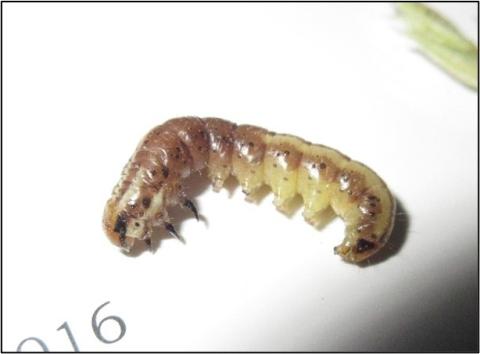
Photo: Stalk borer larva. Credit: Linda Kunhardt.
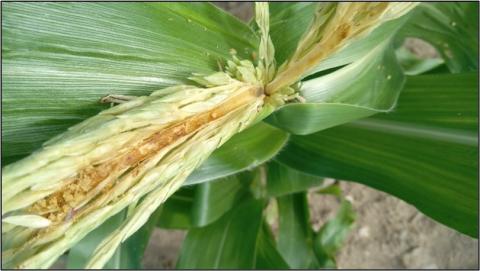
Photo: Damage to sweet corn. Credit: Linda Kunhardt.
Squash vine borer numbers continue to remain high (Table 2). The number of moths captured with pheromone traps can be used to decide whether or not an insecticide treatment is required. For bush-type summer squash and pumpkins (including giant pumpkins), the recommended threshold is 5 SVB moths per trap per week. For vining type squash or pumpkins, we suggest a threshold of 12 moths per trap per week. The difference is because vine-type cucurbits can root or tiller in at each node along the vine. This allows the plant to uptake water and nutrients from more than just the main stem. SVB tends to bore into the main stem of cucurbit plants, creating a higher risk for bush type plants.
Table 2. Squash vine borer weekly summary, 7/8/2024-7/14/2024.
| Town | # Traps | SVB moths | Avg. moths |
|---|---|---|---|
| Amherst | 1 | 65 | 65 |
| Antrim | 1 | 13 | 13 |
| Conway | 1 | 12 | 12 |
| Claremont | 1 | 5 | 5 |
| Concord | 1 | 25 | 25 |
| Exeter | 3 | 20 | 1.67 |
| Goffstown | 1 | 0 | 0 |
| Hollis | 3 | 50 |
21.3 |
| Hudson | 1 | 11 | 11 |
| Litchfield | 2 | 60 | 30 |
| Loudon | 1 | 7 | 7 |
| Mason | 1 | 12 | 12 |
| Milford | 2 | 36 | 18 |
| New Boston | 1 | 35 | 35 |
| Peterborough | 1 | 42 | 42 |
| Totals | 21 | 393 | 18.7 |
Cucurbit downy mildew has been reported in New Jersey and Western New York. Symptoms of downy mildew include small angular yellow lesions on leaves that stay within the veins. More information on CDM can be found in the NE Vegetable Management Guide. CDM can also be tracked via the Cucurbit Downy Mildew Forecast Homepage: https://cdm.ipmpipe.org/.
Spotted wing drosophila (SWD) numbers remain high. We trap in Goffstown, Concord, Litchfield and Hollis, NH. We counted more than 150 in one of our control traps in Concord. NH. Trap captures by crop can be found in Table 3 below. If you have susceptible ripening fruit, I recommend monitoring and managing for SWD, especially as blueberries continue to ripen. The hot and humid weather is ideal for SWD development. More information on monitoring for SWD can be found here.
Table 3. Male SWD trap captures, 7/8/24-7/14/24.
| Crop | # SWD | # Traps | Avg. SWD/Trap |
|---|---|---|---|
| Control | 183 | 6 | 16.2 |
| Blueberry | 45 | 8 | 5.6 |
| Strawberry | 0 | 2 | 0 |
| Raspberry | 11 | 7 | 5.1 |
| Cherry | 0 | 1 | 0 |
| Grape | 0 | 1 | 0 |
| Totals | 239 | 25 | 9.56 |
Check back in each week as the season progresses to see the latest trapping data. Data for additional insect pests will be updated on a weekly basis. Thank you to all the growers who participate in the program!
With the warm and humid weather over the past couple of weeks, you may see an increase in plant diseases on your farm. For any plant disease diagnostics, contact the UNH Extension Plant Diagnostic Lab to submit a sample.
Other information of note:
- Broad mites observed in peppers. This UNH Extension blog post from a few years ago has information and resources for management. Also, you can check the New England Vegetable Management Guide for up-to-date chemical controls on peppers and on transplants.
- Potato leafhopper numbers have been high in orchards and surrounding crops. PLH feeding causes ‘hopperburn’, with leaves yellowing, browning and dying. Nymphs are a very bright green. More information can be found here, and in the potato section of the NE Vegetable Management Guide.
- Squash bugs are out and about. The most recent vegetable newsletter from UMass has a very comprehensive overview of squash bug biology and control if you scroll down.
Upcoming Events:
- The Climate Adapted Farm: Making the effects of extreme weather less severe
Join NH Vegetable and Berry Growers Association (NHVGBA) & UNH Extension for this climate-resilience focused series. Attend one or more events to learn how your farm can adapt to better withstand the challenges of climate change, and how together we are working towards farmer-driven actionable solutions. This is a four-part series, join us for one or the full slate!- TODAY! July 16, 2024 | 5:30 - 7:30pm, Physically Protecting Your Crops at Spring Ledge Farm, New London, NH. Discover strategies for efficiency improvements and technology add-ons when growing crops in controlled environments like high and low tunnels, and netted structures. We will cover how to mitigate damage from extreme heat and wind.
- August 20, 2024 | 5:30 - 7:30pm, Resilience Against Extreme Weather at Wilson Farm, Litchfield, NH. What's your plan B when disaster strikes? Explore concrete actions to prepare your farm for floods, droughts, or extreme heat and get introduced to emergency management planning.
-
Organic No-till Vegetable Production and Protected Agriculture
August 21, 2024 | 5:30 - 7:30pm at Uphill Farm, Whitefield, NH
This evening discussion will be on organic no-till vegetable production. We will discuss vegetable production in northern New Hampshire, establishing and managing no-till systems, and explore pest exclusion systems for leek moth and swede midge. Uphill Farm will also highlight its efforts to transition towards precision irrigation with assistance from the Coös County Conservation District Climate Resiliency Grant.
Please sign up for our text service! Text UNHIPM to 866-645-7010 to subscribe.
Contact: Amber Vinchesi-Vahl, UNH Extension State Specialist, Entomology and IPM, Amber.Vinchesi@unh.edu
This program is made possible thought funding provided by the New Hampshire Department of Agriculture, Markets & Food Integrated Pest Management Program. This work is also supported in part by the Integrated Pest Management Crop Protection and Pest Management Extension Implementation Plan from the USDA National Institute of Food and Agriculture.
7/5/24
Hello vegetable IPM folks! I hope everyone had a great 4th of July!
Our IPM scout, Linda, has been busy scouting for multiple pests all over the state, so be sure to scroll through to see trap captures in southern NH. Crop development and pest activity seems to be about a week early this year (or more for some pests!), so be alert for pest presence and damage earlier than expected, especially compared to last season.
European corn borer (ECB) numbers have decreased significantly, likely because of insecticide sprays targeting this pest. If you have corn that is in or approaching mid whorl stage, consider scouting for damage. Click HERE for more information on ECB management. We have also seen ECB infesting young sunflower stalks this year, so be aware that they can also be problematic in sunflower if you grow it.
We are already above threshold in traps for fall armyworm in specific areas of Hillsborough County and saw it show up earlier this year with observations of larval feeding before moths were captured in traps. With silking corn, the trap threshold is 3+ moths per week. Be on the lookout for larval feeding damage. Larval feeding damage is characterized by large, ragged holes in leaves, and sawdust-like excrement.
Corn earworm captures are increasing and many of you are likely on a spray schedule. If you have silking corn, be sure to scout for CEW and prepare for management. Our trap threshold/spray schedule table is below and can be found in the fact sheet linked below as well, along with those for ECB and FAW.
Table 1: Corn Earworm Spray Thresholds for Pheromone Traps
| Moths/Week | Moths/Night | Spray Interval |
|---|---|---|
| 0.0 - 1.4 | 0.0 - 0.2 | No Spray |
| 1.5 - 3.5 | 0.3 - 0.5 | Spray every 6 days |
| 3.6 - 7.0 | 0.6 - 1.0 | Spray every 5 days |
| 7.1 - 91 | 1.1 - 13.0 | Spray every 4 days |
| More than 91 | More than 13 | Spray every 3 days |
Western bean cutworm numbers remain low after our first captures in late June. See our pest alert from 2022 about western bean cutworm. WBC is native to the US corn belt and has been slowly moving east over the last decade.
Our scout observed 0-10% percent corn pest larvae this week in Hillsborough County, which decreased from last week, likely due to control measures. The highest damage was seen in silking and tasseling corn. Field scouting should begin once moths are captured at your farm or in your area. Information on scouting for sweet corn pests and spray thresholds can be found here. The results of our trapping efforts for sweet corn pests are recorded by town on Table 1 below. In some cases, there are multiple traps within a town.
Table 1. Sweet corn pest weekly summary, 7/1/2024-7/7/2024.
| Town | # ECB Moths | # Traps | Avg. ECB/Trap | # CEW moths | # Traps | Avg. CEW/Trap |
|---|---|---|---|---|---|---|
| Amherst | 5 | 1 | 5 | |||
| Antrim | 0 | 2 | 0 | 0 | 1 | 0 |
| Conway | 0 | 2 | 0 | 0 | 1 | 0 |
| Claremont | 2 | 2 | 1 | 6 | 1 | 6 |
| Concord | 0 | 2 | 0 | 0 | 1 | 0 |
| Hollis | 1 | 10 | 0.1 | 35 | 6 | 5.8 |
| Hudson | 0 | 2 | 0 | 0 | 1 | 0 |
| Litchfield | 1 | 4 | 0.25 | 6 | 2 | 3 |
| Mason | 0 | 2 | 0 | 0 | 1 | 0 |
| Meredith | 0 | 2 | 0 | 2 | 1 | 2 |
| Milford | 0 | 4 | 0 | 1 | 3 | 0.3 |
| New Boston | 0 | 4 | 0 | 3 | 2 | 1.5 |
| New London | 0 | 2 | 0 | 2 | 1 | 2 |
| Peterborough | 0 | 2 | 0 | 0 | 1 | 0 |
| Rollinsford | 0 | 2 | 0 | 7 | 1 |
7 |
| Stratham | 2 | 1 | 2 | |||
| Weare | 0 | 4 | 0 | 0 | 2 | 0 |
| Totals | 4 | 46 | 0.09 | 69 | 27 | 2.56 |
| Town | # FAW moths | # Traps | Avg. FAW/Trap | # WBC moths | # Traps | Avg. WBC/Trap |
|---|---|---|---|---|---|---|
| Amherst | 0 | 1 | 0 | 0 | 1 | 0 |
| Antrim | 1 | 1 | 1 | 1 | 1 | 1 |
| Conway | 0 | 1 | 0 | |||
| Claremont | 0 | 1 | 0 | |||
| Concord | 0 | 1 | 0 | 0 | 1 | 0 |
| Hollis | 5 | 6 | 0.83 | 2 | 6 | 0.3 |
| Hudson | 0 | 1 | 0 | 0 | 1 | 0 |
| Litchfield | 1 | 2 | 0.5 | 0 | 2 | 0 |
| Mason | 0 | 1 | 0 | 1 | 1 | 1 |
| Meredith | 0 | 1 | 0 | |||
| Milford | 0 | 2 | 0 | 1 | 2 | 0.5 |
| New Boston | 1 | 2 | 0.5 | 0 | 2 | 0 |
| New London | 0 | 1 | 0 | |||
| Peterborough | 0 | 1 | 0 | |||
| Rollinsford | 0 | 1 | 0 | |||
| Weare | 0 | 2 | 0 | 0 | 2 | 0 |
| Totals | 8 | 25 | 0.32 | 5 | 19 | 0.26 |
Squash vine borer numbers continue to rise and remain high (Table 2). The number of moths captured with pheromone traps can be used to decide whether or not an insecticide treatment is required. For bush-type summer squash and pumpkins (including giant pumpkins), the recommended threshold is 5 SVB moths per trap per week. For vining type squash or pumpkins, we suggest a threshold of 12 moths per trap per week. The difference is because vine-type cucurbits can root or tiller in at each node along the vine. This allows the plant to uptake water and nutrients from more than just the main stem. SVB tends to bore into the main stem of cucurbit plants, creating a higher risk for bush type plants.
Table 2. Squash vine borer weekly summary, 7/1/2024-7/7/2024.
| Town | # Traps | SVB moths | Avg. moths |
|---|---|---|---|
| Amherst | 1 | 55 | 55 |
| Antrim | 1 | 14 | 14 |
| Conway | 1 | 11 | 11 |
| Claremont | 1 | 2 | 2 |
| Concord | 1 | 17 | 17 |
| Exeter | 3 | 5 | 1.67 |
| Goffstown | 1 | 1 | 1 |
| Hollis | 3 | 64 | 21.3 |
| Hudson | 1 | 15 | 15 |
| Litchfield | 2 | 40 | 20 |
| Loudon | 1 | 4 | 4 |
| Mason | 1 | 17 | 17 |
| Milford | 2 | 41 | 20.5 |
| New Boston | 1 | 16 | 16 |
| New London | 1 | 2 | 2 |
| Peterborough | 1 | 17 | 17 |
| Totals | 22 | 321 | 14.6 |
Spotted wing drosophila (SWD) numbers have more than doubled from last week. We trap in Goffstown, Concord, Litchfield and Hollis, NH. Trap numbers by crop can be found in Table 3 below. If you have susceptible ripening fruit, I recommend monitoring for SWD, especially as blueberries continue to ripen. The hot and humid weather is ideal for SWD development. More information on monitoring for SWD can be found here.
Table 3. Male SWD trap captures, 7/1/24-7/7/24.
| Crop | # SWD | # Traps | Avg. SWD/Trap |
|---|---|---|---|
| Control | 97 | 6 | 16.2 |
| Blueberry | 72 | 8 | 9 |
| Strawberry | 0 | 2 | 0 |
| Raspberry | 36 | 7 | 5.1 |
| Cherry | 5 | 1 | 5 |
| Grape | 0 | 1 | 0 |
| Totals | 210 | 25 | 8.4 |
Check back in each week as the season progresses to see the latest trapping data. Data for additional insect pests will be updated on a weekly basis. Thank you to all the growers who participate in the program!
Other information of note:
- Broad mites observed in peppers. This UNH Extension blog post from a few years ago has information and resources for management. Also, you can check the New England Vegetable Management Guide for up-to-date chemical controls.
Upcoming Events:
- The Climate Adapted Farm: Making the effects of extreme weather less severe
Join NH Vegetable and Berry Growers Association (NHVGBA) & UNH Extension for this climate-resilience focused series. Attend one or more events to learn how your farm can adapt to better withstand the challenges of climate change, and how together we are working towards farmer-driven actionable solutions. This is a four-part series, join us for one or the full slate!- July 16, 2024 | 5:30 - 7:30pm, Physically Protecting Your Crops at Spring Ledge Farm, New London, NH. Discover strategies for efficiency improvements and technology add-ons when growing crops in controlled environments like high and low tunnels, and netted structures. We will cover how to mitigate damage from extreme heat and wind.
- August 20, 2024 | 5:30 - 7:30pm, Resilience Against Extreme Weather at Wilson Farm, Litchfield, NH. What's your plan B when disaster strikes? Explore concrete actions to prepare your farm for floods, droughts, or extreme heat and get introduced to emergency management planning.
- Organic No-till Vegetable Production and Protected Agriculture
August 21, 2024 | 5:30 - 7:30pm at Uphill Farm, Whitefield, NH
This evening discussion will be on organic no-till vegetable production. We will discuss vegetable production in northern New Hampshire, establishing and managing no-till systems, and explore pest exclusion systems for leek moth and swede midge. Uphill Farm will also highlight its efforts to transition towards precision irrigation with assistance from the Coös County Conservation District Climate Resiliency Grant.
Please sign up for our new text service!
Sign Up For: UNH IPM Text Updates
BY SIGNING UP YOU WILL RECEIVE:
- One text per week directing you to the latest fruit and vegetable IPM reports from UNH Extension during the season
- Timely Pest alerts (i.e., first seasonal SWD trap captures, first confirmed downy mildew samples)
- Occasional event reminders for twilight meetings and other educational opportunities
TO SIGN UP:
Text UNHIPM to 866-645-7010
OR
Scan the QR code
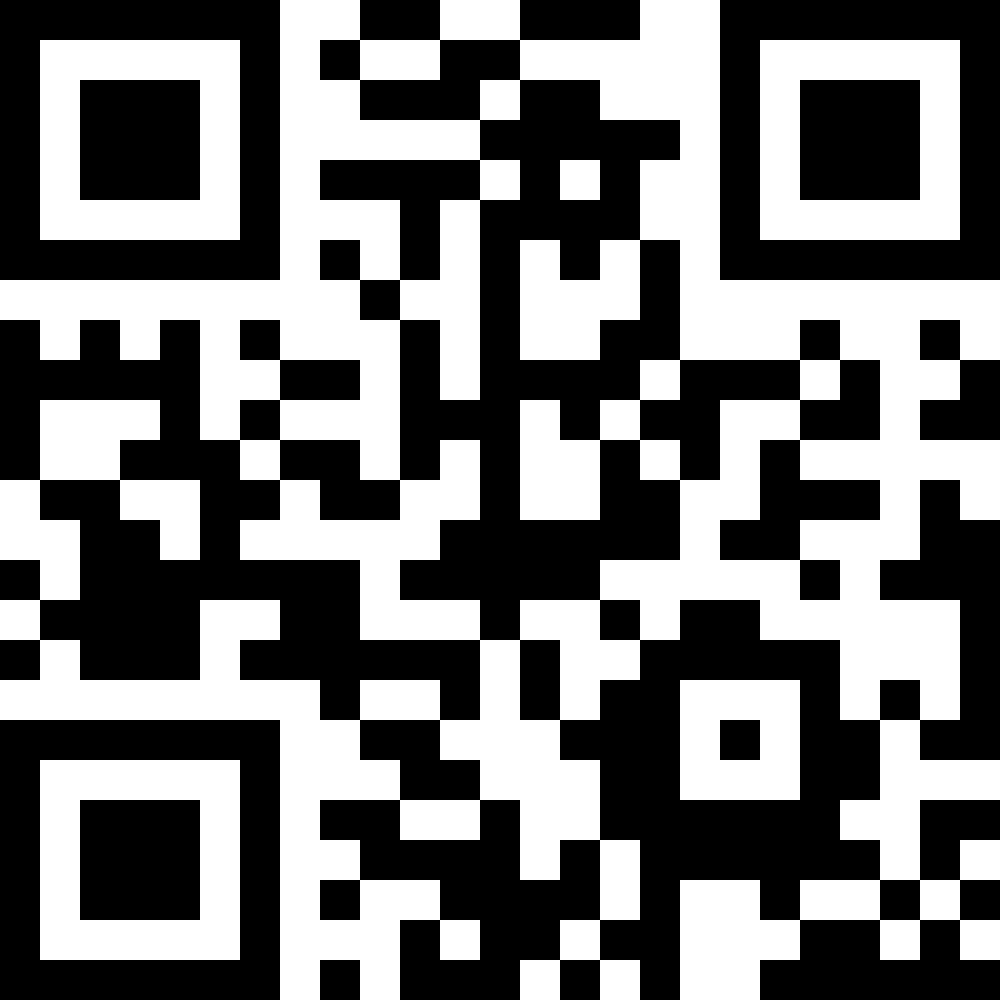
Contact: Amber Vinchesi-Vahl, UNH Extension State Specialist, Entomology and IPM, Amber.Vinchesi@unh.edu
This program is made possible thought funding provided by the New Hampshire Department of Agriculture, Markets & Food Integrated Pest Management Program. This work is also supported in part by the Integrated Pest Management Crop Protection and Pest Management Extension Implementation Plan from the USDA National Institute of Food and Agriculture.
6/28/24
Hello vegetable IPM folks!
Pest numbers are really ramping up! Our IPM scout, Linda, has been busy scouting for multiple pests all over the state, so be sure to scroll through to see trap captures in southern NH. Crop development and pest activity seems to be about a week early this year (or more for some pests!), so be alert for pest presence and damage earlier than expected, especially compared to last season.
European corn borer (ECB) numbers are decreasing, likely because of insecticide sprays targeting this pest. If you have early corn that is in or approaching mid whorl stage, consider scouting for damage. The results of our trapping efforts are recorded by town on Table 1 below. In some cases, there are multiple traps within a town. Click HERE for more information on ECB management.
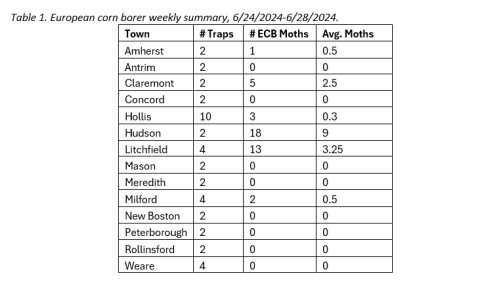
As a reminder, we found a fall armyworm caterpillar feeding on corn in Hollis, NH two weeks ago, and I’ve heard reports of another FAW caterpillar feeding on field corn this week in the Pembroke area. We also have 2 adult catches recorded in Claremont, NH. This is much earlier than we usually see FAW, so be on the lookout for larval feeding damage. You could also be seeing true armyworm feeding, which is very similar to FAW. Larval feeding damage is characterized by large, ragged holes in leaves, and sawdust-like excrement.
First captures of corn earworm and western bean cutworm were recorded this week. We recorded 21 CEW in Hollis, NH, and 10 in Rollinsford, NH. If you have silking corn, be sure to scout for CEW and prepare for management. We caught 1 WBC adult in Mason, NH and a WBC caterpillar was observed in Rollinsford, NH. See our pest alert from 2022 about western bean cutworm. WBC is native to the US corn belt and has been slowly moving east over the last decade.
Our scout recorded feeding damage from corn pests this week that ranged from 0-48% in Hillsborough County, which is increasing from last week as the season progresses. The highest damage was seen in silking and tasseling corn. Field scouting should begin once moths are captured at your farm or in your area. Information on scouting for sweet corn pests and spray thresholds can be found here.
We trapped almost 8x as many squash vine borer adults this week compared to last week (Table 2). The number of moths captured with pheromone traps can be used to decide whether or not an insecticide treatment is required. For bush-type summer squash and pumpkins (including giant pumpkins), the recommended threshold is 5 SVB moths per trap per week. For vining type squash or pumpkins, we suggest a threshold of 12 moths per trap per week. The difference is because vine-type cucurbits can root or tiller in at each node along the vine. This allows the plant to uptake water and nutrients from more than just the main stem. SVB tends to bore into the main stem of cucurbit plants, creating a higher risk for bush type plants.
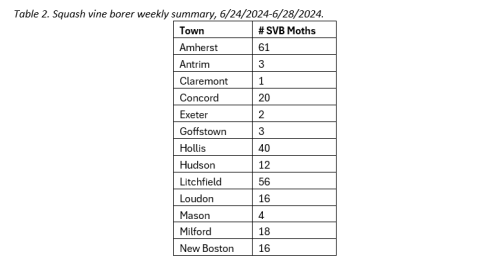
Spotted wing drosophila (SWD) numbers have significantly increased (6x more than last week). This is likely due to the combination of heat and moisture we had last week. We trap in Goffstown, Concord, Litchfield and Hollis, NH. Trap numbers can be found in Table 3 below. If you have susceptible ripening fruit, I recommend monitoring for SWD, especially as blueberries continue to ripen. More information on monitoring for SWD can be found here.
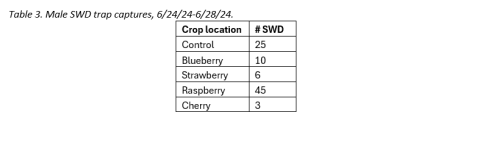
Check back in each week as the season progresses to see the latest trapping data. Data for additional insect pests will be updated on a weekly basis. Thank you to all the growers who participate in the program!
Other information of note:
- Onion thrips cause streaking and stippling patterns on onions and other allium crops from their feeding. More information can be found here.
- Sap beetle feeding was reported on tasseling sweet corn in southern NH. For more information, see the Sweet Corn insect section of the New England Vegetable Management Guide.
- Striped cucumber beetles are out and about and can transmit bacterial wilt in addition to feeding on foliage, flowers and fruit of cucurbits. See this UNH fact sheet for more information.
- Japanese beetles were reported feeding heavily on lettuce, impacting the washing process.
- Leek moth damage continues to show up in northern NH.
An announcement for organic high tunnel growers from Dr. Becky Sideman at UNH...
"High Tunnel Cover Cropping Project – Participants Wanted!
If you are growing organic vegetables in a high tunnel, we want to connect with you! The University of Minnesota and University of New Hampshire are partnering to conduct on-farm research about the performance of legume cover crops in organic high tunnel vegetable rotations in the Midwest and Northeast regions. The goal of this project is to enable organic high tunnel growers to reduce their dependence on purchased composts and manures by using nitrogen-fixing legume cover crops to support soil fertility, productivity, and sustainability.
We are currently recruiting organic high tunnel growers to receive cover crop seed and participate in the on-farm research trials, which will begin in fall 2024 for overwinter cover crops and spring 2025 for spring/summer covers. We have two levels of participation available, so you can choose the level of commitment that works for you.
Join us for an information session on Tuesday, July 30th at 6:30pm CDT on Zoom. During the webinar, you’ll learn more about participating in the trial and have opportunities to ask questions. You can also view a recording of our previous information session at this link.
Sign up to learn more about the trial at z.umn.edu/hightunnelcovercroptrial. We will send the webinar link and a calendar invitation to everyone who signs up. Hope to see you there!
Becky Sideman (UNH – becky.sideman@unh.edu)."
Upcoming Events:
- The Climate Adapted Farm: Making the effects of extreme weather less severe
Join NH Vegetable and Berry Growers Association (NHVGBA) & UNH Extension for this climate-resilience focused series. Attend one or more events to learn how your farm can adapt to better withstand the challenges of climate change, and how together we are working towards farmer-driven actionable solutions. This is a four-part series, join us for one or the full slate!
-
- July 16, 2024 | 5:30 - 7:30pm, Physically Protecting Your Crops at Spring Ledge Farm, New London, NH. Discover strategies for efficiency improvements and technology add-ons when growing crops in controlled environments like high and low tunnels, and netted structures. We will cover how to mitigate damage from extreme heat and wind.
- August 20, 2024 | 5:30 - 7:30pm, Resilience Against Extreme Weather at Wilson Farm, Litchfield, NH. What's your plan B when disaster strikes? Explore concrete actions to prepare your farm for floods, droughts, or extreme heat and get introduced to emergency management planning.
August 21, 2024 | 5:30 - 7:30pm at Uphill Farm, Whitefield, NH
This evening discussion will be on organic no-till vegetable production. We will discuss vegetable production in northern New Hampshire, establishing and managing no-till systems, and explore pest exclusion systems for leek moth and swede midge. Uphill Farm will also highlight its efforts to transition towards precision irrigation with assistance from the Coös County Conservation District Climate Resiliency Grant.
Please sign up for our new text service!
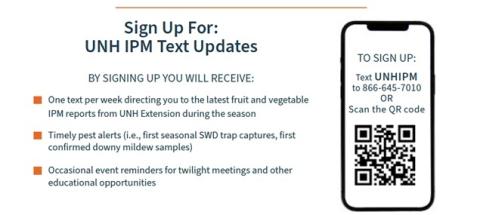
Contact: Amber Vinchesi-Vahl, UNH Extension State Specialist, Entomology and IPM, Amber.Vinchesi@unh.edu
This program is made possible thought funding provided by the New Hampshire Department of Agriculture, Markets & Food Integrated Pest Management Program. This work is also supported in part by the Integrated Pest Management Crop Protection and Pest Management Extension Implementation Plan from the USDA National Institute of Food and Agriculture.
6/21/24
Hello vegetable IPM folks!
Our IPM scout, Linda, has been busy scouting for multiple pests all over the state, so be sure to scroll through to see trap captures in southern NH. Crop development and pest activity seems to be about a week early this year (or more for some pests!), so be alert for pest presence and damage earlier than expected, especially compared to last season.
ECB numbers are increasing in some areas and decreasing in others, likely because of insecticide sprays targeting this pest. If you have early corn that is in or approaching mid whorl stage, consider scouting for damage. The results of our trapping efforts are recorded by town on Table 1 below. In some cases, there are multiple traps within a town. Click HERE for more information on ECB management.
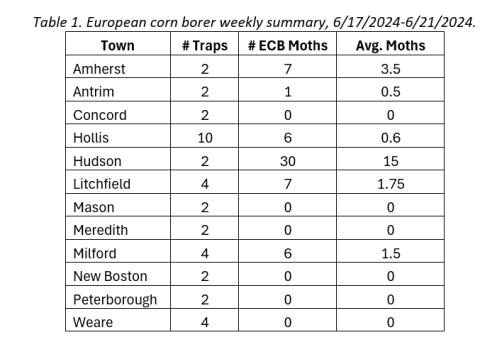
As a reminder, we found fall armyworm caterpillars feeding on corn in Hollis, NH last week. This is much earlier than we usually see FAW, so be on the lookout for larval feeding damage. If you are a call-in grower, you may want to place traps sooner than planned. FAW larval feeding damage is characterized by large, ragged holes in leaves, and sawdust-like excrement.
Our scout recorded feeding damage from corn pests this week that ranged from 0-31% in Hillsborough County. Field scouting should begin once moths are captured at your farm or in your area. Information on scouting for sweet corn pests and spray thresholds can be found here.
This week we trapped 4 brown marmorated stink bug adults in Milford, Concord, and Hollis, within our sentinel monitoring program. These locations are where we have been catching BMSB over the last few weeks. We currently do not have any thresholds established for BMSB but we continue to keep an eye on population levels in the state. Click HERE for a quick post about BMSB.
Five spotted wing drosophila adult males were caught this week in cherry traps and 9 in control traps. If you have susceptible ripening fruit, you may want to monitor for SWD. These were all caught in traps in Hollis and Concord, NH. Our neighbors in Massachusetts and New York have also recorded SWD captures, which is a little earlier than expected. More information on monitoring for SWD can be found here. In addition, Jeremy Delisle shared additional management tips and resources from Cornell University in this week’s Fruit IPM report, which can be found here.
We trapped significantly more squash vine borer adults this week (Table 2). The number of moths captured with pheromone traps can be used to decide whether or not an insecticide treatment is required. For bush-type summer squash and pumpkins (including giant pumpkins), the recommended threshold is 5 SVB moths per trap per week. For vining type squash or pumpkins, we suggest a threshold of 12 moths per trap per week. The difference is because vine-type cucurbits can root or tiller in at each node along the vine. This allows the plant to uptake water and nutrients from more than just the main stem. SVB tends to bore into the main stem of cucurbit plants, creating a higher risk for bush type plants. Future trapping data will be published on a town by town basis.
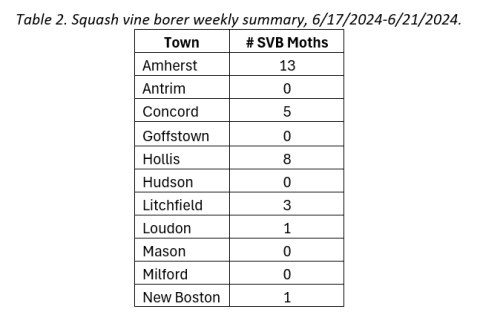
Check back in each week as the season progresses to see the latest trapping data. Data for additional insect pests will be updated on a weekly basis. Thank you to all the growers who participate in the program!
Other information of note:
- For any of you that grow radicchio, or are interested in growing it, take a look at this article that was shared in Morning Ag Clips earlier this week with results from a radicchio variety trial conducted at UNH. The article contains links to the complete study conducted by Dr. Becky Sideman et al. if you would like even more details.
- We are in peak adult flight for onion maggot according to NEWA based on degree day accumulation in Concord, NH. According to NEWA, we will be entering high risk for blueberry maggot by next week. If blueberry maggot is a concern, place baited traps on field edges or in abandoned plantings to monitor for adults. You can use baited yellow sticky card, or sticky red spheres (same as traps used for apple maggot). Check traps once or twice per week and replace traps and baits every third week if using yellow sticky cards.
- I’ve also heard more reports of severe flea beetle pressure on brassicas from both southern and northern NH. For more information and management recommendations, check out this UMass fact sheet and the New England Vegetable Management Guide.
- Colorado potato beetles are out and feeding on potatoes and will also feed on other nightshade crops, like tomato. Remember that CPB can quickly build resistance to insecticides. Careful insecticide class rotation and non-chemical controls are needed to delay resistance. If you have applied insecticides to no effect, change chemical classes and do not use the IRAC group that did not work for the rest of the season. If possible, rotating off certain insecticide groups for two seasons would be best. For more information on CPB management, see our CPB fact sheet. To see a list of chemicals approved for CPB on potato and other management strategies, click here for the New England Vegetable Management Guide.
Upcoming Events:
The Climate Adapted Farm: Making the effects of extreme weather less severe
Join NH Vegetable and Berry Growers Association (NHVGBA) & UNH Extension for this climate-resilience focused series. Attend one or more events to learn how your farm can adapt to better withstand the challenges of climate change, and how together we are working towards farmer-driven actionable solutions. This is a four-part series, join us for one or the full slate!
- July 16, 2024 | 5:30 - 7:30pm, Physically Protecting Your Crops at Spring Ledge Farm, New London, NH. Discover strategies for efficiency improvements and technology add-ons when growing crops in controlled environments like high and low tunnels, and netted structures. We will cover how to mitigate damage from extreme heat and wind.
- August 20, 2024 | 5:30 - 7:30pm, Resilience Against Extreme Weather at Wilson Farm, Litchfield, NH. What's your plan B when disaster strikes? Explore concrete actions to prepare your farm for floods, droughts, or extreme heat and get introduced to emergency management planning.
Please sign up for our new text service!

Contact: Amber Vinchesi-Vahl, UNH Extension State Specialist, Entomology and IPM, Amber.Vinchesi@unh.edu
This program is made possible thought funding provided by the New Hampshire Department of Agriculture, Markets & Food Integrated Pest Management Program. This work is also supported in part by the Integrated Pest Management Crop Protection and Pest Management Extension Implementation Plan from the USDA National Institute of Food and Agriculture.
6/14/24
Hello Vegetable IPM folks!
Our IPM scout, Linda, has been busy scouting for multiple pests all over the state and we have a few pest catches to report this week. Crop development and pest activity seems to be about a week early this year (or more for some pests!), so be alert for pest presence and damage earlier than expected, especially compared to last season.
ECB numbers continue to hold steady or increase in certain areas. If you have early corn that is in or approaching mid whorl stage, consider scouting for damage. The results of our trapping efforts are recorded by town on Table 1 below. In some cases, there are multiple traps within a town. Click HERE for more information on ECB management.
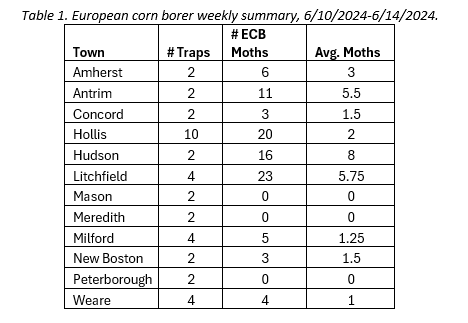
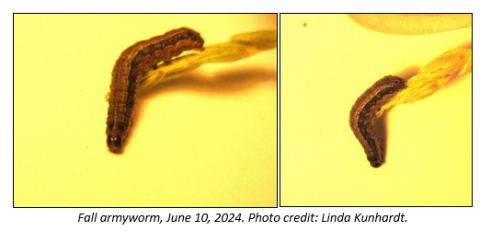
Unexpectedly, we found fall armyworm caterpillars feeding on corn in Hollis, NH this week. This is much earlier than we usually see FAW, so be on the lookout for larval feeding damage. If you are a call-in grower, you may want to place traps sooner than planned. FAW larval feeding damage is characterized by large, ragged holes in leaves, and sawdust-like excrement. Field scouting should begin once moths are captured at your farm or in your area. Information on scouting for sweet corn pests and spray thresholds can be found here.
This week we trapped 1 brown marmorated stink bug adult in Concord, within our sentinel monitoring program. We had previously caught BMSB in Hollis and Milford, NH over the past couple of weeks. We currently do not have any thresholds established for BMSB but we continue to keep an eye on population levels in the state. Click HERE for a quick post about BMSB.
Five spotted wing drosophila adult males were caught this week in strawberry (2), cherry (1), and control (2) traps. These were caught in Hollis, Litchfield and Concord. Our neighbors in Massachusetts and New York have also recorded SWD captures, which is a little earlier than expected. Be on the lookout for this pest on your earlier fruit. More information on monitoring for SWD can be found here.
We trapped 1 squash vine borer this week in Amherst, NH. The number of moths captured with pheromone traps can be used to decide whether or not an insecticide treatment is required. For bush-type summer squash and pumpkins (including giant pumpkins), the recommended threshold is 5 SVB moths per trap per week. For vining type squash or pumpkins, we suggest a threshold of 12 moths per trap per week. The difference is because vine-type cucurbits can root or tiller in at each node along the vine. This allows the plant to uptake water and nutrients from more than just the main stem. SVB tends to bore into the main stem of cucurbit plants, creating a higher risk for bush type plants. Future trapping data will be published on a town by town basis.
Cabbage root maggot: I have received a couple of inquiries about cabbage root maggot (CRM) and how to control it organically. CRM is currently in peak flight of first generation adults. This UMass fact sheet has great information on scouting for this pest and there is also a NEWA model available for CRM if you have a history of issues with this pest on brassicas. Row covers can be effective to prevent adults from egg-laying on recently seeded or transplanted brassicas, however, they may not be effective on brassicas planted in areas that have a history of brassica plantings due to fly pupae remaining in the soil. It’s best to rotate brassicas as far as possible from previous brassicas. High soil temperatures will also kill CRM and larval feeding will not impact larger brassica crops.
Leek moth was found in Sullivan County in May 2024. Previously, it had only been detected in Grafton and Coös counties. Leek moth is an invasive pest of allium crops. More information and links to resources can be found here.
Check back in each week as the season progresses to see the latest trapping data. Data for additional insect pests will be updated on a weekly basis. Thank you to all the growers who participate in the program!
Please sign up for our new text service!

Upcoming Events:
The Climate Adapted Farm: Making the effects of extreme weather less severe
Join NH Vegetable and Berry Growers Association (NHVGBA) & UNH Extension for this climate-resilience focused series. Attend one or more events to learn how your farm can adapt to better withstand the challenges of climate change, and how together we are working towards farmer-driven actionable solutions. This is a four-part series, join us for one or the full slate!
- June 18, 2024 | 5:30 - 7:30pm, Preparing Your Land for Extreme Weather at Barker’s Farm, Stratham, NH. Learn about implementing swales, field roads, drainage ponds, and soil health practices to manage water effectively and adapt to climate challenges.
- July 16, 2024 | 5:30 - 7:30pm, Physically Protecting Your Crops at Spring Ledge Farm, New London, NH. Discover strategies for efficiency improvements and technology add-ons when growing crops in controlled environments like high and low tunnels, and netted structures. We will cover how to mitigate damage from extreme heat and wind.
- August 20, 2024 | 5:30 - 7:30pm, Resilience Against Extreme Weather at Wilson Farm, Litchfield, NH. What's your plan B when disaster strikes? Explore concrete actions to prepare your farm for floods, droughts, or extreme heat and get introduced to emergency management planning.
Contact: Amber Vinchesi-Vahl, UNH Extension State Specialist, Entomology and IPM, Amber.Vinchesi@unh.edu
This program is made possible thought funding provided by the New Hampshire Department of Agriculture, Markets & Food Integrated Pest Management Program. This work is also supported in part by the Integrated Pest Management Crop Protection and Pest Management Extension Implementation Plan from the USDA National Institute of Food and Agriculture.
6/7/24
Hello vegetable IPM folks!
Our IPM Scout is busy installing and checking traps. We caught our first ECB-NY and ECB-IA moths last week. If you have early corn that is in or approaching mid whorl stage, consider scouting for damage. The results of our trapping efforts are recorded by town on Table 1 below. In some cases, there are multiple traps within a town. Click HERE for more information on ECB management.
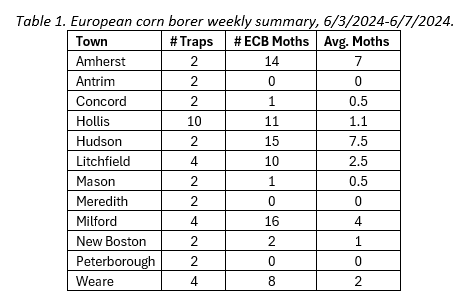
Early season scouting procedure: Wait until mid to late whorl stage to scout. Select at least 5 sites across the planting, all of the same variety and planting date. Do not check field edges to avoid the “edge effect.” To make your sampling most representative of the field, follow a rough X pattern across the planting. At each site, examine 20 stalks, and look at the whorl area for the tiny “shot holes” that show corn borers are in that stalk. Often there is a tiny bit of light, powdery frass adjacent to the small holes. If you see such signs, mark that stalk as infested. As you move across the planting, keep track (pocket pad is helpful) of two things: 1) how many stalks are infested; and 2) the total number of stalks you’ve counted. Stop at 100. If you reach a threshold of 30 or more infested stalks, it is worthwhile to treat with an insecticide. For very early corn (high value), you may wish to adjust that threshold down to 15. If the infestation rate is below threshold, it will cost more to treat the corn than the damage is worth. For sweet corn in the pre-tassel stage (tassel is visible in the whorl), use the 15% threshold (Table 2). See information source here.
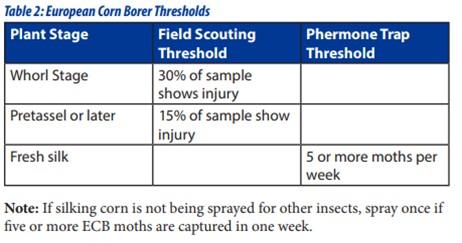
Our scout has also deployed a select number of traps for brown marmorated stink bug (BMSB), an invasive pest. We have ten traps placed at six locations as part of our sentinel monitoring. No economic thresholds have been established for New Hampshire, but the program provides data on when BMSB becomes active, as well as relative infestation levels. This week, 2 adult BMSB were trapped in Hollis and Milford, NH, which is down from the 10 adults caught last week. Click HERE for a quick post about BMSB.
Spotted wing drosophila traps went out this week in cherry and strawberry. Our neighbors in Massachusetts and New York have already recorded SWD captures, which is a little earlier than expected. Be on the lookout for this pest on your earlier fruit. More information on monitoring for SWD can be found here.
Cabbage root maggot
I have received a couple of inquiries about cabbage root maggot (CRM) and how to control it organically. CRM is currently in its first generation and some areas of the state are in peak flight. This UMass fact sheet has great information on scouting for this pest and there is also a NEWA model available for CRM if you have a history of issues with this pest on brassicas. Row covers can be effective to prevent adults from egg-laying on recently seeded or transplanted brassicas, however, they may not be effective on brassicas planted in areas that have a history of brassica plantings due to fly pupae remaining in the soil. It’s best to rotate brassicas as far as possible from previous brassicas. High soil temperatures will also kill CRM and larval feeding will not impact larger brassica crops.
Please sign up for our new text service!

Upcoming Events:
The Climate Adapted Farm: Making the effects of extreme weather less severe
Join NH Vegetable and Berry Growers Association (NHVGBA) & UNH Extension for this climate-resilience focused series. Attend one or more events to learn how your farm can adapt to better withstand the challenges of climate change, and how together we are working towards farmer-driven actionable solutions. This is a four-part series, join us for one or the full slate!
- June 18, 2024 | 5:30 - 7:30pm, Preparing Your Land for Extreme Weather at Barker’s Farm, Stratham, NH. Learn about implementing swales, field roads, drainage ponds, and soil health practices to manage water effectively and adapt to climate challenges.
- July 16, 2024 | 5:30 - 7:30pm, Physically Protecting Your Crops at Spring Ledge Farm, New London, NH. Discover strategies for efficiency improvements and technology add-ons when growing crops in controlled environments like high and low tunnels, and netted structures. We will cover how to mitigate damage from extreme heat and wind.
- August 20, 2024 | 5:30 - 7:30pm, Resilience Against Extreme Weather at Wilson Farm, Litchfield, NH. What's your plan B when disaster strikes? Explore concrete actions to prepare your farm for floods, droughts, or extreme heat and get introduced to emergency management planning.
Contact: Amber Vinchesi-Vahl, UNH Extension State Specialist, Entomology and IPM, Amber.Vinchesi@unh.edu
This program is made possible thought funding provided by the New Hampshire Department of Agriculture, Markets & Food Integrated Pest Management Program. This work is also supported in part by the Integrated Pest Management Crop Protection and Pest Management Extension Implementation Plan from the USDA National Institute of Food and Agriculture.
5/31/24
Hello vegetable IPM folks!
Our IPM Scout is busy installing and checking traps. We caught our first ECB-NY and ECB-IA moths this week, so adult populations will begin to increase. If you have early corn that is in or approaching mid whorl stage, consider scouting for damage. The results of our trapping efforts are recorded by town on Table 1 below. In some cases, there are multiple traps within a town. Click HERE for more information on ECB management. If you are a call in grower, consider installing your ECB traps now if you haven’t already!
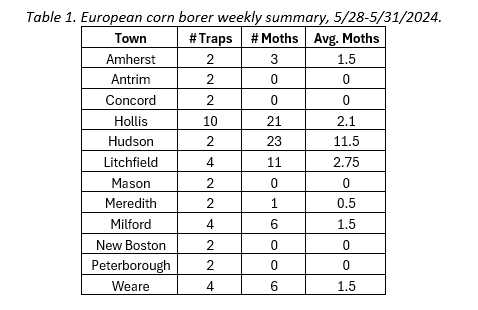
Early season scouting procedure: Wait until mid to late whorl stage to scout. Select at least 5 sites across the planting, all of the same variety and planting date. Do not check field edges to avoid the “edge effect.” To make your sampling most representative of the field, follow a rough X pattern across the planting. At each site, examine 20 stalks, and look at the whorl area for the tiny “shot holes” that show corn borers are in that stalk. Often there is a tiny bit of light, powdery frass adjacent to the small holes. If you see such signs, mark that stalk as infested. As you move across the planting, keep track (pocket pad is helpful) of two things: 1) how many stalks are infested; and 2) the total number of stalks you’ve counted. Stop at 100. If you reach a threshold of 30 or more infested stalks, it is worthwhile to treat with an insecticide. For very early corn (high value), you may wish to adjust that threshold down to 15. If the infestation rate is below threshold, it will cost more to treat the corn than the damage is worth. For sweet corn in the pre-tassel stage (tassel is visible in the whorl), use the 15% threshold (Table 2). See information source here.
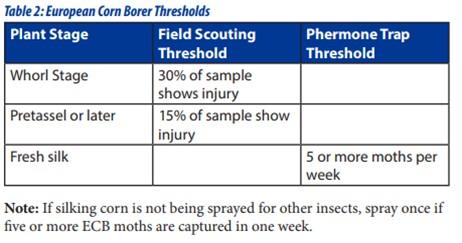
Our scout has also been working hard to deploy a select number of traps for brown marmorated stink bug (BMSB), an invasive pest. We have ten traps placed at six locations as part of our sentinel monitoring. No economic thresholds have been established for New Hampshire, but the program provides data on when BMSB becomes active, as well as relative infestation levels. This week, 10 adult BMSB were trapped in Hollis, NH. Click HERE for a quick post about BMSB.
Leek Moth detected in new county in NH
Leek moth, an invasive pest of alliums, introduced to NH in 2016, has been detected in Sullivan County on garlic. It was previously only known to be in Coös and Grafton counties. More information can be found here.
Flea beetles on brassica crops
Our IPM scout has observed heavy feeding from flea beetles on brassicas this past week. The two flea beetle species that feed on brassicas are the crucifer flea beetle (black and shiny) and the striped flea beetle (black with two yellow stripes). Brassicas vary greatly in their susceptibility and attractiveness to flea beetles. To avoid peak adult activity and the buildup on populations, rotate spring crops as far as possible from last season's fall brassica crops, and plant late-season crops far from early brassicas. If possible, avoid early brassicas all together to break the flea beetle reproductive cycle. Be sure to incorporate residues immediately after harvest to expose and kill larvae and pupae. Floating row covers provide excellent protection of the crop if well secured with soil or bags around all edges immediately after seeding or transplanting. More information on flea beetle life cycles, trap cropping, scouting, and chemical control can be found in this UMass fact sheet and the New England Vegetable Management Guide.
Please sign up for our new text service!

Upcoming Events:
The Climate Adapted Farm: Making the effects of extreme weather less severe
Join NH Vegetable and Berry Growers Association (NHVGBA) & UNH Extension for this climate-resilience focused series. Attend one or more events to learn how your farm can adapt to better withstand the challenges of climate change, and how together we are working towards farmer-driven actionable solutions. This is a four-part series, join us for one or the full slate!
- June 5, 2024 | 5:30 - 7:30pm, Farming in Permanent Raised Beds in a No-Till System at Waxing Moon Gardens, Sandwich, NH. Join us to see how Waxing Moon Gardens conserves soil, increases water efficiency, eliminates weed pressure, and boosts overall farm productivity.
- June 18, 2024 | 5:30 - 7:30pm, Preparing Your Land for Extreme Weather at Barker’s Farm, Stratham, NH. Learn about implementing swales, field roads, drainage ponds, and soil health practices to manage water effectively and adapt to climate challenges.
- July 16, 2024 | 5:30 - 7:30pm, Physically Protecting Your Crops at Spring Ledge Farm, New London, NH. Discover strategies for efficiency improvements and technology add-ons when growing crops in controlled environments like high and low tunnels, and netted structures. We will cover how to mitigate damage from extreme heat and wind.
- August 20, 2024 | 5:30 - 7:30pm, Resilience Against Extreme Weather at Wilson Farm, Litchfield, NH. What's your plan B when disaster strikes? Explore concrete actions to prepare your farm for floods, droughts, or extreme heat and get introduced to emergency management planning.
Contact: Amber Vinchesi-Vahl, UNH Extension State Specialist, Entomology and IPM, Amber.Vinchesi@unh.edu
This program is made possible thought funding provided by the New Hampshire Department of Agriculture, Markets & Food Integrated Pest Management Program. This work is also supported in part by the Integrated Pest Management Crop Protection and Pest Management Extension Implementation Plan from the USDA National Institute of Food and Agriculture.
Hello Vegetable IPM Enthusiasts!
Our trapping season is coming to an end, and this will be the last vegetable IPM report for the year. All traps (except BMSB) will be pulled from field locations next week. Crop loss has been heavy this season and I hope growers will make it through alright. UNH cooperative extension will be launching an online survey on Friday October 13th to evaluate vegetable crop losses due to excessive moisture and frost events. One objective of the survey is to provide data to entities who may be poised to provide grant funding to impacted producers. So please keep an eye on your inbox and feel free to reach out to me if you need help completing the survey.
Most insect pressure has slowed except for the brown marmorated stink bug.
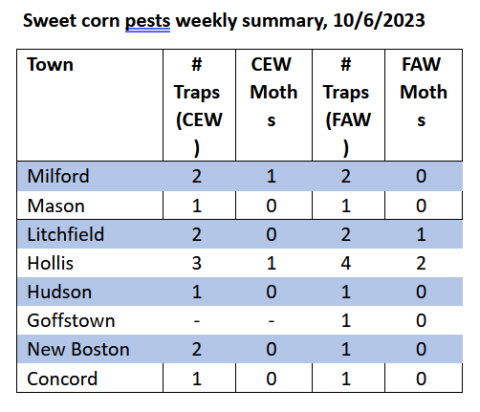
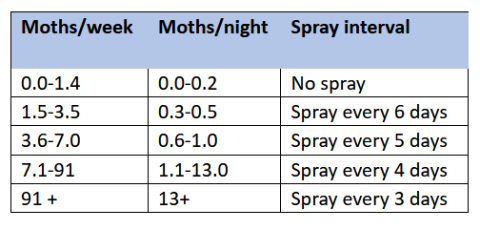
Spotted wing drosophila (SWD) numbers are very low within production areas. Control locations are still showing high numbers, suggesting that late raspberries and day neutral strawberries could be a risk
Brown Marmorated Stink Bug (BMSB) catch increased significantly this week but only one location was over the generally accepted threshold of 10 adults. BMSB are most susceptible to insecticides in the nymphal stages. For more great information on BMSB, go to https://www.stopbmsb.org/managing-bmsb/.
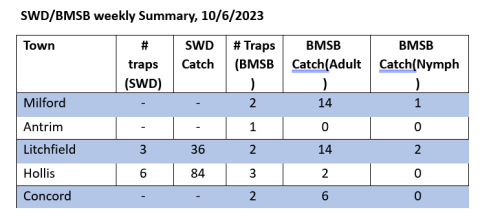
Below are a few graphics the summarize the insect pressure this season:
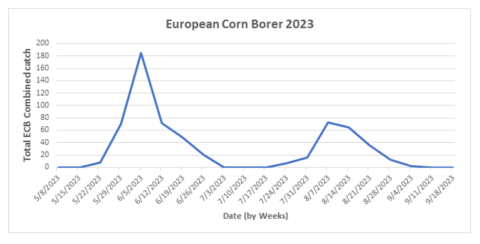
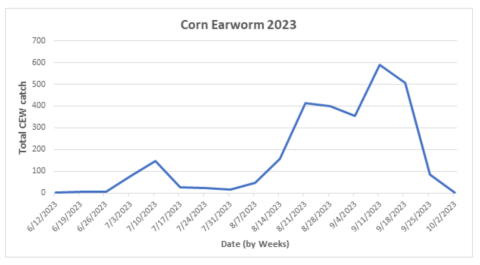
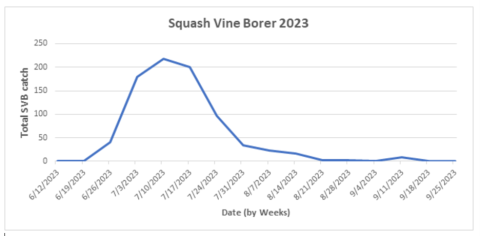
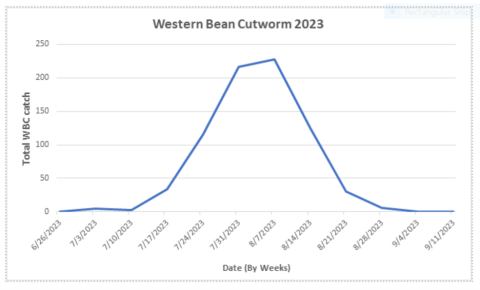
Thank you all for sticking with the program this year and for reading along! I hope you found the information helpful and as always, reach out to UNH extension with any questions you may have!
Upcoming Events:
OCTOBER 16, 2023 | 1:00 - 2:30PM
OCTOBER 18, 2023 | 3:00 - 6:00PM
OCTOBER 20, 2023 | 3:00 - 6:00PM
This program is made possible thought funding provided by the New Hampshire Department of Agriculture, Markets & Food integrated pest management program. This work is also supported in part by the Integrated Pest Management Crop Protection and Pest Management EIP grant no. 2021-70006-35477 from the USDA National Institute of Food and Agriculture.
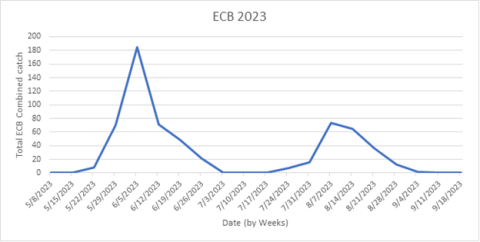
Hello Vegetable IPM Enthusiasts!
Winter Rye is popping and still being spread around the state as fields come out of production. The latest sweet corn blocks are in silk now. Our trapping season is winding down as insect pressure slows. Next Friday will likely be the final IPM report for the season. We no longer have data to share for European corn borer, but as a reminder, tilling or mowing your corn residue can help to reduce overwintering populations. The Chart above shows the combined European corn borer catch count, week by week, for the 2023 growing season. We can clearly see the peaks of 1st and 2nd flight nicely.
On a separate note, UNH cooperative extension will be launching an online survey to evaluate crop losses due to excessive moisture and frost events. This will be rolled out in the coming weeks so please keep an eye on your inbox for it!
Overall Corn Earworm (CEW) catch dropped off significantly this week, but some locations are still seeing high enough pressure to warrant a 4-day spray schedule for fresh silking corn. Corn development is really slowing down with the cool nights, and late blocks are taking longer to ripen. The race till first hard frost is on!
Total Fall Armyworm (FAW) catch dropped by more than 50 percent this week. With that said the highest catch for a single trap was only 5 moths. A handful of FAW traps were decommissioned this week. FAW larval feeding damage is characterized by large, ragged holes in leaves, and sawdust-like excrement. Field scouting should begin once moths are captured at your farm or in your area. Click the link to more information on how to field scout.
Sweet corn pests weekly summary, 9/29/2023
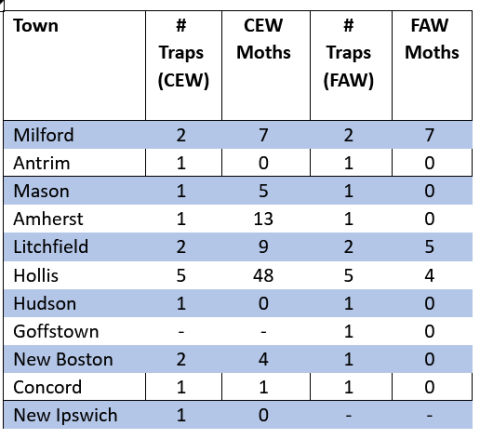
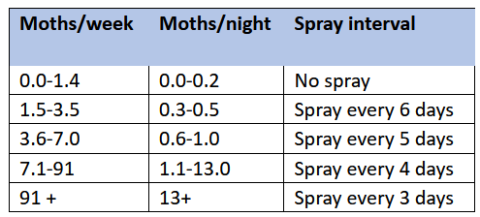
Overall Spotted wing drosophila (SWD) numbers have dropped this week but remained high in control locations. Only one in-field trap was high with a catch of 12. Monitoring is now only happening within raspberry and grape plantings on three farms. Traps are starting to come down as production slows. go to https://ag.umass.edu/fruit/resources/spotted-wing-drosophila-management for more management information. Trapping data is recorded in the table below.
All Squash vine borer (SVB) traps were decommissioned this week. This will be the last week of report SVB data. Zero Squash borer were caught across the network for the second week in a row. SVB pupae overwinter within the soil at a depth of 1-2 inches. Fall and spring tillage can help to bury pupae deeper than 2 inches, which will reduce their overwintering success.
Brown Marmorated Stink Bug (BMSB) catch has dropped this week. no notable hotspots this week. BMSB are most susceptible to insecticides in the nymphal stages. For more great information on BMSB, go to https://www.stopbmsb.org/managing-bmsb/.
SVB/SWD/BMSB weekly Summary, 9/29/2023
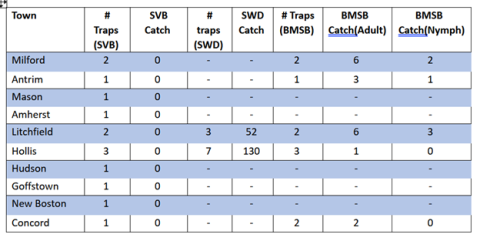
Check back in each week as the season progresses to see the latest trapping data. Data for additional insect pests will be updated on a weekly basis.
Thank you to all the growers who participate in the program!
Upcoming Events:
OCTOBER 5, 2023 | 4:00 - 6:00PM
OCTOBER 16, 2023 | 1:00 - 2:30PM
OCTOBER 18, 2023 | 3:00 - 6:00PM
OCTOBER 20, 2023 | 3:00 - 6:00PM
This program is made possible thought funding provided by the New Hampshire Department of Agriculture, Markets & Food integrated pest management program. This work is also supported in part by the Integrated Pest Management Crop Protection and Pest Management EIP grant no. 2021-70006-35477 from the USDA National Institute of Food and Agriculture.
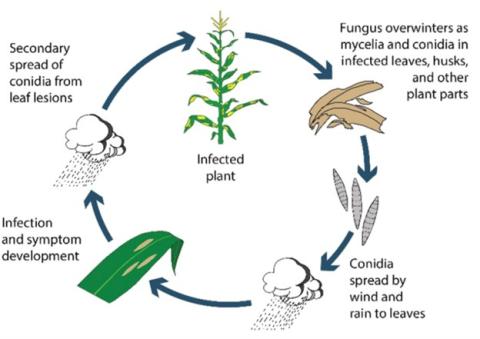
Hello Vegetable IPM Enthusiasts!
Our full time IPM scout, Linda, caught Zero European corn borer (ECB) moths for the second week in a row. At this point, all ECB traps have been pulled and risk of damage is over. As a reminder, ECB overwinters in crop reside. To limit the overwintering success of ECB, thoroughly incorporate crop residues via tillage, followed by an appropriate cover crop. Growers utilizing no till can rotary or flail mow corn residue to destroy overwintering habitat. flail mowing is the preferred method. Not only will destroying crop residue limit overwintering success of ECB, but it can also reduce fungal disease pressure for next season. Northern corn leaf blight is a fungal pathogen of sweet corn that was observed on a couple of farms in Hillsborough County. This disease is primarily driven by cool, wet weather which we had plenty of that this summer and fall. follow this link to learn more on how to manage northern corn leaf blight.
Most of our call-in growers have removed traps and will no longer be reporting trapping data for this season.
Overall Corn Earworm (CEW) catch was down this week, but many locations are still seeing high pressure. Most locations are still on a 4-day spray schedule for fresh silking corn. Corn development is really slowing down with the cool nights, and late blocks are taking longer to ripen.
Total Fall Armyworm (FAW) catch count is the highest it has been all season, but that was due to some hot spots in the Hollis and Milford area. With that said the highest catch for a single trap was 9 moths. FAW larval feeding damage is characterized by large, ragged holes in leaves, and sawdust-like excrement. Field scouting should begin once moths are captured at your farm or in your area. Click the link to more information on how to field scout.
The current late blight map has reported no new outbreaks. To track late blight on your own go to https://usablight.org/map/. If you suspect late blight in your fields, please reach out to your county specialist.
Sweet corn pests weekly summary, 9/22/2023
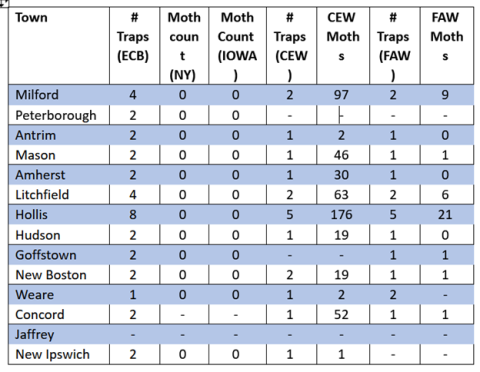
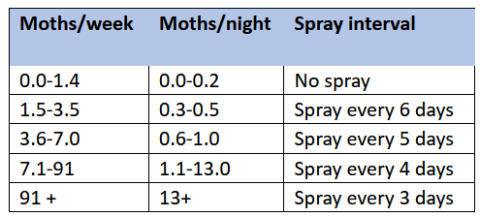
Within control locations, Overall Spotted wing drosophila (SWD) numbers have remained high but in-field numbers are low. All Traps within production areas reported 3 or less flies per trap. Monitoring is now only happening within raspberry and grape plantings on three farms. Traps are starting to come down as production slows. go to https://ag.umass.edu/fruit/resources/spotted-wing-drosophila-management for more management information. Trapping data is recorded in the table below, alongside the data for squash vine borer.
Squash vine borer (SVB) numbers are virtually non-existent. All susceptible plants are robust enough at this point in the season to escape further damage. Next week SVB traps will be pulled from fields, marking the end of motoring for this insect for the season. SVB pupae overwinter within the soil at a depth of 1-2 inches. Fall and spring tillage can help to bury pupae deeper than 2 inches, which will reduce their overwintering success.
Brown Marmorated Stink Bug (BMSB) catch has remained steady this week. Hollis is the hot spot again this week. BMSB are most susceptible to insecticides in the nymphal stages. For more great information on BMSB, go to https://www.stopbmsb.org/managing-bmsb/.
SVB/SWD/BMSB weekly Summary, 9/22/2023
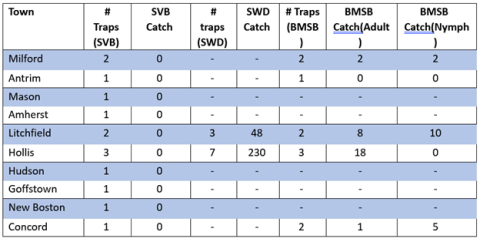
Check back in each week as the season progresses to see the latest trapping data. Data for additional insect pests will be updated on a weekly basis.
Thank you to all the growers who participate in the program!
Upcoming Events:
OCTOBER 5, 2023 | 4:00 - 6:00PM
OCTOBER 16, 2023 | 1:00 - 2:30PM
OCTOBER 18, 2023 | 3:00 - 6:00PM
OCTOBER 20, 2023 | 3:00 - 6:00PM
This program is made possible thought funding provided by the New Hampshire Department of Agriculture, Markets & Food integrated pest management program. This work is also supported in part by the Integrated Pest Management Crop Protection and Pest Management EIP grant no. 2021-70006-35477 from the USDA National Institute of Food and Agriculture.
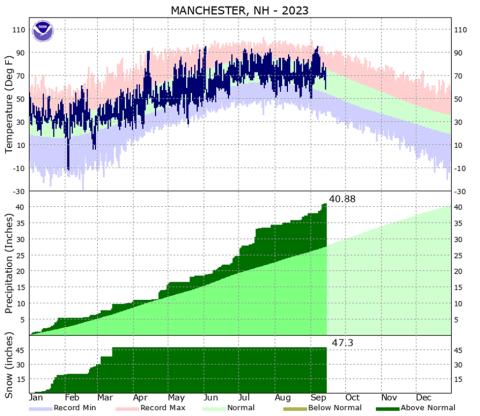
Hello Vegetable IPM Enthusiasts!
We are back with heavy rains this week and hurricane Lee is projected to hit the seacoast in the next 24 hours. Temperatures are now in a “normal range” for September. For precipitation we are about 15 inches more than a typical year, depending on exact location. This is based on NOAA data, see chart above.
We are well past the halfway point of harvest for sweet corn and fall cucurbits are slowly coming in. Choosing when and how to harvest fall cucurbits, like pumpkins, is a challenge this year. Fruit rot diseases have been a major issue this season and picking and properly storing your fruits as soon as they are mature is recommended. For some more detailed information on harvesting and storing pumpkins and winter squash, follow this link: https://ag.umass.edu/vegetable/fact-sheets/pumpkin-winter-squash-harvest-storage.
As a reminder, the USDA has provided more flexibility regarding disaster programs for flood-impacted producers in the northeast. the Farm service agency has authorized policy exceptions in all flood-impacted counties in Connecticut, Maine, Massachusetts, New Hampshire, New Jersey, New York, Pennsylvania, Rhode Island, and Vermont. For the full press release and more information go to https://www.fsa.usda.gov/news-room/news-releases/2023/usda-offers-disaster-program-flexibilities-for-flood-impacted-producers-in-the-northeast
The current late blight map has reported no new outbreaks. To track late blight on your own go to https://usablight.org/map/. If you suspect late blight in your fields, please reach out to your county specialist.
Only one European corn borer (ECB) moth was captured by a self-monitoring grower this week. If no catch is found next week, our traps will be pulled for the season. Most sweet corn is past whorl and pretassel at this point, signifying low risk of damage from ECB. Click the link to learn more about scouting and trapping. The results of our trapping efforts are recorded by town on the table below with ECB-NY and ECB-IA moth counts shown. In some cases, there are multiple traps within a town.
Total Corn Earworm (CEW) pressure increased significantly to the highest levels we’ve seen this season. One site in Milford reported a catch of 110 moths in a single trap! The growers in high infestation areas are now on a 3-day schedule, but most in the network are still on a 4-day spray schedule. CEW resistance to pyrethroid products (i.e. Warrior) is well documented in other regions and if you notice a lack of control, consider rotating pyrethroids (Group 3A) with products from a different chemical class. This is especially important for growers who rely solely on pyrethroids for CEW control. Blackhawk/Radiant (group 5) and Besiege/Coragen (groups 28, 3A) could make good rotation partners/alternative choices. If pyrethroids are to be used for control, the current recommendation is to use those products earlier in the growing season because resistance can build throughout the year. Also, control can vary from product to product within the pyrethroid class. The most resistance build up is seen with Warrior. If a pyrethroid is to be used, consider selecting a different Pyrethroid product, like Hero or Baythriod XL.
Fall Armyworm (FAW) catch has remained steady. Some trapping sites have shown higher numbers, some have shown lower numbers. FAW larval feeding damage is characterized by large, ragged holes in leaves, and sawdust-like excrement. Field scouting should begin once moths are captured at your farm or in your area. Click the link to more information on how to field scout.
For the second week in a row, zero Western bean cutworm (WBC) moths were caught. We have pulled our WBC traps for this season, effectively marking the end of WBC damage potential.
Sweet corn pests weekly summary, 9/15/2023
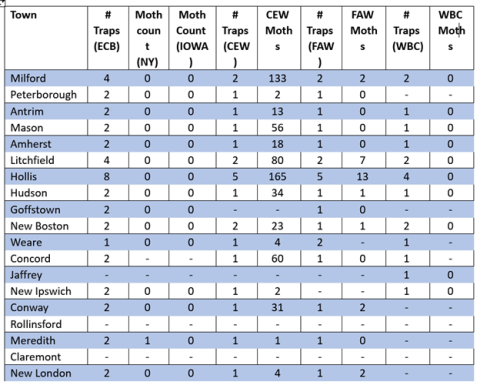
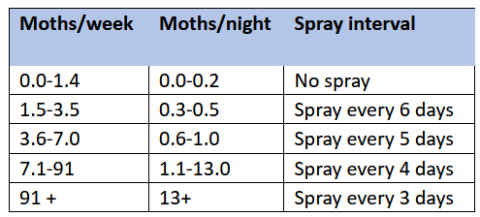
Within control locations, Overall Spotted wing drosophila (SWD) numbers have remained high but in-field numbers are low. Monitoring is now only happening within raspberry and grape plantings on three farms. Traps are starting to come down as production slows. go to https://ag.umass.edu/fruit/resources/spotted-wing-drosophila-management for more management information. Trapping data is recorded in the table below, alongside the data for squash vine borer.
Squash vine borer (SVB) numbers are low, but we did see a slight bump in overall numbers, from 1 last week to 8 this week. Most susceptible plants are robust enough at this point in the season to escape further damage.
Brown Marmorated Stink Bug (BMSB) adult catches have more than doubled this week. One location in Hollis Reported a catch of 11. Another location in Litchfield reported a catch of 8 adults. In addition, 5 nymphs were found in Antrim and 12 nymphs at a location in Litchfield. BMSB are most susceptible to insecticides in the nymphal stages. For more great information on BMSB, go to https://www.stopbmsb.org/managing-bmsb/.
SVB/SWD/BMSB weekly Summary, 9/15/2023
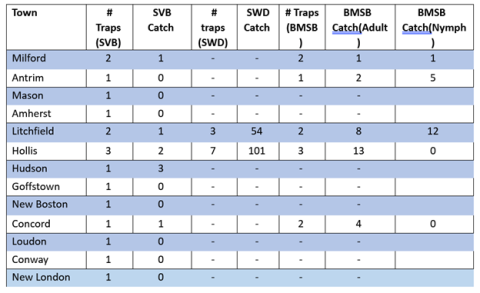
Check back in each week as the season progresses to see the latest trapping data. Data for additional insect pests will be updated on a weekly basis.
Thank you to all the growers who participate in the program!
Upcoming Events:
SEPTEMBER 20, 2023 | 8:00AM - 3:00PM
OCTOBER 5, 2023 | 4:00 - 6:00PM
This program is made possible thought funding provided by the New Hampshire Department of Agriculture, Markets & Food integrated pest management program. This work is also supported in part by the Integrated Pest Management Crop Protection and Pest Management EIP grant no. 2021-70006-35477 from the USDA National Institute of Food and Agriculture.
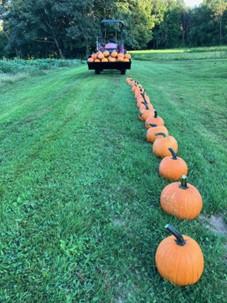
Hello Vegetable IPM Enthusiasts!
The extreme temperatures this week have actually forced some growers with lighter soils to irrigate! This is a year of feast or famine for sure. In southern NH we are approaching the midpoint of the season for sweet corn and pumpkins and squash are starting to come in for growers who were able to dodge disease pressure. Harvest is down across the board for fall cucurbits.
As a reminder, the USDA has provided more flexibility regarding disaster programs for flood-impacted producers in the northeast. the Farm service agency has authorized policy exceptions in all flood-impacted counties in Connecticut, Maine, Massachusetts, New Hampshire, New Jersey, New York, Pennsylvania, Rhode Island and Vermont. For the full press release and more information go to https://www.fsa.usda.gov/news-room/news-releases/2023/usda-offers-disaster-program-flexibilities-for-flood-impacted-producers-in-the-northeast
The current late blight map has reported outbreaks north of Montreal. to track late blight on your own go to https://usablight.org/map/
Only Handful of European corn borer (ECB) were caught across the network this week. flight is virtually over for the year, and ECB numbers will most likely stay low for the remainder of the season. In the southern part of the state, there is some whorl stage corn left but most has progressed past whorl. With whorl stage corn, larval feeding damage is characterized by tiny “shot holes” in the leaves. Eventually the larvae will bore into the developing tassel and stalks. The later season scouting procedure is the same but consider that you may be encountering FAW damage as well. Click the link to learn more about scouting and trapping. The results of our trapping efforts are recorded by town on the table below with ECB-NY and ECB-IA moth counts shown. In some cases, there are multiple traps within a town.
Total Corn Earworm (CEW) catch was lower this week over last but still in the high range. some farms went up and some farms saw a reduction is pressure. At this point in the season, most locations are still on a 4-day spray schedule. CEW resistance to pyrethroid products (i.e. Warrior) is well documented in other regions and if you notice a lack of control, consider rotating pyrethroids (Group 3A) with products from a different chemical class. This is especially important for growers who rely solely on pyrethroids for CEW control. Blackhawk/Radiant (group 5) and Besiege/Coragen (groups 28, 3A) could make good rotation partners/alternative choices. If pyrethroids are to be used for control, the current recommendation is to use those products earlier in the growing season because resistance can build throughout the year. Also, control can vary from product to product within the pyrethroid class. The most resistance build up is seen with Warrior. If a pyrethroid is to be used, consider selecting a different Pyrethroid product, like Hero or Baythriod XL.
Fall Armyworm (FAW) catch was the same as last week. Damage is being reported in the latest whorl sage corn blocks. FAW damage is being reported in other New York states despite little or no moth catch. FAW larval feeding damage is characterized by large, ragged holes in leaves, and sawdust-like excrement. Large populations may kill or stunt young corn plants. Field scouting should begin once moths are captured at your farm or in your area. Click the link to more information on how to field scout.
Zero Western bean cutworm (WBC) moths were caught this week, but larval stages could still be active in the field. Scout fields by examining the upper surfaces of the leaves at the top of the plant and leaves above and below the ear zone. Eggs are laid in masses and change from a cream color to lavender to dark purple as they age. Use the sun to your advantage and look for the egg mass shadows while scouting. Materials used for corn earworm control will also control western bean cutworm. Consult the New England vegetable management guide for recommendations.
Sweet corn pests weekly summary, 9/8/2023
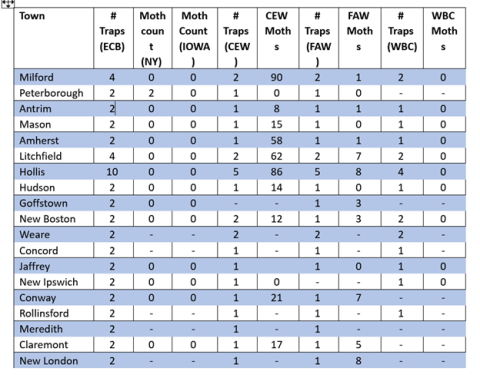
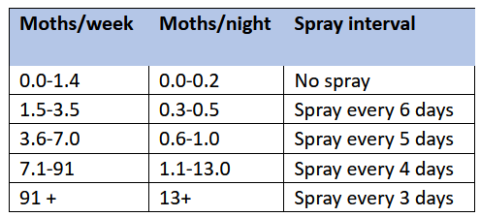
Overall Spotted wing drosophila (SWD) numbers have remained as compared to last week. Very high traps counts mostly occurred with control traps in hedgerows or other non-treated areas. in field counts were much lower, suggesting that control methods are working. Traps are starting to come down as production slows. go to https://ag.umass.edu/fruit/resources/spotted-wing-drosophila-management for more management information. Trapping data is recorded in the table below, alongside the data for squash vine borer.
A Single Squash vine borer (SVB) moth was caught this week in the southern/central New Hampshire area. Most susceptible plants are robust enough at this point in the season to escape further damage.
Nine Brown Marmorated Stink Bug (BMSB) adult were caught this week in sites that reported. Ten Nymphs were also caught at one location in Litchfield. We currently do not have any thresholds established for BMSB but we continue to keep an eye on population levels in the state. For more great information on BMSB, go to https://www.stopbmsb.org/managing-bmsb/.
SVB/SWD/BMSB weekly Summary, 9/8/2023
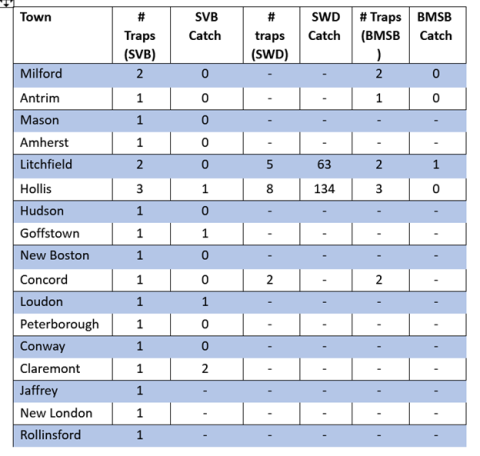
Check back in each week as the season progresses to see the latest trapping data. Data for additional insect pests will be updated on a weekly basis.
Thank you to all the growers who participate in the program!
Upcoming Events:
SEPTEMBER 20, 2023 | 8:00AM - 3:00PM
OCTOBER 5, 2023 | 4:00 - 6:00PM
This program is made possible thought funding provided by the New Hampshire Department of Agriculture, Markets & Food integrated pest management program. This work is also supported in part by the Integrated Pest Management Crop Protection and Pest Management EIP grant no. 2021-70006-35477 from the USDA National Institute of Food and Agriculture.

Hello Vegetable IPM Enthusiasts!
Fall harvest season has begun and the comfortable weather this past week has been refreshing. On the topic of weather, the USDA has provided more flexibility regarding disaster programs for flood-impacted producers in the northeast. the Farm service agency has authorized policy exceptions in all flood-impacted counties in Connecticut, Maine, Massachusetts, New Hampshire, New Jersey, New York, Pennsylvania, Rhode Island and Vermont. For the full press release and more information go to https://www.fsa.usda.gov/news-room/news-releases/2023/usda-offers-disaster-program-flexibilities-for-flood-impacted-producers-in-the-northeast
no further verified reports of late blight, except for those previously reported in New York state. to track late blight on your own go to https://usablight.org/map/
Our Scout has confirmed the presence of corn leaf aphid on several farms in southern NH. These aphids can spread Maize dwarf mosaic virus and in high populations can stunt plants. Additionally, if populations are high enough, CLA can secrete large amounts of honeydew that promotes sooty mold. Sooty mold fungus can affect marketability of ears and of stalks sold for ornamental purposes. Sprays applied before 50 percent of the tassels emerge are more effective than later sprays. Some products that can be used to control CLA are acetamiprid (assail) and Flupyradifurone (Sivanto).
For our trapping network, we are over the hump and are just starting to remove traps from some field locations.
European corn borer (ECB) numbers are once again down this week. Peak flights are over for the year, and ECB numbers will most likely stay low for the remainder of the season. With whorl stage corn, larval feeding damage is characterized by tiny “shot holes” in the leaves. Eventually the larvae will bore into the developing tassel and stalks. The later season scouting procedure is the same but consider that you may be encountering FAW damage as well. Click the link to learn more about scouting and trapping. The results of our trapping efforts are recorded by town on the table below with ECB-NY and ECB-IA moth counts shown. In some cases, there are multiple traps within a town.
Corn Earworm (CEW) catch was very high again this week, just like last. At this point in the season, most locations are on a 4-day spray schedule. CEW resistance to pyrethroid products (i.e. Warrior) is well documented in other regions and if you notice a lack of control, consider rotating pyrethroids (Group 3A) with products from a different chemical class. This is especially important for growers who rely solely on pyrethroids for CEW control. Blackhawk/Radiant (group 5) and Besiege/Coragen (groups 28, 3A) could make good rotation partners/alternative choices. If pyrethroids are to be used for control, the current recommendation is to use those products earlier in the growing season because resistance can build throughout the year. Also, control can vary from product to product within the pyrethroid class. The most resistance build up is seen with Warrior. If a pyrethroid is to be used, consider selecting a different Pyrethroid product, like Hero or Baythriod XL.
Fall Armyworm (FAW) catch hit its highest of the season this week. Damage is being reported in the latest whorl sage corn blocks. FAW damage is being reported in other New England states despite little or no moth catch. FAW larval feeding damage is characterized by large, ragged holes in leaves, and sawdust-like excrement. Large populations may kill or stunt young corn plants. Field scouting should begin once moths are captured at your farm or in your area. Click the link to more information on how to field scout.
Western bean cutworm (WBC) catch was very low this week. We have reached the end of flight for the season. We will likely stop monitoring for this insect in two weeks. We currently do not have an economic threshold established for this pest in NH, but our trapping network is keeping an eye on populations. David Handley from the University of Maine advises to keep silking corn protected if trap numbers of WBC in your area are high, even if traps are catching very few CEW or FAW. This is because WBC behaves similarly to fall armyworm and corn earworm. Scout fields by examining the upper surfaces of the leaves at the top of the plant and leaves above and below the ear zone. Eggs are laid in masses and change from a cream color to lavender to dark purple as they age. Use the sun to your advantage and look for the egg mass shadows while scouting. Materials used for corn earworm control will also control western bean cutworm. Consult the New England vegetable management guide for recommendations.
Sweet corn pests weekly summary, 9/1/2023

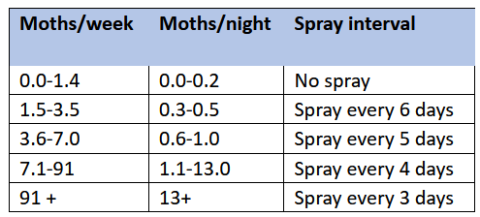
Overall Spotted wing drosophila (SWD) numbers have increased significantly as compared to last week. very high numbers in the field were only seen at one location in Concord. Other high traps counts mostly occurred with control traps in hedgerows or other non-treated areas. go to https://ag.umass.edu/fruit/resources/spotted-wing-drosophila-management for more management information. Trapping data is recorded in the table below, alongside the data for squash vine borer.
Only three Squash vine borer (SVB) moths were caught this week in the southern/central New Hampshire area. Most susceptible plants are robust enough at this point in the season to escape further damage.
Four Brown Marmorated Stink Bug (BMSB) adults were caught this week. Two Nymphs were also caught at a location in Antrim. We currently do not have any thresholds established for BMSB but we continue to keep an eye on population levels in the state. For more great information on BMSB, go to https://www.stopbmsb.org/managing-bmsb/.
SVB/SWD/BMSB weekly Summary, 9/1/2023
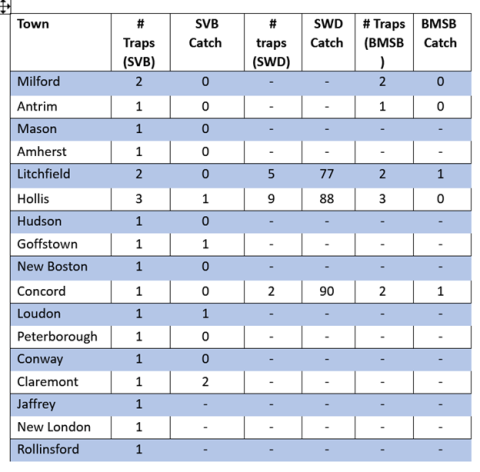
Check back in each week as the season progresses to see the latest trapping data. Data for additional insect pests will be updated on a weekly basis.
Thank you to all the growers who participate in the program!
Upcoming Events:
SEPTEMBER 20, 2023 | 8:00AM - 3:00PM
OCTOBER 5, 2023 | 4:00 - 6:00PM
This program is made possible thought funding provided by the New Hampshire Department of Agriculture, Markets & Food integrated pest management program. This work is also supported in part by the Integrated Pest Management Crop Protection and Pest Management EIP grant no. 2021-70006-35477 from the USDA National Institute of Food and Agriculture.
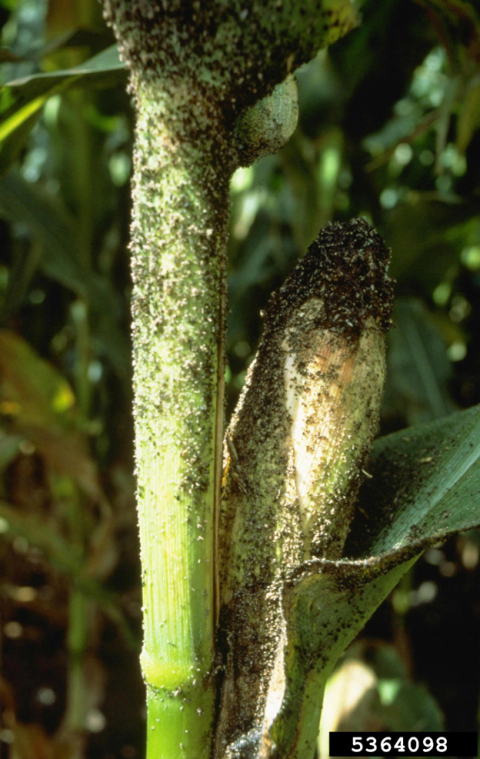
Hello Vegetable IPM Enthusiasts!
Cucurbit downy mildew on cucumbers is rampant in Hillsborough County. Just as a reminder, applying preventive/broad spectrum fungicide controls (eg. chlorothalonil or copper) along with targeted fungicides before plants are systematic will provide better control than waiting for symptoms to appear. Margaret Tuttle McGrath from Cornell University has created a handy table that lists conventional control options for many cucurbits diseases. Check out the list Cucurbit Fungicide List 2020-NY (bpb-us-e1.wpmucdn.com). Always read the labels to confirm it is approved for use in NH.
Late blight on solanaceous crops had also been reported in New York state.
Our Scout has confirmed the presence of corn leaf aphid on several farms in southern NH. These aphids can spread Maize dwarf mosaic virus and in high populations can stunt plants. Additionally, if populations are high enough, CLA can secrete large amounts of honeydew that promotes sooty mold. Sooty mold fungus can affect marketability of ears and of stalks sold for ornamental purposes. Sprays applied before 50 percent of the tassels emerge are more effective than later sprays. some products that can be used to control CLA are acetamiprid (assail) and Flupyradifurone (Sivanto).
European corn borer (ECB) numbers are one again down this week, with half the total catch as compared to last week. We are likely approaching the end of 2nd flight in southern NH. With whorl stage corn, larval feeding damage is characterized by tiny “shot holes” in the leaves. Eventually the larvae will bore into the developing tassel and stalks. The later season scouting procedure is the same but consider that you may be encountering FAW damage as well. Click the link to learn more about scouting and trapping. The results of our trapping efforts are recorded by town on the table below with ECB-NY and ECB-IA moth counts shown. In some cases, there are multiple traps within a town.
Corn Earworm (CEW) total moth catch has drastically increased with one site reporting a catch of 91 moths in a week! That corresponds to the tightest spray schedule of every 3 days. At this point in the season, most locations are on a 4-day spray schedule. CEW resistance to pyrethroid products (i.e. Warrior) is well documented in other regions and if you notice a lack of control, consider rotating pyrethroids (Group 3A) with products from a different chemical class. This is especially important for growers who rely solely on pyrethroids for CEW control. Blackhawk/Radiant (group 5) and Besiege/Coragen (groups 28, 3A) could make good rotation partners/alternative choices. If pyrethroids are to be used for control, the current recommendation is to use those products earlier in the growing season because resistance can build throughout the year. Also, control can vary from product to product within the pyrethroid class. The most resistance build up is seen with Warrior. If a pyrethroid is to be used, consider selecting a different product, like Baythriod XL
Fall Armyworm (FAW) catch did bump up this week. Our scout has reported huge amounts of by-catch or “look alike” moths for the second week in a row. This can make counting and identifying FAW moths more difficult. FAW damage is being reported in other New England states despite little or no moth catch. FAW larval feeding damage is characterized by large, ragged holes in leaves, and sawdust-like excrement. Large populations may kill or stunt young corn plants. Field scouting should begin once moths are captured at your farm or in your area. Click the link to more information on how to field scout.
Western bean cutworm (WBC) catch was down this week, suggesting that we are nearing the end of flight. We currently do not have an economic threshold established for this pest in NH, but our trapping network is keeping an eye on populations. David Handley from the University of Maine advises to keep silking corn protected if trap numbers of WBC in your area are high, even if traps are catching very few CEW or FAW. This is because WBC behaves similarly to fall armyworm and corn earworm. Scout fields by examining the upper surfaces of the leaves at the top of the plant and leaves above and below the ear zone. Eggs are laid in masses and change from a cream color to lavender to dark purple as they age. Use the sun to your advantage and look for the egg mass shadows while scouting. Materials used for corn earworm control will also control western bean cutworm. Consult the New England vegetable management guide for recommendations.
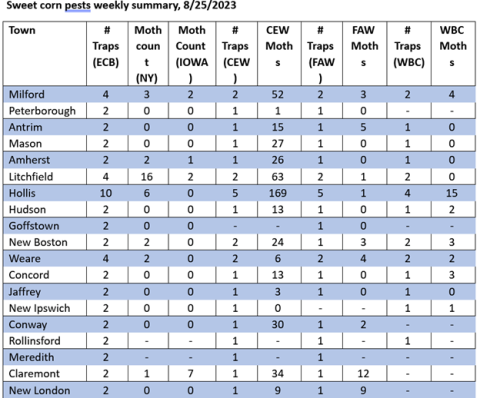

Overall Spotted wing drosophila (SWD) numbers have dropped, but a few scattered sites are reporting high catch. again, this is mostly occurring with control traps in hedgerows or other non-treated areas. go to https://ag.umass.edu/fruit/resources/spotted-wing-drosophila-management for more management information. Trapping data is recorded in the table below, alongside the data for squash vine borer.
Only Two Squash vine borer (SVB) moths were caught this week in the southern/central New Hampshire area. Most susceptible plants are robust enough at this point in the season to escape further damage.
Two Brown Marmorated Stink Bug (BMSB) adults were caught this week. One Nymph was also caught at a location in Antrim. We currently do not have any thresholds established for BMSB but we continue to keep an eye on population levels in the state. For more great information on BMSB, go to https://www.stopbmsb.org/managing-bmsb/.
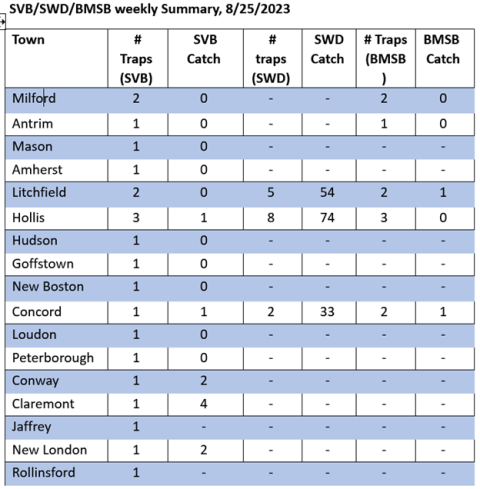
Check back in each week as the season progresses to see the latest trapping data. Data for additional insect pests will be updated on a weekly basis.
Thank you to all the growers who participate in the program!
Upcoming Events:
SEPTEMBER 20, 2023 | 8:00AM - 3:00PM
This program is made possible thought funding provided by the New Hampshire Department of Agriculture, Markets & Food integrated pest management program. This work is also supported in part by the Integrated Pest Management Crop Protection and Pest Management EIP grant no. 2021-70006-35477 from the USDA National Institute of Food and Agriculture.
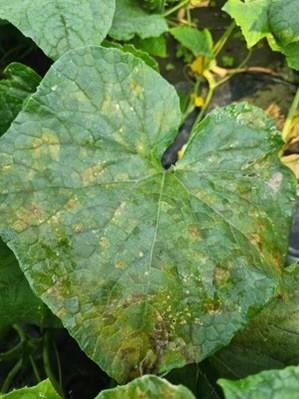
Hello Vegetable IPM Enthusiasts!
Recent rains have exacerbated fungal issues within the state. We have visually confirmed more cases of cucurbit downy mildew at several locations in Hillsborough County. Towns where symptoms were seen include Antrim, concord, Peterborough and Jaffery. All these sightings were on cucumber. Margaret Tuttle McGrath from Cornell University has created a handy table that lists conventional control options for many cucurbits diseases. Click this link for more information and control options. As always, check that any products you may use are registered for use in New Hampshire.
European corn borer (ECB) numbers are down from last week at most trapping locations. With whorl stage corn, larval feeding damage is characterized by tiny “shot holes” in the leaves. Eventually the larvae will bore into the developing tassel and stalks. The later season scouting procedure is the same but consider that you may be encountering FAW damage as well. Click the link to learn more about scouting and trapping. The results of our trapping efforts are recorded by town on the table below with ECB-NY and ECB-IA moth counts shown. In some cases, there are multiple traps within a town.
Corn Earworm (CEW) total moth catch tripled since last week! At this point in the season, most locations are on a 4 day spray schedule. CEW resistance to pyrethroid products (i.e. Warrior) is well documented in other regions and if you notice a lack of control, consider rotating pyrethroids (Group 3A) with products from a different chemical class. This is especially important for growers who rely solely on pyrethroids for CEW control. Blackhawk/Radiant (group 5) and Besiege/Coragen (groups 28, 3A) could make good rotation partners/alternative choices. If pyrethroids are to be used for control, the current recommendation is to use those products earlier in the growing season because resistance can build throughout the year. Also, control can vary from product to product within the pyrethroid class. The most resistance build up is seen with Warrior. If a pyrethroid is to be used, consider selecting a different product, like Baythriod XL
Fall Armyworm (FAW) catch dropped off significantly this week, but our scout did report heavy by catch. This leads me to believe that conditions are ripe for other moth pests. FAW damage is being reported in other New England states despite little or no moth catch. FAW larval feeding damage is characterized by large, ragged holes in leaves, and sawdust-like excrement. Large populations may kill or stunt young corn plants. Field scouting should begin once moths are captured at your farm or in your area. Click the link to more information on how to field scout.
Western bean cutworm (WBC) populations were reduced by almost half this week, suggesting that peak flight is over. We currently do not have an economic threshold established for this pest in NH, but our trapping network is keeping an eye on populations. David Handley from the University of Maine advises to keep silking corn protected if trap numbers of WBC in your area are high, even if traps are catching very few CEW or FAW. This is because WBC behaves similarly to fall armyworm and corn earworm. Scout fields by examining the upper surfaces of the leaves at the top of the plant and leaves above and below the ear zone. Eggs are laid in masses and change from a cream color to lavender to dark purple as they age. Use the sun to your advantage and look for the egg mass shadows while scouting. Our scout did not find very many egg masses this week. Materials used for corn earworm control will also control western bean cutworm. Consult the New England vegetable management guide for recommendations.
Sweet corn pests weekly summary, 8/18/2023
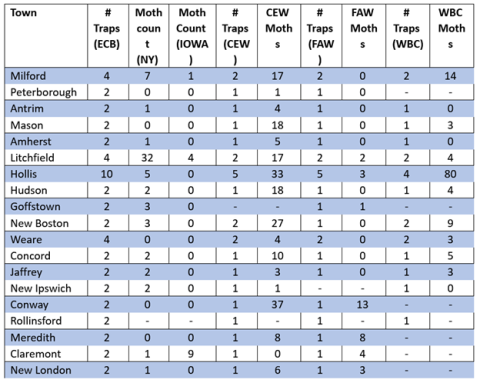

Spotted wing drosophila (SWD) pressure dropped significantly this week in terms of total numbers. this is because one of our trapping locations has finished up harvest for the year, so we are collecting less data points. At the other sites still being monitored, pressure is high within controls and in raspberry plantings. go to https://ag.umass.edu/fruit/resources/spotted-wing-drosophila-management for more management information. Trapping data is recorded in the table below, alongside the data for squash vine borer.
Squash vine borer (SVB) numbers continue to trend downward with no locations at threshold. This coincides with the expected life cycle of SVB. In late august there is sometimes another bump in trap catch, which could signify a second generation. For bush-type summer squash and pumpkins (including giant pumpkins), the recommended threshold is 5 SVB moths per trap per week. For vining type squash or pumpkins, we suggest a threshold of 12 moths per trap per week. The reason for this difference is because vine-type cucurbits can root or tiller in at each node along the vine. This allows the plant to uptake water and nutrients from more than just the main stem. SVB tends to bore into the main stem of cucurbit plants, creating a higher risk for bush type plants. If chemical controls are needed, try to spray at dusk and direct applications to the base of the plants. This may help reduce harm to European honeybees, but our native bees will still be at risk because they often reside in squash flowers at night. see Page 290 of the New England vegetable management guide for SVB control recommendations. See results of our trapping efforts below.
Two Brown Marmorated Stink Bug (BMSB) adults were caught this week, right on schedule. We currently do not have any thresholds established for BMSB but we continue to keep an eye on population levels in the state. For more great information on BMSB, go to https://www.stopbmsb.org/managing-bmsb/.
SVB/SWD/BMSB weekly Summary, 8/18/2023

Check back in each week as the season progresses to see the latest trapping data. Data for additional insect pests will be updated on a weekly basis.
Thank you to all the growers who participate in the program!
Upcoming Events:
AUGUST 22, 2023 | 6:00 - 8:00PM
AUGUST 23, 2023 | 4:00 - 6:00PM
AUGUST 23, 2023 | 5:30 - 7:00PM
This program is made possible thought funding provided by the New Hampshire Department of Agriculture, Markets & Food integrated pest management program. This work is also supported in part by the Integrated Pest Management Crop Protection and Pest Management EIP grant no. 2021-70006-35477 from the USDA National Institute of Food and Agriculture.

Giant pumpkin leaves with Cucurbit Yellow Vine Decline. Photo by K. Quigley.
Hello Vegetable IPM Enthusiasts!
Fields are drying out in some locations around the state this week, but many spots are still receiving excessive moisture. Nitrogen deficient crops are commonplace this season due to nutrient runoff. Growers are busy harvesting and sidedressing what crops can be saved. Nitrogen deficiency can express itself as yellow, chlorotic growth, particularly on the older leaves. But not all yellowing is nitrogen deficiency! The above picture shows what appears to be (and what I thought was) a nitrogen deficient giant pumpkin plant, but after further investigation, this was not the case. This unfortunate plant was infected by the bacterium Serratia marcescens, which causes the disease complex known as cucurbit yellow vine decline (CYVD). CYVD is vectored, or spread, by squash bugs so good squash bug control should eliminate much of the risk. This is fairly uncommon in commercial production within NH but may be one to watch out for. Thank you to our friends at Iowa state for lab confirming CYVD for us! Click this link for more information and cultural control options.
We are amid the 2nd gen flight of European corn borer (ECB). Almost all trapping locations are reporting low catch number, except for the Litchfield area. Only one field scouted location in Weare was over the 15 % pretassel damage threshold. With whorl stage corn, larval feeding damage is characterized by tiny “shot holes” in the leaves. Eventually the larvae will bore into the developing tassel and stalks. The later season scouting procedure is the same but consider that you may be encountering FAW damage as well. Click on the link for more information on how to scout whorl/pretassel stage corn. The results of our trapping efforts are recorded by town on the table below with ECB-NY and ECB-IA moth counts shown. In some cases, there are multiple traps within a town.
Corn Earworm (CEW) moth numbers ticked up this week with several locations on 4-day spray schedules for silking corn. CEW resistance to pyrethroid products (i.e. Warrior) is well documented in other regions and if you notice a lack of control, consider rotating pyrethroids (Group 3A) with products from a different chemical class. This is especially important for growers who rely solely on pyrethroids for CEW control. Blackhawk/Radiant (group 5) and Besiege/Coragen (groups 28, 3A) could make good rotation partners/alternative choices. If pyrethroids are to be used for control, the current recommendation is to use those products earlier in the growing season because resistance can build throughout the year.
Total Fall Armyworm (FAW) catch increased slightly this week but only location in Litchfield was over the pheromone trap threshold of 3 moths per week. FAW damage is being reported in other New England states despite little or no moth catch. FAW larval feeding damage is characterized by large, ragged holes in leaves, and sawdust-like excrement. Large populations may kill or stunt young corn plants. Field scouting should begin once moths are captured at your farm or in your area. For more information on how to field scout, click HERE.
Western bean cutworm (WBC) populations are about the same as last week. Traps counts have been higher than ever this year. We currently do not have an economic threshold established for this pest in NH, but our trapping network is keeping an eye on populations. David Handley from the University of Maine advises to keep silking corn protected if trap numbers of WBC in your area are high, even if traps are catching very few CEW or FAW. This is because WBC behaves similarly to fall armyworm and corn earworm. Scout fields by examining the upper surfaces of the leaves at the top of the plant and leaves above and below the ear zone. Eggs are laid in masses and change from a cream color to lavender to dark purple as they age. Use the sun to your advantage and look for the egg mass shadows while scouting. Materials used for corn earworm control will also control western bean cutworm. Consult the New England Vegetable Guide for recommendations.
Sweet corn pests weekly summary, 8/10/2023

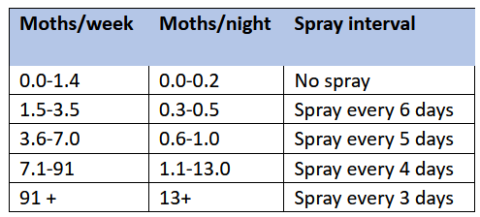
Spotted wing drosophila (SWD) pressure is still high this week, with a slight increase in overall trap counts over last. One control location in Litchfield caught 80 flies! Infestation levels in plantings were significantly less but still present. This lets us know that conditions are ideal for SWD infestation and to not let up on control programs. Click HERE for more management information. Trapping data is recorded in the table below, alongside the data for squash vine borer.
Squash vine borer (SVB) numbers continue to trend downward with only one location at threshold. This coincides with the expected life cycle of SVB. In late august there is sometimes another bump in trap catch, which could signify a second generation. For bush-type summer squash and pumpkins (including giant pumpkins), the recommended threshold is 5 SVB moths per trap per week. For vining type squash or pumpkins, we suggest a threshold of 12 moths per trap per week. The reason for this difference is because vine-type cucurbits can root or tiller in at each node along the vine. This allows the plant to uptake water and nutrients from more than just the main stem. SVB tends to bore into the main stem of cucurbit plants, creating a higher risk for bush type plants. If chemical controls are needed, try to spray at dusk and direct applications to the base of the plants. This may help reduce harm to European honeybees, but our native bees will still be at risk because they often reside in squash flowers at night. see Page 290 of the New England vegetable management guide for SVB control recommendations. See results of our trapping efforts below.
SVB/SWD weekly Summary, 8/10/2023
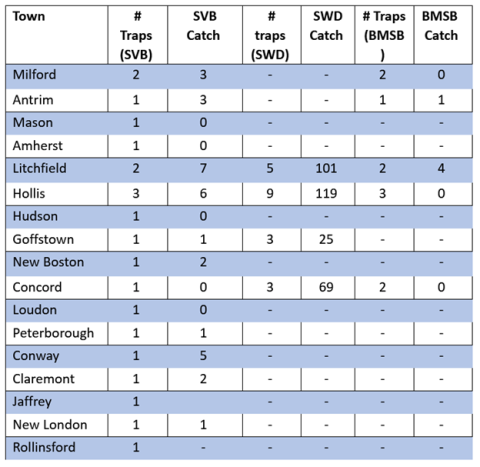
Five Brown Marmorated Stink Bug (BMSB) adults were caught this week, right on schedule. We currently do not have any thresholds established for BMSB but we continue to keep an eye on population levels in the state. For more great information on BMSB, click HERE.
Check back in each week as the season progresses to see the latest trapping data. Data for additional insect pests will be updated on a weekly basis.
Thank you to all the growers who participate in the program!
Upcoming Events:
AUGUST 15, 2023 | 5:30 - 7:30PM
AUGUST 17, 2023 | 5:30 - 7:30PM
AUGUST 22, 2023 | 6:00 - 8:00PM
This program is made possible thought funding provided by the New Hampshire Department of Agriculture, Markets & Food integrated pest management program. This work is also supported in part by the Integrated Pest Management Crop Protection and Pest Management EIP grant no. 2021-70006-35477 from the USDA National Institute of Food and Agriculture.

Hello Vegetable IPM Enthusiasts!
More rain today brings the potential for further disease spread. Field conditions in some locations are poor and we have witnessed a lot of plants succumbing to pathogens. When and if the decision is made to put a field under, consider following up immediately with a cover crop. A few cover crop options that could be planted from now until early-mid September are Field peas, tillage radish and oats. Click HERE for a handy cover crop guide published by the NRCS. The guide details optimal planting dates by region and the characteristics of various cover crop options.
The second flight of European corn borer (ECB) has begun in Southern NH. Continue to keep an eye out for second generation caterpillars. With whorl stage corn, larval feeding damage is characterized by tiny “shot holes” in the leaves. Eventually the larvae will bore into the developing tassel and stalks. the later season scouting procedure is the same but consider that you may be encountering FAW damage as well. Click HERE for information on how to scout whorl/pretassel stage corn. The results of our trapping efforts are recorded by town on the table below with ECB-NY and ECB-IA moth counts shown. In some cases, there are multiple traps within a town.
Corn Earworm (CEW) moth numbers are low. Most locations are on a 5-6 day spray schedule. Cooler temperatures have allowed for slightly more forgiving spray schedule. As a reminder, Populations can change quickly so continue to stay vigilant! We have heard several reports of significant CEW Damage despite relatively little catch the last few weeks. Rainy weather has made it difficult for growers to time sprays. CEW resistance to pyrethroid products (i.e. Warrior) is well documented in other regions and if you notice a lack of control, consider rotating pyrethroids (Group 3A) with products from a different chemical class. This is especially important for growers who rely solely on pyrethroids for CEW control. Blackhawk/Radiant (group 5) and Besiege/Coragen (groups 28, 3A) could make good rotation partners/alternative choices.
Total Fall Armyworm (FAW) catch has remained about the same this week. One location in Hollis did see a spike in catch and reported 6 moths this week. Despite overall low catch numbers, spots of working FAW and what is likely common armyworm in tassel stage corn (before tassel fully emerges) have been observed. FAW damage is being reported in other New England states despite little or no moth catch. FAW feeding damage is characterized by large, ragged holes in leaves, and sawdust-like excrement. Large populations may kill or stunt young corn plants. Field scouting should begin once moths are captured at your farm or in your area. For more information on how to field scout, click HERE.
Western bean cutworm (WBC) populations really shot up this week. Trap counts have been higher than ever. Some growers in New York caught over 400 moths in a single trap! Hopefully we do not see that level of infestation anytime soon. Scout fields by examining the upper surfaces of the leaves at the top of the plant and leaves above and below the ear zone. Eggs are laid in masses and change from a cream color to lavender to dark purple as they age. Use the sun to your advantage and look for the egg mass shadows while scouting. Materials used for corn earworm control will also control western bean cutworm. We currently do not have an economic threshold established for this pest in NH, but our trapping network is keeping an eye on populations. Consult the New England Vegetable Guide for recommendations.
Sweet corn pests weekly summary, 8/4/2023


Spotted wing drosophila (SWD) pressure increased significantly this week. Trap catches of over 40 flies were observed at 4 separate locations (Litchfield, concord and two in Hollis). However, it is important to note that these high levels of infestation were found in our control traps and not in plantings. Infestation levels in planting were significantly less but still present. This lets us know that conditions are ideal for SWD infestation and to not let up on control programs. Click HERE for more management information. Trapping data is recorded in the table below, alongside the data for squash vine borer.
Squash vine borer (SVB) catch really dropped off this week. Only three locations in Southern Nh were over threshold. This coincides with the expected life cycle of SVB. In late august there is sometimes another bump in trap catch, which could signify a second generation. For bush-type summer squash and pumpkins (including giant pumpkins), the recommended threshold is 5 SVB moths per trap per week. For vining type squash or pumpkins, we suggest a threshold of 12 moths per trap per week. The reason for this difference is because vine-type cucurbits can root or tiller in at each node along the vine. This allows the plant to uptake water and nutrients from more than just the main stem. SVB tends to bore into the main stem of cucurbit plants, creating a higher risk for bush type plants. If chemical controls are needed, try to spray at dusk and direct applications to the base of the plants. This may help reduce harm to European honeybees, but our native bees will still be at risk because they often reside in squash flowers at night. see Page 290 of the New England vegetable management guide for SVB control recommendations. See results of our trapping efforts below.
SVB/SWD weekly Summary, 8/4/2023
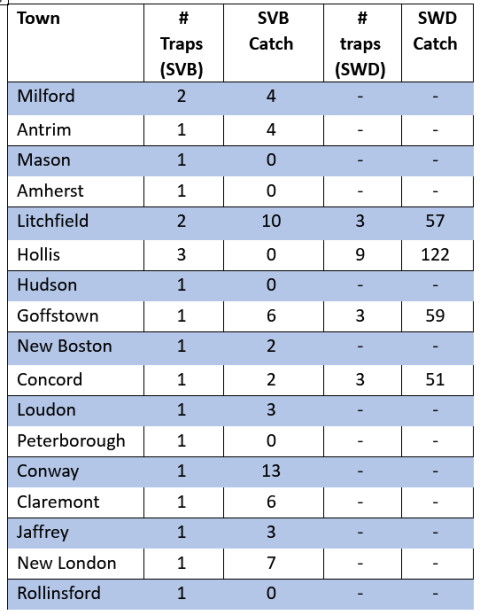
Still zero Brown Marmorated Stink Bug (BMSB) adults or nymphs caught this week. We typically start to see in an increase in BMSB activity in Early to mid-August.
Squash bugs are still being observed at several locations, particularly within low spray management programs. Adults and nymphs feed by inserting their stylets (sharp, sucking mouthparts) and sucking sap from plant tissue. Plant feeding damage resembles that of bacterial wilt. Squash bugs can also cause scarring damage on fruits, reducing marketability.
Check back in each week as the season progresses to see the latest trapping data. Data for additional insect pests will be updated on a weekly basis.
Thank you to all the growers who participate in the program!
Upcoming Events:
AUGUST 15, 2023 | 5:30 - 7:30PM
AUGUST 17, 2023 | 5:30 - 7:30PM
AUGUST 22, 2023 | 6:00 - 8:00PM
This program is made possible thought funding provided by the New Hampshire Department of Agriculture, Markets & Food integrated pest management program. This work is also supported in part by the Integrated Pest Management Crop Protection and Pest Management EIP grant no. 2021-70006-35477 from the USDA National Institute of Food and Agriculture.
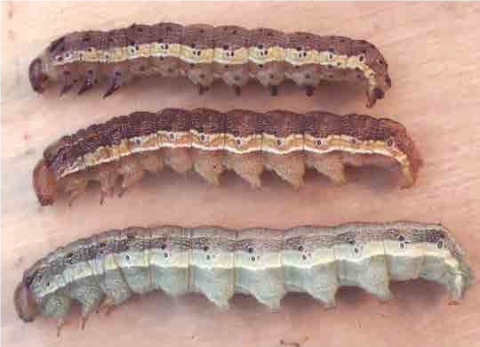
Fields are still drying out and with the increase in temperature and humidity, conditions are ideal for plant pathogen spread. If you suspect plant pathogens are lurking on your farm, plant samples can be submitted to UNH Plant diagnostic lab for confirmation. Click HERE for more information about our lab. If you suspect soil born pathogens are present, limit the spread of soil and equipment from field to field until confirmed. Pressure washing equipment and tires, field isolation and picking your “worse off” fields last can all help to limit pathogen spread.
A few European corn borer (ECB) trapping sites reported adult moths this week. This could signal that we are in the 2nd flight of ECB in southern NH, so keep an eye out for damage. This week our IPM scout observed damage levels between 15-30 % at some locations. With whorl stage corn, larval feeding damage is characterized by tiny “shot holes” in the leaves. Eventually the larvae will bore into the developing tassel and stalks. Click HERE for information on how to scout whorl stage corn. The results of our trapping efforts are recorded by town on the table below with ECB-NY and ECB-IA moth counts shown. In some cases, there are multiple traps within a town.
Corn Earworm (CEW) moth numbers are relatively low. Most locations are on a 4-6 day spray schedule. Populations can change quickly with moths riding in on the many storm fronts that have been occurring. We have heard several reports of significant CEW Damage despite relatively little catch the last couple of weeks. Rainy weather has made it difficult for growers to time sprays. CEW resistance to pyrethroid products (i.e. Warrior) is well documented in other regions and if you notice a lack of control, consider rotating pyrethroids (Group 3A) with products from a different chemical class. This is especially important for growers who rely solely on pyrethroids for CEW control. Blackhawk/Radiant (group 5) and Besiege/Coragen (groups 28, 3A) could make good rotation partners/alternative choices.
Several locations have Fall Armyworm (FAW) catch this week. Despite low catch numbers, spots of working FAW and what is likely common armyworm in tassel stage corn (before tassel fully emerges) have been observed. FAW damage is being reported in other New England states despite little or no moth catch. FAW feeding damage is characterized by large, ragged holes in leaves, and sawdust-like excrement. Large populations may kill or stunt young corn plants. Field scouting should begin once moths are captured at your farm or in your area. For more information on how to field scout, click HERE.
Western bean cutworm (WBC) populations continue to climb this week. Scout fields by examining the upper surfaces of the leaves at the top of the plant and leaves above and below the ear zone. Eggs are laid in masses and change from a cream color to lavender to dark purple as they age. Use the sun to your advantage and look for the egg mass shadows while scouting. Materials used for corn earworm control will also control western bean cutworm. We currently do not have an economic threshold established for this pest, but our trapping network is keeping an eye on populations. Consult the New England Vegetable Guide for recommendations.
Sweet corn pests weekly summary, 7/28/2023
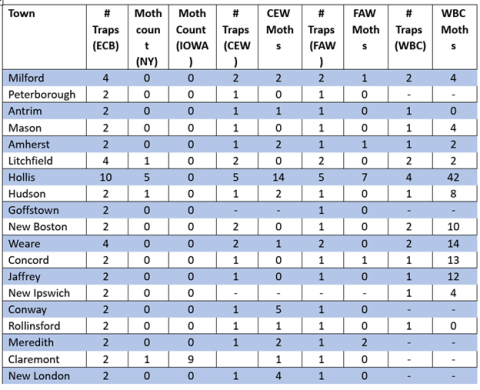
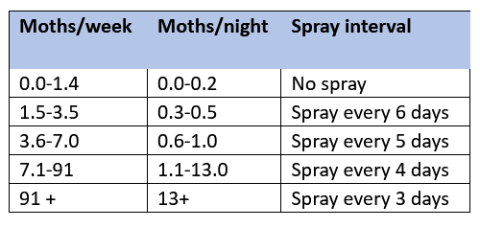
Spotted wing drosophila (SWD) pressure increased significantly this week. Click HERE for more management information. Trapping data is recorded in the table below, alongside the data for squash vine borer.
Squash vine borer (SVB) trap catch dropped at almost all locations this week. Despite that, numbers are still high. Most growers were able to get onto fields this week to spray, if needed. The number of moths captured with pheromone traps can be used to decide whether an insecticide treatment is required or not. For bush-type summer squash and pumpkins (including giant pumpkins), the recommended threshold is 5 SVB moths per trap per week. For vining type squash or pumpkins, we suggest a threshold of 12 moths per trap per week. The reason for this difference is because vine-type cucurbits can root or tiller in at each node along the vine. This allows the plant to uptake water and nutrients from more than just the main stem. SVB tends to bore into the main stem of cucurbit plants, creating a higher risk for bush type plants. If chemical controls are needed, try to spray at dusk and direct applications to the base of the plants. This may help reduce harm to European honeybees, but our native bees will still be at risk because they often reside in squash flowers at night. see Page 290 of the New England vegetable management guide for SVB control recommendations. See results of our trapping efforts below.
SVB/SWD weekly Summary, 7/28/2023
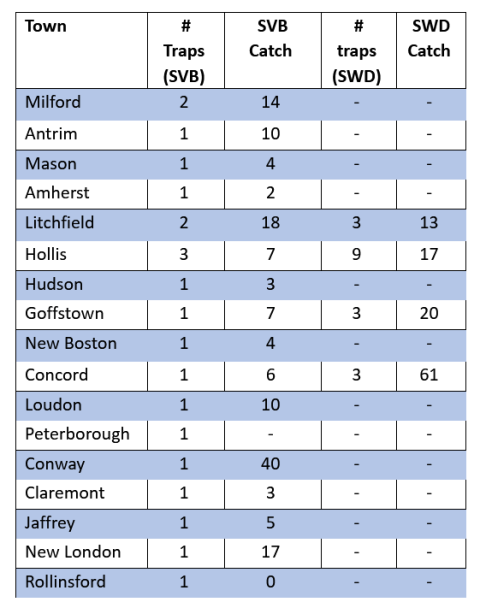
Zero Brown Marmorated Stink Bug (BMSB) adults or nymphs were caught this week. We typically start to see in an increase in BMSB activity in Early to mid-August.
Squash bugs are still being observed at several locations, particularly within low spray management programs. Adults and nymphs feed by inserting their stylets (sharp, sucking mouthparts) and sucking sap from plant tissue. Plant feeding damage resembles that of bacterial wilt. Squash bugs can also cause scarring damage on fruits, reducing marketability.
Check back in each week as the season progresses to see the latest trapping data. Data for additional insect pests will be updated on a weekly basis.
Thank you to all the growers who participate in the program!
Upcoming Events:
AUGUST 3, 2023 | 5:30 - 7:30PM
AUGUST 3, 2023 | 5:30 - 7:30PM
AUGUST 17, 2023 | 5:30 - 7:30PM
AUGUST 22, 2023 | 6:00 - 8:00PM
This program is made possible thought funding provided by the New Hampshire Department of Agriculture, Markets & Food integrated pest management program. This work is also supported in part by the Integrated Pest Management Crop Protection and Pest Management EIP grant no. 2021-70006-35477 from the USDA National Institute of Food and Agriculture.

Hello Vegetable IPM Enthusiasts!
Saturated soil conditions continue to create an ideal environment for soil borne pathogens. In Hillsborough County, we have two confirmed cases of Phytophthora capsici, with many more suspected cases. Phytophthora is a water mold that can lie waiting in the soil for years until the conditions are favorable. This year conditions are favorable to say the least. Once symptoms are visible, control measures are ineffective. The best way to combat this potentially devastating pathogen is to use preventive measures. Raised beds, soil applied fungicides and equipment sanitation are a few key components of a Phytophthora IPM plan. Check out this Field Scouting Guide: Phytophthora - Growing Produce for more information on Phytophthora field identification and management. The article features insights from Margaret Tuttle McGrath from Cornell University and provides a handy fungicide table. Always check the label (or click here) to see if pesticide products are registered for use in New Hampshire.
European corn borer (ECB) trap numbers are again almost non-existent. UMass has reported a slight uptick in ECB numbers, perhaps indicating the start of a second flight in Massachusetts. This indicates New Hampshire will not be too far behind. With whorl stage corn, larval feeding damage is characterized by tiny “shot holes” in the leaves. Eventually the larvae will bore into the developing tassel and stalks. Click HERE for information on how to scout whorl stage corn. The results of our trapping efforts are recorded by town on the table below with ECB-NY and ECB-IA moth counts shown. In some cases, there are multiple traps within a town. Interestingly, our IPM scout did observe by-catch of carrot maggot moths within the ECB traps.
Corn Earworm (CEW) moth numbers have dropped at most locations this week. Most locations are on a 5-6 day spray schedule with a couple notable exceptions. Populations can change quickly with moths riding in on the many storm fronts that have been occurring. Remember that CEW damage is incurred when the crop is in silk. Even if you are at the CEW spray threshold (see schedule below), chemical intervention is not warranted if you’re not in silk. See below for CEW Spray thresholds (fresh silk) while using pheromone traps.
13 total Western bean cutworm (WBC) moths were caught between two locations in Hollis. 14 moths were caught in Concord. One moth each was caught in Antrim, Jaffrey, and Mason. Starting next week, trapping data will be recorded in the usual sweet corn pest table below. Scout fields by examining the upper surfaces of the leaves at the top of the plant, and leaves above and below the ear zone. Eggs are laid in masses and change from a cream color to lavender to dark purple as they age. Materials used for corn earworm control will also control western bean cutworm. We currently do not have an economic threshold established for this pest, but our trapping network is keeping an eye on populations. Consult the New England Vegetable Guide for recommendations.
Our first Fall Armyworm (FAW) moths were caught this week in Hollis, Concord and Weare. FAW numbers will now be reported in the table below, alongside the other sweet corn pest data. FAW moths migrate from the south each year, usually arriving sometime in mid-July or August. Economic damage is done in the larval stage. FAW feeding damage is characterized by large, ragged holes in leaves, and sawdust-like excrement. Large populations may kill or stunt young corn plants. Field scouting should begin once moths are captured at your farm or in your area.
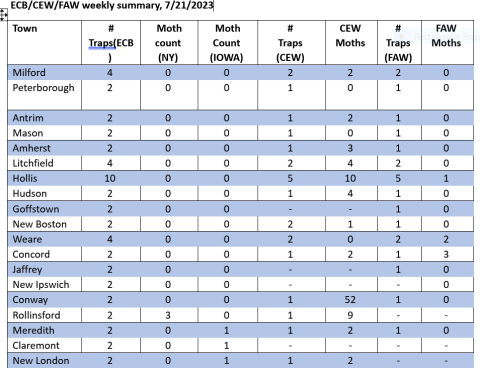
Spotted wing drosophila (SWD) trapping locations reported low numbers in most locations. Click HERE for more management information. Trapping data is recorded in the table below, alongside the data for squash vine borer.
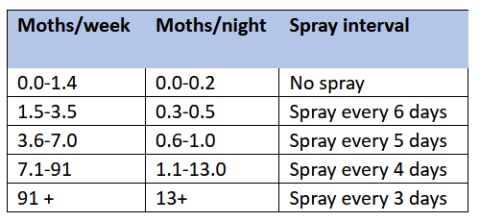
Squash vine borer (SVB) trap catches are high but overall numbers are down from last week. Most growers were able to get onto fields this week to spray, if needed. The number of moths captured with pheromone traps can be used to decide whether an insecticide treatment is required or not. For bush-type summer squash and pumpkins (including giant pumpkins), the recommended threshold is 5 SVB moths per trap per week. For vining type squash or pumpkins, we suggest a threshold of 12 moths per trap per week. The reason for this difference is because vine-type cucurbits can root or tiller in at each node along the vine. This allows the plant to uptake water and nutrients from more than just the main stem. SVB tends to bore into the main stem of cucurbit plants, creating a higher risk for bush type plants. If chemical controls are needed, try to spray at dusk and direct applications to the base of the plants. This may help reduce harm to European honeybees, but our native bees will still be at risk because they often reside in squash flowers at night. see Page 290 of the New England vegetable management guide for SVB control recommendations. See results of our trapping efforts below.
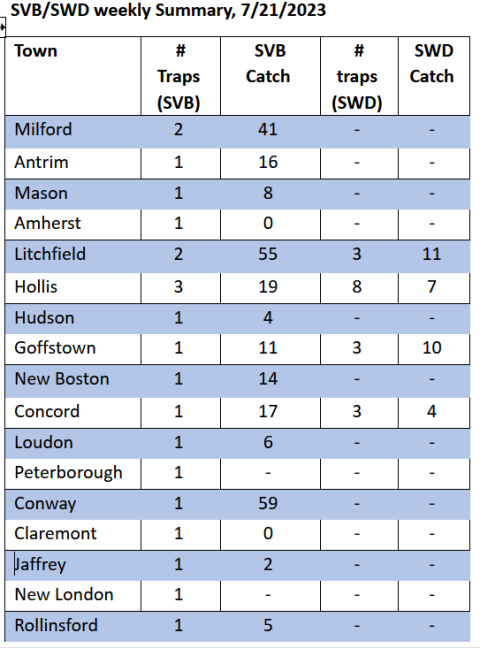
Zero Brown Marmorated Stink Bug (BMSB) adults or nymphs were caught this week.
Check back in each week as the season progresses to see the latest trapping data. Data for additional insect pests will be updated on a weekly basis.
Thank you to all the growers who participate in the program!
Upcoming Meetings:
JULY 26, 2023 | 11:00AM - 1:00PM
Manure Management with Bedded Packs
AUGUST 3, 2023 | 5:30 - 7:30PM
Blueberry IPM Twilight Meeting at Heron Pond Farm
AUGUST 3, 2023 | 5:30 - 7:30PM
Growing Grains for Livestock Feed
This program is made possible thought funding provided by the New Hampshire Department of Agriculture, Markets & Food integrated pest management program. This work is also supported in part by the Integrated Pest Management Crop Protection and Pest Management EIP grant no. 2021-70006-35477 from the USDA National Institute of Food and Agriculture.

Hello Vegetable IPM Enthusiasts!
Excessive rains and flooding have really taken a toll on crops and made field conditions very difficult. Click HERE for updated information if you have fields that were flooded or experienced ponding.
European corn borer (ECB) trap numbers are almost non-existent. Based off the past few weeks of trap numbers, we are at the end of first flight in southern NH. Larval feeding damage was low at most farm sites. With whorl stage corn, larval feeding damage is characterized by tiny “shot holes” in the leaves. Eventually the larvae will bore into the developing tassel and stalks. Click HERE for information on how to scout whorl stage corn. The results of our trapping efforts are recorded by town on the table below with ECB-NY and ECB-IA moth counts shown. In some cases, there are multiple traps within a town.
Corn Earworm (CEW) moths were caught at almost all locations this week. Our Scout installed 12 more CEW traps last week and the traps counts are reflected below. The recent storm fronts that have rolled through have brought in high numbers of moths. Populations can change quickly with moths riding in on the many storm fronts that have been occurring. Remember that CEW damage is incurred when the crop is in silk. Even if you are at the CEW spray threshold (See schedule below), chemical intervention is not warranted if you’re not in silk. See below for CEW Spray thresholds (fresh silk) while using pheromone traps.
A total of three Western bean cutworm moths were caught this week. One moth each in Concord, New Ipswich and Jaffrey. Scout fields by examining the upper surfaces of the leaves at the top of the plant, and leaves above and below the ear zone. Eggs are laid in masses and change from a cream color to lavender to dark purple as they age. Materials used for corn earworm control will also control western bean cutworm. Consult the New England Vegetable Guide for recommendations.
We now have twenty (20) Fall Armyworm (FAW) traps online around the state that reported zeros this week.
European corn borer/CEW weekly summary, 7/14/2023


potted wing drosophila (SWD) trapping locations reported low to moderate numbers in some locations. Click HERE for more management information. We now have several more traps installed and the trapping data is recorded in the table below, alongside the data for squash vine borer.
Squash vine borer (SVB) trap catches are still high, with most monitoring sites reporting. Most growers saw an increase due to wet conditions limiting field access for spraying. The number of moths captured with pheromone traps can be used to decide whether or not an insecticide treatment is required. For bush-type summer squash and pumpkins (including giant pumpkins), the recommended threshold is 5 SVB moths per trap per week. For vining type squash or pumpkins, we suggest a threshold of 12 moths per trap per week. The difference is because vine-type cucurbits can root or tiller in at each node along the vine. This allows the plant to uptake water and nutrients from more than just the main stem. SVB tends to bore into the main stem of cucurbit plants, creating a higher risk for bush type plants. If Chemical controls are needed, try to spray at dusk and direct applications to the base of the plants. This may help reduce harm to European honeybees, but our native bees will still be at risk because they often reside in squash flowers at night. see Page 290 of the New England vegetable management guide for SVB control recommendations. See results of our trapping efforts below.

Squash Bug adults have been very active again this week and we’ve seen egg masses at several farms in southern NH.
Zero Brown Marmorated Stink bug (BMSB) adults or nymphs were caught this week.
Check back in each week as the season progresses to see the latest trapping data. Data for additional insect pests will be updated on a weekly basis.
Thank you to all the growers who participate in the program!
Upcoming Meetings:
July 19th, 2023
July 19th, 2023
This program is made possible thought funding provided by the New Hampshire Department of Agriculture, Markets & Food integrated pest management program. This work is also supported in part by the Integrated Pest Management Crop Protection and Pest Management EIP grant no. 2021-70006-35477 from the USDA National Institute of Food and Agriculture.
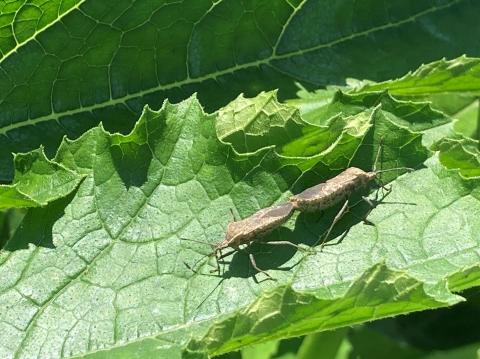
Hello Vegetable IPM Enthusiasts!
European corn borer (ECB) trap numbers are almost non-existent. Based off the past few weeks of trap numbers, we are at the end of first flight in southern NH. Larval feeding damage was low at most farm sites, with exceptions in the Litchfield-Hudson Area. With whorl stage corn, larval feeding damage is characterized by tiny “shot holes” in the leaves. Eventually the larvae will bore into the developing tassel and stalks. Click HERE for information on how to scout whorl stage corn. The results of our trapping efforts are recorded by town on the table below with ECB-NY and ECB-IA moth counts shown. In some cases, there are multiple traps within a town.
Corn Earworm (CEW) moths were caught at many locations this week. The recent storm fronts that have rolled through have brought in high numbers of moths. Populations can change quickly with moths riding in on the many storm fronts that have been occurring. Remember that CEW damage is incurred when the crop is in silk. Even if you are at the CEW spray threshold (See schedule below), chemical intervention is not warranted if you’re not in silk. See below for CEW Spray thresholds (fresh silk) while using pheromone traps.
Four Western Bean Cutworm (WBC) moths were caught in a trap in Hollis. One moth was caught in a trap in Mason. Scout tasseling fields by examining the upper surfaces of the leaves at the top of the plant, and leaves above and below the ear zone. Eggs are laid in masses and change from a cream color to lavender to dark purple as they age. Examine 20 consecutive plants at five locations in the field. If you find more than 4% of plants have eggs or small larvae, consider protecting sweet corn when 90-95% of plants are at tassel. Materials used for corn earworm control will also control western bean cutworm. Consult the New England Vegetable Guide for recommendations.
We Have three Fall Armyworm (FAW) traps online in Hollis that reported zeros this week.
European corn borer/CEW weekly summary, 7/8/2023
Town | # Traps(ECB) | Moth count (NY) | Moth Count (IOWA) | # Traps(CEW) | CEW Moths |
Milford | 4 | 0 | 0 | - | - |
Peterborough | 2 | 0 | 0 | - | - |
Antrim | 2 | 0 | 0 | - | - |
Mason | 2 | 0 | 0 | - | - |
Amherst | 2 | 0 | 0 | - | - |
Litchfield | 4 | 0 | 0 | - | - |
Hollis | 10 | 0 | 0 | 3 | 78 |
Hudson | 2 | 0 | 0 | - | - |
Goffstown | 2 | 0 | 0 | - | - |
New Boston | 2 | 0 | 0 | - | - |
Weare | 4 | 0 | 0 | - | - |
Concord | 2 | 0 | 0 | - | - |
Jaffrey | 2 | 0 | 0 | - | - |
New Ipswich | 2 | 0 | 0 | - | - |
Conway | 2 | 0 | 0 | - | - |
Rollinsford | 2 | 4 | 0 | 1 | 39 |
Meredith | 2 | 0 | 0 | 1 | 12 |
Claremont | 2 | 0 | 1 | - | - |
Moths/week | Moths/night | Spray interval |
0.0-1.4 | 0.0-0.2 | No spray |
1.5-3.5 | 0.3-0.5 | Spray every 6 days |
3.6-7.0 | 0.6-1.0 | Spray every 5 days |
7.1-91 | 1.1-13.0 | Spray every 4 days |
| 91+ | 13+ | Spray every 3 days |
Spotted wing drosophila (SWD) trapping locations reported very High numbers in some locations. 50 SWD flies were caught on a red sticky card trap within raspberry in Hollis and 40 at a separate location nearby. 1 SWD was caught in a hedgerow in Litchfield. We have three liquid traps deployed at one farm in Concord, reporting a catch of 8, 0 and 5 flies. Click HERE for more management information.
Squash vine borer (SVB) trap catches REALLY shot up again this week, with most monitoring sites reporting. Most growers saw an increase due to wet conditions limiting field access for spraying. The number of moths captured with pheromone traps can be used to decide whether or not an insecticide treatment is required. For bush-type summer squash and pumpkins (including giant pumpkins), the recommended threshold is 5 SVB moths per trap per week. For vining type squash or pumpkins, we suggest a threshold of 12 moths per trap per week. The difference is because vine-type cucurbits can root or tiller in at each node along the vine. This allows the plant to uptake water and nutrients from more than just the main stem. SVB tends to bore into the main stem of cucurbit plants, creating a higher risk for bush type plants. If Chemical controls are needed, try to spray at dusk and direct applications to the base of the plants. This may help reduce harm to European honeybees, but our native bees will still be at risk because they often reside in squash flowers at night. see Page 290 of the New England vegetable management guide for SVB control recommendations. See results of our trapping efforts below.
SVB Summary for 7/8/23 | ||
Town | # Traps | SVB Catch |
Milford | 2 | 4 |
Antrim | 1 | 10 |
Mason | 1 | 18 |
Amherst | 1 | 2 |
Litchfield | 2 | 54 |
Hollis | 3 | 18 |
Hudson | 1 | 6 |
Goffstown | 1 | 11 |
New Boston | 1 | 3 |
Concord | 1 | 25 |
Loudon | 1 | 20 |
Peterborough | 1 | 9 |
Conway | 1 | 2 |
Claremont | 1 | 1 |
Jaffrey | 1 | 1 |
Squash Bug adults have been very active this week and we’ve seen egg masses at several farms in southern NH.
One Brown Marmorated Stink bug (BMSB) Adult was caught in Antrim.
Check back in each week as the season progresses to see the latest trapping data. Data for additional insect pests will be updated on a weekly basis.
Thank you to all the growers who participate in the program!
Upcoming Meetings:
July 10th, 2023
July 11th, 2023
This program is made possible thought funding provided by the New Hampshire Department of Agriculture, Markets & Food integrated pest management program. This work is also supported in part by the Integrated Pest Management Crop Protection and Pest Management EIP grant no. 2021-70006-35477 from the USDA National Institute of Food and Agriculture.

Gerald Holmes, Strawberry Center, Cal Poly San Luis Obispo, Bugwood.org
Hello Vegetable IPM Enthusiasts!
Cucurbit downy mildew (CDM) has been reported in New Jersey and Quebec recently. No local reports of Cucurbit downy mildew have come in yet but it may be a good idea to get your susceptible crops covered with a protectant fungicide if you haven’t done so already. Copper or chlorothalonil (initiate 720, bravo) are two potential options. To track CDM reports around the county, check in HERE
European corn borer (ECB) trap numbers continue to dwindle. Based off the past few weeks of trap numbers, we are close to the end of first flight in southern NH (see chart below picturing ECB-NY catch over time). Larval feeding damage was down at most farm sites. With whorl stage corn, larval feeding damage is characterized by tiny “shot holes” in the leaves. Eventually the larvae will bore into the developing tassel and stalks. If you have corn in whorl or later, scouting now for damage is highly recommended. Click HERE for information on how to scout whorl stage corn. The results of our trapping efforts are recorded by town on the table below with ECB-NY and ECB-IA moth counts shown. In some cases, there are multiple traps within a town.
European corn borer weekly summary, 6/30/2023
Town | # Traps | Moth count (NY) | Moth Count (IOWA) |
Milford | 4 | 1 | 0 |
Peterborough | 2 | 0 | 0 |
Antrim | 2 | 0 | 0 |
Mason | 2 | 0 | 0 |
Amherst | 2 | 0 | 0 |
Litchfield | 4 | 0 | 0 |
Hollis | 10 | 14 | 0 |
Hudson | 2 | 3 | 0 |
Goffstown | 2 | 0 | 0 |
New Boston | 2 | 1 | 0 |
Weare | 4 | 0 | 0 |
Concord | 2 | 0 | 0 |
Jaffrey | 2 | 0 | 0 |
New Ipswich | 2 | 2 | 0 |
Conway | 2 | 0 | 0 |
Rollinsford | 2 | 6 | 0 |
Meredith | 2 | 0 | 0 |
Corn Earworm (CEW) moths were caught at two separate locations in Hollis this week. One trap contained 5 moths and the other contained 2. Another site in Rollinsford caught 4 moths in one night. Our IPM also was able to visually ID a moth inside of a whorl in Hudson. Massachusetts CEW moth catches are also relatively low, with the exception of one location in Worcester County. Traps numbers in NH may be low at this moment but consider that populations can change quickly with moths riding in on the many storm fronts that have been occurring. Remember that CEW damage is incurred when the crop is in silk. Even if you are at the CEW spray threshold (See schedule below), chemical intervention is not warranted if you’re not in silk. See below for CEW Spray thresholds (fresh silk) while using pheromone traps.
Moths/week | Moths/night | Spray interval |
0.0-1.4 | 0.0-0.2 | No spray |
1.5-3.5 | 0.3-0.5 | Spray every 6 days |
3.6-7.0 | 0.6-1.0 | Spray every 5 days |
7.1-91 | 1.1-13.0 | Spray every 4 days |
91 + | 13+ | Spray every 3 days |
This week, our IPM scout checked six spotted wing drosophila (SWD) traps at locations in concord, Litchfield and Hollis. No SWD flies were caught yet again! I suspect that we may have some catch next week, so be sure to tune back in and see (hopefully I am wrong).
Two Brown marmorated stink bug (BMSB) adults were caught in Antrim this week within our sentinel monitoring program. We currently do not have any thresholds established for BMSB but we continue to keep an eye on population levels in the state. For more great information on BMSB, click HERE.
Squash vine borer (SVB) trap catches REALLY shot up this week, with most monitoring sites reporting. The number of moths captured with pheromone traps can be used to decide whether or not an insecticide treatment is required. For bush-type summer squash and pumpkins (including giant pumpkins), the recommended threshold is 5 SVB moths per trap per week. For vining type squash or pumpkins, we suggest a threshold of 12 moths per trap per week. The difference is because vine-type cucurbits can root or tiller in at each node along the vine. This allows the plant to uptake water and nutrients from more than just the main stem. SVB tends to bore into the main stem of cucurbit plants, creating a higher risk for bush type plants. If Chemical controls are needed, try to spray at dusk and direct applications to the base of the plants. This may help reduce harm to European honeybees, but our native bees will still be at risk because they often reside in squash flowers at night. see Page 290 of the New England vegetable management guide for SVB control recommendations. See results of our trapping efforts for this week.
SVB Summary for 6/30/23 | ||
Town | # Traps | SVB Catch |
Milford | 2 | 1 |
Antrim | 1 | 4 |
Mason | 1 | 1 |
Amherst | 1 | 0 |
Litchfield | 2 | 12 |
Hollis | 3 | 10 |
Hudson | 1 | 0 |
Goffstown | 1 | 3 |
New Boston | 1 | 0 |
Concord | 1 | 3 |
Loudon | 1 | 3 |
Conway | 1 | 0 |
Claremont | 1 | 0 |
Check back in each week as the season progresses to see the latest trapping data. Data for additional insect pests will be updated on a weekly basis. Thank you to all the growers who participate in the program!
Upcoming Meetings:
July 5th, 2023
July 10th, 2023
July 11th, 2023
This program is made possible thought funding provided by the New Hampshire Department of Agriculture, Markets & Food integrated pest management program. This work is also supported in part by the Integrated Pest Management Crop Protection and Pest Management EIP grant no. 2021-70006-35477 from the USDA National Institute of Food and Agriculture.

Hello Vegetable IPM enthusiasts!
European Corn Borer (ECB) trap numbers continue to trend downwards in most of our monitoring locations. This is likely due to timely insecticide applications. We also could be nearing the end of the first flight in southern NH. Corn development is still delayed with the depressed temperatures we’ve had. Significant larval feeding damage was detected this week in whorl stage corn. With whorl stage corn, larval feeding damage is characterized by tiny “shot holes” in the leaves. Eventually the larvae will bore into the developing tassel and stalks. If you have corn in whorl or later, scouting now for damage is highly recommended. Click HERE for information on how to scout whorl stage corn. The results of our trapping efforts are recorded by town on the table below with ECB-NY and ECB-IA moth counts shown. In some cases, there are multiple traps within a town. If you are a call-in grower or utilize pheromone monitoring on your own, your ECB traps should be up! and please report your numbers to me by Tuesday of each week. The data you all provide is very helpful to other growers as they make management decisions.
European corn borer weekly summary, 6/23/2023
Town | # Traps | Moth count (NY) | Moth Count (IOWA) |
Milford | 4 | 7 | 0 |
Peterborough | 2 | 2 | 0 |
Antrim | 2 | 0 | 0 |
Mason | 2 | 0 | 0 |
Amherst | 2 | 1 | 0 |
Litchfield | 4 | 6 | 1 |
Hollis | 10 | 19 | 2 |
Hudson | 2 | 8 | 0 |
Goffstown | 2 | 0 | 0 |
New Boston | 2 | 0 | 0 |
Weare | 4 | 0 | 0 |
Concord | 2 | 2 | 0 |
Jaffrey | 2 | 0 | 0 |
New Ipswich | 2 | 0 | 0 |
Conway | 2 | 0 | 0 |
Rollinsford | 2 | 13 | 0 |
Meredith | 2 | 0 | 0 |
Six Corn Earworm (CEW) moths were caught at one location in Hollis this week. Our IPM scout set out another CEW trap this week in corn at a susceptible growth stage (I.e. tassel). Remember that CEW damage is incurred when the crop is in silk. Even if you are at the CEW spray threshold, chemical intervention is not warranted if you’re not in silk. See below for CEW Spray thresholds (fresh silk) while using pheromone traps.
Moths/week | Moths/night | Spray interval |
0.0-1.4 | 0.0-0.2 | No spray |
1.5-3.5 | 0.3-0.5 | Spray every 6 days |
3.6-7.0 | 0.6-1.0 | Spray every 5 days |
7.1-91 | 1.1-13.0 | Spray every 4 days |
91 + | 13+ | Spray every 3 days |
We now have seven spotted wing drosophila (SWD) traps installed on four different farms and we will report out if we have any findings on next week’s IPM update. This week we saw no catch. Normally, we don’t see any major movement with SWD until late June/early July.
Brown marmorated stink bug (BMSB) was quiet this week with zero catches.
Squash vine borer (SVB) traps have been deployed in several towns, but we had zero official catch this week. We did receive a report from Claremont that two SVB moths were caught in a pheromone trap. The number of moths captured with pheromone traps can be used to decide whether or not an insecticide treatment is required. For bush-type summer squash and pumpkins (including giant pumpkins), the recommended threshold is 5 SVB moths per trap per week. For vining type squash or pumpkins, we suggest a threshold of 12 moths per trap per week. The difference is because vine-type cucurbits can root or tiller in at each node along the vine. This allows the plant to uptake water and nutrients from more than just the main stem. SVB tends to bore into the main stem of cucurbit plants, creating a higher risk for bush type plants. Future trapping data will be published on a town by town basis.
Colorado potato beetle (CPB) larvae have been found on farms in Hillsborough County. We observed some eggs starting to hatch out in southern NH. Insecticide treatments for CPB will be most effective while they are in the larval stages. Remember that Colorado potato beetles can quickly build resistance to insecticides. Careful insecticide class rotation and non-chemical controls are needed to delay resistance. If you have applied insecticides to no effect, switch up the chemical class and do not use that class for the rest of the season. If possible, rotating off classes for two seasons would be best. For more information on CPB management click HERE. To see a list of chemicals approved for the use on tomato, click HERE
Leek Moth has been detected in Grafton County this week. Leek moth was first detected in NH in 2016, and will likely become more common. For more leek moth resources Click Leek Moth in NH | Extension (unh.edu) for a just released pest alert.
Check back in each week as the season progresses to see the latest trapping data. Data for additional insect pests will be updated on a weekly basis. Thank you to all the growers who participate in the program!
Upcoming Meetings:
June 27th, 2023
June 29th, 2023
July 5th, 2023
This program is made possible thought funding provided by the New Hampshire Department of Agriculture, Markets & Food integrated pest management program. This work is also supported in part by the Integrated Pest Management Crop Protection and Pest Management EIP grant no. 2021-70006-35477 from the USDA National Institute of Food and Agriculture.
Hello Vegetable IPM enthusiasts!
European corn borer trap numbers are down in most locations this week, I suspect this is from insecticide applications. Colder regions of the state have just started to see emergence. Growers in colder areas should now scout for damage in whorl stage corn or later. We do have some farms with early corn that have reached tassel but overall, the cool temperatures have slowed development. Click HERE for information on how to scout whorl stage corn. The results of our trapping efforts are recorded by town on the table below with ECB-NY and ECB-IA moth counts shown. In some cases, there are multiple traps within a town. If you are a call-in grower or utilize pheromone monitoring on your own, your ECB traps should be up! and please report your numbers to me by Tuesday of each week. The data you all provide is very helpful to other growers as they make management decisions. It may be tempting to sidedress yellow, slow growing corn with additional nitrogen, but consider that temperatures likely have more to do with poor growth than nutrient status.
European corn borer weekly summary, 6/16/2023
Town | # Traps | Moth count (NY) | Moth Count (IOWA) |
Milford | 4 | 13 | 0 |
Antrim | 2 | 6 | 0 |
Mason | 2 | 2 | 0 |
Amherst | 2 | 2 | 0 |
Litchfield | 4 | 6 | 0 |
Hollis | 10 | 22 | 2 |
Hudson | 2 | 5 | 0 |
Goffstown | 2 | 2 | 0 |
New Boston | 2 | 7 | 0 |
Weare | 4 | 1 | 0 |
Concord | 2 | 2 | 0 |
Jaffrey | 2 | 0 | 0 |
New Ipswich | 2 | 1 | 0 |
Conway | 2 | 0 | 0 |
Rollinsford | 2 | 4 | 0 |
We caught our first Corn Earworm (CEW) moths this week! Two moths were caught at a location in Hollis that had an early catch last year as well. Massachusetts has reported CEW moth catch this week too. We have not documented overwintering of CEW this far north, but seeing early catch in NH for a couple years in row makes me wonder. We typically observe CEW arriving on storm fronts in July. Documented overwintering is occurring as far up as New York, but our early numbers could point towards CEW overwintering farther north. More research is needed to determine if it is for sure occurring in our state. see below for CEW Spray thresholds while using pheromone traps.
Moths/week | Moths/night | Spray interval |
0.0-1.4 | 0.0-0.2 | No spray |
1.5-3.5 | 0.3-0.5 | Spray every 6 days |
3.6-7.0 | 0.6-1.0 | Spray every 5 days |
7.1-91 | 1.1-13.0 | Spray every 4 days |
91 + | 13+ | Spray every 3 days |
Four sFpotted wing drosophila (SWD) traps were installed last week and we will report out if we have any findings on next week’s IPM update. This week we saw no catch. Normally, we don’t see any major movement with SWD until late June/early July.
Brown marmorated stink bug (BMSB) was quiet this week with zero catches.
Squash vine borer (SVB) traps have been deployed in several towns, but we had zero catch this week.
Future trapping data will be published on a town by town basis.
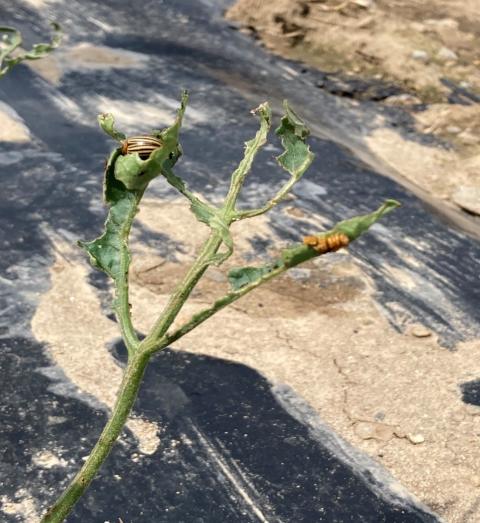
Colorado potato beetle adults were again found on farms in Hillsborough County. We observed some eggs starting to hatch out in southern NH. The cooler weather we have been having is restricting flight but the adults are still walking around and into fields to lay eggs. Remember that Colorado potato beetles can quickly build resistance to insecticides. Careful insecticide class rotation and non-chemical controls are needed to delay resistance. If you have applied insecticides to no effect, switch up the chemical class and do not use that class for the rest of the season. If possible, rotating off classes for two seasons would be best. For more information on CPB management click HERE. To see a list of chemicals approved for the use on tomato, click HERE
Check back in each week as the season progresses to see the latest trapping data. Data for additional insect pests will be updated on a weekly basis. Thank you to all the growers who participate in the program!
Upcoming Meetings:
June 22nd, 2023
June 27th, 2023
Contact: Kyle Quigley
This program is made possible thought funding provided by the New Hampshire Department of Agriculture, Markets & Food integrated pest management program. This work is also supported in part by the Integrated Pest Management Crop Protection and Pest Management EIP grant no. 2021-70006-35477 from the USDA National Institute of Food and Agriculture.
Hello Vegetable IPM enthusiasts!
European corn borer trap numbers are on the rise! One location in the southern part of the state caught 90 moths this past week. Of those 90 moths, all were of the New York strain. Growers in this area should scout for damage in whorl stage corn or later. We do have some farms with early corn that have reached pre tassel but overall, the cool temperatures have slowed development. Click HERE for information on how to scout whorl stage corn. The results of our trapping efforts are recorded by town on the table below with ECB-NY and ECB-IA moth counts shown. In some cases, there are multiple traps within a town. If you are a call-in grower or utilize pheromone monitoring on your own, your ECB traps should be up! Our next major pest of sweet corn that will be hitting the stage is corn earworm (CEW). Our IPM scout plans to start installing CEW traps next week. Parts of New York state have caught CEW adults this week, in areas where they can overwinter successfully.
European corn borer weekly summary, 6/9/2023
Town | # of traps | Mouth Count (NY) | Moth Count (IOWA) |
Milford | 4 | 12 | 0 |
Antrim | 2 | 0 | 0 |
Mason | 2 | 1 | 0 |
Amherst | 2 | 11 | 0 |
Litchfield | 4 | 29 | 1 |
Hollis | 10 | 120 | 0 |
Hudson | 2 | 11 | 0 |
Goffstown | 2 | 0 | 0 |
New Boston | 2 | 0 | 0 |
Weare | 4 | 0 | 0 |
Concord | 2 | 1 | 0 |
Jaffrey | 2 | 0 | 0 |
Our first traps for spotted wing drosophila (SWD) were also installed this week and we will report out if we have any findings on next week’s IPM update. Normally, we don’t see any major movement with SWD until late June/early July.
Brown marmorated stink bug (BMSB) was quiet this week with zero catches.
Colorado potato beetle adults were again found on a farm in Hillsborough County. The cooler weather we have been having is restricting flight but the adults are still walking around and into fields to lay eggs. Remember that Colorado potato beetles can quickly build resistance to insecticides. careful insecticide class rotation and non-chemical controls are needed to delay resistance. for more information on CPB management click HERE.
Thrips damage has been observed in Onion within Hillsborough County. Damage can appear as gnarled, distorted leaves, silvery lines and white patches or brown tips. for more information on Onion Thrips, Click HERE.

Alton N. Sparks, Jr., University of Georgia, Bugwood.org
Upcoming Meetings:
June 14th, 2023
June 22nd, 2023
This program is made possible thought funding provided by the New Hampshire Department of Agriculture, Markets & Food integrated pest management program. This work is also supported in part by the Integrated Pest Management Crop Protection and Pest Management EIP grant no. 2021-70006-35477 from the USDA National Institute of Food and Agriculture.
Contact: Kyle Quigley
This program is made possible thought funding provided by the New Hampshire Department of Agriculture, Markets & Food integrated pest management program. This work is also supported in part by the Integrated Pest Management Crop Protection and Pest Management EIP grant no. 2021-70006-35477 from the USDA National Institute of Food and Agriculture.
Hello vegetable IPM enthusiasts!
We are still waiting to see how any frosted sweet corn will shape up but we remain optimistic! Our IPM Scout continues the great work of installing and checking traps. We now have a combined number of 36 traps for European corn borer, New York and Iowa Strains. In the southern part of the state, ECB has two moth flights. We caught our first moths last week. This week adult populations are on the rise. if you have early corn that is in or approaching mid whorl stage, consider scouting for damage. The results of our trapping efforts are recorded by town on the table 2 below. In some cases, there are multiple traps within a town. Click HERE for more information on ECB management. If you are a call in grower, consider installing your ECB traps Soon!
Early season scouting procedure: Wait until mid to late whorl stage to scout. Select at least 5 sites across the planting, all of the same variety and planting date. Do not check field edges to avoid the “edge effect.” To make your sampling most representative of the field, follow a rough X pattern across the planting. At each site, examine 20 stalks, and look at the whorl area for the tiny “shot holes” [see photo on page 2] that show corn borers are in that stalk. Often there is a tiny bit of light, powdery frass adjacent to the small holes. If you see such signs, mark that stalk as infested. As you move across the planting, keep track (pocket pad is helpful) of two things: 1) how many stalks are infested; and 2) the total number of stalks you’ve counted. Stop at 100. The threshold is: if 30 or more of the stalks are infested, it is worthwhile to treat with an insecticide. For very early corn (high value), you may wish to adjust that threshold downwards to 15. If the infestation rate is below threshold, it will cost more to treat the corn than the damage is worth. For sweet corn in the pre-tassel stage (tassel is visible in the whorl), use the 15% threshold. See information source here.
Table. 1
Plant stage | Field scouting Threshold | Pheromone trap threshold |
Whole Stage | 30% of sample shows injury |
|
Pretassel or later | 15% of sample show injury |
|
Fresh silk |
| 5 or more moths per week |
Note: If silking corn is not being sprayed for other insects, spray once if
five or more ECB moths are captured in one week
Table. 2
European corn borer weekly summary, 6/2/2023
Town | # Traps | Moth counts | Avg. Moths/trap |
Milford | 4 | 11 | 2.75 |
Antrim | 2 | 1 | 0.5 |
Mason | 2 | 1 | 0.5 |
Amherst | 2 | 4 | 2 |
Litchfield | 4 | 7 | 1.75 |
Hollis | 10 | 32 | 3.1 |
Hudson | 2 | 6 | 3 |
Goffstown | 2 | 2 | 1 |
New Boston | 2 | 3 | 1.5 |
Weare | 4 | 3 | 0.75 |
Concord | 2 | 0 | 0 |
Our scout has also been working hard to deploy a select number of traps for Brown marmorated stink bug (BMSB). We have ten traps placed at six locations as part of our sentinel monitoring for newer pest.
No economic thresholds have been established for New Hampshire, but the program provides data on when BMSB becomes active, as well as relative infestation levels. This week, one adult BMSB was trapped in Milford, NH. Click HERE for a quick post by our former entomologist, Dr. Alan Eaton.
Contact: Kyle Quigley
This program is made possible thought funding provided by the New Hampshire Department of Agriculture, Markets & Food integrated pest management program. This work is also supported in part by the Integrated Pest Management Crop Protection and Pest Management EIP grant no. 2021-70006-35477 from the USDA National Institute of Food and Agriculture.
Hello Vegetable IPM Enthusiasts!

Frost and freeze damage assessments have continued this past week by growers and extension staff alike. Observations and reports of damage have been extremely variable from one location to the next. Even within the context of one individual farm, several microclimates could have been present with a range of percent loss. This makes estimating losses rather difficult, but UNH Extension will continue to gather information in the coming weeks. If annual vegetable transplants were severely damaged it still may be worthwhile to replant if you haven’t already. The weather forecast ahead looks warm, and healthy replanted crops will likely “catch up.” If the meristematic tissue (growth point) of the crop was undamaged and you decided to keep it, continue to nurse them along with adequate water to reduce further stress.
Our IPM Scout continues the great work of installing and checking traps. We now have a combined number of 34 traps for European corn borer, New York and Iowa Strains. In the southern part of the state, ECB has two moth flights. We caught our first moths this week! This marks the very beginning of the first flight. All moths caught this week were of the New York strain. The results are recorded by town on the table at the bottom of the page. In some cases, there are multiple traps within a town. Click HERE for more information on ECB management.
Additionally, our first sentinel traps for brown marmorated stink bug went up this week. Trapping numbers and locations for this pest will be posted next Friday.
Our neighbors to the south in Massachusetts have reported leaf miner activity. Click HERE for UMASS Extension’s most recent issue of vegetable notes.
Flea beetle in brassica crops continue to be a problem, so growers with susceptible crops should be aware. For more information on flea beetle management, click HERE.
Check back in each week as the season progresses to see the latest trapping data. Data for additional insect pests will be updated on a weekly basis. Thank you to all the growers who participate in the program!
European corn borer weekly summary, 5/26/2023
Town | # Traps | Moth counts | Avg. Moths/trap |
Milford | 4 | 0 | 0 |
Antrim | 2 | 0 | 0 |
Amherst | 2 | 0 | 0 |
Litchfield | 4 | 0 | 0 |
Hollis | 10 | 8 | 0.8 |
Hudson | 2 | 0 | 0 |
Goffstown | 2 | 0 | 0 |
New Boston | 2 | 0 | 0 |
Weare | 4 | 0 | 0 |
Concord | 2 | 0 | 0 |
This program is made possible thought funding provided by the New Hampshire Department of Agriculture, Markets & Food integrated pest management program. This work is also supported in part by the Integrated Pest Management Crop Protection and Pest Management EIP grant no. 2021-70006-35477 from the USDA National Institute of Food and Agriculture.

The topic on the minds of growers and agriculturalists around the state was the midweek frost/freeze event. Most early vegetables under row cover or plastic weathered the night well. Early sweet corn from spike to whorl stage received some damage in certain locations but we suspect it will recover.
Our IPM scout was busy this week installing and checking traps for European corn borer in sweet corn. 26 traps were checked this week, and luckily no ECB was found! It is still early in the season, but a goal of the program is to be aware of when the first moths emerge. The results are recorded by town on the table at the bottom of the page. In some cases, there are multiple traps within a town.
We have heard reports of cucumber beetle activity in the southernmost portion of the state. If you have early cucurbit crops started with low tunnels or row cover, be on the lookout! For more information on cucumber beetle management, click HERE.
Additionally, a couple reports of flea beetle in brassica crops have come in this week so growers with susceptible crops should be aware. For more information on flea beetle management, click HERE.
We have also confirmed seedcorn maggot adults in Strafford Co. Seedcorn maggot (along with the closely related onion and cabbage maggots) are the larvae of Delia flies. The seedcorn maggot mainly attacks sprouting seeds of corn and beans, as well as vegetables including peas, cabbage, turnips, onions, radishes, spinach, squash, pumpkins, and sprouting potatoes. Feeding by the larvae weakens plants and causes poor stands. Injury is most likely during cool moist springs in soil with high organic matter. For more information on seedcorn maggots, click HERE.
Check back in each week as the season progresses to see the latest trapping data. Data for additional insect pests will be updated on a weekly basis. Thank you to all the growers who participate in the program!
European corn borer weekly summary, 5/19/2023
Town | # Traps | Moth counts | Avg. Moths/trap |
Milford | 4 | 0 | 0 |
Amherst | 2 | 0 | 0 |
Litchfield | 4 | 0 | 0 |
Hollis | 10 | 0 | 0 |
Hudson | 2 | 0 | 0 |
Goffstown | 2 | 0 | 0 |
New Boston | 2 | 0 | 0 |
This program is made possible thought funding provided by the New Hampshire Department of Agriculture, Markets & Food integrated pest management program. This work is also supported in part by the Integrated Pest Management Crop Protection and Pest Management EIP grant no. 2021-70006-35477 from the USDA National Institute of Food and Agriculture.

European corn borer trap deployed May 8, 2023
Now that the planting season is in full swing, UNH cooperative extension has started to trap for vegetable insect pests. Our vegetable insect trapping network monitors for key sweet corn pests, Squash vine borer in Cucurbit crops and conducts sentinel monitoring for Spotted Wing Drosophila and Brown marmorated stink bug. Multiple sites for each insect pest are monitored on a weekly basis. The program provides timely infestation information to growers statewide that allows for informed pest management decisions.
The first insect that we monitor for each season is the European corn borer (ECB) in sweet corn. Last week our IPM scout installed seven traps across seven different farms. In some cases, there are multiple traps within a town. Traps were deployed to capture both the Iowa and New York Strains of ECB. The results are recorded on the table at the bottom of the page. Being early in the season, no ECB moths were captured this week. For more information on ECB Management, Click HERE.
Check back in each week as the season progresses to see the latest trapping data. Data for additional insect pests will be updated on a weekly basis. Thank you to all the growers who participate in the program!
| European Corn Borer Weekly Summary, 5/12/2023 | |||
| Town | # Traps | Moth Counts | Avg Moths/Trap |
| Amherst | 1 | 0 | 0 |
| Hollis | 4 | 0 | 0 |
| Litchfield | 1 | 0 | 0 |
| Milford | 1 | 0 | 0 |
This program is made possible thought funding provided by the New Hampshire Department of Agriculture, Markets & Food integrated pest management program. This work is also supported in part by the Integrated Pest Management Crop Protection and Pest Management EIP grant no. 2021-70006-35477 from the USDA National Institute of Food and Agriculture.
Extension Services & Tools That Help NH Farmers Grow
Newsletters: Choose from our many newsletters for production agriculture
Receive Pest Text Alerts - Text UNHIPM to (866) 645-7010



